Native Bird Species at Flight 93 National Memorial
-
Alder Flycatcher -
American Crow -
American Goldfinch -
American Kestrel -
American Redstart -
American Robin -
American Tree Sparrow -
American Wigeon -
Bald Eagle -
Baltimore Oriole -
Bank Swallow -
Barn Swallow -
Barred Owl -
Belted Kingfisher -
Black-capped Chickadee -
Black-throated Green Warbler -
Black Vulture -
Black-and-white Warbler -
Black-billed Cuckoo -
Blackburnian Warbler -
Black-throated Blue Warbler -
Blue Grosbeak -
Blue Jay -
Blue-gray Gnatcatcher -
Blue-headed Vireo -
Blue-winged Teal -
Bobolink -
Broad-winged Hawk -
Brown Thrasher -
Brown-headed Cowbird -
Canada Goose -
Cape May Warbler -
Carolina Chickadee -
Carolina Wren -
Cedar Waxwing -
Chestnut-sided Warbler -
Chipping Sparrow -
Cliff Swallow -
Chimney Swift -
Common Grackle -
Common Raven -
Common Yellowthroat -
Cooper's Hawk -
Dark-eyed Junco -
Downy Woodpecker -
Eastern Bluebird -
Eastern Kingbird -
Eastern Meadowlark -
Eastern Phoebe -
Eastern Towhee -
Eastern Wood-Pewee -
European Starling -
Field Sparrow -
Grasshopper Sparrow -
Gray Catbird -
Great Blue Heron -
Great Crested Flycatcher -
Great Egret -
Great Horned Owl -
Greater Yellowlegs -
Green Heron -
Hairy Woodpecker -
Henslow's Sparrow -
Hooded Merganser -
Hooded Warbler -
Horned Grebe -
Horned Lark -
House Sparrow -
House Finch -
House Wren -
Indigo Bunting -
Killdeer -
Least Flycatcher -
Least Sandpiper -
Lesser Yellowlegs -
Magnolia Warbler -
Mallard -
Mourning Dove -
Northern Cardinal -
Northern Flicker -
Northern Harrier -
Northern Parula -
Northern Mockingbird -
Northern Rough-winged Swallow -
Northern Shrike -
Northern Waterthrush -
Ovenbird -
Osprey -
Palm Warbler -
Peregrine Falcon -
Pileated Woodpecker -
Prairie Warbler -
Purple Finch -
Red-bellied Woodpecker -
Red-eyed Vireo -
Red-headed Woodpecker -
Red-shouldered Hawk -
Red-tailed Hawk -
Red-winged Blackbird -
Ring-billed Gull -
Ring-necked Duck -
Ring-necked Pheasant -
Rock Pigeon -
Rough-legged Hawk -
Rose-breasted Grosbeak -
Ruby-crowned Kinglet -
Ruby-throated Hummingbird -
Ruddy Duck -
Sandhill Crane -
Savannah Sparrow -
Semipalmated Plover -
Semipalmated Sandpiper -
Scarlet Tanager -
Sedge Wren -
Sharp-shinned Hawk -
Short-eared Owl -
Snow Bunting -
Solitary Sandpiper -
Song Sparrow -
Spotted Sandpiper -
Swainson's Thrush -
Swamp Sparrow -
Tree Swallow -
Tennessee Warbler -
Tufted Titmouse -
Turkey Vulture -
Upland Sandpiper -
Vesper Sparrow -
Warbling Vireo -
White-breasted Nuthatch -
White-eyed Vireo -
White-throated Sparrow -
Wild Turkey -
Willow Flycatcher -
Wilson's Warbler -
Winter Wren -
Wood Duck -
Wood Thrush -
Yellow Warbler -
Yellow-billed Cuckoo -
Yellow-rumped Warbler
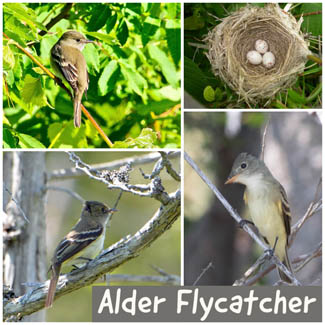
- Grid (counterclockwise):
- Male: Jack & Holly Bartholmai / Macaulay Library at the Cornell Lab of Ornithology (ML243673741)
- Female: Michael J Good / Macaulay Library at the Cornell Lab of Ornithology (ML165563711)
- Juvenile: Tony Leukering / Macaulay Library at the Cornell Lab of Ornithology (ML67545601)
- Nest/Eggs: Jim Lind / Macaulay Library at the Cornell Lab of Ornithology (ML36734141)
- Range map provided by Birds of the World
Click here to lean more about Alder Flycatcher
Alder Flycatcher
Empidonax alnorum
A small bird that spends the summer catching flying insects in northern thickets. This bird and the Willow Flycatcher are so like each other that they were considered one species until the 1970s. The only differences apparent in the field are in their voices. However, voice is important to these birds: many other kinds of songbirds must learn their songs, but Willow and Alder flycatchers are born instinctively knowing the voice of their own species.
There are several subtle things we look at to differentiate between species, and foot color is one of them. Two species, Acadian and Yellow-bellied Flycatchers have purple-grayish legs whereas Alder/Willow and Least have black legs. This is a cool detail that you might not see using binoculars!
There are several subtle things we look at to differentiate between species, and foot color is one of them. Two species, Acadian and Yellow-bellied Flycatchers have purple-grayish legs whereas Alder/Willow and Least have black legs. This is a cool detail that you might not see using binoculars!
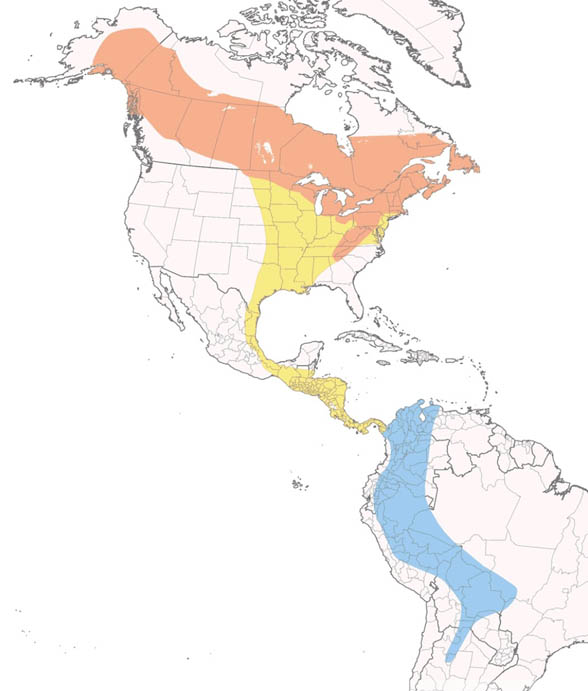
Sources:
- Alder Flycatcher. (2020, April 14). Audubon. https://www.audubon.org/field-guide/bird/alder-flycatcher
- Powdermill Nature Reserve, Carnegie Museum of Natural History
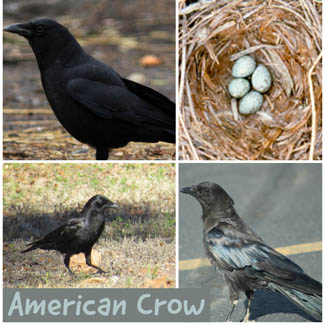
- Grid (counterclockwise):
- Male: Kevin McGowan / Macaulay Library at the Cornell Lab of Ornithology (ML41069641)
- Female: Dennis Forsythe / Macaulay Library at the Cornell Lab of Ornithology (ML47212721)
- Juvenile: West Tennessee Historical Data / Macaulay Library at the Cornell Lab of Ornithology (ML67545601)
- Nest/Eggs: Jim Lind / Macaulay Library at the Cornell Lab of Ornithology (ML89952491)
- Range map provided by Birds of the World
Click here to lean more about American Crow
American Crow
Corvus brachyrhynchos
Crows are thought to be among our most intelligent birds, and the success of the American Crow in adapting to civilization would seem to confirm this. Despite past attempts to exterminate them, crows are more common than ever in farmlands, towns, and even cities, and their distinctive caw is a familiar sound over much of the continent. Sociable, especially when not nesting, crows may gather in communal roosts on winter nights, sometimes with thousands or even tens of thousands roosting in one grove.
The largest crow found in North America, it has uniformly black plumage and a fan-shaped tail. Its bill is larger than other American crows but distinctly smaller than either raven. On rare occasions, individuals show white patches in wings. Juveniles have a brownish cast to feathers, a grayish eye, and grayish fleshy gape which quickly darkens after fledging. Crows fly steady, with low rowing wingbeats, and do not soar.
The largest crow found in North America, it has uniformly black plumage and a fan-shaped tail. Its bill is larger than other American crows but distinctly smaller than either raven. On rare occasions, individuals show white patches in wings. Juveniles have a brownish cast to feathers, a grayish eye, and grayish fleshy gape which quickly darkens after fledging. Crows fly steady, with low rowing wingbeats, and do not soar.

Sources:
- American Crow. (2020, September 23). Audubon. https://www.audubon.org/field-guide/bird/american-crow
- American Crow: National Geographic. (2006). Retrieved May 03, 2021, from https://www.nationalgeographic.com/animals/birds/facts/american-crow
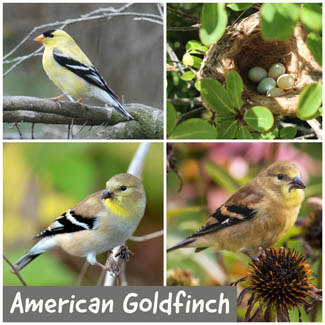
- Grid (counterclockwise):
- Male: Michael I Christie / Macaulay Library at the Cornell Lab of Ornithology (ML267221661)
- Female: Shailesh Pinto / Macaulay Library at the Cornell Lab of Ornithology (ML279256371)
- Juvenile: Michel Laquerre / Macaulay Library at the Cornell Lab of Ornithology (ML262803421)
- Nest/Eggs: Burke Korol / Macaulay Library at the Cornell Lab of Ornithology (ML89082241)
- Range map provided by Birds of the World
Click here to lean more about American Goldfinch
American Goldfinch
Spinus tristis
A typical summer sight is a male American Goldfinch flying over a meadow, flashing golden in the sun, calling perchickory as it bounds up and down in flight. In winter, when males and females alike are colored in subtler brown, flocks of goldfinches congregate in weedy fields and at feeders, making musical and plaintive calls. In most regions this is a late nester, beginning to nest in mid-summer, perhaps to assure a peak supply of late-summer seeds for feeding its young.
The American Goldfinch only begins nesting from late July to September, when most other songbirds are winding down breeding activity. This timing coincides with the abundance of their chief food source — seeds — in the late summer months. Almost any sort of seed will do. Thistles are favored, but this goldfinch readily feeds on a wide variety of weed, flower, tree, and grass seeds, as well as buds, sap, berries, and, less commonly, insects.
This species has several adaptations suited to its granivorous (seed-eating) diet, including a strong, conical bill that easily gathers and splits seed, and dexterous legs and feet, which allow the American Goldfinch to easily scramble up and down plant stems and hang from seed heads while feeding, thereby accessing seed sources unavailable to other birds.
A male American Goldfinch in breeding plumage is easy to recognize: a bright, sunny yellow with jet-black wings and cap. Like other common feeder birds such as the Northern Cardinal or Dark-eyed Junco, the American Goldfinch is a sexually dimorphic species, with the female much drabber than the eye-catching male. In the goldfinch's case, this difference is especially apparent during the nesting season. In the winter, both sexes look much more alike, with feathers of brown, olive, and dull yellow-green, accented by buff or white markings. This noticeable change in the male's plumage leads some people to believe that American Goldfinches are absent in the winter, when in fact they may still be around — just in duller plumage! The males' molt from drab to brilliant in the spring makes it seem as if they just appeared from nowhere.
The American Goldfinch only begins nesting from late July to September, when most other songbirds are winding down breeding activity. This timing coincides with the abundance of their chief food source — seeds — in the late summer months. Almost any sort of seed will do. Thistles are favored, but this goldfinch readily feeds on a wide variety of weed, flower, tree, and grass seeds, as well as buds, sap, berries, and, less commonly, insects.
This species has several adaptations suited to its granivorous (seed-eating) diet, including a strong, conical bill that easily gathers and splits seed, and dexterous legs and feet, which allow the American Goldfinch to easily scramble up and down plant stems and hang from seed heads while feeding, thereby accessing seed sources unavailable to other birds.
A male American Goldfinch in breeding plumage is easy to recognize: a bright, sunny yellow with jet-black wings and cap. Like other common feeder birds such as the Northern Cardinal or Dark-eyed Junco, the American Goldfinch is a sexually dimorphic species, with the female much drabber than the eye-catching male. In the goldfinch's case, this difference is especially apparent during the nesting season. In the winter, both sexes look much more alike, with feathers of brown, olive, and dull yellow-green, accented by buff or white markings. This noticeable change in the male's plumage leads some people to believe that American Goldfinches are absent in the winter, when in fact they may still be around — just in duller plumage! The males' molt from drab to brilliant in the spring makes it seem as if they just appeared from nowhere.
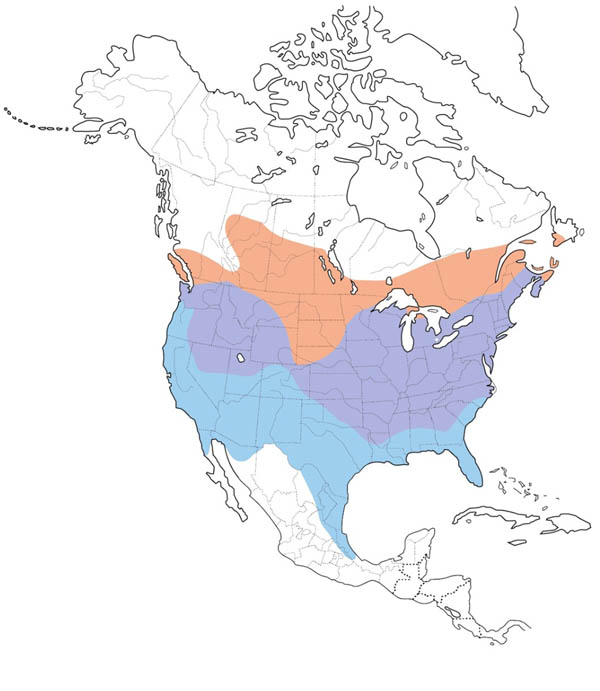
Sources:
- American Bird Conservancy. (2020e, July 20). American Goldfinch. https://abcbirds.org/bird/american-goldfinch/
- American goldfinch. (2020, April 14). Retrieved May 03, 2021, from https://www.audubon.org/field-guide/bird/american-goldfinch
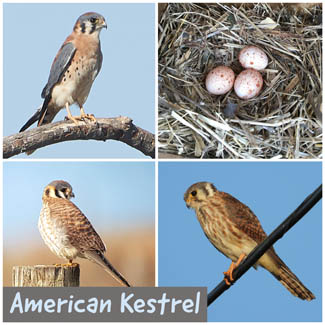
- Grid (counterclockwise):
- Male: Tyler Ekholm / Macaulay Library at the Cornell Lab of Ornithology (ML276709491)
- Female: Jim St Laurent / Macaulay Library at the Cornell Lab of Ornithology (ML273270501)
- Juvenile: Jennifer Coffey / Macaulay Library at the Cornell Lab of Ornithology (ML269184471)
- Nest/Eggs: Janet Getgood / Macaulay Library at the Cornell Lab of Ornithology (ML156263381)
- Range map provided by Birds of the World
Click here to lean more about American Kestrel
American Kestrel
Turdus migratorius
About the size of a Blue Jay, the American Kestrel is the smallest falcon in North America. Common nicknames for this scrappy little raptor include "sparrow hawk" (after the distantly related Eurasian Sparrowhawk), "grasshopper hawk," for one of its favorite prey items, and "killy hawk," due to its shrill call. The American Kestrel is found in the same open habitat as birds including the Eastern Meadowlark and Barn Swallow.
American Kestrels have two black spots, known as ocelli ("little eyes" in Latin), at the back of their heads. These false "eyes" help protect this little falcon from potential attackers sneaking up from the rear, whether they are predators or mobbing songbirds. American Kestrels also have two vertical black facial markings on each side of the head, in contrast to most other falcon species, which only have one.
It is fairly easily to identify an American Kestrel by its fast flight and habit of pumping its tail up and down while perched. This bird is also quite vocal, sounding off with a loud, repeated "killy, killy, killy" when excited or alarmed.
American Kestrels have two black spots, known as ocelli ("little eyes" in Latin), at the back of their heads. These false "eyes" help protect this little falcon from potential attackers sneaking up from the rear, whether they are predators or mobbing songbirds. American Kestrels also have two vertical black facial markings on each side of the head, in contrast to most other falcon species, which only have one.
It is fairly easily to identify an American Kestrel by its fast flight and habit of pumping its tail up and down while perched. This bird is also quite vocal, sounding off with a loud, repeated "killy, killy, killy" when excited or alarmed.
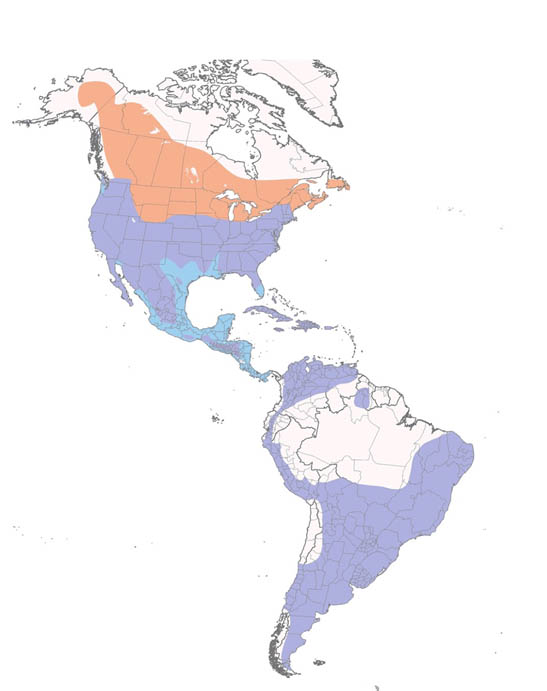
Sources:
- American Bird Conservancy. (2020e, July 20). American Kestrel. https://abcbirds.org/bird/american-kestrel/
- Maryland birds: American Kestrel. (n.d.). Retrieved May 10, 2021, from https://dnr.maryland.gov/wildlife/Pages/plants_wildlife/American_Kestrel.aspx

- Grid (counterclockwise):
- Male: Ana Paula Oxom / Macaulay Library at the Cornell Lab of Ornithology (ML278754201)
- Female: barbara taylor / Macaulay Library at the Cornell Lab of Ornithology (ML269554061)
- Juvenile: Dana Kornitz / Macaulay Library at the Cornell Lab of Ornithology (ML262589361)
- Nest/Eggs: Aaron Souder / Macaulay Library at the Cornell Lab of Ornithology (ML241389601)
- Range map provided by Birds of the World
Click here to lean more about American Redstart
American Redstart
Setophaga ruticilla
One of our most recognizable wood warblers, the eye-catching American Redstart is named for the male's vivid reddish-orange tail patches; "start" is an old English word for tail. In Latin America, this redstart is often called candelita, or "little torch." American Redstarts winter in Central America, northern South America, and the Caribbean, including the island of Hispaniola.
American Redstarts are active feeders, taking insects by flycatching or gleaning from foliage. Redstarts are often observed quickly fanning their tails open and closed; this "flashing" of the orange or yellow patches on the birds' tails startles their prey out of hiding.
Male American Redstarts have a somewhat unusual molt strategy, at least for North American wood warblers. By the end of breeding season, most warblers that are sexually dimorphic (males and females have different plumage) are relatively easy to sex because they look different. Redstarts, however, are different: young males remain in brown and yellow plumage, looking very much like females, until after their first breeding season, at which point they replace all the feathers on their body and become black and orange. Birds molt at least once each year, and in the case of redstarts, once a male has molted into its black and orange plumage, it will grow new black, and orange feathers every time it molts for the rest of its life!
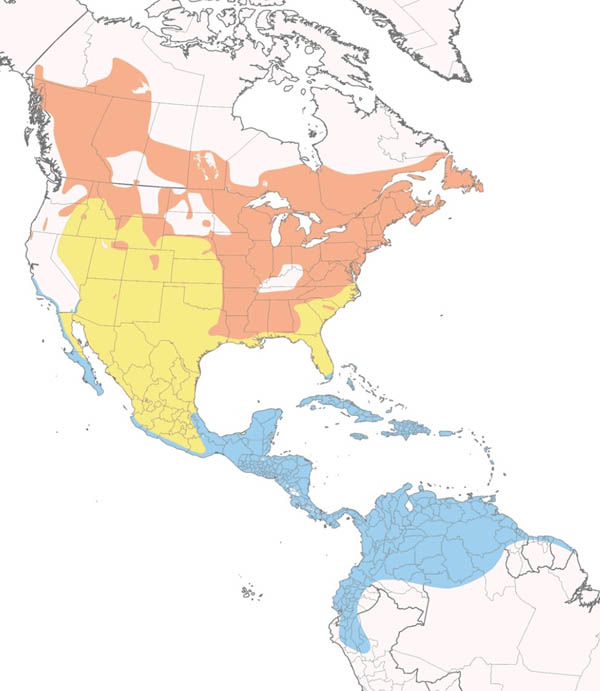
Sources:
- American Bird Conservancy. (2020a, June 24). American Redstart. https://abcbirds.org/bird/american-redstart/
- Powdermill Nature Reserve, Carnegie Museum of Natural History

- Grid (counterclockwise):
- Male: Tyler Ekholm / Macaulay Library at the Cornell Lab of Ornithology (ML276709491)
- Female: Jim St Laurent / Macaulay Library at the Cornell Lab of Ornithology (ML273270501)
- Juvenile: Jennifer Coffey / Macaulay Library at the Cornell Lab of Ornithology (ML269184471)
- Nest/Eggs: Janet Getgood / Macaulay Library at the Cornell Lab of Ornithology (ML)
- Range map provided by Birds of the World
Click here to lean more about American Robin
American Robin
Turdus migratorius
The American Robin is one of North America's most widespread, familiar, and well-loved songbirds. Although homesick settlers named it after the European Robin because of its reddish-orange breast, the two species are not closely related. The American Robin is a thrush, related to the Wood Thrush, Swainson's Thrush, and Hermit Thrush, while the European Robin is an Old World flycatcher.
In late winter, male American Robins begin to sing their cheerful, caroling song (cheerily cheer-up cheerio.), a sure harbinger of springtime for many. The early chorus continues through spring, into summer. It is one of the first birds to sing in the morning, often beginning well before dawn, and one of the last to be heard at night. In addition, this species has a variety of distinctive calls, including a shrill cheep alarm call and a low tuktuktuk when disturbed.
Robins are large with dark gray-brown backs and wings, gray (in females) to black (in males) heads, and rusty red breasts. Many people express surprise to see robins in the winter, but we do have them in southwestern Pennsylvania all year. They are a migratory species, but some birds opt to stay far north. Why is this, if there are much more abundant food resources farther south, especially for a frugivorous/insectivorous bird like the robin? It is a tradeoff – birds that winter farther north may encounter lower food resources and adverse weather conditions, but those that survive the winter are already in place to claim the very best breeding territories. So, seeing robins in the winter is a sign that there are likely decent food resources nearby!
In late winter, male American Robins begin to sing their cheerful, caroling song (cheerily cheer-up cheerio.), a sure harbinger of springtime for many. The early chorus continues through spring, into summer. It is one of the first birds to sing in the morning, often beginning well before dawn, and one of the last to be heard at night. In addition, this species has a variety of distinctive calls, including a shrill cheep alarm call and a low tuktuktuk when disturbed.
Robins are large with dark gray-brown backs and wings, gray (in females) to black (in males) heads, and rusty red breasts. Many people express surprise to see robins in the winter, but we do have them in southwestern Pennsylvania all year. They are a migratory species, but some birds opt to stay far north. Why is this, if there are much more abundant food resources farther south, especially for a frugivorous/insectivorous bird like the robin? It is a tradeoff – birds that winter farther north may encounter lower food resources and adverse weather conditions, but those that survive the winter are already in place to claim the very best breeding territories. So, seeing robins in the winter is a sign that there are likely decent food resources nearby!
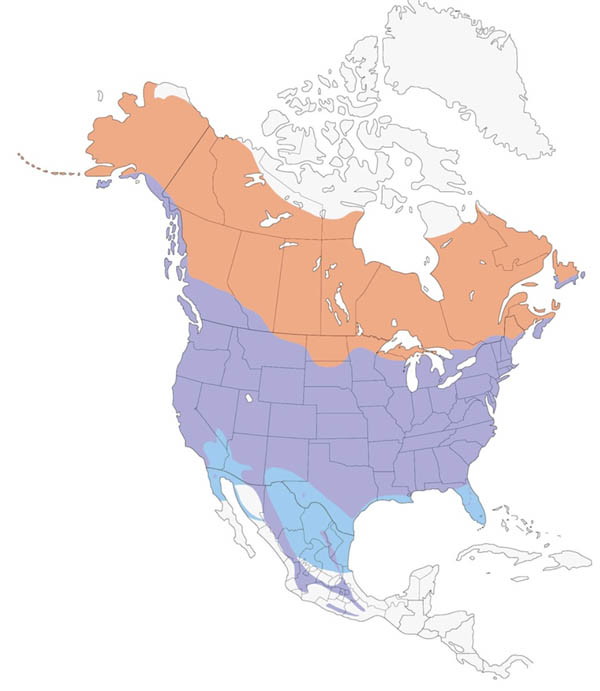
Sources:
- American Bird Conservancy. (2020a, June 24). American Robin. https://abcbirds.org/bird/american-robin/
- Powdermill Nature Reserve, Carnegie Museum of Natural History
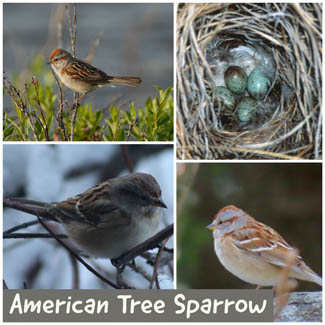
- Grid (counterclockwise):
- Male: Yeray Seminario / Macaulay Library at the Cornell Lab of Ornithology (ML)
- Female: Gary Mueller / Macaulay Library at the Cornell Lab of Ornithology (ML261923961)
- Juvenile: Laure Wilson Neish / Macaulay Library at the Cornell Lab of Ornithology (ML252414801)
- Nest/Eggs: Kristen Johnson / Macaulay Library at the Cornell Lab of Ornithology (ML246196111)
- Range map provided by Birds of the World
Click here to lean more about American Tree Sparrow
American Tree Sparrow
Spizelloides arborea
This sparrow nests and winters farther north than any of its close relatives. Despite the name, it is not particularly associated with trees, and many of its nesting areas are on the tundra north of the tree line. In winter in the northern states, flocks of Tree Sparrows are common in open country. They often come to bird feeders with Dark-eyed Juncos and other birds. Males may begin singing their musical songs in late winter before they start their northward migration.
Chipping and Tree Sparrows are very similar but check out the eye stripe on both – on the American Tree Sparrow, it is rufous. Tree Sparrows have a bicolored bill (black upper mandible, yellow lower mandible) and have a "tie tack" in the center of the breast. One of the last migratory songbirds we see in fall is the American Tree Sparrow, and its arrival is a sure sign that winter is here.
Chipping and Tree Sparrows are very similar but check out the eye stripe on both – on the American Tree Sparrow, it is rufous. Tree Sparrows have a bicolored bill (black upper mandible, yellow lower mandible) and have a "tie tack" in the center of the breast. One of the last migratory songbirds we see in fall is the American Tree Sparrow, and its arrival is a sure sign that winter is here.
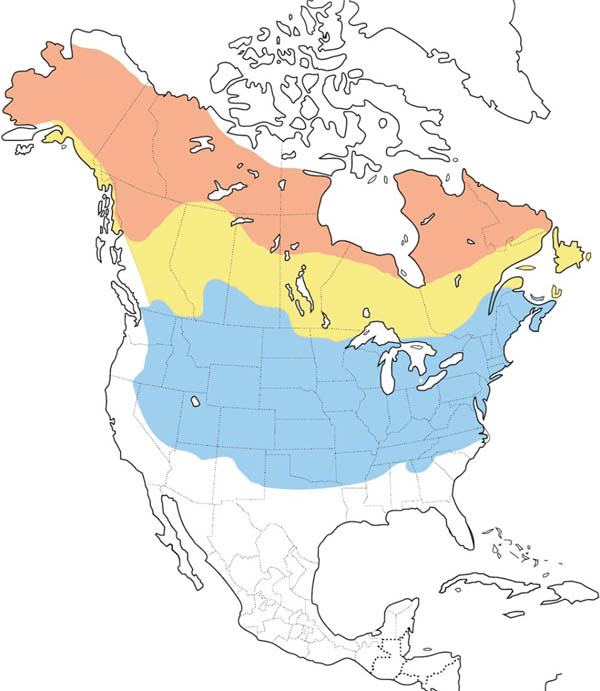
Sources:
- American Tree Sparrow. (2019, October 11). Audubon. https://www.audubon.org/field-guide/bird/american-tree-sparrow
- Powdermill Nature Reserve, Carnegie Museum of Natural History
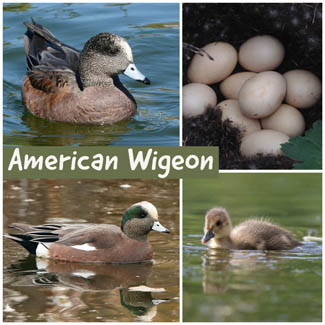
- Grid (counterclockwise):
- Male: Cathy Pasterczyk / Macaulay Library at the Cornell Lab of Ornithology (ML381005601)
- Female: Cathy Sheeter / Macaulay Library at the Cornell Lab of Ornithology (ML382507671)
- Juvenile: Josiah Verbrugge / Macaulay Library at the Cornell Lab of Ornithology (ML289412001)
- Nest/Eggs: Micah Grove / Macaulay Library at the Cornell Lab of Ornithology (ML173587711)
- Range map provided by Birds of the World
Click here to lean more about American Wigeon
American Wigeon
Mareca americana
While most ducks spend most of their time in the shallows, American Wigeon spends much of their time in flocks grazing on land. Ironically, they also spend more time on deep-water than other marshes, where they get much of their food by stealing it from other birds such as coots or diving ducks. This duck was once named 'Baldpate' because of its white crown.
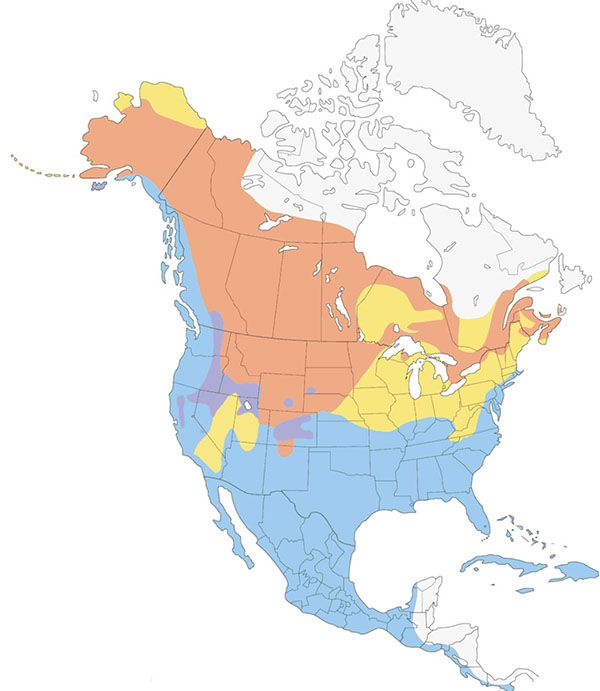
Sources:
- American wigeon. Audubon. (2021, October 20). Retrieved December 15, 2021, from https://www.audubon.org/field-guide/bird/american-wigeon
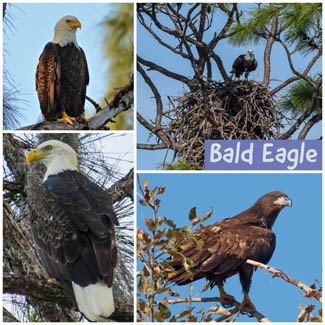
- Grid (counterclockwise):
- Male: Ken Schneider / Macaulay Library at the Cornell Lab of Ornithology (ML368871671)
- Female: Carol Delynko / Macaulay Library at the Cornell Lab of Ornithology (ML364106681)
- Juvenile: Josiah Verbrugge / Macaulay Library at the Cornell Lab of Ornithology (ML289412001)
- Nest/Eggs: Micah Grove / Macaulay Library at the Cornell Lab of Ornithology (ML173587711)
- Range map provided by Birds of the World
Click here to lean more about Bald Eagle
Bald Eagle
Haliaeetus leucocephalus
The emblem bird of the United States, majestic in its appearance. It is not always so majestic in habits: it often feeds on carrion, including dead fish washed up on shore, and it steals food from Ospreys and other smaller birds. At other times, however, it is a powerful predator. Seriously declining during much of the 20th century, the Bald Eagle has made a comeback in many areas since the 1970s. Big concentrations can be found wintering along rivers or reservoirs in some areas.
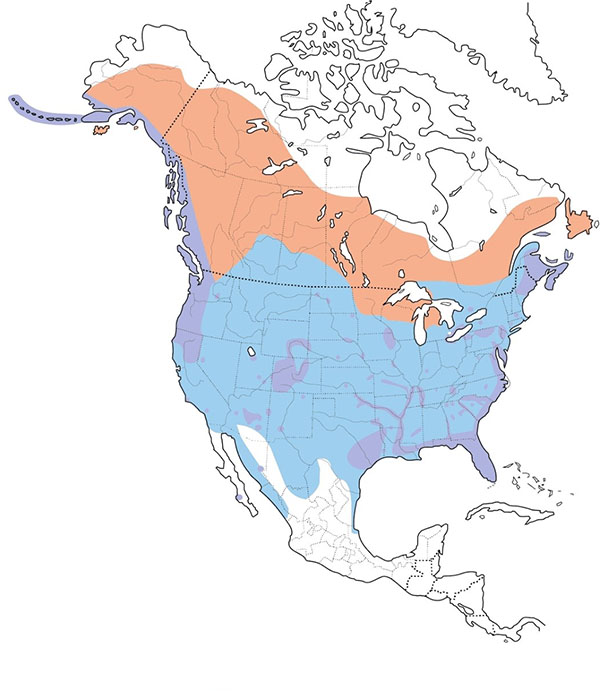
Sources:
- Bald eagle. Audubon. (2021, October 20). Retrieved December 15, 2021, from https://www.audubon.org/field-guide/bird/bald-eagle
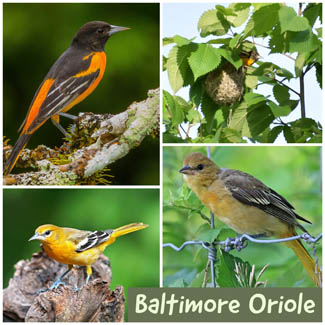
- Grid (counterclockwise):
- Male: Yeray Seminario / Macaulay Library at the Cornell Lab of Ornithology (ML270098301)
- Female: Gary Mueller / Macaulay Library at the Cornell Lab of Ornithology (ML261923961)
- Juvenile: Laure Wilson Neish / Macaulay Library at the Cornell Lab of Ornithology (ML252414801)
- Nest/Eggs: Kristen Johnson / Macaulay Library at the Cornell Lab of Ornithology (ML246196111)
- Range map provided by Birds of the World
Click here to lean more about Baltimore Oriole
Baltimore Oriole
Icterus galbula
The eye-catching orange and black plumage of the Baltimore Oriole echoes the colors on the coat of arms of England's Baltimore family, some of the first administrators of the state of Maryland. The species is Maryland's state bird and the namesake of its pro baseball team.
The Baltimore Oriole is a member of the blackbird family, so is related to Red-winged Blackbird. Habitat loss on breeding and wintering grounds, pesticide use, outdoor cats, and collisions with glass and towers are the chief threats to this species.
Baltimore Orioles commonly breed in southwestern Pennsylvania, although sometimes they are hard to spot because they tend to stay high in trees where they build pendulum-shaped nests. They will readily come to feeders with fresh orange halves, grape jelly, and nectar, especially during migrations or after young have fledged.
During the breeding season, Baltimore Orioles voraciously feed on caterpillars (even hairy ones that many other bird species avoid!), insects, and spiders. They forage while moving through the treetops, gleaning from leaves and branches, and even picking insects from spider webs. By feeding on large quantities of larvae and insects, the Baltimore Oriole protects trees from extensive damage, providing a valuable ecological service. In the fall and winter, they switch diets from insects to fruit and, interestingly, seem to prefer dark-colored fruit like mulberries and black cherries.
The Baltimore Oriole is a member of the blackbird family, so is related to Red-winged Blackbird. Habitat loss on breeding and wintering grounds, pesticide use, outdoor cats, and collisions with glass and towers are the chief threats to this species.
Baltimore Orioles commonly breed in southwestern Pennsylvania, although sometimes they are hard to spot because they tend to stay high in trees where they build pendulum-shaped nests. They will readily come to feeders with fresh orange halves, grape jelly, and nectar, especially during migrations or after young have fledged.
During the breeding season, Baltimore Orioles voraciously feed on caterpillars (even hairy ones that many other bird species avoid!), insects, and spiders. They forage while moving through the treetops, gleaning from leaves and branches, and even picking insects from spider webs. By feeding on large quantities of larvae and insects, the Baltimore Oriole protects trees from extensive damage, providing a valuable ecological service. In the fall and winter, they switch diets from insects to fruit and, interestingly, seem to prefer dark-colored fruit like mulberries and black cherries.
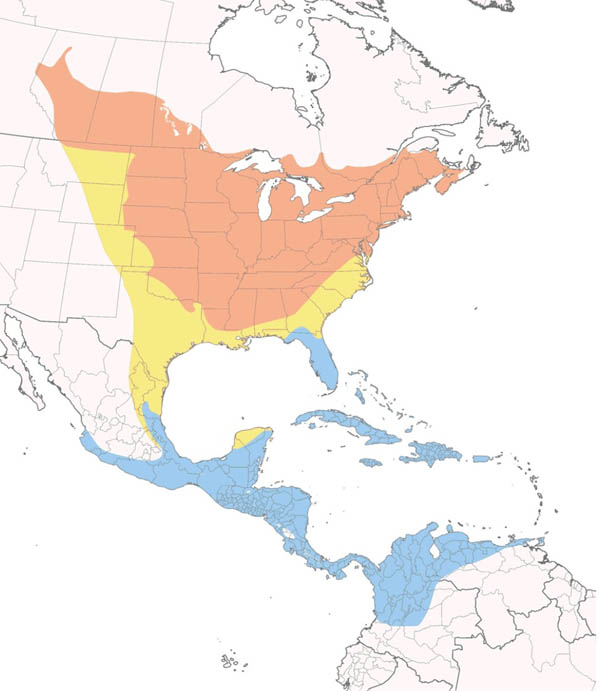
Sources:
- American Bird Conservancy. (2020a, June 19). Baltimore Oriole. https://abcbirds.org/bird/baltimore-oriole/
- Powdermill Nature Reserve, Carnegie Museum of Natural History
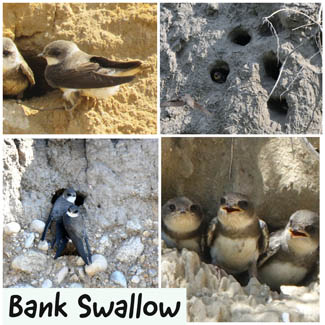
- Grid (counterclockwise):
- Male: Howard Lorenz / Macaulay Library at the Cornell Lab of Ornithology (ML81885211)
- Female: Charles Hundertmark / Macaulay Library at the Cornell Lab of Ornithology (ML226287971)
- Juvenile: Lisa Hug / Macaulay Library at the Cornell Lab of Ornithology (ML252697791)
- Nest/Eggs: Alexandre Terrigeol / Macaulay Library at the Cornell Lab of Ornithology (ML248696531)
- Range map provided by Birds of the World
Click here to lean more about Bank Swallow
Bank Swallow
Riparia riparia
The Bank Swallow is a small insectivorous songbird with brown upperparts, white underparts, and a distinctive dark breast band. It is distinguishable in flight from other swallows by its quick, erratic wing beats and its almost constant buzzy, chattering vocalizations. The species is highly social at all times of the year and is conspicuous at colonial breeding sites where it excavates nesting burrows in eroding vertical banks.
The smallest of the swallows, the Bank Swallow is usually seen in flocks, flying low over ponds and rivers with quick, fluttery wingbeats. It nests in dense colonies, in holes in dirt or sandbanks. Some of these colonies are quite large, and a tall-cut bank may be pockmarked with several hundred holes. Despite their small size, tiny bills, and small feet, these swallows generally dig their nesting burrows, sometimes up to five feet long.
The smallest of the swallows, the Bank Swallow is usually seen in flocks, flying low over ponds and rivers with quick, fluttery wingbeats. It nests in dense colonies, in holes in dirt or sandbanks. Some of these colonies are quite large, and a tall-cut bank may be pockmarked with several hundred holes. Despite their small size, tiny bills, and small feet, these swallows generally dig their nesting burrows, sometimes up to five feet long.
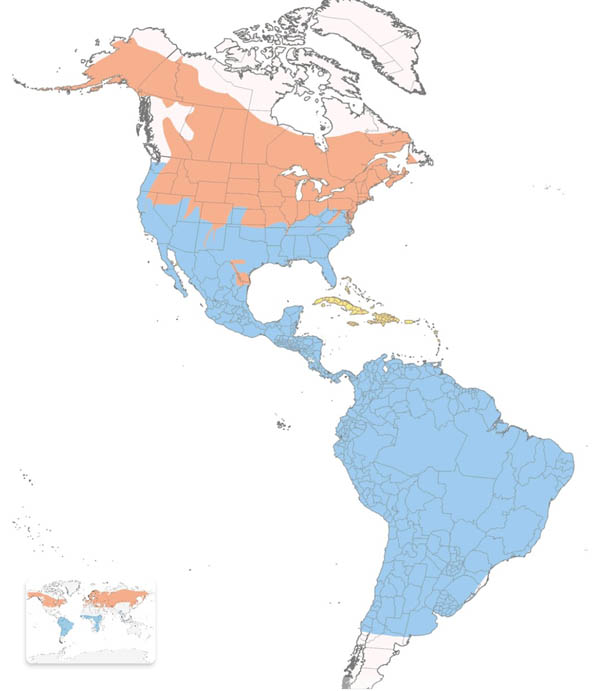
Sources:
- Bank Swallow. (2019, October 22). Audubon. https://www.audubon.org/field-guide/bird/bank-swallow
- Species profile: Bank Swallow. (2017, August 24). Retrieved May 03, 2021, from https://wildlife-species.canada.ca/species-risk-registry/species/speciesDetails_e.cfm?sid=1233

- Grid (counterclockwise):
- Male: Michael Stubblefield / Macaulay Library at the Cornell Lab of Ornithology (ML273394151)
- Female: Adele Wilson / Macaulay Library at the Cornell Lab of Ornithology (ML245538931)
- Juvenile: A Emmerson / Macaulay Library at the Cornell Lab of Ornithology (ML273980361)
- Nest/Eggs: Melody Walsh / Macaulay Library at the Cornell Lab of Ornithology (ML29725741)
- Range map provided by Birds of the World
Click here to lean more about Barn Swallow
Barn Swallow
Hirundo rustica
Adult male Barn Swallows have a deep iridescent blue crown, back, rump, and wing coverts; deeply forked tail with large white spots; and a rich buff to rufous forehead and underparts. He also has iridescent blue patches on the sides of the breast, sometimes with a very narrow connection in the center. His wings and tail are black. The adult female Barn Swallow appearance is like the male but with paler underparts and a less deeply forked tail.
This metallic-blue-backed "country swallow" — a literal translation of its Latin name — is a familiar sight on farms and in other rural habitats around the world. No other swallow in North America shows such a deeply forked tail. Shorter-tailed juveniles in flight may suggest the Tree Swallow but will always show partial dark breast band and buff throat, white spots on the tail. This distinctive feature is associated with interesting folklore: A Barn Swallow stole fire from the gods to bring it to the people on Earth. One particularly angry god threw fire arrows at the swallow as it fled, singeing off the middle of its tail. The result was the Barn Swallow's distinctive, fork-tailed profile!
This metallic-blue-backed "country swallow" — a literal translation of its Latin name — is a familiar sight on farms and in other rural habitats around the world. No other swallow in North America shows such a deeply forked tail. Shorter-tailed juveniles in flight may suggest the Tree Swallow but will always show partial dark breast band and buff throat, white spots on the tail. This distinctive feature is associated with interesting folklore: A Barn Swallow stole fire from the gods to bring it to the people on Earth. One particularly angry god threw fire arrows at the swallow as it fled, singeing off the middle of its tail. The result was the Barn Swallow's distinctive, fork-tailed profile!
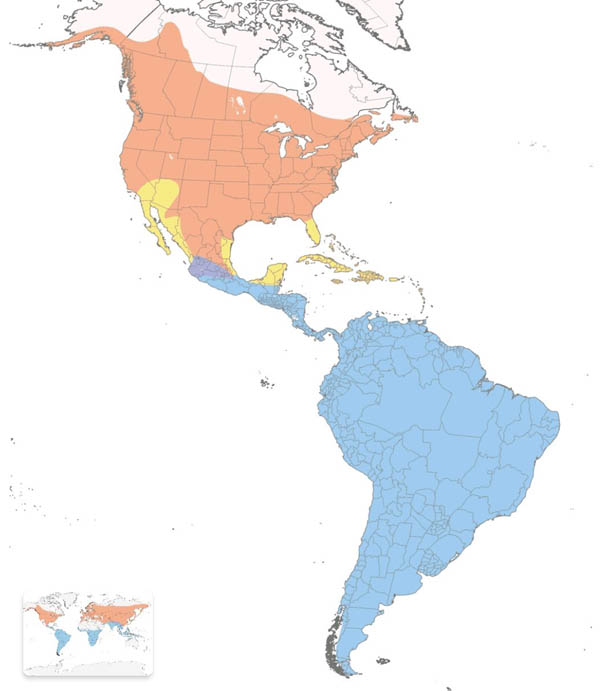
Sources:
- American Bird Conservancy. (2020b, June 24). Barn Swallow. https://abcbirds.org/bird/barn-swallow-3/
- Barn swallow: National Geographic. (2006). Retrieved May 03, 2021, from https://www.nationalgeographic.com/animals/birds/facts/barn-swallow
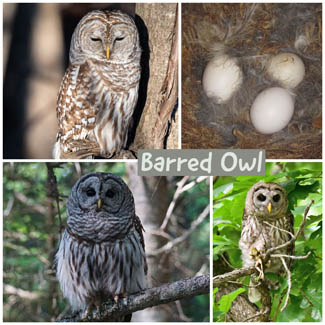
- Grid (counterclockwise):
- Male: Eric Seyferth / Macaulay Library at the Cornell Lab of Ornithology (ML323373201)
- Female: Richard Mckay / Macaulay Library at the Cornell Lab of Ornithology (ML347785671)
- Juvenile: maggie s / Macaulay Library at the Cornell Lab of Ornithology (ML361956311)
- Nest/Eggs: Jack & Holly Bartholmai / Macaulay Library at the Cornell Lab of Ornithology (ML145747951)
- Range map provided by Birds of the World
Click here to lean more about Barred Owl
Barred Owl
Strix varia
The rich baritone hooting of the Barred Owl is a characteristic sound in southern swamps, where members of a pair often will call back and forth to each other. Although the bird is mostly active at night, it will also call and even hunt in the daytime. Only a little smaller than the Great Horned Owl, the Barred Owl is markedly less aggressive, and competition with its tough cousin may keep the Barred out of more open woods.
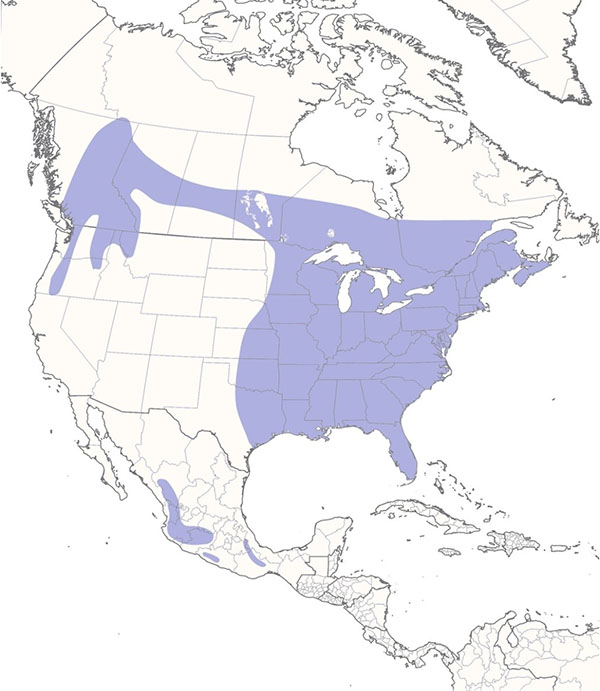
Sources:
- Barred owl. Audubon. (2021, October 20). Retrieved December 15, 2021, from https://www.audubon.org/field-guide/bird/barred-owl
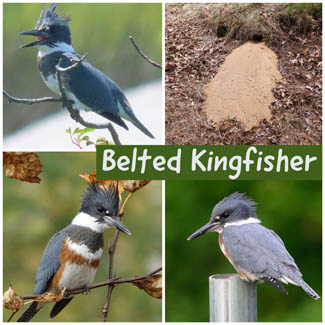
- Grid (counterclockwise):
- Male: Karen Lebing / Macaulay Library at the Cornell Lab of Ornithology (ML360567781)
- Female: Céline Roberge / Macaulay Library at the Cornell Lab of Ornithology (ML380761261)
- Juvenile: Stephen Davies / Macaulay Library at the Cornell Lab of Ornithology (ML353712451)
- Nest/Eggs: Samuel Burckhardt / Macaulay Library at the Cornell Lab of Ornithology (ML330747601)
- Range map provided by Birds of the World
Click here to lean more about Belted Kingfisher
Belted Kingfisher
Megaceryle alcyon
One of the most punk-rock bird hairdos in North America is that of the Belted Kingfisher. This species simultaneously looks like it needs a comb, but also looks so very good without a comb! The Belted Kingfisher is often first noticed by its wild rattling call as it flies over rivers or lakes. It may be seen perched on a high snag, or hovering on rapidly beating wings, then plunging headfirst into the water to grab a fish. Kingfishers have narrow heads and heavy beaks with backward serrations that help hold onto the fish they catch and direct them down their throats. Kingfishers are streamlined to maximize aerial fishing efficiency. They're so effective that engineers have used the shape of kingfishers, especially their bills, to design faster and more efficient high-speed trains!
Found almost throughout North America at one season or another, it is the only member of its family to be seen in most areas north of Mexico. Did you know that Belted Kingfishers regurgitate undigestible bits of food, just like owls? Female kingfishers have a bit more color than males: whereas both sexes have a steely blue breast band, females have a rufous cummerbund.
Found almost throughout North America at one season or another, it is the only member of its family to be seen in most areas north of Mexico. Did you know that Belted Kingfishers regurgitate undigestible bits of food, just like owls? Female kingfishers have a bit more color than males: whereas both sexes have a steely blue breast band, females have a rufous cummerbund.
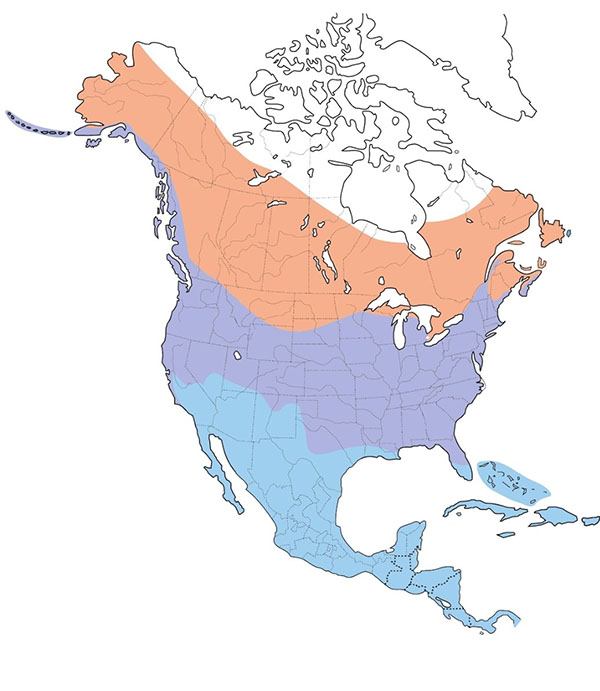
Sources:
- Belted kingfisher. Audubon. (2021, October 20). Retrieved December 15, 2021, from https://www.audubon.org/field-guide/bird/belted-kingfisher
- Powdermill Nature Reserve, Carnegie Museum of Natural History
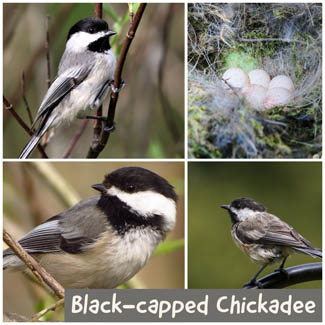
- Grid (counterclockwise):
- Male: Jim Stasz / Macaulay Library at the Cornell Lab of Ornithology (ML244593151)
- Female: G & B / Macaulay Library at the Cornell Lab of Ornithology (ML155968971)
- Juvenile: Michel Laquerre / Macaulay Library at the Cornell Lab of Ornithology (ML250986321)
- Nest/Eggs: Nest/Eggs: Joyce Wagner / Macaulay Library at the Cornell Lab of Ornithology (ML27756301)
- Range map provided by Birds of the World
Click here to lean more about Black-capped Chickadee
Black-capped Chickadee
Poecile atricapillus
The feisty Black-capped Chickadee is the most common and widespread of the seven chickadee species found in North America. Named for its call and trademark black cap, this little bird is a common sight at backyard bird feeders, along with species such as the Northern Cardinal, Pine Siskin, and American Goldfinch. "Springs here!" or "Hey sweetie!" are common mnemonic devices birders use to remember chickadee songs!
Each fall, Black-capped Chickadees gather and store large supplies of seeds in many different places – an adaptation that helps them to survive harsh winters. But how do they remember where they stash their supplies of seed?
Scientists have shown that Black-capped Chickadees can increase their memory capacity each fall by adding new brain cells to the hippocampus, the part of the brain that supports spatial memory. During this time, the chickadee's hippocampus expands in volume by around 30 percent! In the spring, when feats of memory are needed less, its hippocampus shrinks back to normal size. This phenomenon also occurs in other food-storing songbirds, including jays, nutcrackers, and nuthatches.
This remarkable plasticity is related to hormonal changes in the birds' brains. Scientists are studying this ability in the hopes of eventually helping humans suffering from memory loss.
Each fall, Black-capped Chickadees gather and store large supplies of seeds in many different places – an adaptation that helps them to survive harsh winters. But how do they remember where they stash their supplies of seed?
Scientists have shown that Black-capped Chickadees can increase their memory capacity each fall by adding new brain cells to the hippocampus, the part of the brain that supports spatial memory. During this time, the chickadee's hippocampus expands in volume by around 30 percent! In the spring, when feats of memory are needed less, its hippocampus shrinks back to normal size. This phenomenon also occurs in other food-storing songbirds, including jays, nutcrackers, and nuthatches.
This remarkable plasticity is related to hormonal changes in the birds' brains. Scientists are studying this ability in the hopes of eventually helping humans suffering from memory loss.
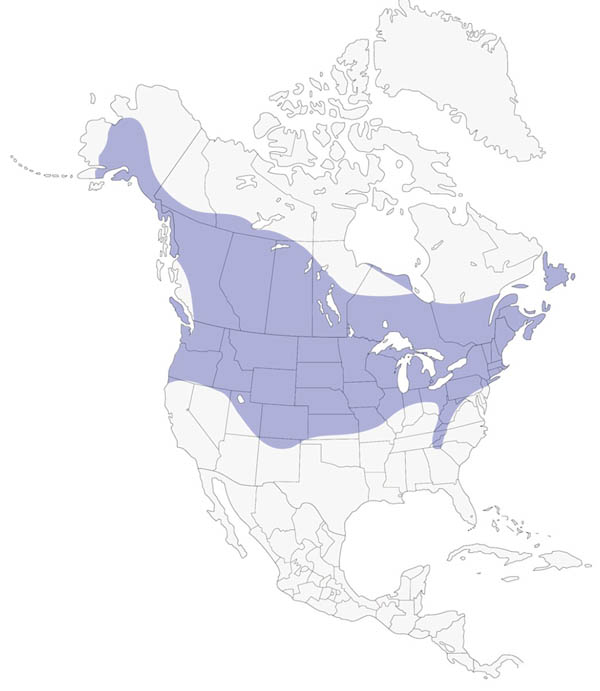
Sources:
- American Bird Conservancy. (2020c, June 24). Black-capped Chickadee. https://abcbirds.org/bird/black-capped-chickadee/
- Powdermill Nature Reserve, Carnegie Museum of Natural History
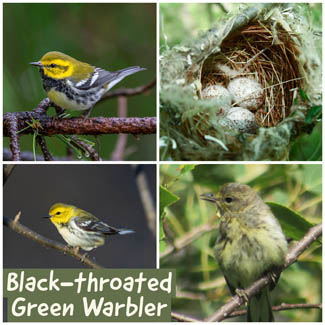
- Grid (counterclockwise):
- Male: fernando Burgalin Sequeria / Macaulay Library at the Cornell Lab of Ornithology (ML276623801)
- Female: Michael Stubblefield / Macaulay Library at the Cornell Lab of Ornithology (ML275854991)
- Juvenile: Laurent Bédard / Macaulay Library at the Cornell Lab of Ornithology (ML257480411)
- Nest/Eggs: Kristof Zyskowski / Macaulay Library at the Cornell Lab of Ornithology (ML191977071)
- Range map provided by Birds of the World
Click here to lean more about Black-throated Green Warbler
Black-throated Green Warbler
Setophaga virens
In the east, some of the easiest warbler voices to recognize are the patterned songs of the Black-throated Green. As if to confirm the identification, the brilliantly colored male often perches out in the open to sing, perhaps on a high twig of a spruce. He has two song types, used in different situations: he sings zoo zee zoo zoo zee to proclaim and defend his nesting territory, and zee zee zee zoo zee in courtship or when communicating with his mate.
When fall migration is here and continues into November, it the time to start watching for birds you only get to see during migration. Black-throated Green Warblers breed at higher elevations in the area (e.g., Laurel Mountain) and can be readily found during both spring and fall migrations.
When fall migration is here and continues into November, it the time to start watching for birds you only get to see during migration. Black-throated Green Warblers breed at higher elevations in the area (e.g., Laurel Mountain) and can be readily found during both spring and fall migrations.
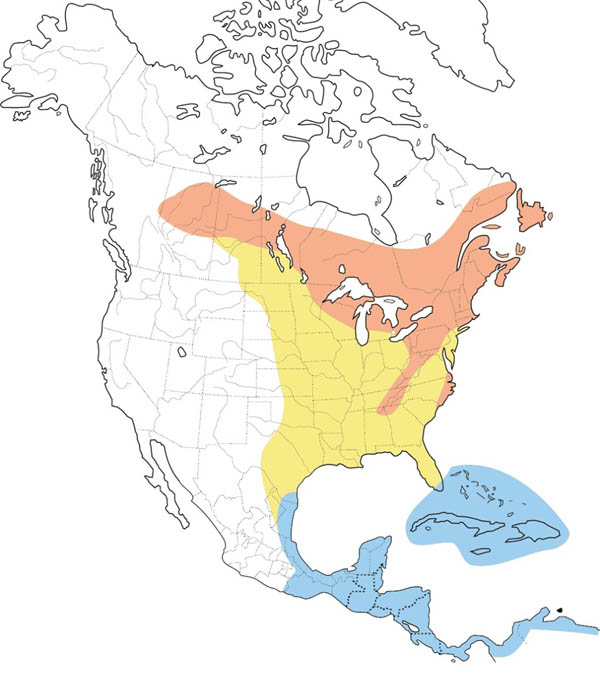
Sources:
- Black-throated Green Warbler. (2019, November 4). Audubon. https://www.audubon.org/field-guide/bird/black-throated-green-warbler
- Powdermill Nature Reserve, Carnegie Museum of Natural History
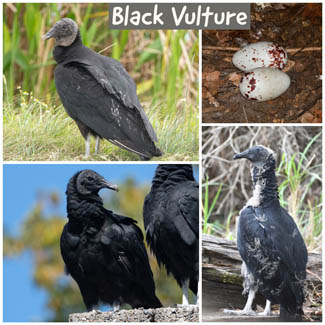
- Grid (counterclockwise):
- Male: Larry Theller / Macaulay Library at the Cornell Lab of Ornithology (ML214836881)
- Female: Richard Littauer / Macaulay Library at the Cornell Lab of Ornithology (ML269792001)
- Juvenile: Alena Capek / Macaulay Library at the Cornell Lab of Ornithology (ML224738771)
- Nest/Eggs: Kristof Zyskowski / Macaulay Library at the Cornell Lab of Ornithology (ML262270681)
- Range map provided by Birds of the World
Click here to lean more about Black Vulture
Black Vulture
Coragyps atratus
Abundant in the southeast, scarce in the southwest is this broad-winged scavenger. In low flight, it proceeds with several quick flaps followed by a flat-winged glide; when rising thermals provide good lift, it soars very high above the ground. Usually seen in flocks. Shorter wings and tail make it appear smaller than Turkey Vulture but looks are deceptive: body size is about the same, and aggressive Black Vultures often drive Turkey Vultures away from food.

Sources:
- Black Vulture. Audubon. (2021, October 20). Retrieved December 15, 2021, from https://www.audubon.org/field-guide/bird/black-vulture
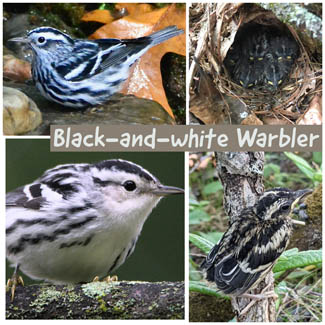
- Grid (counterclockwise):
- Male: Seth Honig / Macaulay Library at the Cornell Lab of Ornithology (ML379380921)
- Female: Kerry Loux / Macaulay Library at the Cornell Lab of Ornithology (ML379917601)
- Juvenile: Wendy Hill / Macaulay Library at the Cornell Lab of Ornithology (ML349514241)
- Nest/Eggs: Stephen Paull / Macaulay Library at the Cornell Lab of Ornithology (ML243143551)
- Range map provided by Birds of the World
Click here to lean more about Black-and-white Warbler
Black-and-white Warbler
Mniotilta varia
This bird is often a favorite warbler for beginning birders because it is easy to see and easy to recognize. It was once known as the 'Black-and-white Creeper,' a name that describes its behavior quite well. Like a nuthatch or creeper (and unlike other warblers), it climbs about on the trunks and major limbs of trees, seeking insects in the bark crevices. It often feeds low, and nests even lower, usually on the ground.
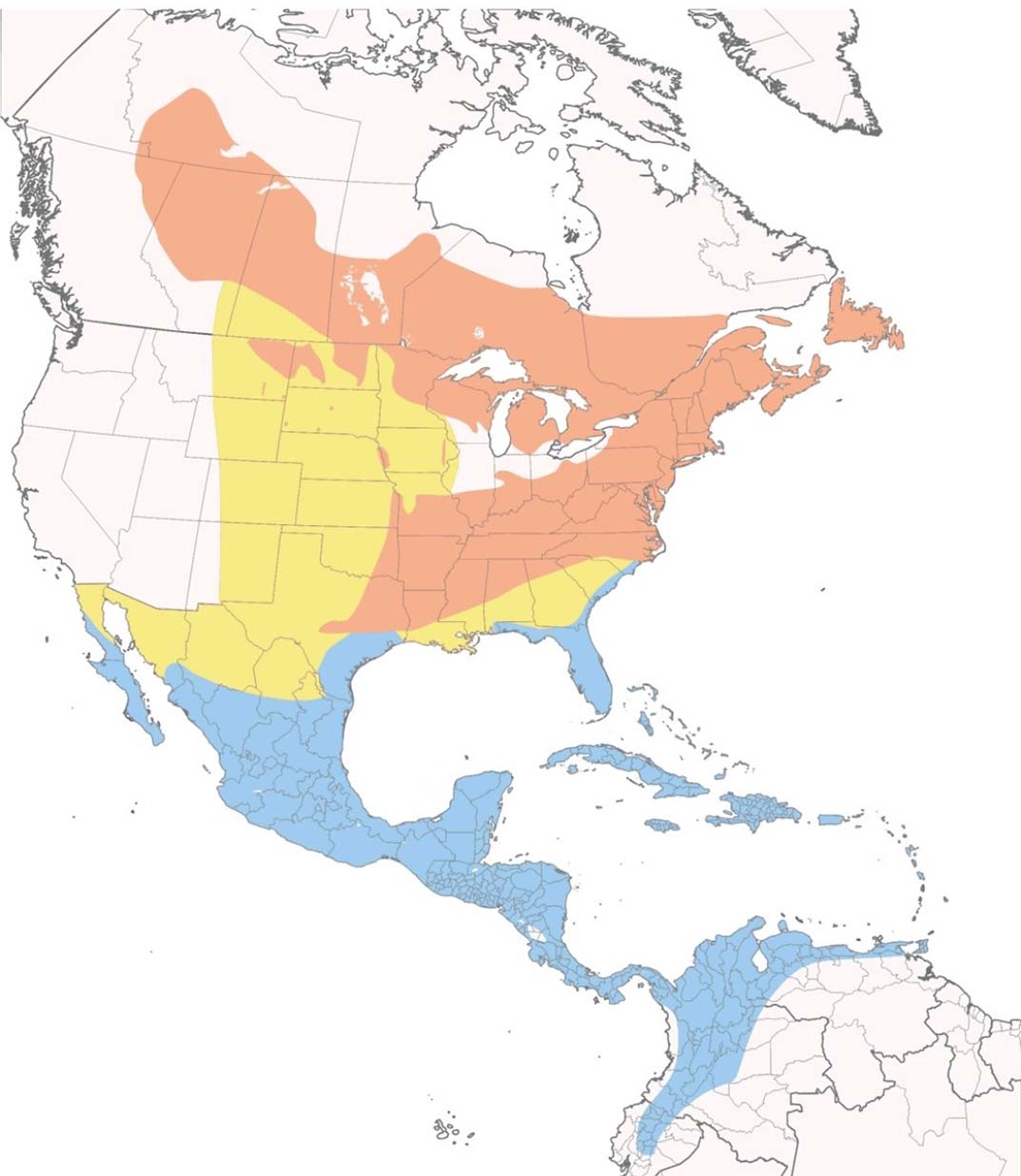
Sources:
- Black-and-white warbler. Audubon. (2021, October 20). Retrieved December 15, 2021, from https://www.audubon.org/field-guide/bird/black-and-white-warbler

- Grid (counterclockwise):
- Male: Lucio 'Luc' Fazio / Macaulay Library at the Cornell Lab of Ornithology (ML238826521)
- Female: Michael J Good / Macaulay Library at the Cornell Lab of Ornithology (ML350714361)
- Juvenile: Frédérick Lelièvre / Macaulay Library at the Cornell Lab of Ornithology (ML354103041)
- Nest/Eggs: Joel Trick / Macaulay Library at the Cornell Lab of Ornithology (ML250815411)
- Range map provided by Birds of the World
Click here to lean more about Black-billed Cuckoo
Black-billed Cuckoo
Coccyzus erythropthalmus
Slipping furtively through leafy thickets, this slim, long-tailed bird is heard more often than seen. It seems even more elusive than the Yellow-billed Cuckoo and is generally seen less often during migration, although the Black-billed is the more common nesting bird toward the north.
These birds are voracious consumers of noxious caterpillars like gypsy moth larvae, eastern tent caterpillar, and fall webworm. The caterpillars’ spines pierce cuckoos’ stomach lining and when it becomes excessive, the stomach lining is sloughed off and regurgitated! Cuckoos also eat cicadas.
These birds are voracious consumers of noxious caterpillars like gypsy moth larvae, eastern tent caterpillar, and fall webworm. The caterpillars’ spines pierce cuckoos’ stomach lining and when it becomes excessive, the stomach lining is sloughed off and regurgitated! Cuckoos also eat cicadas.
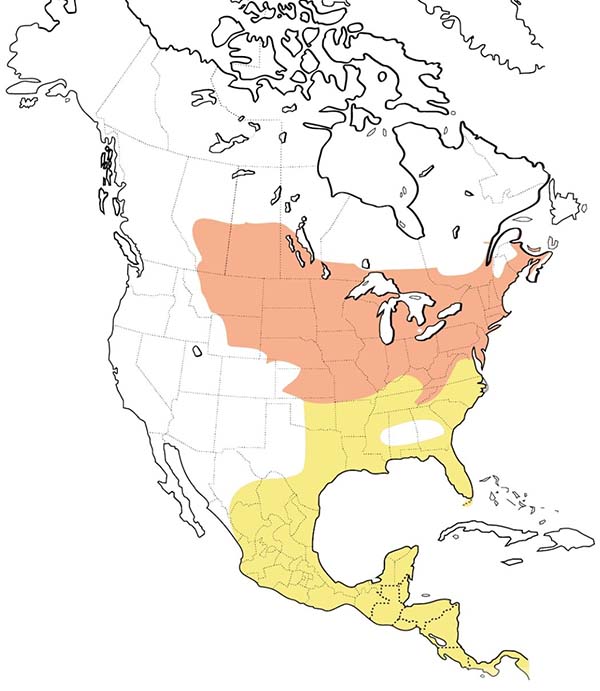
Sources:
- Black-billed cuckoo. Audubon. (2021, October 20). Retrieved December 15, 2021, from https://www.audubon.org/field-guide/bird/black-billed-cuckoo
- Powdermill Nature Reserve, Carnegie Museum of Natural History

- Grid (counterclockwise):
- Male: Daniel Pineda Vera / Macaulay Library at the Cornell Lab of Ornithology (ML371628831)
- Female: John Troth / Macaulay Library at the Cornell Lab of Ornithology (ML373815541)
- Juvenile: Jackie Elmore / Macaulay Library at the Cornell Lab of Ornithology (ML262191951)
- Nest/Eggs: / Macaulay Library at the Cornell Lab of Ornithology
- Range map provided by Birds of the World
Click here to lean more about Blackburnian Warbler
Blackburnian Warbler
Setophaga fusca
A fiery gem of the treetops. In the northern forest in summer, the male Blackburnian Warbler may perch on the topmost twig of a spruce, showing off the flaming orange of his throat as he sings his thin, wiry song. The female also stays high in the conifers, and the nest is usually built far above the ground. Long-distance migrants, most Blackburnians spend the winter in South America, where they are often common in the mountain forests of the Andes.
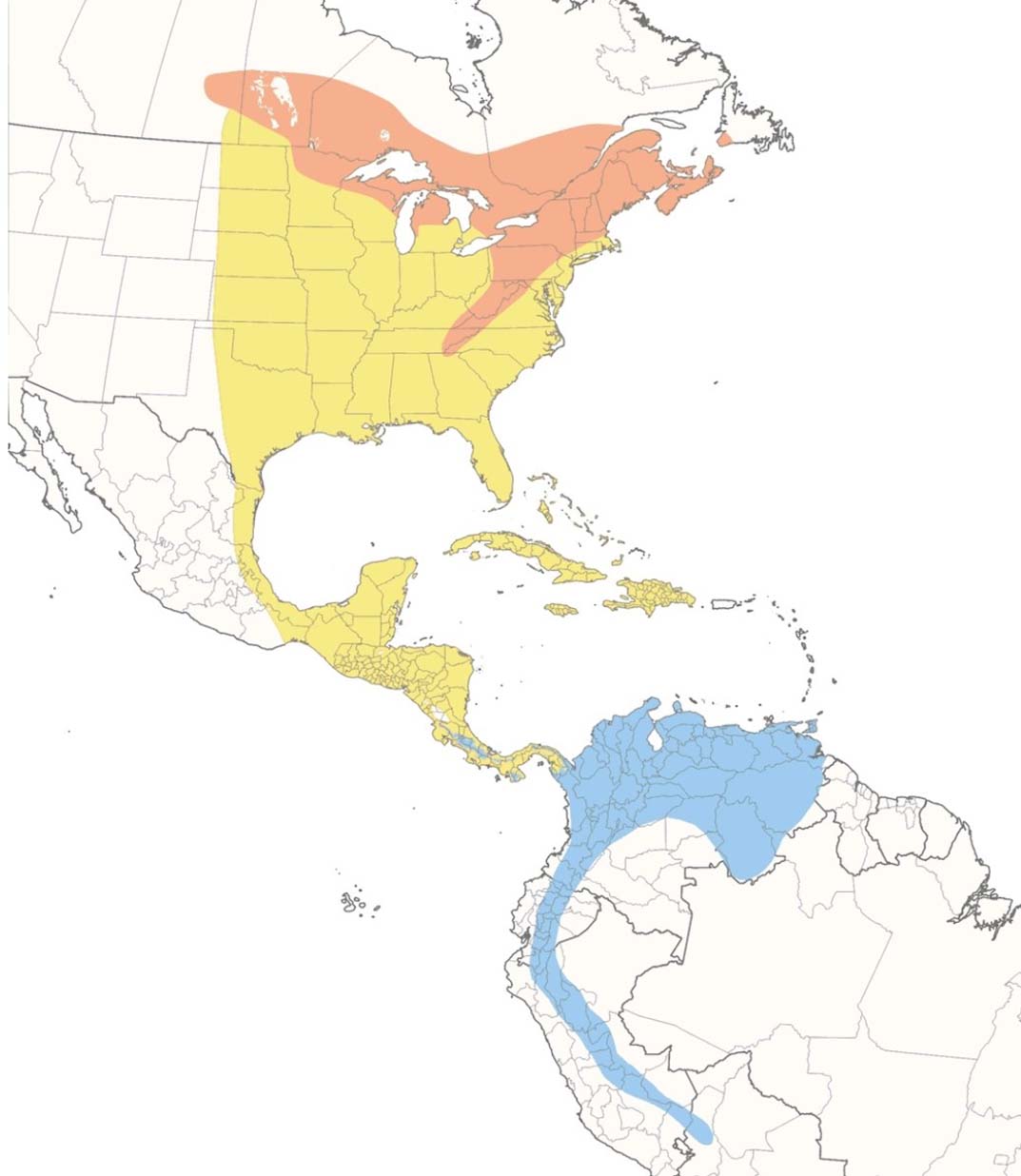
Sources:
- Blackburnian warbler. Audubon. (2021, October 20). Retrieved December 15, 2021, from https://www.audubon.org/field-guide/bird/blackburnian-warbler
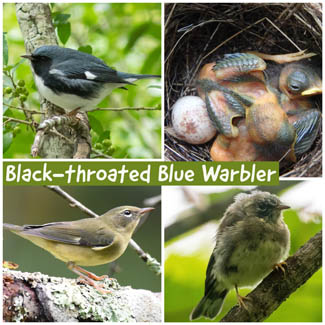
- Grid (counterclockwise):
- Male: Jim Ferrari / Macaulay Library at the Cornell Lab of Ornithology (ML379768671)
- Female: Karen Avants / Macaulay Library at the Cornell Lab of Ornithology (ML375369351)
- Juvenile: Yannick Fleury / Macaulay Library at the Cornell Lab of Ornithology (ML354140381)
- Nest/Eggs: Ryne Rutherford / Macaulay Library at the Cornell Lab of Ornithology (ML110206281)
- Range map provided by Birds of the World
Click here to lean more about Black-throated Blue Warbler
Black-throated Blue Warbler
Setophaga caerulescens
The lazy, buzzy song of the Black-throated Blue Warbler comes from the undergrowth of leafy eastern woods. Although the bird usually keeps to the shady understory, it is not especially shy; a birder who walks quietly on trails inside the forest may observe it closely. It moves about rather actively in its search for insects, but often will forage in the same immediate area for minutes at a time, rather than moving quickly through the forest like some warblers.
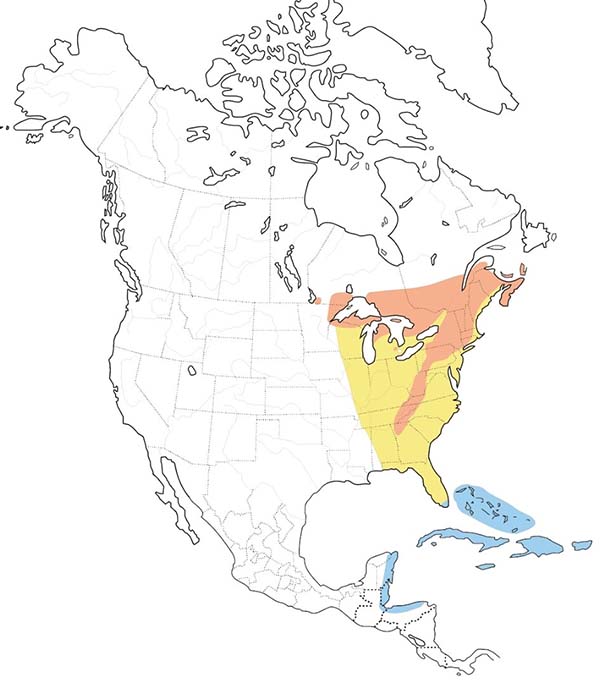
Sources:
- Black-throated blue warbler. Audubon. (2021, October 20). Retrieved December 15, 2021, from https://www.audubon.org/field-guide/bird/black-throated-blue-warbler

- Grid (counterclockwise):
- Male: Ron Batie / Macaulay Library at the Cornell Lab of Ornithology (ML265183821)
- Female: Bill Wood / Macaulay Library at the Cornell Lab of Ornithology (ML269788601)
- Juvenile: Linda Lee / Macaulay Library at the Cornell Lab of Ornithology (ML255756991)
- Nest/Eggs: Ken Clark / Macaulay Library at the Cornell Lab of Ornithology (ML257833031)
- Range map provided by Birds of the World
Click here to lean more about Blue Grosbeak
Blue Grosbeak
Passerina caerulea
The husky warbling song of the Blue Grosbeak is a common sound in summer around thickets and hedgerows in the southern states. Often the bird hides in those thickets; sometimes it perches up in the open, looking like an overgrown Indigo Bunting, flicking, and spreading its tail in a nervous action. During migration, and in winter in the tropics, Blue Grosbeaks may gather in flocks to feed in open weedy fields.
Any sighting of a blue grosbeak is a cause for celebration, because these beautiful birds just are not that common, and they can be difficult to attract. Although their nesting range covers most of the lower half of the country, spotting one is a rare treat. Look for them in the brush along roadsides and old fields.
These blue birds are sometimes mistaken for Indigo Buntings, another blue Neotropical migrant that arrives at feeders in spring. Warm brown wing bars and a huge bill set blue grosbeaks apart. The female Blue Grosbeak is not blue, but rather a tawny brown!
During the breeding season, they are not backyard birds—unless the backyard includes acres of the shrub-dotted field habitat this species seeks. Nesting season lasts all summer because they often raise two broods. The small nest, often utilizing snakeskins, is built just a few feet off the ground in a bush, briar patch, or tangle of vines. Up to five nestlings may cozy up in the little cup.
Any sighting of a blue grosbeak is a cause for celebration, because these beautiful birds just are not that common, and they can be difficult to attract. Although their nesting range covers most of the lower half of the country, spotting one is a rare treat. Look for them in the brush along roadsides and old fields.
These blue birds are sometimes mistaken for Indigo Buntings, another blue Neotropical migrant that arrives at feeders in spring. Warm brown wing bars and a huge bill set blue grosbeaks apart. The female Blue Grosbeak is not blue, but rather a tawny brown!
During the breeding season, they are not backyard birds—unless the backyard includes acres of the shrub-dotted field habitat this species seeks. Nesting season lasts all summer because they often raise two broods. The small nest, often utilizing snakeskins, is built just a few feet off the ground in a bush, briar patch, or tangle of vines. Up to five nestlings may cozy up in the little cup.
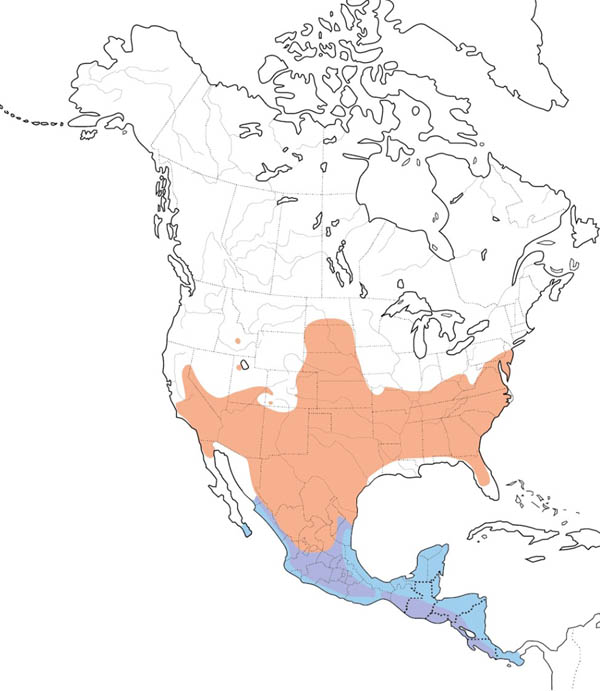
Sources:
- Blue Grosbeak. (2020, April 16). Audubon. https://www.audubon.org/field-guide/bird/blue-grosbeak
- Roth, S. (2021, March 12). Get to Know Blue Grosbeaks. Retrieved May 03, 2021, from https://www.birdsandblooms.com/birding/bird-species/get-to-know-blue-grosbeaks-and-how-to-attract-them/

- Grid (counterclockwise):
- Male: Anthony Watson / Macaulay Library at the Cornell Lab of Ornithology (ML107834731)
- Female: Nehemiah laudermilch / Macaulay Library at the Cornell Lab of Ornithology (ML178041371)
- Juvenile: Shelley Rutkin / Macaulay Library at the Cornell Lab of Ornithology (ML256605661)
- Nest/Eggs: West Tennessee Historical Data / Macaulay Library at the Cornell Lab of Ornithology (ML89957741)
- Range map provided by Birds of the World
Click here to lean more about Blue Jay
Blue Jay
Cyanocitta cristata
The brash and beautiful Blue Jay is seldom regarded with indifference. Some think it is an aggressive bully, while others love its boisterous, sociable nature. A member of the Corvid family, related to the Common Raven and American Crow, the Blue Jay is intelligent and adaptable — qualities that have helped it learn to successfully co-exist with people.
Although not as talented a mimic as Northern Mockingbird or Gray Catbird, a Blue Jay can produce a convincing imitation of Red-shouldered Hawk and Red-tailed Hawk, confusing many a birdwatcher. Blue Jays are known to imitate a variety of other bird species, including the Bald Eagle and Eastern Screech-Owl. This noisy bird also utters a wide variety of squeaks, rattles, and croaks.
Although Blue Jays appear to be brilliantly blue, their feathers are a dull brown. Like the Eastern Bluebird and the Indigo Bunting, their feathers have modified prismatic cells that scatter light waves, reflecting the blue spectrum waves to the viewer.
The Blue Jay is common in much of eastern and central North America, and this adaptable species continues to extend its range to the Northwest. These birds are often quite flashy and vocal in their forest edge and backyard habitats! If you would like to attract more Blue Jays to your backyard, try adding some peanuts to your feeders. According to Cornell's website, they also prefer platform or tray feeders to hanging feeders. They are certainly beautiful birds and often entertaining to watch.
Although not as talented a mimic as Northern Mockingbird or Gray Catbird, a Blue Jay can produce a convincing imitation of Red-shouldered Hawk and Red-tailed Hawk, confusing many a birdwatcher. Blue Jays are known to imitate a variety of other bird species, including the Bald Eagle and Eastern Screech-Owl. This noisy bird also utters a wide variety of squeaks, rattles, and croaks.
Although Blue Jays appear to be brilliantly blue, their feathers are a dull brown. Like the Eastern Bluebird and the Indigo Bunting, their feathers have modified prismatic cells that scatter light waves, reflecting the blue spectrum waves to the viewer.
The Blue Jay is common in much of eastern and central North America, and this adaptable species continues to extend its range to the Northwest. These birds are often quite flashy and vocal in their forest edge and backyard habitats! If you would like to attract more Blue Jays to your backyard, try adding some peanuts to your feeders. According to Cornell's website, they also prefer platform or tray feeders to hanging feeders. They are certainly beautiful birds and often entertaining to watch.

Sources:
- American Bird Conservancy. (2020e, July 20). American Kestrel. https://abcbirds.org/bird/american-kestrel/
- Maryland birds: American Kestrel. (n.d.). Retrieved May 10, 2021, from https://dnr.maryland.gov/wildlife/Pages/plants_wildlife/American_Kestrel.aspx
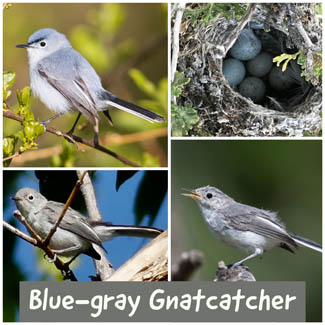
- Grid (counterclockwise):
- Male: Michael Stubblefield / Macaulay Library at the Cornell Lab of Ornithology (ML276869391)
- Female: Jonathan Strandjord / Macaulay Library at the Cornell Lab of Ornithology (ML254129111)
- Juvenile: Suzanne Labbé / Macaulay Library at the Cornell Lab of Ornithology (ML259936881)
- Nest/Eggs: Jane Thompson / Macaulay Library at the Cornell Lab of Ornithology (ML102318631)
- Range map provided by Birds of the World
Click here to lean more about Blue-gray Gnatcatcher
Blue-gray Gnatcatcher
Polioptila caerulea
Blue-gray Gnatcatcher breeds across much of the eastern US and in the southern part of the western US and spends the winter primarily in Florida or Mexico. These are some of the first songbirds that we see migrating in the spring, and we can hear their wheezy song at the beginning of April when there are still plenty of cold, frosty nights.
A very small woodland bird with a long tail, usually seen flitting about in the treetops, giving a short whining call note. Often it darts out in a short, quick flight to snap up a tiny insect in mid-air. Widespread in summer, its breeding range is still expanding toward the north.
A very small woodland bird with a long tail, usually seen flitting about in the treetops, giving a short whining call note. Often it darts out in a short, quick flight to snap up a tiny insect in mid-air. Widespread in summer, its breeding range is still expanding toward the north.

Sources:
- Blue-gray Gnatcatcher. (2019, November 5). Audubon. https://www.audubon.org/field-guide/bird/blue-gray-gnatcatcher
- Powdermill Nature Reserve, Carnegie Museum of Natural History
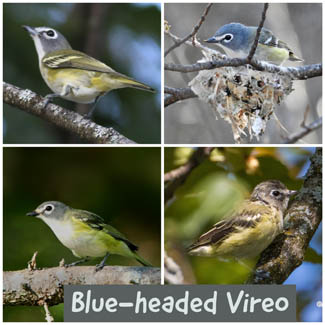
- Grid (counterclockwise):
- Male: Margaret Viens / Macaulay Library at the Cornell Lab of Ornithology (ML178234611)
- Female: Cliff Sanderson / Macaulay Library at the Cornell Lab of Ornithology (ML62327201)
- Juvenile: Michel Laquerre / Macaulay Library at the Cornell Lab of Ornithology (ML264522541)
- Nest/Eggs: Joe Coppock / Macaulay Library at the Cornell Lab of Ornithology (ML97167141)
- Range map provided by Birds of the World
Click here to lean more about Blue-headed Vireo
Blue-headed Vireo
Vireo solitarius
This vireo is common in summer in mixed forests, where conifers and deciduous trees grow together. When feeding, it works rather deliberately along branches, searching for insects. Its nest, a bulky cup suspended in the fork of a twig, is often easy to find.
The Blue-headed Vireo is recognized by the white "spectacles" around their eyes and their blue-grey head feathers. Blue-headed vireos are summer breeders throughout most of Pennsylvania and overwinter in the far southern U.S., Mexico, and Central America.
The Blue-headed Vireo is recognized by the white "spectacles" around their eyes and their blue-grey head feathers. Blue-headed vireos are summer breeders throughout most of Pennsylvania and overwinter in the far southern U.S., Mexico, and Central America.
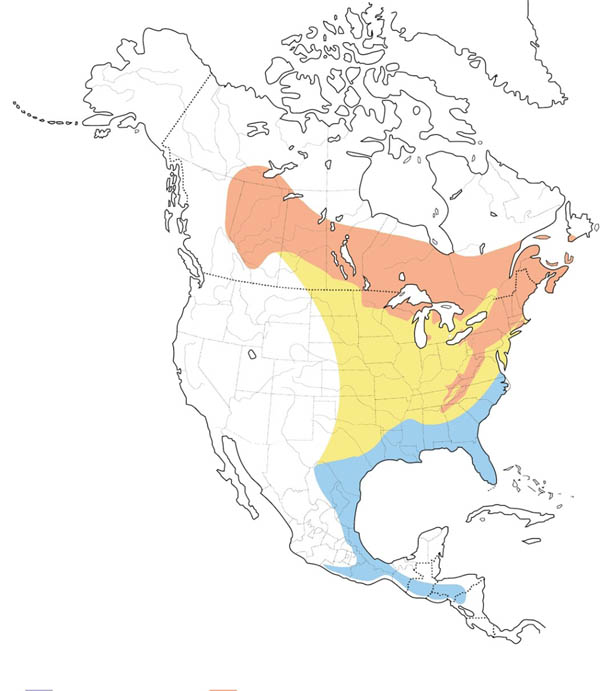
Sources:
- Blue-headed Vireo. (2019, November 5). Audubon. https://www.audubon.org/field-guide/bird/blue-headed-vireo
- Powdermill Nature Reserve, Carnegie Museum of Natural History
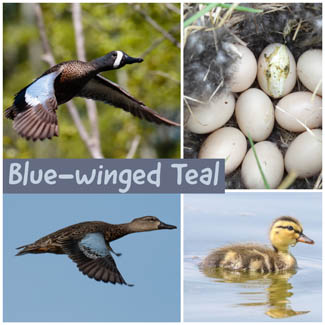
- Grid (counterclockwise):
- Male: Connor Bowhay / Macaulay Library at the Cornell Lab of Ornithology (ML378713031)
- Female: Richard Rulander / Macaulay Library at the Cornell Lab of Ornithology (ML380490021)
- Juvenile: Ethan Denton / Macaulay Library at the Cornell Lab of Ornithology (ML354511811)
- Nest/Eggs: Réjean Deschênes / Macaulay Library at the Cornell Lab of Ornithology (ML346315521)
- Range map provided by Birds of the World
Click here to lean more about Blue-winged Teal
Blue-winged Teal
Spatula discors
Teal are small ducks, fast in flight, flocks twisting and turning in unison. Seemingly a warm-weather duck, the Blue-winged Teal is largely absent from most of North America in the cold months, and winters more extensively in South America than any of our other dabblers. Small groups of Blue-wings often are seen standing on stumps or rocks at the water's edge.
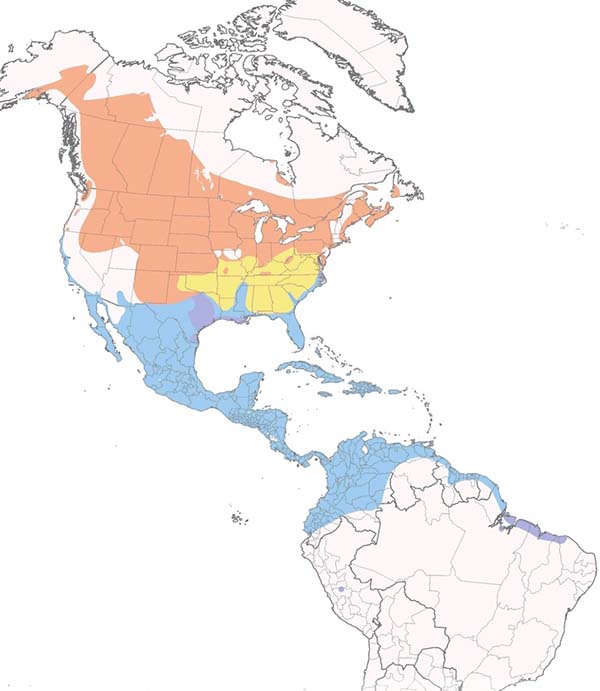
Sources:
- Blue-winged teal. Audubon. (2021, October 20). Retrieved December 15, 2021, from https://www.audubon.org/field-guide/bird/blue-winged-teal
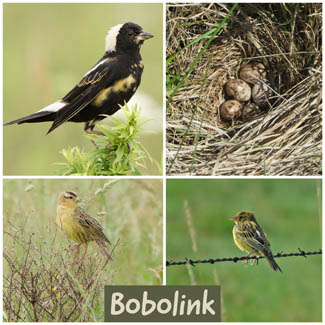
- Grid (counterclockwise):
- Male: Benjamin Hack / Macaulay Library at the Cornell Lab of Ornithology (ML250974511)
- Female: Jon Cefus / Macaulay Library at the Cornell Lab of Ornithology (ML249541581)
- Juvenile: Thomas Schultz / Macaulay Library at the Cornell Lab of Ornithology (ML172778441)
- Nest/Eggs: Ise Varghese / Macaulay Library at the Cornell Lab of Ornithology (ML74942851)
- Range map provided by Birds of the World
Click here to lean more about Bobolink
Bobolink
Dolichonyx oryzivorus
One aspect of the male Bobolinks is that they have all their faces, chest, belly, wings, and tail colored in black while the shoulders, the lower back, and the rump are somewhere between white and pale gray – whereas the female Bobolinks have underparts colored in yellow and black only in the stripe behind eyes and a little bit on top of their heads.
The bubbling song of the Bobolink ushers in spring across grasslands of the northern United States and southern Canada. Unlike less conspicuous grassland breeders such as the Eastern Meadowlark or Grasshopper Sparrow, the male Bobolink, with his flashy black-and-white breeding plumage, seems to be wearing a "backward tuxedo." No other North American songbird is black underneath and white on the back.
The Bobolink's species name oryzivorus means "rice-eating" and refers to this bird's penchant for grains, particularly during migration and on wintering grounds. When on the move, Bobolink flocks can eat large quantities of grains, and the birds are often shot as agricultural pests, particularly on their wintering grounds. Bobolinks are known as "butter birds" in Jamaica, where the plumped-up migrants are sometimes harvested for food as they pass through that country.
The bubbling song of the Bobolink ushers in spring across grasslands of the northern United States and southern Canada. Unlike less conspicuous grassland breeders such as the Eastern Meadowlark or Grasshopper Sparrow, the male Bobolink, with his flashy black-and-white breeding plumage, seems to be wearing a "backward tuxedo." No other North American songbird is black underneath and white on the back.
The Bobolink's species name oryzivorus means "rice-eating" and refers to this bird's penchant for grains, particularly during migration and on wintering grounds. When on the move, Bobolink flocks can eat large quantities of grains, and the birds are often shot as agricultural pests, particularly on their wintering grounds. Bobolinks are known as "butter birds" in Jamaica, where the plumped-up migrants are sometimes harvested for food as they pass through that country.
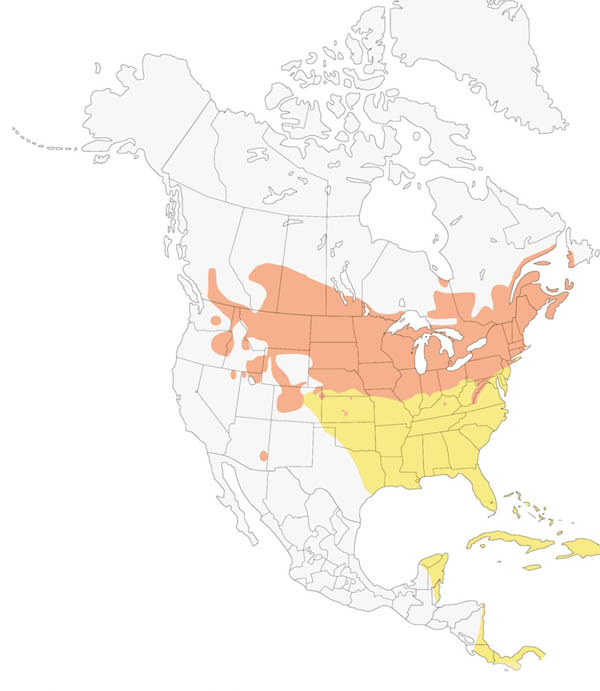
Sources:
- American Bird Conservancy. (2020b, September 18). Bobolink. https://abcbirds.org/bird/bobolink/
- Harp, V. (2015, February 28). Bobolink. Retrieved May 03, 2021, from https://www.birdsgallery.net/bobolink/

- Grid (counterclockwise):
- Male: sam hough / Macaulay Library at the Cornell Lab of Ornithology (ML176079861)
- Female: Susan Disher / Macaulay Library at the Cornell Lab of Ornithology (ML326332441)
- Juvenile: Byron Stone / Macaulay Library at the Cornell Lab of Ornithology (ML378093461)
- Nest/Eggs: Nathan DeBruine / Macaulay Library at the Cornell Lab of Ornithology (ML129115831)
- Range map provided by Birds of the World
Click here to lean more about Broad-winged Hawk
Broad-winged Hawk
Buteo platypterus
A small hawk, common in eastern woodlands in summer. Staying around the edges of the forest, Broad-wings are not very noticeable during the breeding season, but they form spectacular concentrations when they migrate. Almost all individuals leave North America in fall, in a mass exodus to Central and South America, and sometimes thousands can be seen along ridges, coastlines, or lake shores when the wind conditions are right.
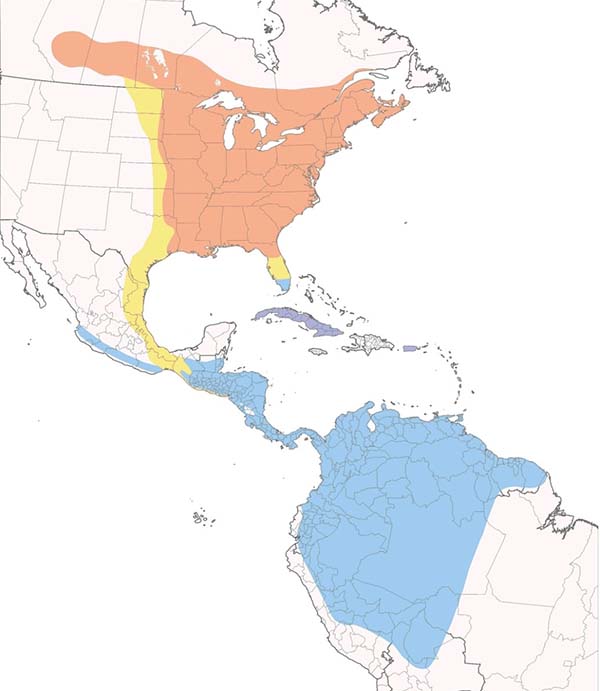
Sources:
- Broad-Winged Hawk. Audubon. (2021, October 20). Retrieved December 15, 2021, from https://www.audubon.org/field-guide/bird/broad-winged-hawk
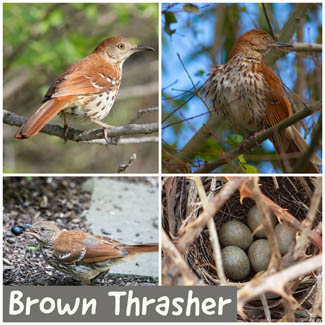
- Grid (counterclockwise):
- Male: Jay Gilliam / Macaulay Library at the Cornell Lab of Ornithology (ML227279631)
- Female: Elizabeth Leeor / Macaulay Library at the Cornell Lab of Ornithology (ML54933231)
- Juvenile: Sue Barth / Macaulay Library at the Cornell Lab of Ornithology (ML252661091)
- Nest/Eggs: Becky Lutz / Macaulay Library at the Cornell Lab of Ornithology (ML46660261)
- Range map provided by Birds of the World
Click here to lean more about Brown Thrasher
Brown Thrasher
Toxostoma rufum
The big, foxy-red Brown Thrasher is a familiar bird over much of the east. Sometimes it forages boldly on open lawns; more often it scoots into dense cover at any disturbance, hiding among the briar tangles and making loud crackling call notes. Although the species spends most of its time close to the ground, the male Brown Thrasher sometimes will deliver its rich, melodious song of doubled phrases from the top of a tall tree.
Eye color can be used to assist in aging some birds, like the Brown Thrasher. Although a paler, creamy gray eye was quite lovely, the adult eye is a bright yellow, often rimmed with an orange-red.
Eye color can be used to assist in aging some birds, like the Brown Thrasher. Although a paler, creamy gray eye was quite lovely, the adult eye is a bright yellow, often rimmed with an orange-red.

Sources:
- Brown Thrasher. (2019, November 18). Audubon. https://www.audubon.org/field-guide/bird/brown-thrasher
- Powdermill Nature Reserve, Carnegie Museum of Natural History
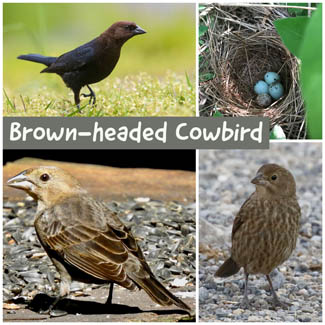
- Grid (counterclockwise):
- Male: Michael Stubblefield / Macaulay Library at the Cornell Lab of Ornithology (ML277717561)
- Female: Van Remsen / Macaulay Library at the Cornell Lab of Ornithology (ML276199231)
- Juvenile: Douglas Faulder / Macaulay Library at the Cornell Lab of Ornithology (ML261298741)
- Nest/Eggs: Jennifer Wenzel / Macaulay Library at the Cornell Lab of Ornithology (ML29044361)
- Range map provided by Birds of the World
Click here to lean more about Brown-headed Cowbird
Brown-headed Cowbird
Molothrus ater
Centuries ago, this bird probably followed bison herds on the Great Plains, feeding on insects flushed from the grass by the grazers. Today it follows cattle and occurs abundantly from coast to coast. The Brown-headed cowbird is a sturdy blackbird with an unusual approach to parenthood. Females do not build nests but use all their energy for producing eggs, sometimes over three dozen per summer. They lay their eggs in other birds' nests, who become their chicks' foster parents, with usually at least some of their foster parents' chicks being victims in the process. Heavy parasitism by this species has pushed some birds to be "endangered" and has affected other populations as well, especially other songbirds.
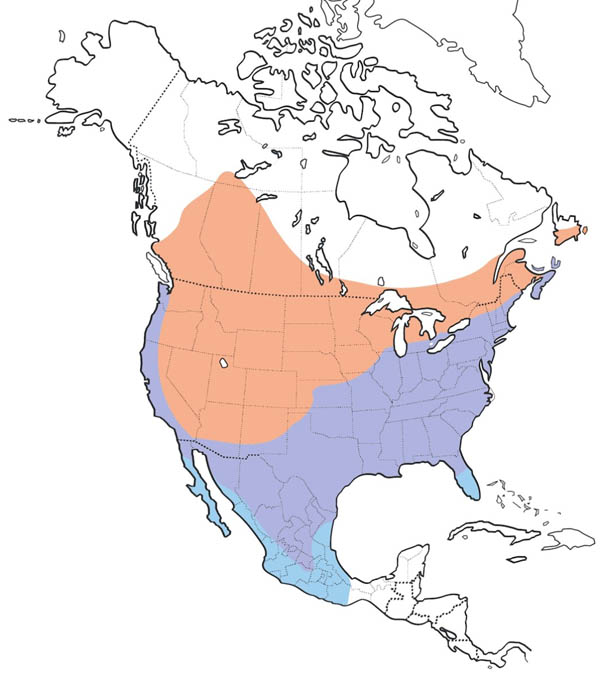
Sources:
- Brown-headed Cowbird. (2020). Retrieved May 03, 2021, from https://animalia.bio/brown-headed-cowbird
- Brown-headed Cowbird. (2020, February 4). Audubon. https://www.audubon.org/field-guide/bird/brown-headed-cowbird
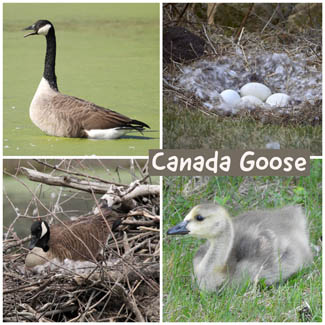
- Grid (counterclockwise):
- Male: Clayton Fitzgerald / Macaulay Library at the Cornell Lab of Ornithology (ML376488361)
- Female: Jeffrey McCrary / Macaulay Library at the Cornell Lab of Ornithology (ML357031051)
- Juvenile: Matthew Dudziak / Macaulay Library at the Cornell Lab of Ornithology (ML365705711)
- Nest/Eggs: Richard André Rivard / Macaulay Library at the Cornell Lab of Ornithology (ML323815401)
- Range map provided by Birds of the World
Click here to lean more about Canada Goose
Canada Goose
Branta canadensis
This big 'Honker' is among our best-known waterfowl. In many regions, flights of Canada Geese passing over in V-formation -- northbound in spring, southbound in fall -- are universally recognized as signs of the changing seasons. Once considered a symbol of wilderness, this goose has adapted well to civilization, nesting around park ponds and golf courses; in a few places, it has even become something of a nuisance. Local forms vary greatly in size, and the smallest ones are now regarded as a separate species, Cackling Goose.
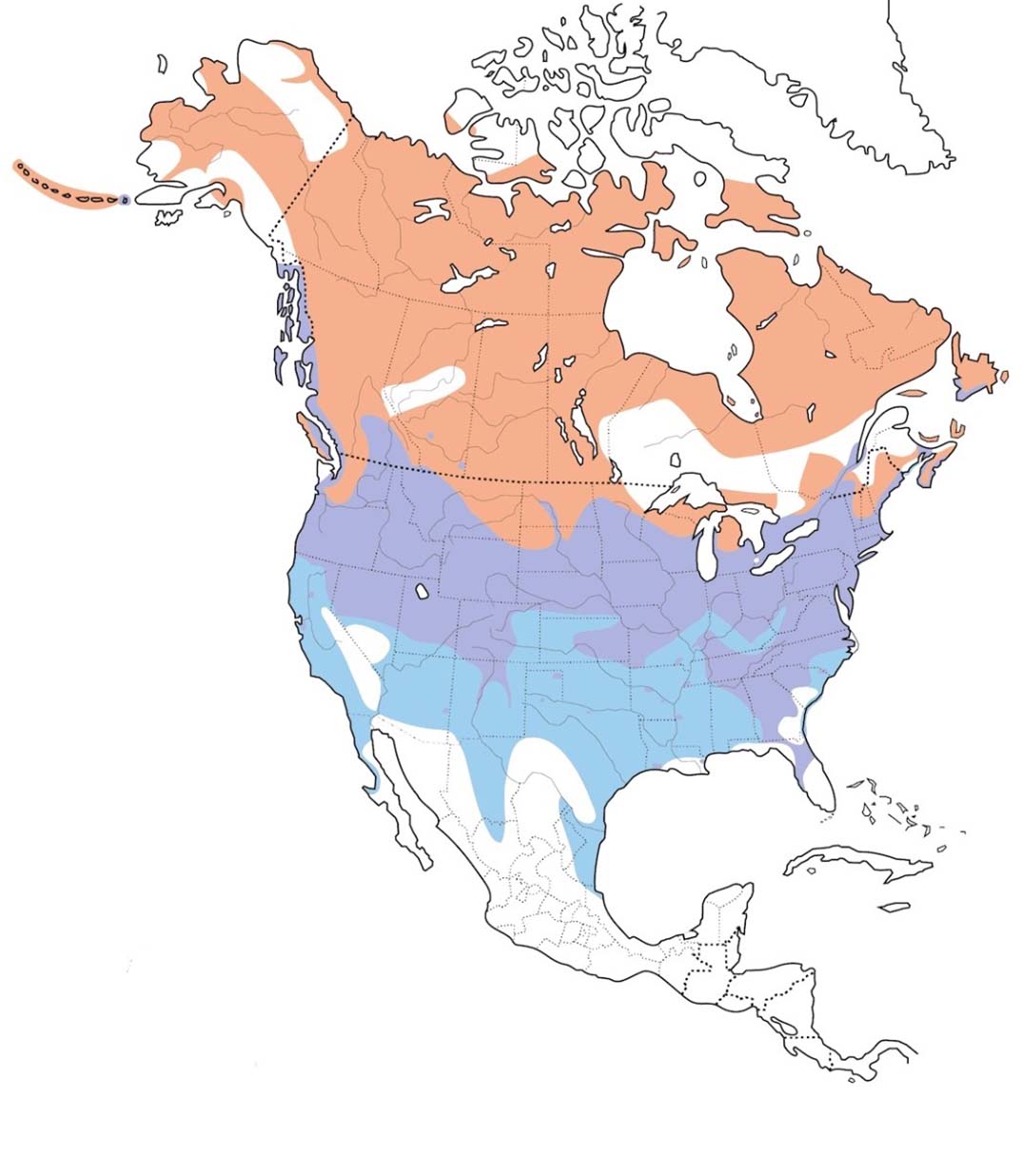
Sources:
- Canada goose. Audubon. (2021, October 20). Retrieved December 15, 2021, from https://www.audubon.org/field-guide/bird/canada-goose
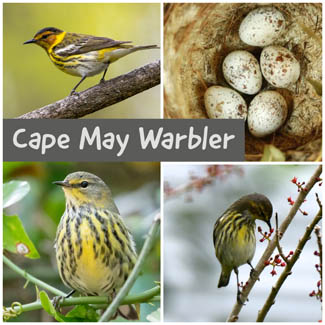
- Grid (counterclockwise):
- Male: Michael Stubblefield / Macaulay Library at the Cornell Lab of Ornithology (ML276870461)
- Female: Bill Wood / Macaulay Library at the Cornell Lab of Ornithology (ML271385231)
- Juvenile: Gillian Kirkwood / Macaulay Library at the Cornell Lab of Ornithology (ML212413851)
- Nest/Eggs: James Zipp / www.pixels.com
- Range map provided by Birds of the World
Click here to lean more about Cape May Warbler
Cape May Warbler
Setophaga tigrine
One of those many birds with a puzzling common name, Cape May Warbler does not spend much time in its namesake locale. Instead, Cape May, New Jersey is the place where famed ornithologist Alexander Wilson first described this eye-catching species. As with some other species, the place where the bird was first recorded made for an inaccurate name.
Cape May Warbler is a common migrant that passes through New Jersey en route to its breeding or wintering grounds. Its Latin name, tigrina, is a far more accurate way to describe it, especially the vividly tiger-striped male. Females and juveniles are also striped but in more subdued colors.
We only get to see Cape May Warblers in this area twice each year, during migration - they breed far to the north in Canada's boreal forest and winter mostly on Caribbean islands. It is always a treat to see these birds moving through the trees in a mixed flock of migrating warblers!
Cape May Warbler is a common migrant that passes through New Jersey en route to its breeding or wintering grounds. Its Latin name, tigrina, is a far more accurate way to describe it, especially the vividly tiger-striped male. Females and juveniles are also striped but in more subdued colors.
We only get to see Cape May Warblers in this area twice each year, during migration - they breed far to the north in Canada's boreal forest and winter mostly on Caribbean islands. It is always a treat to see these birds moving through the trees in a mixed flock of migrating warblers!
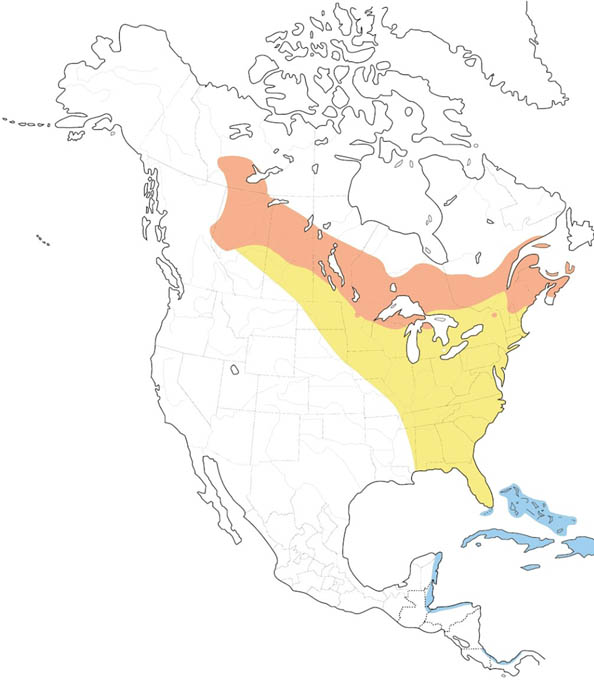
Sources:
- American Bird Conservancy. (2020b, June 25). Boreal Breeder: Cape May Warbler. https://abcbirds.org/bird/cape-may-warbler/
- Powdermill Nature Reserve, Carnegie Museum of Natural History

- Grid (counterclockwise):
- Male: Billy Arimes / Macaulay Library at the Cornell Lab of Ornithology (ML150626991)
- Female: James Nelson / Macaulay Library at the Cornell Lab of Ornithology (ML278496151)
- Juvenile: Michael O'Brien / Macaulay Library at the Cornell Lab of Ornithology (ML236788571)
- Nest/Eggs: caleb bronsink / Macaulay Library at the Cornell Lab of Ornithology (ML94415141)
- Range map provided by Birds of the World
Click here to lean more about Carolina Chickadee
Carolina Chickadee
Poecile carolinensis
Very similar to the Black-capped Chickadee, this bird replaces it in the southeastern states. Living in milder climates, it has been reported to be less of a visitor to bird feeders, but it does come into suburban yards for sunflower seeds. Where the ranges of Black-capped and Carolina chickadees come together, they often interbreed. In these contact zones, they also can learn to imitate each other's songs -- causing great confusion for birdwatchers. We are located nearly on a jagged line that extends across much of the eastern half of the US where these two species both occur and often hybridize.
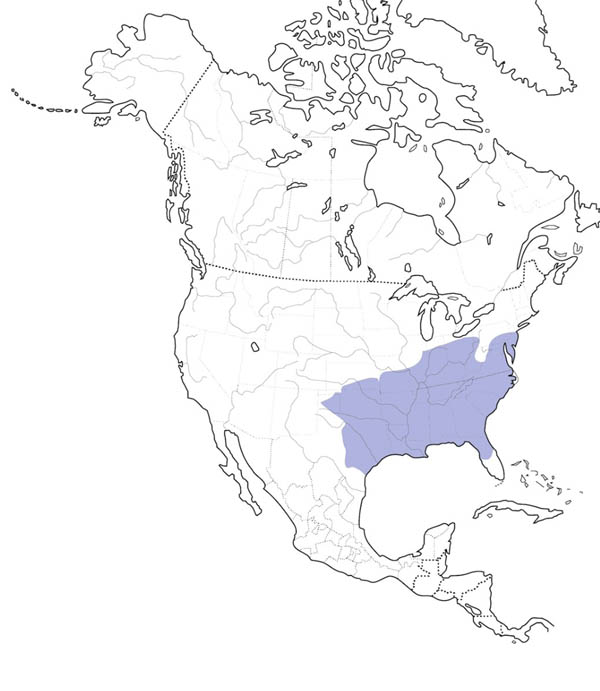
Sources:
- Carolina Chickadee. (2019, November 20). Audubon. https://www.audubon.org/field-guide/bird/carolina-chickadee
- Powdermill Nature Reserve, Carnegie Museum of Natural History
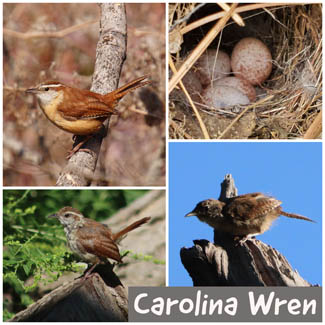
- Grid (counterclockwise):
- Male: Ashlea Veldhoen / Macaulay Library at the Cornell Lab of Ornithology (ML226589121)
- Female: Gerald Fix / Macaulay Library at the Cornell Lab of Ornithology (ML260277621)
- Juvenile: valerie heemstra / Macaulay Library at the Cornell Lab of Ornithology (ML257652521)
- Nest/Eggs: Trevor Palmer / Macaulay Library at the Cornell Lab of Ornithology (ML219132971)
- Range map provided by Birds of the World
Click here to lean more about Carolina Wren
Carolina Wren
Thryothorus ludovicianus
Carolina Wrens are in the area year-round. We often see them visiting the feeders or flitting about in the shrubby areas. They sing their boisterous "teakettle-teakettle-teakettle" song. The Carolina Wren is a familiar backyard bird, like the Northern Cardinal and Downy Woodpecker, although it is more often heard than seen. For those interested in learning how to identify birds by voice, the Carolina Wren provides interesting lessons. Here is one: Although only males sing, the females provide backup. Male Carolina Wrens belt out a loud "tea-kettle tea-kettle tea-kettle" or "cheery-cheery-cheery" and females provide backup with an enthusiastic, drawn-out trill accompanying the song's end.
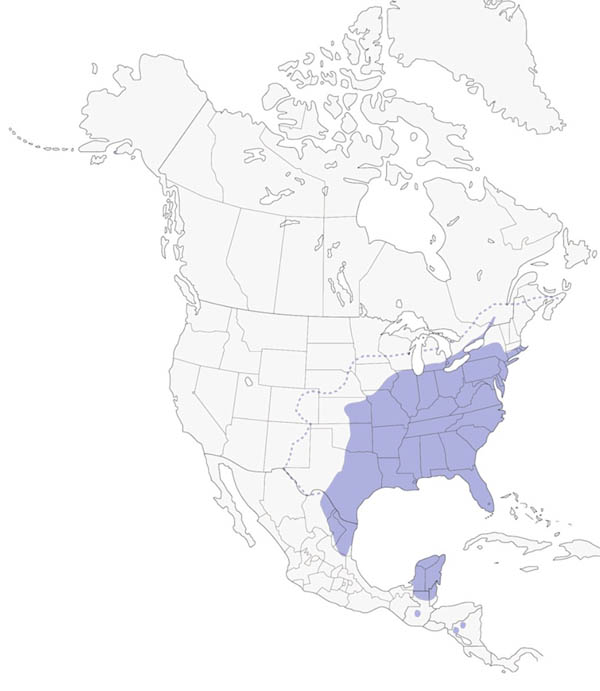
Sources:
- American Bird Conservancy. (2020a, June 24). Carolina Wren. https://abcbirds.org/bird/carolina-wren/
- Powdermill Nature Reserve, Carnegie Museum of Natural History
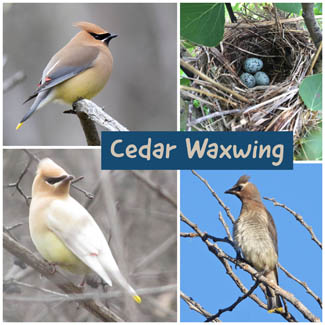
- Grid (counterclockwise):
- Male: Kristof Zyskowski / Macaulay Library at the Cornell Lab of Ornithology (ML161920271)
- Female: Laurent Bédard / Macaulay Library at the Cornell Lab of Ornithology (ML225911381)
- Juvenile: Pair of Wing-Nuts / Macaulay Library at the Cornell Lab of Ornithology (ML270849921)
- Nest/Eggs: Christopher Coxson / Macaulay Library at the Cornell Lab of Ornithology (ML61810201)
- Range map provided by Birds of the World
Click here to lean more about Cedar Waxwing
Cedar Waxwing
Bombycilla cedrorum
The Cedar Waxwing's genus name, Bombycilla, means "silk-tail" and refers to its dapper-looking plumage. The species name, cedrorum, is Latin for "of the cedars" and reflects its fondness for the small cones of the eastern red cedar.
One of this bird's most distinctive features is the bright-red, waxy tips on its secondary wing feathers, the result of its fruit-heavy diet, although immature birds usually show no red waxy tips. The "wax" tipping the Cedar Waxwing's secondary wing feathers is an accumulation of the organic pigment astaxanthin, a carotenoid that gives red fruits their color. The tips increase in number and size with an individual's age, and immature birds may show no red wingtips at all. Some scientists speculate that waxwings evolved these waxy tips to signal important information — such as age and social status — to other birds within the flock. The waxwing's striking yellow tail tip is also the result of the carotenoids that color the fruit this species loves to eat. In recent years, waxwings eating the fruits of introduced honeysuckle have grown orange-tailed tips instead!
Did you know that you can find Cedar Waxwings in this area all year? They are almost certainly different individuals than those we see in the summer, but they will form small flocks and roam around finding berries to eat all winter. By the late part of winter, some of those berries may have fermented a bit and Cedar Waxwings may get a little tipsy from eating them!
One of this bird's most distinctive features is the bright-red, waxy tips on its secondary wing feathers, the result of its fruit-heavy diet, although immature birds usually show no red waxy tips. The "wax" tipping the Cedar Waxwing's secondary wing feathers is an accumulation of the organic pigment astaxanthin, a carotenoid that gives red fruits their color. The tips increase in number and size with an individual's age, and immature birds may show no red wingtips at all. Some scientists speculate that waxwings evolved these waxy tips to signal important information — such as age and social status — to other birds within the flock. The waxwing's striking yellow tail tip is also the result of the carotenoids that color the fruit this species loves to eat. In recent years, waxwings eating the fruits of introduced honeysuckle have grown orange-tailed tips instead!
Did you know that you can find Cedar Waxwings in this area all year? They are almost certainly different individuals than those we see in the summer, but they will form small flocks and roam around finding berries to eat all winter. By the late part of winter, some of those berries may have fermented a bit and Cedar Waxwings may get a little tipsy from eating them!
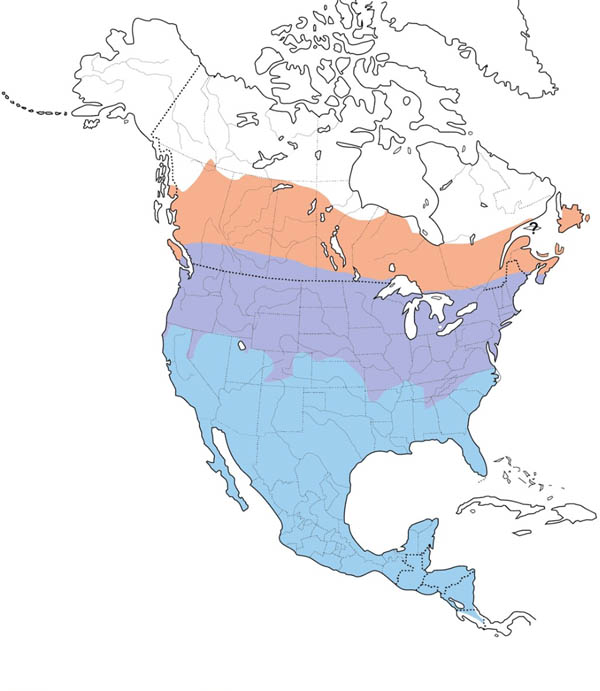
Sources:
- American Bird Conservancy. (2019, January 17). Sociable Fruit-Feeder: Cedar Waxwing. https://abcbirds.org/bird/cedar-waxwing/
- Powdermill Nature Reserve, Carnegie Museum of Natural History
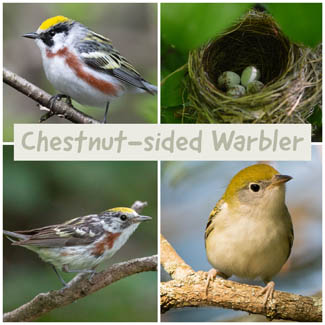
- Grid (counterclockwise):
- Male: Jim Hully / Macaulay Library at the Cornell Lab of Ornithology (ML272585391)
- Female: Yannick Fleury / Macaulay Library at the Cornell Lab of Ornithology (ML253146991)
- Juvenile: Steve Kelling / Macaulay Library at the Cornell Lab of Ornithology (ML181073391)
- Nest/Eggs: Alyssa DeRubeis / Macaulay Library at the Cornell Lab of Ornithology (ML252274711)
- Range map provided by Birds of the World
Click here to lean more about Chestnut-sided Warbler
Chestnut-sided Warbler
Setophaga pensylvanica
Chestnut-sided Warbler was not well known before the 1800s; prominent ornithologists such as Audubon and Wilson seldom saw the bird and knew little about it. Like the Golden-winged Warbler, this bird nests in semi-open, brushy areas, so could only be found where forest fires and other natural phenomena had created this habitat.
The male Chestnut-sided Warbler sings two song types; one is accented at the end, the other is not. The first is used before the arrival of the females and in the early nesting cycle. The second is used mostly in territory defense while the birds are raising young.
Males that only sing one song type appear to be less successful at attracting mates than males that sing both songs. The early-season song has a musical quality with an emphatic ending, sometimes interpreted as "very very pleased to meet cha!"
The Chestnut-sided Warbler is a common breeder in the woods of Pennsylvania. With a quick look at a Chestnut-sided Warbler, it is easy to see how it got its name - it has chestnut-colored patches on the flanks. But what about its scientific name, Setophaga pensylvania? Setophaga comes from the Greek "ses" which means "moth" and "phagos" which means "eating" - an appropriate genus name for a bird that eats a lot of butterfly and moth larvae. Pensylvanica refers to Pennsylvania, which is also appropriate as Chestnut-sided Warblers are a common breeding bird in the woods of Pennsylvania.
And how about en Español? Chestnut-sided Warblers spend the winter in Mexico and Central America and are known in Spanish as Reinita de Pensilvania which roughly translates to "little queen of Pennsylvania."
The male Chestnut-sided Warbler sings two song types; one is accented at the end, the other is not. The first is used before the arrival of the females and in the early nesting cycle. The second is used mostly in territory defense while the birds are raising young.
Males that only sing one song type appear to be less successful at attracting mates than males that sing both songs. The early-season song has a musical quality with an emphatic ending, sometimes interpreted as "very very pleased to meet cha!"
The Chestnut-sided Warbler is a common breeder in the woods of Pennsylvania. With a quick look at a Chestnut-sided Warbler, it is easy to see how it got its name - it has chestnut-colored patches on the flanks. But what about its scientific name, Setophaga pensylvania? Setophaga comes from the Greek "ses" which means "moth" and "phagos" which means "eating" - an appropriate genus name for a bird that eats a lot of butterfly and moth larvae. Pensylvanica refers to Pennsylvania, which is also appropriate as Chestnut-sided Warblers are a common breeding bird in the woods of Pennsylvania.
And how about en Español? Chestnut-sided Warblers spend the winter in Mexico and Central America and are known in Spanish as Reinita de Pensilvania which roughly translates to "little queen of Pennsylvania."
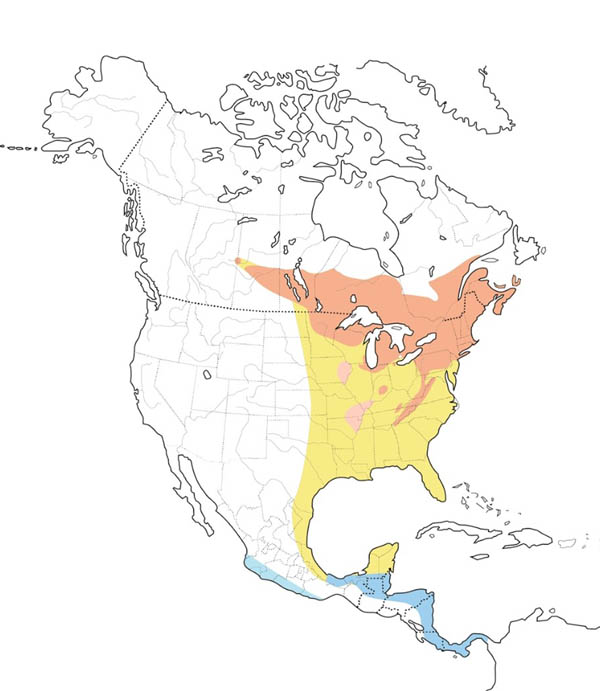
Sources:
- American Bird Conservancy. (2020c, July 20). Chestnut-sided Warbler. https://abcbirds.org/bird/chestnut-sided-warbler/
- Powdermill Nature Reserve, Carnegie Museum of Natural History
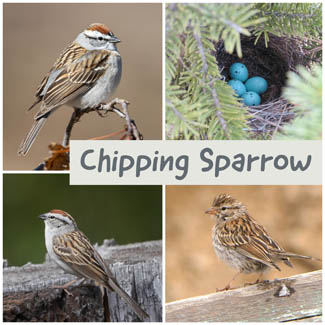
- Grid (counterclockwise):
- Male: Michael Stubblefield / Macaulay Library at the Cornell Lab of Ornithology (ML278728241)
- Female: Barry McKenzie / Macaulay Library at the Cornell Lab of Ornithology (ML158424071)
- Juvenile: Robert Hamilton / Macaulay Library at the Cornell Lab of Ornithology (ML275955421)
- Nest/Eggs: James Telford / Macaulay Library at the Cornell Lab of Ornithology (ML187112911)
- Range map provided by Birds of the World
Click here to lean more about Chipping Sparrow
Chipping Sparrow
Spizella passerine
Common over much of the continent is the little Chipping Sparrow. Originally a bird of open pine woods and edges, it has adapted well to altered landscapes. It now nests in gardens and parks in many areas, its tame behavior making it well-known and popular. It was even more common in towns in the 19th century; but then the House Sparrow, introduced from Europe, took over its place as our number one city "sparrow."
Chipping and Tree Sparrows are very similar but check out the eye stripe on both – on Chipping it is black. In southwest PA, they are generally separated by season – Chipping is a summer bird (although they have popped up during Christmas Bird Counts!).
Chipping and Tree Sparrows are very similar but check out the eye stripe on both – on Chipping it is black. In southwest PA, they are generally separated by season – Chipping is a summer bird (although they have popped up during Christmas Bird Counts!).
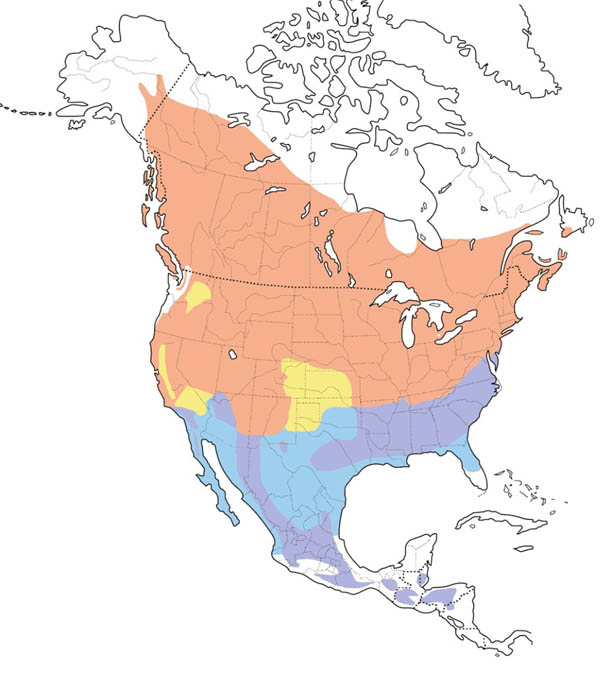
Sources:
- Chipping Sparrow. (2019, November 20). Audubon. https://www.audubon.org/field-guide/bird/chipping-sparrow
- Powdermill Nature Reserve, Carnegie Museum of Natural History
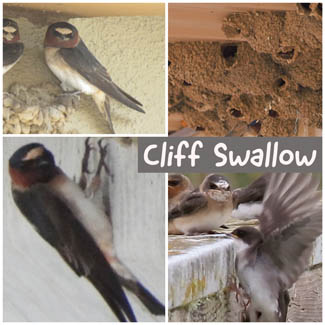
- Grid (counterclockwise):
- Male: suga moriwaki / Macaulay Library at the Cornell Lab of Ornithology (ML160680611)
- Female: Rita Czek / Macaulay Library at the Cornell Lab of Ornithology (ML28616421)
- Juvenile: Petra Clayton / Macaulay Library at the Cornell Lab of Ornithology (ML255042341)
- Nest/Eggs: Tessa Rhinehart / Macaulay Library at the Cornell Lab of Ornithology (ML59996571)
- Range map provided by Birds of the World
Click here to lean more about Cliff Swallow
Cliff Swallow
Petrochelidon pyrrhonota
This swallow is probably far more common today than when the Pilgrims landed. Originally it built its jug-shaped mud nests on the sides of cliffs. However, the sides of barns and the supports of bridges provided sheltered sites that were far more widespread than the natural ones. Taking advantage of these artificial locations, the species has invaded many areas where it never nested before. Although it is continuing to spread in the east, it is still more common in the west, where practically every culvert and highway bridge seems to have its own Cliff Swallow colony.
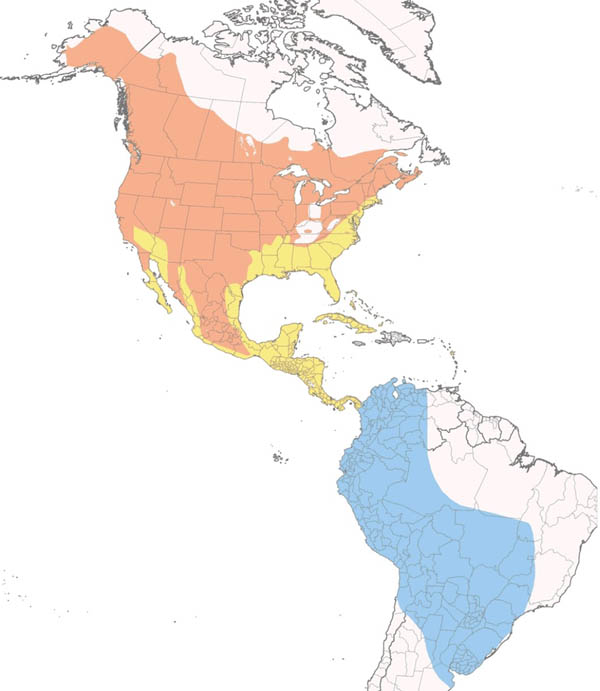
Sources:
- Cliff Swallow. (2019, November 25). Audubon. https://www.audubon.org/field-guide/bird/cliff-swallow
- Cliff Swallow "Petrochelidon pyrrhonota". (2015, November 30). Retrieved May 03, 2021, from https://www.borealbirds.org/bird/cliff-swallow
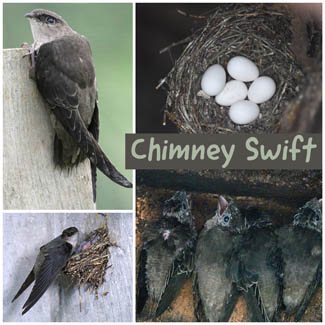
- Grid (counterclockwise):
- Male: / Macaulay Library at the Cornell Lab of Ornithology
- Female: Macaulay Library at the Cornell Lab of Ornithology
- Juvenile: Gretchen Locy / Macaulay Library at the Cornell Lab of Ornithology (ML256425701)
- Nest/Eggs: Justin Nation / Macaulay Library at the Cornell Lab of Ornithology (ML60423561)
- Range map provided by Birds of the World
Click here to lean more about Chimney Swift
Chimney Swift
Chaetura pelagica
The only swift occurring regularly in the east, it once nested in hollow trees, but today it nearly always nests in chimneys or other enclosed vertical structures. Because the bird can be easily captured and banded in such situations, it has been studied much more thoroughly than other North American swifts. In late summer, hundreds or even thousands of individuals may roost in one large chimney, gathering in spectacular flocks overhead near dusk.
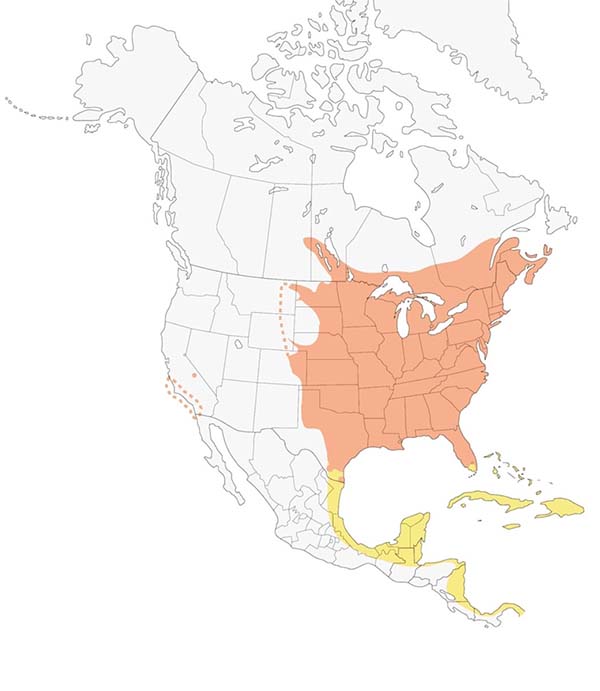
Sources:
- Chimney swift. Audubon. (2021, October 20). Retrieved December 15, 2021, from https://www.audubon.org/field-guide/bird/chimney-swift
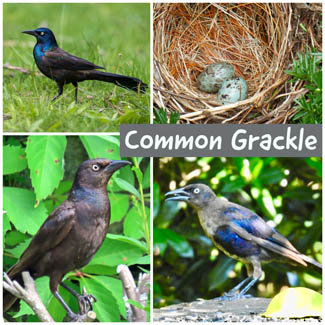
- Grid (counterclockwise):
- Male: Michael Stubblefield / Macaulay Library at the Cornell Lab of Ornithology (ML277717671)
- Female: Shilo McDonald / Macaulay Library at the Cornell Lab of Ornithology (ML248403211)
- Juvenile: Van Remsen / Macaulay Library at the Cornell Lab of Ornithology (ML256413331)
- Nest/Eggs: Kristof Zyskowski / Macaulay Library at the Cornell Lab of Ornithology (ML154389351)
- Range map provided by Birds of the World
Click here to lean more about Common Grackle
Common Grackle
Quiscalus quiscula
Common Grackles are recognized by their long, keel-shaped tails, heavy and sharp bills, yellow eyes, and (in males) glossy black plumage with an iridescent sheen. The word "grackle" derives from the Latin word for Europe's jackdaw, a somewhat similar-looking but unrelated bird. The Common Grackle belongs to the Icteridae family and is related to the Rusty Blackbird, and Baltimore Oriole. These birds have an interesting trait that helps them use the earth's geomagnetic fields to navigate.
Common Grackles, along with many other bird species ranging from the Chimney Swift to Northern Bobwhite, have a magnetic mineral called magnetite in their heads, beaks, and necks. This mineral allows birds to use the earth's geomagnetic fields to navigate. Although there are three subspecies of Common Grackle, only one is visible in this location. The purple grackle (stonei), found southeast of the Appalachians, has a purplish body and head, with a blue or greenish glossed tail.
Common Grackles, along with many other bird species ranging from the Chimney Swift to Northern Bobwhite, have a magnetic mineral called magnetite in their heads, beaks, and necks. This mineral allows birds to use the earth's geomagnetic fields to navigate. Although there are three subspecies of Common Grackle, only one is visible in this location. The purple grackle (stonei), found southeast of the Appalachians, has a purplish body and head, with a blue or greenish glossed tail.
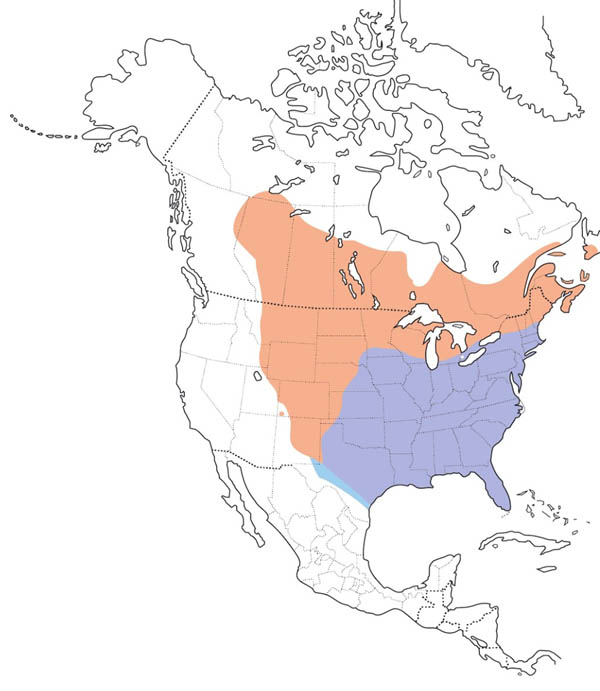
Sources:
- American Bird Conservancy. (2020e, June 24). Common Grackle. https://abcbirds.org/bird/common-grackle/
- Common GRACKLE: National Geographic. (2006). Retrieved May 03, 2021, from https://www.nationalgeographic.com/animals/birds/facts/common-grackle

- Grid (counterclockwise):
- Male: Richard Boyle / Macaulay Library at the Cornell Lab of Ornithology (ML124817121)
- Female: Barry Day / Macaulay Library at the Cornell Lab of Ornithology (ML99079031)
- Juvenile: Nicole Desnoyers / Macaulay Library at the Cornell Lab of Ornithology (ML247926941)
- Nest/Eggs: Stephen Broker / Macaulay Library at the Cornell Lab of Ornithology (ML50340411)
- Range map provided by Birds of the World
Click here to lean more about Common Raven
Common Raven
Corvus corax
Of the birds classified as perching birds or "songbirds," the Common Raven is the largest, the size of a hawk. Often its deep croaking call will alert the observer to a pair of ravens soaring high overhead. An intelligent and remarkably adaptable bird, living as a scavenger and predator, it can survive at all seasons in surroundings as different as hot desert and high Arctic tundra. Once driven from much of its eastern range, the raven is now making a comeback.
The intelligent and sociable Common Raven has been the subject of mythology, folklore, and literature through the ages. In Native American cultures, it is portrayed as a sly trickster, a spiritual figure, or even a god that helped create the earth. Others have seen the raven as a bird of death and doom, perhaps most famously by Edgar Allan Poe in his poem, "The Raven." Swedish folktales depict ravens as the ghosts of those who have been murdered, and old German stories describe ravens as damned souls.
Maybe people find ravens intimidating because they are so smart. Their brains are among the largest of any bird species, and they display excellent problem-solving ability. Biologist Bernd Heinrich, known for his studies of raven behavior, argues that the raven is one of only four known animals (along with bees, ants, and humans) with the ability to communicate about events not in the here-and-now.
Ravens have been observed demonstrating this communication capacity when a lone juvenile bird discovers a large carcass guarded by a pair of adult ravens. The juvenile raven will return to the roost and communicate the find to other birds, and the next day, a flock of unmated ravens will fly to the carcass and chase off the adults.
The intelligent and sociable Common Raven has been the subject of mythology, folklore, and literature through the ages. In Native American cultures, it is portrayed as a sly trickster, a spiritual figure, or even a god that helped create the earth. Others have seen the raven as a bird of death and doom, perhaps most famously by Edgar Allan Poe in his poem, "The Raven." Swedish folktales depict ravens as the ghosts of those who have been murdered, and old German stories describe ravens as damned souls.
Maybe people find ravens intimidating because they are so smart. Their brains are among the largest of any bird species, and they display excellent problem-solving ability. Biologist Bernd Heinrich, known for his studies of raven behavior, argues that the raven is one of only four known animals (along with bees, ants, and humans) with the ability to communicate about events not in the here-and-now.
Ravens have been observed demonstrating this communication capacity when a lone juvenile bird discovers a large carcass guarded by a pair of adult ravens. The juvenile raven will return to the roost and communicate the find to other birds, and the next day, a flock of unmated ravens will fly to the carcass and chase off the adults.
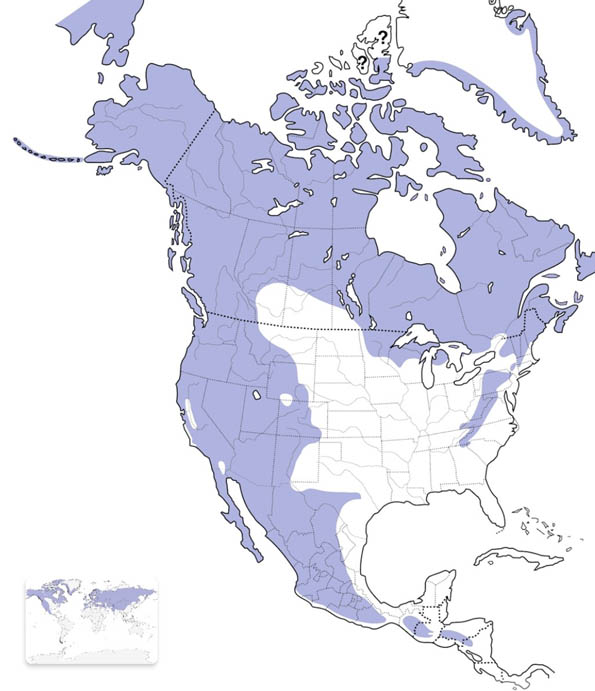
Sources:
- American Bird Conservancy. (2019a, January 17). Common Raven. https://abcbirds.org/bird/common-raven/
- Common raven. (2019, November 26). Retrieved May 03, 2021, from https://www.audubon.org/field-guide/bird/common-raven
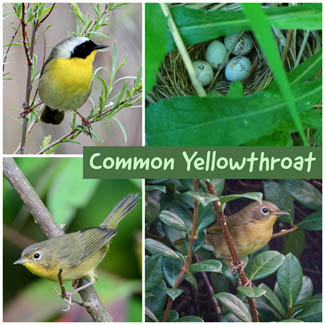
- Grid (counterclockwise):
- Male: Jan Allen / Macaulay Library at the Cornell Lab of Ornithology (ML278674221)
- Female: Stephen Mann / Macaulay Library at the Cornell Lab of Ornithology (ML275393921)
- Juvenile: Jackie Elmore / Macaulay Library at the Cornell Lab of Ornithology (ML265175221)
- Nest/Eggs: Fyn Kynd / Macaulay Library at the Cornell Lab of Ornithology (ML104825191)
- Range map provided by Birds of the World
Click here to lean more about Common Yellowthroat
Common Yellowthroat
Geothlypis trichas
Many people in the United States today still think of this familiar songbird as the "snowbird," since it seems to show up in backyards and other suburban habitats just as winter settles in. The Dark-eyed Junco has a wide distribution across Canada and the United States, also reaching northern Mexico; strays have been reported from the Caribbean and even Europe.
Juncos are sparrows, but unlike most sparrows we see in southwest PA, juncos are sexually dimorphic, meaning that males and females look different! Although there is some overlap in plumage variation, the female has browner feathers overall and a slightly shorter wing length, the male has dark gray plumage and a slightly longer wing. All Dark-eyed Juncos have some features in common: white outer tail feathers that are especially conspicuous when the bird takes flight; darker upper parts contrasting a lighter belly; and a pale bill. But this bird can vary drastically in appearance depending on where one sees it. Some juncos have more reddish-brown on the back and sides, some sport a contrasting dark hood over the head and neck, and others show a gray-tinged belly or white bars on the wings.
Note that there are lots of subspecies of Dark-eyed Juncos (we primarily have "Slate-colored" Juncos in this area), and this trick might not work with all of them!
Juncos are sparrows, but unlike most sparrows we see in southwest PA, juncos are sexually dimorphic, meaning that males and females look different! Although there is some overlap in plumage variation, the female has browner feathers overall and a slightly shorter wing length, the male has dark gray plumage and a slightly longer wing. All Dark-eyed Juncos have some features in common: white outer tail feathers that are especially conspicuous when the bird takes flight; darker upper parts contrasting a lighter belly; and a pale bill. But this bird can vary drastically in appearance depending on where one sees it. Some juncos have more reddish-brown on the back and sides, some sport a contrasting dark hood over the head and neck, and others show a gray-tinged belly or white bars on the wings.
Note that there are lots of subspecies of Dark-eyed Juncos (we primarily have "Slate-colored" Juncos in this area), and this trick might not work with all of them!
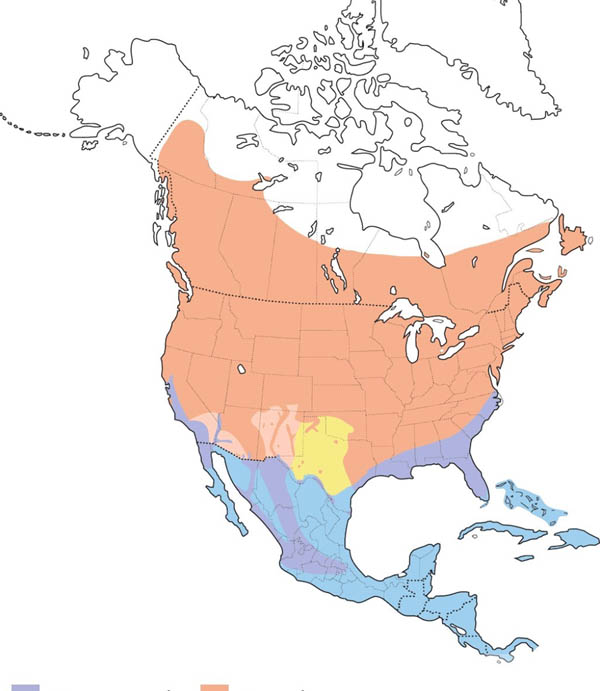
Sources:
- American Bird Conservancy. (2020a, July 20). Dark-eyed Junco. a href="https://abcbirds.org/bird/dark-eyed-junco/<" target="_blank">https://abcbirds.org/bird/dark-eyed-junco/
- Powdermill Nature Reserve, Carnegie Museum of Natural History
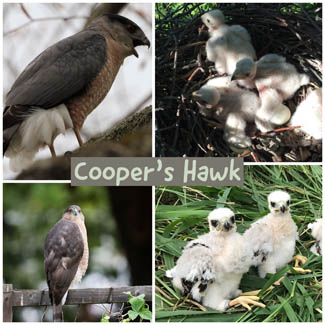
- Grid (counterclockwise):
- Male: Joe Minor / Macaulay Library at the Cornell Lab of Ornithology (ML331514671)
- Female: Garrett Lau / Macaulay Library at the Cornell Lab of Ornithology (ML382200671)
- Juvenile: Mike Stewart / Macaulay Library at the Cornell Lab of Ornithology (ML242062421)
- Nest/Eggs: Chris Davis / Macaulay Library at the Cornell Lab of Ornithology (ML239508911)
- Range map provided by Birds of the World
Click here to lean more about Cooper's Hawk
Cooper's Hawk
Accipiter cooperii
A medium-sized hawk of the woodlands. Feeding mostly on birds and small mammals, it hunts by stealth, approaching its prey through dense cover and then pouncing with a rapid, powerful flight. Of the three bird-eating Accipiter hawks, Cooper's is the mid-sized species and the most widespread as a nesting bird south of Canada.
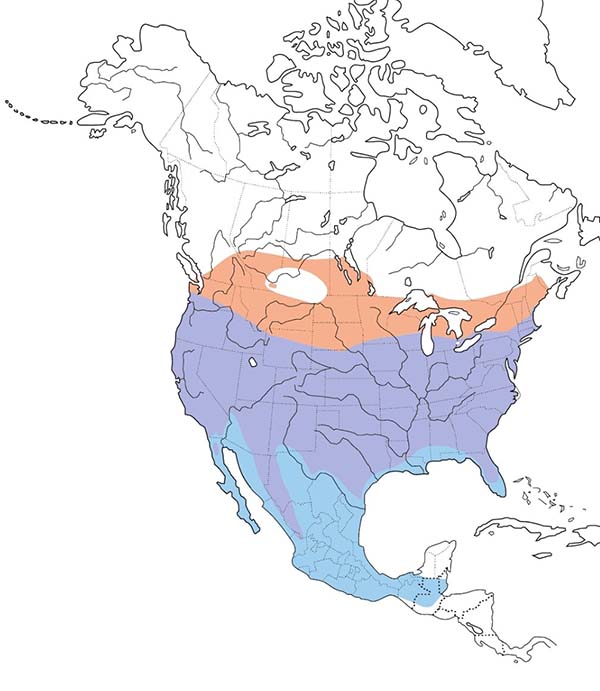
Sources:
- Cooper's Hawk. Audubon. (2021, October 20). Retrieved December 15, 2021, from https://www.audubon.org/field-guide/bird/coopers-hawk
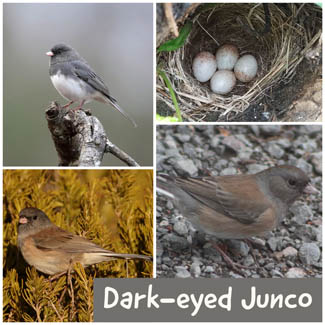
- Grid (counterclockwise):
- Male: Tom Murray / Macaulay Library at the Cornell Lab of Ornithology (ML280045081)
- Female: Kent Leland / Macaulay Library at the Cornell Lab of Ornithology (ML280495901)
- Juvenile: Sean Cozart / Macaulay Library at the Cornell Lab of Ornithology (ML280998531)
- Nest/Eggs: Bob Martinka / Macaulay Library at the Cornell Lab of Ornithology (ML107117571)
- Range map provided by Birds of the World
Click here to lean more about Dark-eyed Junco
Dark-eyed Junco
Junco hyemalis
Dark-eyed Junco is a plump, gray sparrow with a white belly. We often see them hopping under feeders in the snow, cheerfully picking up spilled millet and other seeds from the ground. It is one of the more recognizable and most-loved winter feeder birds. The Dark-eyed Junco has a wide distribution across Canada and the United States, also reaching northern Mexico; strays have been reported from the Caribbean and even Europe.
Juncos are sparrows, but unlike most sparrows we see in southwest PA, juncos are sexually dimorphic, meaning that males and females look different! Although there is some overlap in plumage variation, the female has browner feathers overall and a slightly shorter wing length, the male has dark gray plumage and a slightly longer wing. All Dark-eyed Juncos have some features in common: white outer tail feathers that are especially conspicuous when the bird takes flight; darker upperparts contrasting a lighter belly; and a pale bill. But this bird can vary drastically in appearance depending on where one sees it. Some juncos have more reddish-brown on the back and sides, some sport a contrasting dark hood over the head and neck, and others show a gray-tinged belly or white bars on the wings.
Note that there are lots of subspecies of Dark-eyed Juncos (we primarily have "Slate-colored" Juncos in this area), and this trick might not work with all of them!
Juncos are sparrows, but unlike most sparrows we see in southwest PA, juncos are sexually dimorphic, meaning that males and females look different! Although there is some overlap in plumage variation, the female has browner feathers overall and a slightly shorter wing length, the male has dark gray plumage and a slightly longer wing. All Dark-eyed Juncos have some features in common: white outer tail feathers that are especially conspicuous when the bird takes flight; darker upperparts contrasting a lighter belly; and a pale bill. But this bird can vary drastically in appearance depending on where one sees it. Some juncos have more reddish-brown on the back and sides, some sport a contrasting dark hood over the head and neck, and others show a gray-tinged belly or white bars on the wings.
Note that there are lots of subspecies of Dark-eyed Juncos (we primarily have "Slate-colored" Juncos in this area), and this trick might not work with all of them!
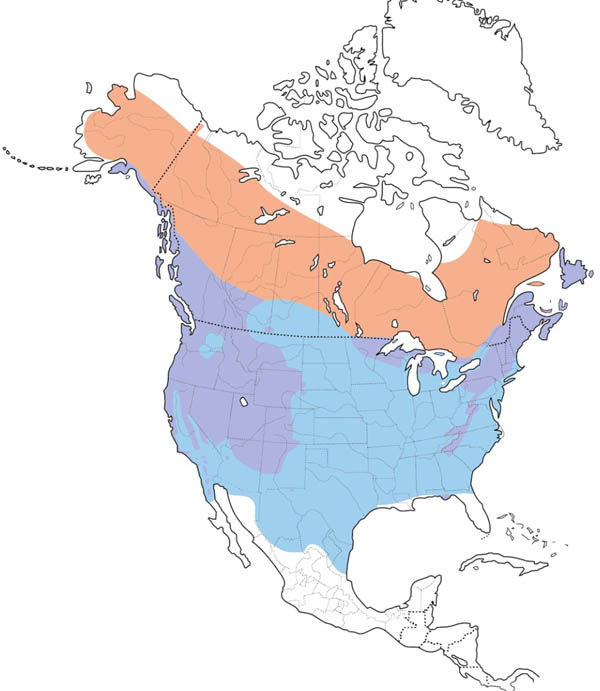
Sources:
- American Bird Conservancy. (2020a, July 20). Dark-eyed Junco. https://abcbirds.org/bird/dark-eyed-junco/
- Powdermill Nature Reserve, Carnegie Museum of Natural History
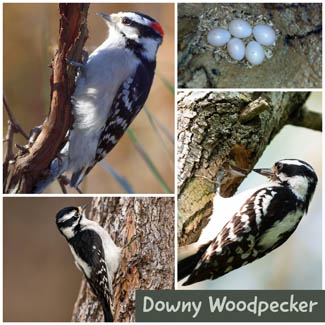
- Grid (counterclockwise):
- Male: Richard Guillet / Macaulay Library at the Cornell Lab of Ornithology (ML277877971)
- Female: Alex Bodden / Macaulay Library at the Cornell Lab of Ornithology (ML280052891)
- Juvenile: Suzie McCann / Macaulay Library at the Cornell Lab of Ornithology (ML238228681)
- Nest/Eggs: Scott H / Macaulay Library at the Cornell Lab of Ornithology (ML28334431)
- Range map provided by Birds of the World
Click here to lean more about Downy Woodpecker
Downy Woodpecker
Dryobates pubescens
The Downy is the smallest woodpecker in North America and could be voted "most likely to visit a backyard feeder," where it holds its own alongside larger birds such as the Northern Cardinal and Blue Jay. Being small has certain advantages. The Downy Woodpecker can forage for food where heavier woodpeckers cannot, including on the slender upper branches of trees and shrubs and weed stems. Nimble and active, Downies can even cling upside-down like a nuthatch or chickadee. Frequent backyard visitors, Downy Woodpeckers may form pairs very early in the season, tapping out their courtship song on a tree trunk. Listen for this rhythmic sound as early as January.
Sometimes, a Downy Woodpecker will follow the crow-sized Pileated Woodpecker, taking advantage of the larger bird's excavations and any insects it might overlook. This canny little woodpecker has also been known to follow White-breasted Nuthatches to their seed caches to swipe food, and from fall through early spring, it regularly joins mixed-species flocks of chickadees, titmice, and nuthatches, thereby maximizing foraging opportunities.
The Downy Woodpecker can be found across most of the United States and Canada. Seven subspecies are recognized, based on subtle differences in coloration, marking, and size. The Downy is usually a permanent resident, although northern birds may migrate short distances south, and mountain populations may move to lower elevations during severe winters.
Sometimes, a Downy Woodpecker will follow the crow-sized Pileated Woodpecker, taking advantage of the larger bird's excavations and any insects it might overlook. This canny little woodpecker has also been known to follow White-breasted Nuthatches to their seed caches to swipe food, and from fall through early spring, it regularly joins mixed-species flocks of chickadees, titmice, and nuthatches, thereby maximizing foraging opportunities.
The Downy Woodpecker can be found across most of the United States and Canada. Seven subspecies are recognized, based on subtle differences in coloration, marking, and size. The Downy is usually a permanent resident, although northern birds may migrate short distances south, and mountain populations may move to lower elevations during severe winters.
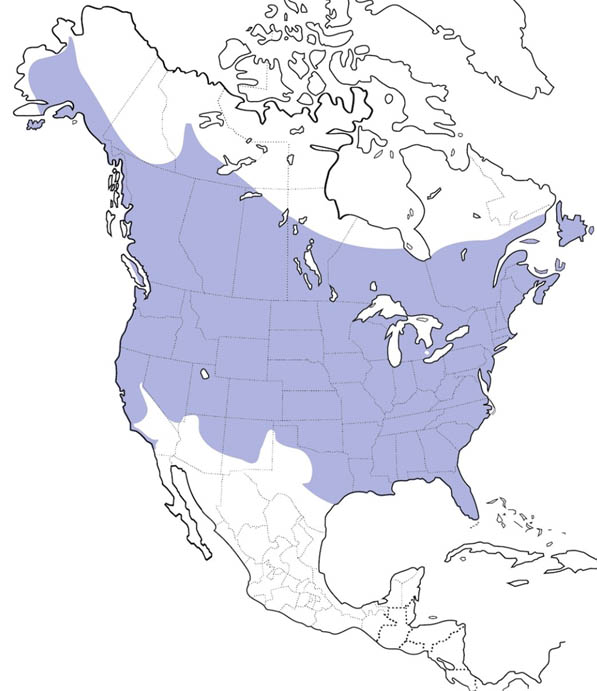
Sources:
- American Bird Conservancy. (2020f, June 24). Downy Woodpecker. /https://abcbirds.org/bird/downy-woodpecker
- Staake, J. (2020, April 24). Downy Woodpecker. Retrieved May 03, 2021, from https://www.birdsandblooms.com/birding/bird-species/medium-sized-land-birds/downy-woodpecker/

- Grid (counterclockwise):
- Male: Bill Massaro / Macaulay Library at the Cornell Lab of Ornithology (ML272358111)
- Female: Bill Wood / Macaulay Library at the Cornell Lab of Ornithology (ML280957691)
- Juvenile: Stephen Davies / Macaulay Library at the Cornell Lab of Ornithology (ML264039961)
- Nest/Eggs: Janis Cooper / Macaulay Library at the Cornell Lab of Ornithology (ML246528681)
- Range map provided by Birds of the World
Click here to lean more about Eastern Bluebird
Eastern Bluebird
Sialia sialis
The vibrant colors and soft, musical warbles of the Eastern Bluebird are a welcome sight on a cold, snowy day. Bluebirds have long been considered harbingers of spring, and their willingness to nest in open, human-modified habitats makes them popular among birders and non-birders alike.
This lovely species has made a heartening comeback since the early 20th century, when introduced species, habitat loss, and pesticides caused alarming population declines. The Eastern Bluebird's diet is made up of insects such as crickets, grasshoppers, and beetles, with fruit added, especially during the winter. The birds hunt for insect prey using a "sit and wait" strategy, somewhat like a Willow Flycatcher. Once a bluebird spots prey, it drops down from its perch to snatch it from the air or the ground. Bluebirds also love mealworms, and suet, and will readily visit feeders for them.
While not the only, blue-colored birds in the area, Eastern Bluebirds are the only birds with blue upper parts and rusty breasts and flanks. Bluebirds are not blue because of a pigment in their feathers - blue coloration is due to the way the feather structure reflects blue light. Blue-colored birds may appear gray if they are turned at an odd angle to the sun but are brilliantly blue when the light hits just right. In southwestern Pennsylvania, we can see bluebirds all year, and if you are lucky and have the right habitat, a pair may even nest in your yard!
This lovely species has made a heartening comeback since the early 20th century, when introduced species, habitat loss, and pesticides caused alarming population declines. The Eastern Bluebird's diet is made up of insects such as crickets, grasshoppers, and beetles, with fruit added, especially during the winter. The birds hunt for insect prey using a "sit and wait" strategy, somewhat like a Willow Flycatcher. Once a bluebird spots prey, it drops down from its perch to snatch it from the air or the ground. Bluebirds also love mealworms, and suet, and will readily visit feeders for them.
While not the only, blue-colored birds in the area, Eastern Bluebirds are the only birds with blue upper parts and rusty breasts and flanks. Bluebirds are not blue because of a pigment in their feathers - blue coloration is due to the way the feather structure reflects blue light. Blue-colored birds may appear gray if they are turned at an odd angle to the sun but are brilliantly blue when the light hits just right. In southwestern Pennsylvania, we can see bluebirds all year, and if you are lucky and have the right habitat, a pair may even nest in your yard!
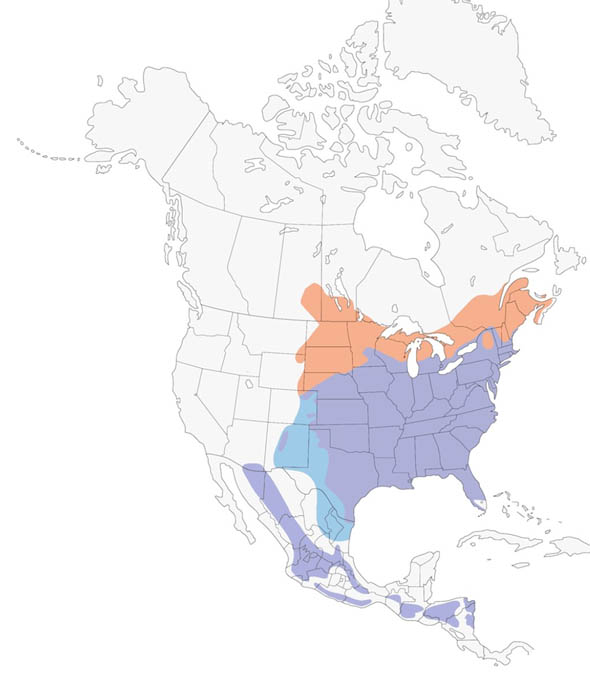
Sources:
- American Bird Conservancy. (2021b, April 21). Eastern Bluebird. https://abcbirds.org/bird/eastern-bluebird/
- Powdermill Nature Reserve, Carnegie Museum of Natural History
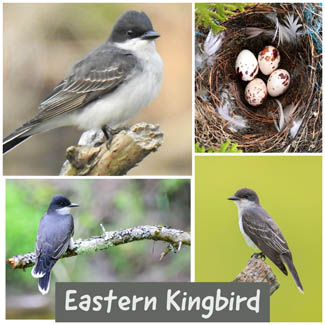
- Grid (counterclockwise):
- Male: Lucio "Luc" Fazio / Macaulay Library at the Cornell Lab of Ornithology (ML237999021)
- Female: Mathieu Langlois / Macaulay Library at the Cornell Lab of Ornithology (ML63818131)
- Juvenile: Michael Stubblefield / Macaulay Library at the Cornell Lab of Ornithology (ML273389551)
- Nest/Eggs: Vincent Létourneau / Macaulay Library at the Cornell Lab of Ornithology (ML84460961)
- Range map provided by Birds of the World
Click here to lean more about Eastern Kingbird
Eastern Kingbird
Tyrannus tyrannus
This species is the only widespread kingbird in the east. Common and conspicuous in summer, it is often seen perched jauntily on a treetop or fence wire or sallying out with shallow fluttering wingbeats to catch an insect in mid-air. In winter in South America, it takes on a different personality, living in flocks in tropical forests and dining on berries.
Eastern Kingbirds are one of the largest flycatchers that are found in this area. Although it can be difficult, if not impossible, to sex this species in the field, you can tell some juvenile birds from adults. Take a close look at the feathers on the bird's head: some are black, and some are brown. The brown feathers are juvenal feathers that the bird grew in the nest and the black feathers are replacing those juvenal feathers during what is called "preformative molt" (or the molt that happens in young birds after the breeding season). Soon, most, or all the bird's juvenal body plumage will be replaced with formative feathers, and it will resemble an adult.
Eastern Kingbirds are a species of flycatcher that is readily identified by its dark gray upper parts, white belly, and bold white tail stripe at the tip of its tail. But they have a shock of color on their heads, usually hidden under gray feathers. When Eastern Kingbirds stick their head feathers up, a bright splash of orange or scarlet is sometimes revealed! Maybe the next time you see one of these birds you will be treated to a glimpse of this secret field mark!
Eastern Kingbirds are one of the largest flycatchers that are found in this area. Although it can be difficult, if not impossible, to sex this species in the field, you can tell some juvenile birds from adults. Take a close look at the feathers on the bird's head: some are black, and some are brown. The brown feathers are juvenal feathers that the bird grew in the nest and the black feathers are replacing those juvenal feathers during what is called "preformative molt" (or the molt that happens in young birds after the breeding season). Soon, most, or all the bird's juvenal body plumage will be replaced with formative feathers, and it will resemble an adult.
Eastern Kingbirds are a species of flycatcher that is readily identified by its dark gray upper parts, white belly, and bold white tail stripe at the tip of its tail. But they have a shock of color on their heads, usually hidden under gray feathers. When Eastern Kingbirds stick their head feathers up, a bright splash of orange or scarlet is sometimes revealed! Maybe the next time you see one of these birds you will be treated to a glimpse of this secret field mark!
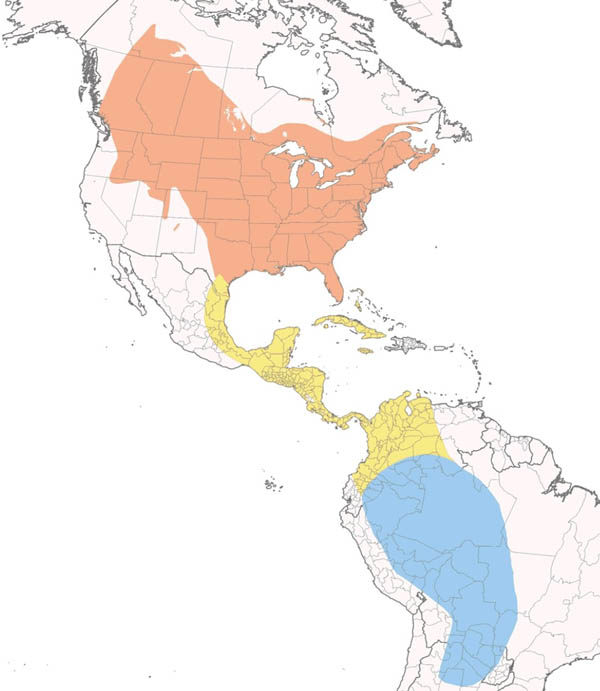
Sources:
- Eastern Kingbird. (2020, April 30). Audubon. https://www.audubon.org/field-guide/bird/eastern-kingbird
- Powdermill Nature Reserve, Carnegie Museum of Natural History
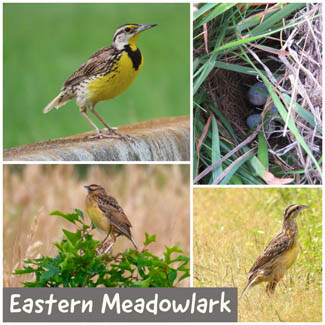
- Grid (counterclockwise):
- Male: Kevin Christman / Macaulay Library at the Cornell Lab of Ornithology (ML241568961)
- Female: Scott Dresser / Macaulay Library at the Cornell Lab of Ornithology (ML245000511)
- Juvenile: S. K. Jones / Macaulay Library at the Cornell Lab of Ornithology (ML175064991)
- Nest/Eggs: Cheryl J Jacobson / Macaulay Library at the Cornell Lab of Ornithology (ML30728121)
- Range map provided by Birds of the World
Click here to lean more about Eastern Meadowlark
Eastern Meadowlark
Sturnella magna
Often hunkered down in the grasses, the Eastern Meadowlark may surprise a casual observer: This stout-bodied bird sports a cryptic, streaky brown back, but when facing you, you see its shocking yellow breast, emblazoned with a bold, black "V." Spring and early summer are best for spotting these birds, when males perch in isolated field trees and shrubs or on fence posts, incessantly belting out their distinctive "Spring-of-the YEEAAR" song, which in Mexico is interpreted as "Tortilla Con Chile." The Eastern Meadowlark migrates to a warmer climate during the winter months. Some will even outlast winter in the grassy fields surrounding the Great Lakes, where the temperatures are more moderate.
Meadowlarks belong to the family Icteridae, which includes blackbirds, cowbirds, grackles, and orioles, including Baltimore and Audubon's Orioles. The Eastern Meadowlark is one of two meadowlark species found in the United States and Canada.
In breeding season, the female Eastern Meadowlark crafts a domed nest of grasses which is placed on the ground under thick cover. She weaves the grass stems in and out of surrounding vegetation so that there is a secure overhang, while one side remains open as an entrance. In this domed refuge, she incubates three to five spotted eggs, which hatch in approximately two weeks. Both parents feed their nestlings. Although the young leave the nest after about 12 days, the parents tend them for at least two more weeks. If all goes well, a meadowlark pair raises two broods each year.
Meadowlarks belong to the family Icteridae, which includes blackbirds, cowbirds, grackles, and orioles, including Baltimore and Audubon's Orioles. The Eastern Meadowlark is one of two meadowlark species found in the United States and Canada.
In breeding season, the female Eastern Meadowlark crafts a domed nest of grasses which is placed on the ground under thick cover. She weaves the grass stems in and out of surrounding vegetation so that there is a secure overhang, while one side remains open as an entrance. In this domed refuge, she incubates three to five spotted eggs, which hatch in approximately two weeks. Both parents feed their nestlings. Although the young leave the nest after about 12 days, the parents tend them for at least two more weeks. If all goes well, a meadowlark pair raises two broods each year.
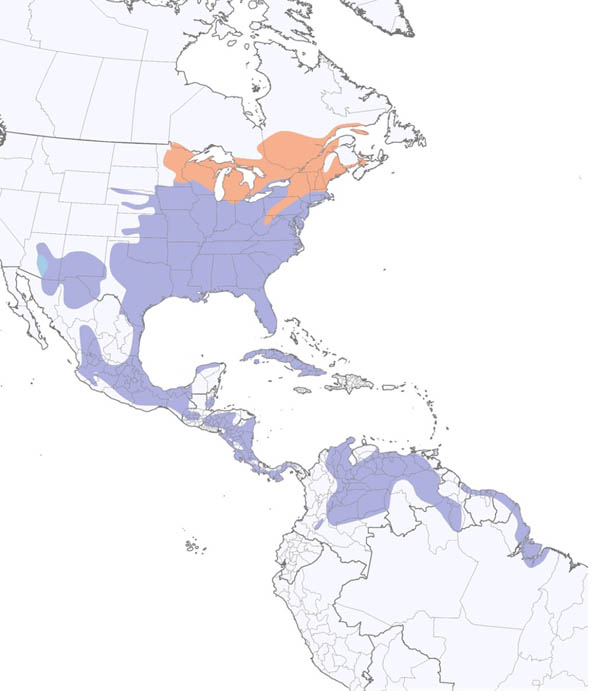
Sources:
- American Bird Conservancy. (2020c, July 20). Eastern Meadowlark. https://abcbirds.org/bird/eastern-meadowlark/
- Eastern meadowlark (Sturnella Magna) - birds of North America - North American Birds. (2006). Retrieved May 03, 2021, from https://www.birds-of-north-america.net/Eastern_Meadowlark.html
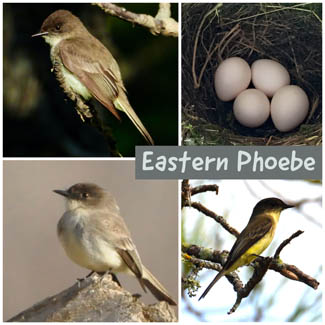
- Grid (counterclockwise):
- Male: George Halmazna / Macaulay Library at the Cornell Lab of Ornithology (ML242249561)
- Female: Steve Kinsley / Macaulay Library at the Cornell Lab of Ornithology (ML149120871)
- Juvenile: John Whitehead / Macaulay Library at the Cornell Lab of Ornithology (ML273176091)
- Nest/Eggs: Eric Soehren / Macaulay Library at the Cornell Lab of Ornithology (ML54171331)
- Range map provided by Birds of the World
Click here to lean more about Eastern Phoebe
Eastern Phoebe
Sayornis phoebe
Despite its plain appearance, this flycatcher is often a favorite among eastern birdwatchers. It is among the earliest of migrants, bringing hope that spring is at hand. Seemingly quite tame, it can be easily observed building nests near buildings and bridges. Best of all, its gentle tail-wagging habit and soft fee-bee song make the Phoebe easy to identify, unlike many flycatchers.
This flycatcher often nests near or on houses or buildings. It's smoky brown-gray above with a creamy-lemon yellow belly, sings its name "fee-BEE! FEE-bee," and is best identified by its characteristic tail pump when it's perched. Phoebes are a flycatcher and therefore need to head south to milder temperatures for the winter (though the odd hearty birds are occasionally seen in Dec-Feb).
This flycatcher often nests near or on houses or buildings. It's smoky brown-gray above with a creamy-lemon yellow belly, sings its name "fee-BEE! FEE-bee," and is best identified by its characteristic tail pump when it's perched. Phoebes are a flycatcher and therefore need to head south to milder temperatures for the winter (though the odd hearty birds are occasionally seen in Dec-Feb).
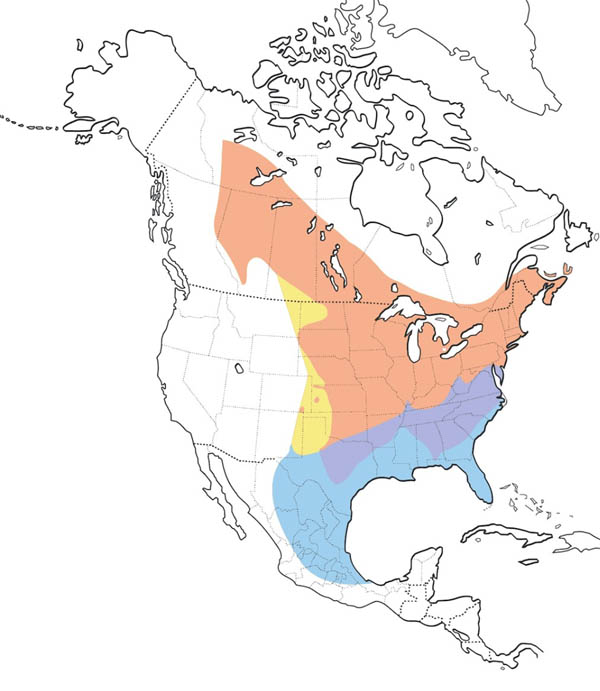
Sources:
- Eastern Phoebe. (2019, November 26). Audubon. https://www.audubon.org/field-guide/bird/eastern-phoebe
- Powdermill Nature Reserve, Carnegie Museum of Natural History
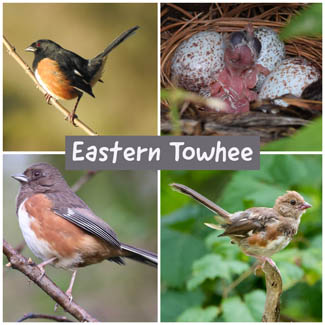
- Grid (counterclockwise):
- Male: Daniel Lane / Macaulay Library at the Cornell Lab of Ornithology (ML276860591)
- Female: Karl Overman / Macaulay Library at the Cornell Lab of Ornithology (ML277680691)
- Juvenile: Sue Barth / Macaulay Library at the Cornell Lab of Ornithology (ML261257751)
- Nest/Eggs: Mike Winck / Macaulay Library at the Cornell Lab of Ornithology (ML159111891)
- Range map provided by Birds of the World
Click here to lean more about Eastern Towhee
Eastern Towhee
Pipilo erythrophthalmus
Sometimes secretive but often common, Eastern Towhees may be noticed first by the sound of industrious scratching in the leaf litter under dense thickets. In the nesting season, males become bolder, singing their familiar "drink your TEEEA!" song from high perches. In some areas, this bird is commonly known as "Chewink," after the sound of its call note, which also may sound like "tow-HEE!"
One of the coolest features of Eastern Towhees is the brilliant red eye that most adults have. Contrastingly, juvenal towhees have grayish-brown eyes that slowly turn brown, then bright red. Towhee subspecies in the southeast, though, tend to have much paler eyes that are light orangey-yellow, or even white. Iris color can be a useful tool to help bird banders age birds that show this age-related color change. Note that in towhees, eye color has nothing to do with sex and everything to do with age. Male towhees have black on the head, back, wings, tail, and breast with rufous wash on the sides and a white belly. Females have the same plumage pattern but are a warm chocolatey brown where the males are black.
One of the coolest features of Eastern Towhees is the brilliant red eye that most adults have. Contrastingly, juvenal towhees have grayish-brown eyes that slowly turn brown, then bright red. Towhee subspecies in the southeast, though, tend to have much paler eyes that are light orangey-yellow, or even white. Iris color can be a useful tool to help bird banders age birds that show this age-related color change. Note that in towhees, eye color has nothing to do with sex and everything to do with age. Male towhees have black on the head, back, wings, tail, and breast with rufous wash on the sides and a white belly. Females have the same plumage pattern but are a warm chocolatey brown where the males are black.
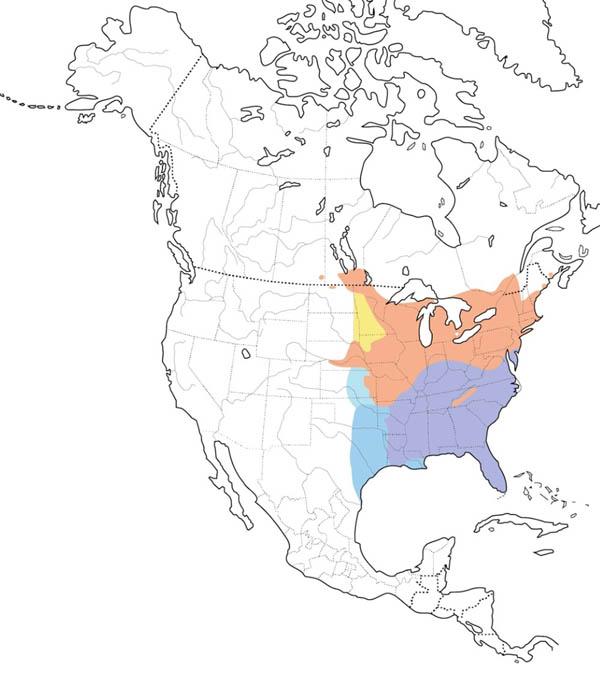
Sources:
- Eastern Towhee. (2019, November 26). Audubon. https://www.audubon.org/field-guide/bird/eastern-towhee
- Powdermill Nature Reserve, Carnegie Museum of Natural History
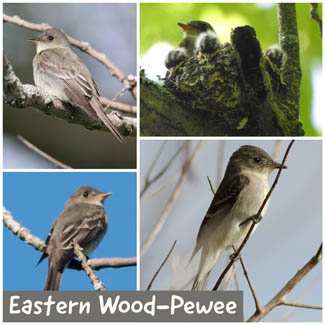
- Grid (counterclockwise):
- Male: Daniel Jauvin / Macaulay Library at the Cornell Lab of Ornithology (ML242465671)
- Female: Sue Barth / Macaulay Library at the Cornell Lab of Ornithology (ML246475561)
- Juvenile: Alix d'Entremont / Macaulay Library at the Cornell Lab of Ornithology (ML267771921)
- Nest/Eggs: Nest/Eggs: Larry Chapin / Macaulay Library at the Cornell Lab of Ornithology (ML258465811)
- Range map provided by Birds of the World
Click here to lean more about Eastern Wood-Pewee
Eastern Wood-Pewee
Contopus virens
In eastern woods in summer, the plaintive whistled pee-a-wee of this small flycatcher is often heard before the bird is seen. The bird itself is usually somewhere in the leafy middle story of the trees, perched on a bare twig, darting out to catch passing insects. The Wood-Pewee sings most often at dawn and dusk, and it may continue singing quite late in the evening after most songbirds have fallen silent.
Many people think small flycatchers look alike, and they are not wrong! Many of these birds are varying shades of greenish-brownish-grayish and often flit in and out of shady, leafy areas making them difficult to ID. However, some distinct differences might not be obvious in the field. Take this Eastern Wood-Pewee - these birds have very short tarsi (the foot joint that the band encircles), perhaps even peewee-size tarsi!
Many people think small flycatchers look alike, and they are not wrong! Many of these birds are varying shades of greenish-brownish-grayish and often flit in and out of shady, leafy areas making them difficult to ID. However, some distinct differences might not be obvious in the field. Take this Eastern Wood-Pewee - these birds have very short tarsi (the foot joint that the band encircles), perhaps even peewee-size tarsi!
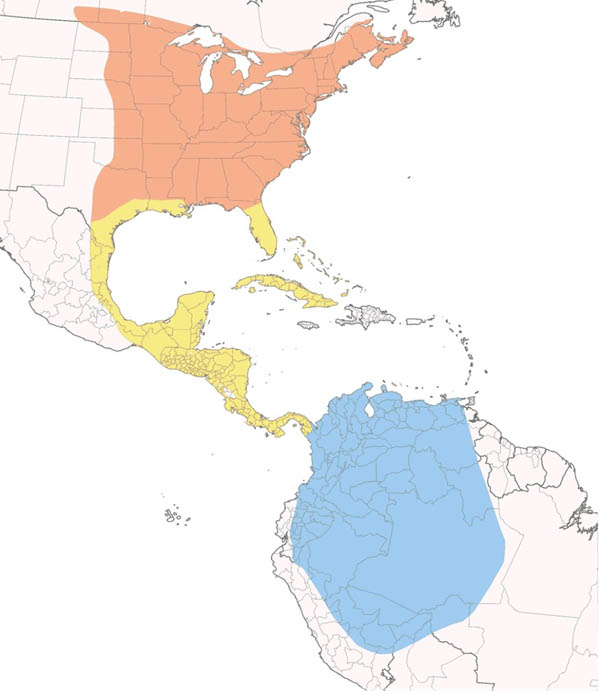
Sources:
- Eastern Wood-Pewee. (2019, November 26). Audubon. https://www.audubon.org/field-guide/bird/eastern-wood-pewee
- Powdermill Nature Reserve, Carnegie Museum of Natural History
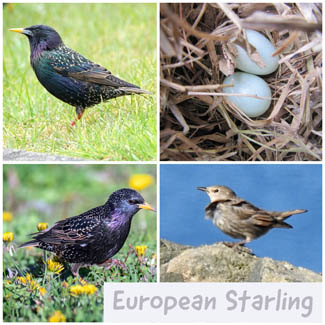
- Grid (counterclockwise):
- Male: Ivan Provoost / Macaulay Library at the Cornell Lab of Ornithology (ML222034021)
- Female: Danielle A. / Macaulay Library at the Cornell Lab of Ornithology (ML237035031)
- Juvenile: Stephen Bailey / Macaulay Library at the Cornell Lab of Ornithology (ML280616271)
- Nest/Eggs: Steven Joyner / Macaulay Library at the Cornell Lab of Ornithology (ML186507311)
- Range map provided by Birds of the World
Click here to lean more about European Starling
European Starling
Sturnus vulgaris
Often regarded as a pest, the Starling wins our grudging admiration for its adaptability, toughness, and seeming intelligence. Brought to North America in 1890, it has spread to occupy most of the continent and is now abundant in many areas. Sociable at most seasons, Starlings may gather in immense flocks in fall and winter. When the flocks break up for the breeding season, males reveal a skill for mimicry, interrupting their wheezing and sputtering songs with perfect imitations of other birds.
Starlings are usually monogamous. Males will establish a territory and nest site and then attract a female. They are very gregarious and will breed close to other pairs of starlings. During vicious fights over breeding sites, the birds will grab each other with their feet, and peck each other. Starlings prefer nesting in cavities but will use natural cavities, holes made by birds such as woodpeckers, or birdhouses, rather than excavate their own. Both birds of a pair will help build the nest. The cavity is filled with grass, weeds, string, and other material. The female will lay 4 to 7 pale blue or greenish eggs. Starlings may have a second brood. If they do, they usually place new nesting material over the old.
Starlings are usually monogamous. Males will establish a territory and nest site and then attract a female. They are very gregarious and will breed close to other pairs of starlings. During vicious fights over breeding sites, the birds will grab each other with their feet, and peck each other. Starlings prefer nesting in cavities but will use natural cavities, holes made by birds such as woodpeckers, or birdhouses, rather than excavate their own. Both birds of a pair will help build the nest. The cavity is filled with grass, weeds, string, and other material. The female will lay 4 to 7 pale blue or greenish eggs. Starlings may have a second brood. If they do, they usually place new nesting material over the old.

Sources:
- European Starling. (2020, April 30). Audubon. https://www.audubon.org/field-guide/bird/european-starling
- European starling. (2015). Retrieved May 03, 2021, from https://www.all-birds.com/starling.htm
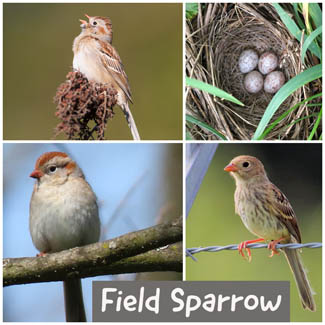
- Grid (counterclockwise):
- Male: Michael Stubblefield / Macaulay Library at the Cornell Lab of Ornithology (ML278416391)
- Female: David Cooney Jr. / Macaulay Library at the Cornell Lab of Ornithology (ML227205231)
- Juvenile: John Cameron / Macaulay Library at the Cornell Lab of Ornithology (ML254482341)
- Nest/Eggs: Nest/Eggs: Glen Somogie / Macaulay Library at the Cornell Lab of Ornithology (ML155151461)
- Range map provided by Birds of the World
Click here to lean more about Field Sparrow
Field Sparrow
Spizella pusilla
The plaintive whistled song of the Field Sparrow often can be heard in brushy pastures, even on hot summer days when most birds are silent. Despite the name, this is not one of the sparrows inhabiting open fields of grass; it prefers overgrown meadows with many bushes. It looks distinctively small and long-tailed, and its plain face gives it an innocent expression to match the sweetness of its song that reminds birders of a bouncing rubber ball. Field Sparrows are plump and have an overall pinkish, or warm brown, wash on the head, back, and wings, and have a diagnostic pink bill. These birds can be found in southwestern Pennsylvania year-round, although the individuals that breed here are likely different than those spending the winter.
This species is of conservation concern, as its population is threatened by habitat loss and the complicated effects of climate change.
This species is of conservation concern, as its population is threatened by habitat loss and the complicated effects of climate change.

Sources:
- Field Sparrow. (2019, November 27). Audubon. https://www.audubon.org/field-guide/bird/field-sparrow
- Powdermill Nature Reserve, Carnegie Museum of Natural History
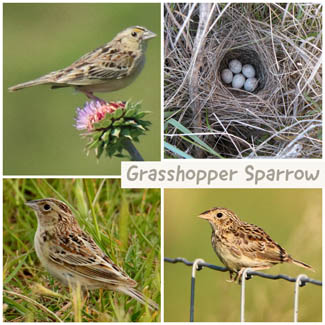
- Grid (counterclockwise):
- Male: Donald Mackler / Macaulay Library at the Cornell Lab of Ornithology (ML255176331)
- Female: Albert Linkowski / Macaulay Library at the Cornell Lab of Ornithology (ML54668191)
- Juvenile: Mark Brown / Macaulay Library at the Cornell Lab of Ornithology (ML254227851)
- Nest/Eggs: Alyssa DeRubeis / Macaulay Library at the Cornell Lab of Ornithology (ML232572691)
- Range map provided by Birds of the World
Click here to lean more about Grasshopper Sparrow
Grasshopper Sparrow
Ammodramus savannarum
More often heard than seen, the secretive Grasshopper Sparrow gets its name for the buzzing, insect-like quality of its songs. When seen among the dense grasses where it breeds, this small, short-tailed bird appears big-headed and large-billed compared to other sparrows.
Grasshopper sparrows are not uncommon in southwestern Pennsylvania but have specific habitat requirements. They can be found in open, grassy fields or prairies, and can be identified from other sparrows by their overall warm, buffy wash and nearly no breast streaking.
Habitat loss and degradation remain the greatest threats to Grasshopper Sparrow and other grassland-dependent species such as the Bobolink. Increased use of pesticides, brood parasitism by Brown-headed Cowbirds, and loss of wintering habitat have also contributed to population declines.
Grasshopper sparrows are not uncommon in southwestern Pennsylvania but have specific habitat requirements. They can be found in open, grassy fields or prairies, and can be identified from other sparrows by their overall warm, buffy wash and nearly no breast streaking.
Habitat loss and degradation remain the greatest threats to Grasshopper Sparrow and other grassland-dependent species such as the Bobolink. Increased use of pesticides, brood parasitism by Brown-headed Cowbirds, and loss of wintering habitat have also contributed to population declines.
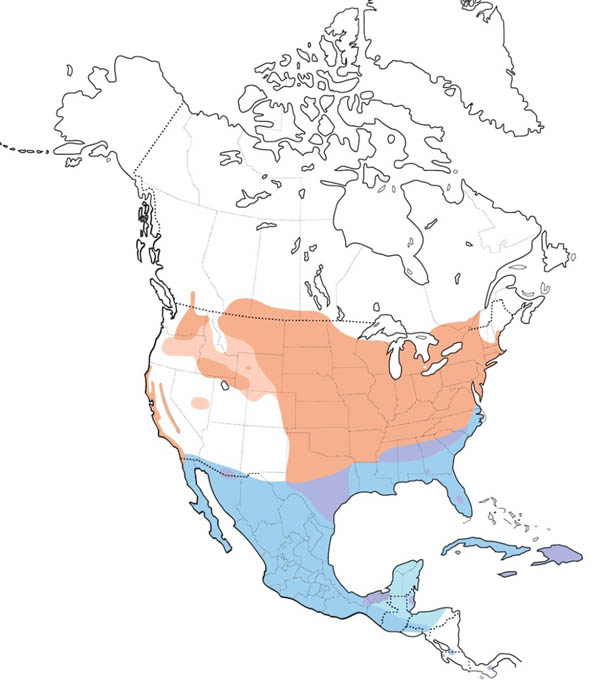
Sources:
- American Bird Conservancy. (2020a, June 23). Grasshopper Sparrow. https://abcbirds.org/bird/grasshopper-sparrow/
- Powdermill Nature Reserve, Carnegie Museum of Natural History
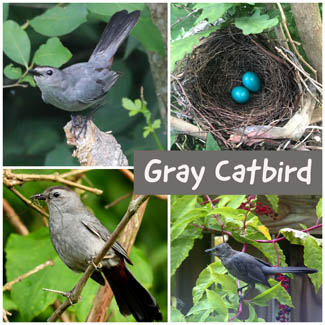
- Grid (counterclockwise):
- Male: Kelly Krechmer / Macaulay Library at the Cornell Lab of Ornithology (ML253896971)
- Female: Zach Vaughan / Macaulay Library at the Cornell Lab of Ornithology (ML249367291)
- Juvenile: Cheryl Hogue / Macaulay Library at the Cornell Lab of Ornithology (ML258681661)
- Nest/Eggs: Cory Elowe / Macaulay Library at the Cornell Lab of Ornithology (ML255291761)
- Range map provided by Birds of the World
Click here to lean more about Gray Catbird
Gray Catbird
Dumetella carolinensis
The Gray Catbird is a familiar member of the Mimidae (mimic) family, a group of birds that includes noted songsters such as Northern Mockingbird and Brown Thrasher. This species is not shy about letting its presence be known. Like its relatives, the Gray Catbird mimics a variety of sounds, but this bird is best known for the cat-like mewing calls that give the species its common name. Gray Catbirds often sing from a high perch while displaying; this behavior gave rise to an idiom heard in the southern United States, "sitting in the catbird seat," which refers to someone in an advantageous position.
The catbird's genus name, Dumetella, means "small thicket," a nod to its preferred habitat of deep thickets and shrubs. Gray Catbirds migrate to southern areas of the United States, Mexico, Central America, and the Caribbean for the winter, where they are found in the same brushy habitats as on their breeding grounds.
Gray Catbirds are excellent models of adult vs. juvenal plumage. While the adult is sleek, the young bird appears fluffy. The undertail coverts show distinct contrast between rich rufous and high-quality adult feathers vs lighter and fluffier juvenal feathers in young birds.
The catbird's genus name, Dumetella, means "small thicket," a nod to its preferred habitat of deep thickets and shrubs. Gray Catbirds migrate to southern areas of the United States, Mexico, Central America, and the Caribbean for the winter, where they are found in the same brushy habitats as on their breeding grounds.
Gray Catbirds are excellent models of adult vs. juvenal plumage. While the adult is sleek, the young bird appears fluffy. The undertail coverts show distinct contrast between rich rufous and high-quality adult feathers vs lighter and fluffier juvenal feathers in young birds.

Sources:
- American Bird Conservancy. (2020b, June 23). In the Catbird Seat: Gray Catbird. https://abcbirds.org/bird/gray-catbird/
- Powdermill Nature Reserve, Carnegie Museum of Natural History
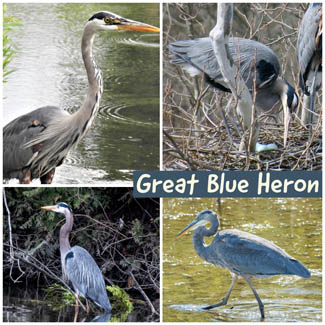
- Grid (counterclockwise):
- Male: Lucio 'Luc' Fazio / Macaulay Library at the Cornell Lab of Ornithology (ML347650061)
- Female: Estela Quintero-Weldon / Macaulay Library at the Cornell Lab of Ornithology (ML223934981)
- Juvenile: Robin Hood / Macaulay Library at the Cornell Lab of Ornithology (ML374261011)
- Nest/Eggs: Lauren Nagoda / Macaulay Library at the Cornell Lab of Ornithology (ML91148061)
- Range map provided by Birds of the World
Click here to lean more about Great Blue Heron
Great Blue Heron
Ardea herodias
Widespread and familiar (though often called 'crane'), the largest heron in North America. Often seen standing silently along inland rivers or lakeshores, or flying high overhead, with slow wingbeats, its head hunched back onto its shoulders. Highly adaptable, it thrives around all kinds of waters from subtropical mangrove swamps to desert rivers to the coastline of southern Alaska. With its variable diet, it can spend the winter farther north than most herons, even in areas where most waters freeze. A form in southern Florida (called 'Great White Heron') is slightly larger and entirely white.
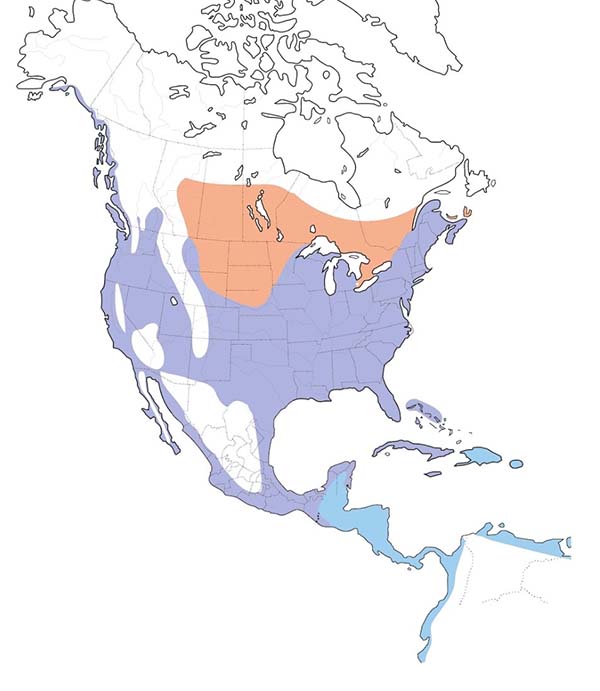
Sources:
- Great Blue Heron. Audubon. (2021, October 20). Retrieved December 15, 2021, from https://www.audubon.org/field-guide/bird/great-blue-heron

- Grid (counterclockwise):
- Male: Lucio 'Luc' Fazio / Macaulay Library at the Cornell Lab of Ornithology (ML239655251)
- Female: Michael Brower / Macaulay Library at the Cornell Lab of Ornithology (ML56671711)
- Juvenile: Nick Komar / Macaulay Library at the Cornell Lab of Ornithology (ML259438191)
- Nest/Eggs: Shirley Devan / Macaulay Library at the Cornell Lab of Ornithology (ML104234491)
- Range map provided by Birds of the World
Click here to lean more about Great Crested Flycatcher
Great Crested Flycatcher
Myiarchus crinitus
The Great Crested Flycatcher, a species that breeds in the forest and forest edges but is often difficult to see. You can recognize them by their loud call though: it sounds like a scream-squawk that carries through the woods. Their soft gray throats fade seamlessly into their lemony bellies, which nicely compliment their cinnamon tails.
In dense leafy forests of the east, the Great Crested Flycatcher lives within the canopy of tall trees in summer. This species is much more colorful than most flycatchers in the east. It nests in holes in trees, and it has the odd habit of adding pieces of shed snakeskin to its nest.
In dense leafy forests of the east, the Great Crested Flycatcher lives within the canopy of tall trees in summer. This species is much more colorful than most flycatchers in the east. It nests in holes in trees, and it has the odd habit of adding pieces of shed snakeskin to its nest.
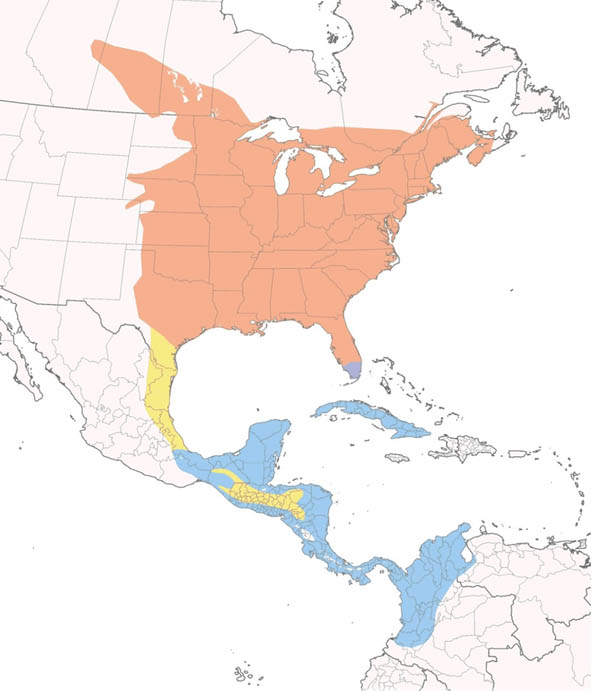
Sources:
- Great Crested Flycatcher. (2020, May 13). Audubon. https://www.audubon.org/field-guide/bird/great-crested-flycatcher
- Powdermill Nature Reserve, Carnegie Museum of Natural History
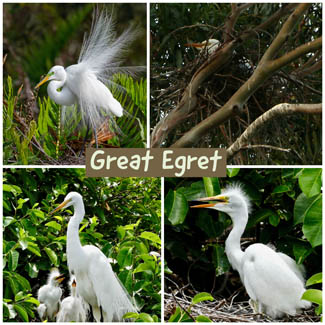
- Grid (counterclockwise):
- Male: Kyle Matera / Macaulay Library at the Cornell Lab of Ornithology (ML142987651)
- Female: Tom Shepard / Macaulay Library at the Cornell Lab of Ornithology (ML155936571)
- Juvenile: Tom Shepard /a> / Macaulay Library at the Cornell Lab of Ornithology (ML158331501)
- Nest/Eggs: Albert Linkowski / Macaulay Library at the Cornell Lab of Ornithology (ML26463731)
- Range map provided by Birds of the World
Click here to lean more about Great Egret
Great Egret
Ardea alba egretta
A tall, stately white wader of quiet waters. Common, especially in the south, it may wander far to the north in late summer. Nearly wiped out in the United States in the late 1800s, when its plumes were sought for use in fashion, the Great Egret made a comeback after early conservationists put a stop to the slaughter and protected its colonies; as a result, this bird became the symbol of the National Audubon Society.

Sources:
- Great egret. Audubon. (2021, October 20). Retrieved December 15, 2021, from https://www.audubon.org/field-guide/bird/great-egret

- Grid (counterclockwise):
- Male: Leslie S / Macaulay Library at the Cornell Lab of Ornithology (ML373754251)
- Female: Scott Olmstead / Macaulay Library at the Cornell Lab of Ornithology (ML340403731)
- Juvenile: Steve McInnis / Macaulay Library at the Cornell Lab of Ornithology (ML322946331)
- Nest/Eggs: Lisa Owens / Macaulay Library at the Cornell Lab of Ornithology (ML355319221)
- Range map provided by Birds of the World
Click here to lean more about Great Horned Owl
Great Horned Owl
Bubo virginianus
Found almost throughout North America and much of South America is this big owl. Aggressive and powerful in its hunting (sometimes known by nicknames such as 'tiger owl'), it takes prey as varied as rabbits, hawks, snakes, and even skunks, and will even attack porcupines, often with fatal results for both prey and predator. Great Horned Owls begin nesting very early in the north, and their deep hoots may be heard rolling across the forest on mid-winter nights. These tufts sometimes lend themselves to the owls’ names, like Great Horned Owl, Short-eared Owl, and Long-eared Owl. But these feather tufts are neither ears nor are they horns – they’re long feathers that serve as camouflage or as a communication tool (perhaps to signal to mate or to display in territorial disputes). These tufts aren’t even very close to owl ears, which are on the sides of the bird’s head and are asymmetrically situated. This asymmetry allows the owl to hear a sound at slightly different times which is an important characteristic that makes owls such effective nocturnal predators!

Sources:
- Great horned owl. Audubon. (2021, October 20). Retrieved December 15, 2021, from https://www.audubon.org/field-guide/bird/great-horned-owl
- Powdermill Nature Reserve, Carnegie Museum of Natural History
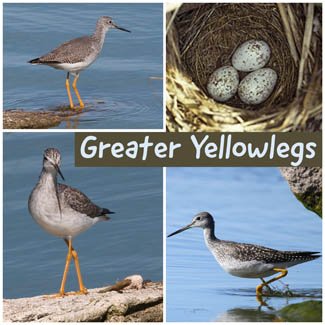
- Grid (counterclockwise):
- Male: sam hough / Macaulay Library at the Cornell Lab of Ornithology (ML38558471)
- Female: sam hough / Macaulay Library at the Cornell Lab of Ornithology (ML38558441)
- Juvenile: Tim Lenz / Macaulay Library at the Cornell Lab of Ornithology (ML270521261)
- Nest/Eggs: / Macaulay Library at the Cornell Lab of Ornithology
- Range map provided by Birds of the World
Click here to lean more about Greater Yellowlegs
Greater Yellowlegs
Tringa melanoleuca
At ponds and tidal creeks, this trim and elegant wader draws attention to itself by bobbing its head and calling loudly when an observer approaches. In migration, the Greater Yellowlegs are common from coast to coast. Sometimes it may annoy the birder by spooking the other shorebirds with its alarm calls; usually, it is a pleasure to watch as it feeds actively in the shallows, running about on trademark yellow legs.
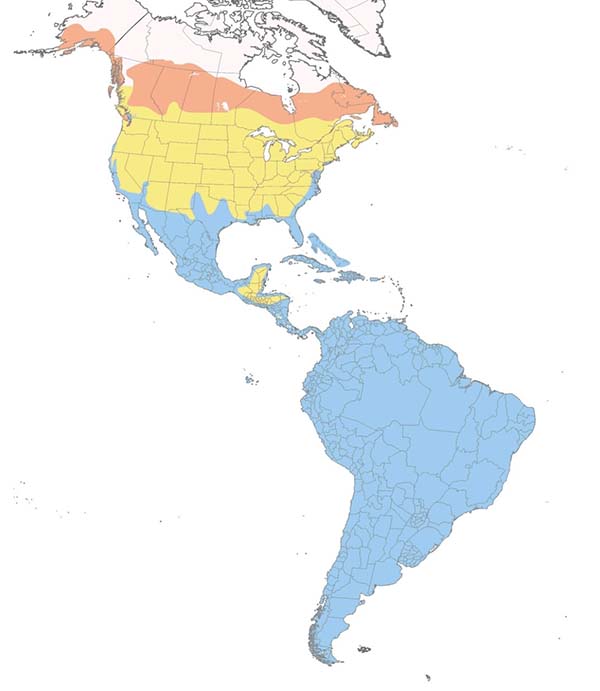
Sources:
- Greater Yellowlegs. Audubon. (2021, October 20). Retrieved December 15, 2021, from https://www.audubon.org/field-guide/bird/greater-yellowlegs
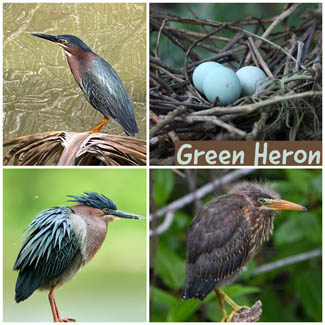
- Grid (counterclockwise):
- Male: Jorge A. Baez-Jimenez / Macaulay Library at the Cornell Lab of Ornithology (ML323505211)
- Female: Brennan Moore / Macaulay Library at the Cornell Lab of Ornithology (ML333118631)
- Juvenile: Thomas Galewski / Macaulay Library at the Cornell Lab of Ornithology (ML376034401)
- Nest/Eggs: Manfred Bienert / Macaulay Library at the Cornell Lab of Ornithology (ML228503721)
- Range map provided by Birds of the World
Click here to lean more about Green Heron
Green Heron
Butorides virescens
Along quiet streams or shaded riverbanks, a lone Green Heron may flush ahead of the observer, crying 'kyow' as it flies up the creek. This small heron is solitary at most seasons and often somewhat secretive, living around small bodies of water or densely vegetated areas. Seen in the open, it often flicks its tail nervously, raises and lowers its crest. The 'green' on this bird's back is an iridescent color and often looks dull bluish or simply dark.
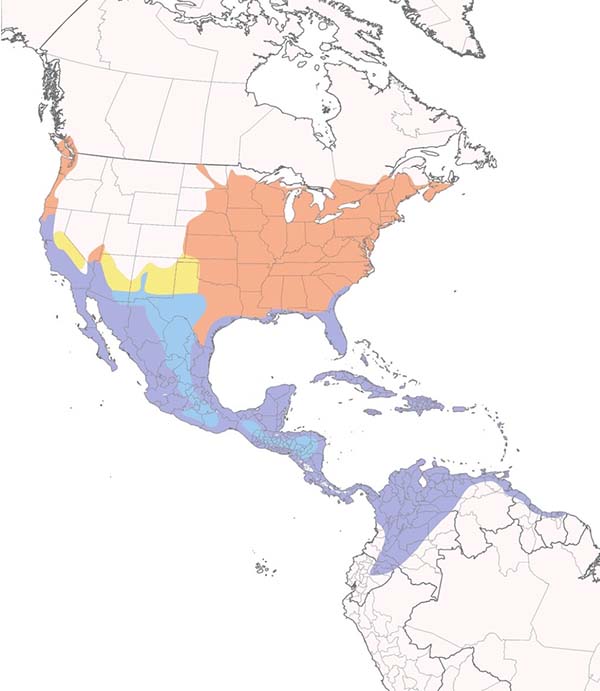
Sources:
- Green Heron. Audubon. (2021, October 20). Retrieved December 15, 2021, from https://www.audubon.org/field-guide/bird/green-heron
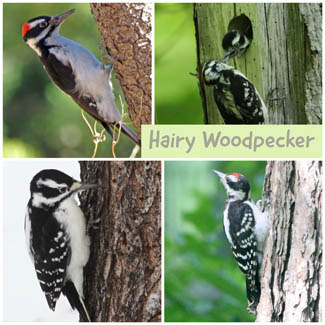
- Grid (counterclockwise):
- Male: Diane Drobka / Macaulay Library at the Cornell Lab of Ornithology (ML279572981)
- Female: Irene Crosland / Macaulay Library at the Cornell Lab of Ornithology (ML280745331)
- Juvenile: Dave Spier / Macaulay Library at the Cornell Lab of Ornithology (ML274110251)
- Nest/Eggs: valerie heemstra / Macaulay Library at the Cornell Lab of Ornithology (ML242254221)
- Range map provided by Birds of the World
Click here to lean more about Hairy Woodpecker
Hairy Woodpecker
Dryobates villosus
The Hairy Woodpecker gets its name from the long, thread-like white feathers that run down the middle of its black back. This species looks very much like the Downy Woodpecker but has a heftier bill. It is also larger, measuring 9 to 10 inches in length. This species and the Downy Woodpecker are remarkably similar in pattern, differing mainly in size and bill shape. They often occur together, but the Hairy, a larger bird, requires larger trees; it is usually less common, especially in the east, and less likely to show up in suburbs and city parks. In its feeding it does more pounding and excavating in trees than most smaller woodpeckers, consuming large numbers of wood-boring insects.
As befits its bigger size, the Hairy Woodpecker favors more extensive woods with larger trees; this species may even visit well-wooded suburban backyards and parks. This woodpecker can often be located by its explosive "peek" call — incongruously, a higher-pitched call than that of the smaller Downy Woodpecker.
As befits its bigger size, the Hairy Woodpecker favors more extensive woods with larger trees; this species may even visit well-wooded suburban backyards and parks. This woodpecker can often be located by its explosive "peek" call — incongruously, a higher-pitched call than that of the smaller Downy Woodpecker.
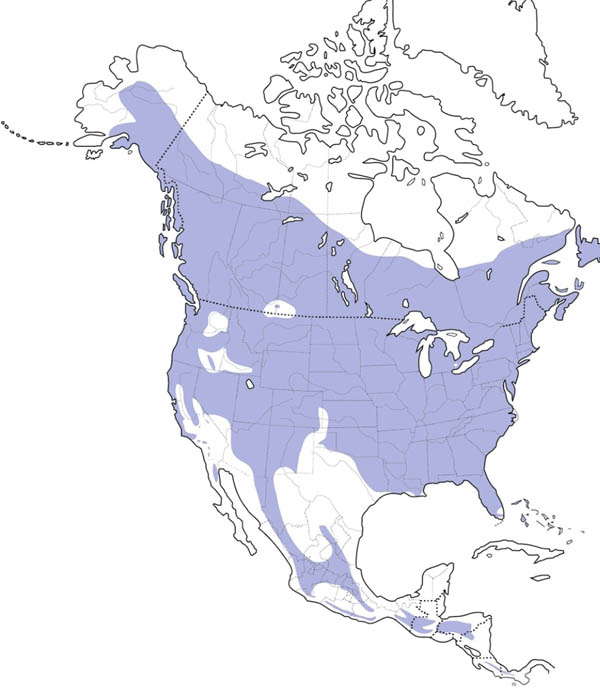
Sources:
- American Bird Conservancy. (2019, January 17). Hairy Woodpecker, Large Tree-Lover. https://abcbirds.org/bird/hairy-woodpecker/
- Hairy Woodpecker. (2019, December 05). Retrieved May 03, 2021, from https://www.audubon.org/field-guide/bird/hairy-woodpecker
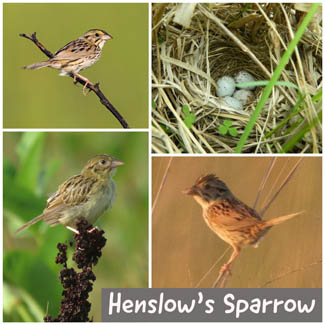
- Grid (counterclockwise):
- Male: Ryan Sanderson / Macaulay Library at the Cornell Lab of Ornithology (ML249203711)
- Female: Brian Collins / Macaulay Library at the Cornell Lab of Ornithology (ML31591111)
- Juvenile: Thomas Schultz / Macaulay Library at the Cornell Lab of Ornithology (ML171410101)
- Nest/Eggs: Carolyn Byers / Madison Audobon
- Range map provided by Birds of the World
Click here to lean more about Henslow's Sparrow
Henslow's Sparrow
Centronyx henslowii
The Henslow's Sparrow and its close relative, the Baird's Sparrow, are the only two sparrows in the genus Centronyx (meaning spurred claw). This name refers to these birds' long hind toes, a feature found in other ground-dwelling grassland birds such as the longspurs.
Although Henslow's Sparrows have a unique greenish-olive wash, and olive-green head and nape, it often remains unnoticed. This species takes flight only reluctantly, preferring to run through the grass when threats appear. The best way to find this bird is by listening for its very distinctive song, a quite abrupt "see-LICK" that sounds for all the world like an avian hiccup. Although males establishing territories sit within binocular range while singing this odd song, they often remain unseen. Henslow's Sparrows most often "hiccup" from deep within the brushy, grassy habitat the species favors. They are very persistent singers: males sometimes sing every few seconds, day, and night, around the clock. Deep in the night on a quiet prairie, these brief songs and insect noises will often be the only sounds.
Although Henslow's Sparrows have a unique greenish-olive wash, and olive-green head and nape, it often remains unnoticed. This species takes flight only reluctantly, preferring to run through the grass when threats appear. The best way to find this bird is by listening for its very distinctive song, a quite abrupt "see-LICK" that sounds for all the world like an avian hiccup. Although males establishing territories sit within binocular range while singing this odd song, they often remain unseen. Henslow's Sparrows most often "hiccup" from deep within the brushy, grassy habitat the species favors. They are very persistent singers: males sometimes sing every few seconds, day, and night, around the clock. Deep in the night on a quiet prairie, these brief songs and insect noises will often be the only sounds.
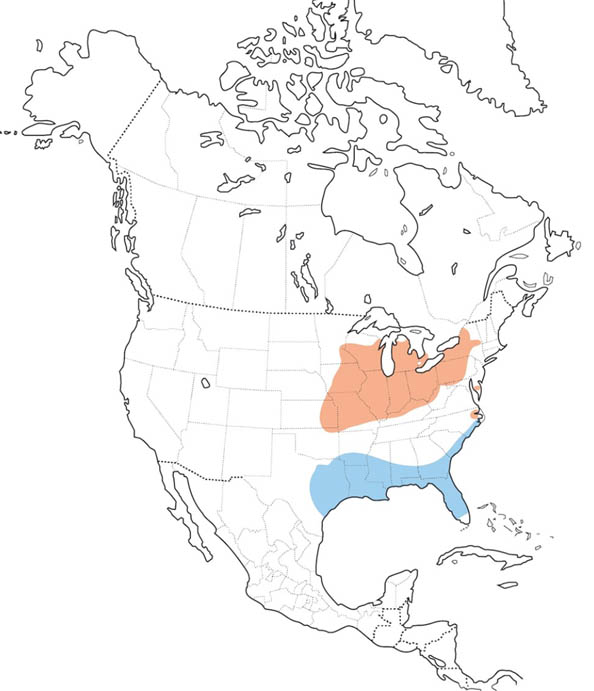
Sources:
- American Bird Conservancy. (2020i, November 16). Henslow's Sparrow. https://abcbirds.org/bird/henslows-sparrow/
- Powdermill Nature Reserve, Carnegie Museum of Natural History
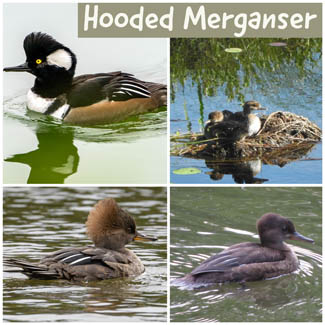
- Grid (counterclockwise):
- Male: Bob Gunderson / Macaulay Library at the Cornell Lab of Ornithology (ML369735531)
- Female: Frank King / Macaulay Library at the Cornell Lab of Ornithology (ML379746021)
- Juvenile: Kevin Seymour / Macaulay Library at the Cornell Lab of Ornithology (ML352450001)
- Nest/Eggs: Belinda Gallagher / Macaulay Library at the Cornell Lab of Ornithology (ML108214021)
- Range map provided by Birds of the World
Click here to lean more about Hooded Merganser
Hooded Merganser
Lophodytes cucullatus
Mergansers are our only ducks that specialize in eating fish. The Hooded is the smallest of our three native merganser species and often seems to be the least numerous, as it tends to live around swamps and wooded ponds where it may be overlooked. A cavity nester along wooded waterways in the temperate parts of North America, it has probably benefitted by taking advantage of nest boxes put out for Wood Ducks.
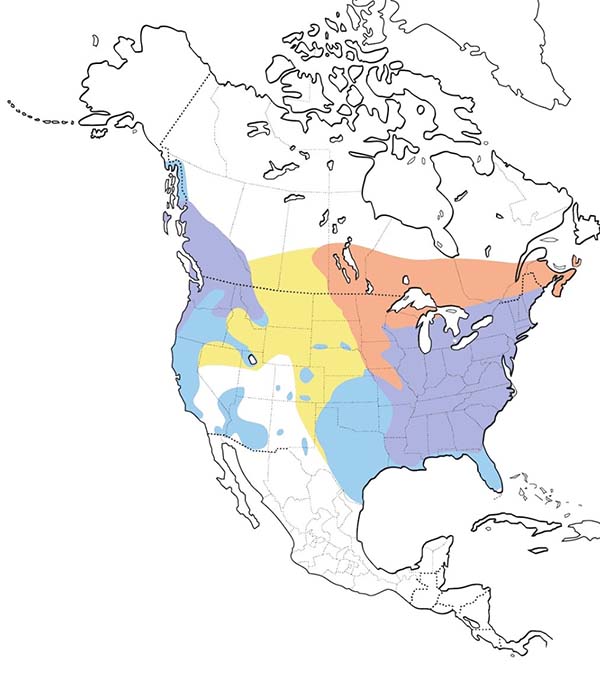
Sources:
- Hooded Merganser. Audubon. (2021, October 20). Retrieved December 15, 2021, from https://www.audubon.org/field-guide/bird/hooded-merganser
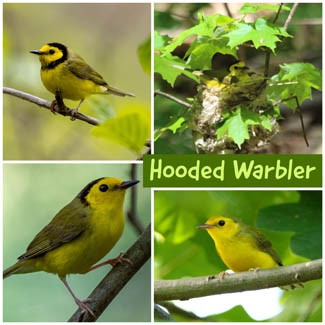
- Grid (counterclockwise):
- Male: Michael Stubblefield / Macaulay Library at the Cornell Lab of Ornithology (ML276869961)
- Female: Anthony Schmitt / Macaulay Library at the Cornell Lab of Ornithology (ML242905371)
- Juvenile: Lowell Burket / Macaulay Library at the Cornell Lab of Ornithology (ML173036591)
- Nest/Eggs: Marcie Jacklin / Macaulay Library at the Cornell Lab of Ornithology (ML29362561)
- Range map provided by Birds of the World
Click here to lean more about Hooded Warbler
Hooded Warbler
Setophaga citrina
The handsome Hooded Warbler has a name with roots in ecclesiastical lore. The male Hooded Warbler's black hood and throat make it look as if the bird is wearing a miter — the cowl-like hat worn by Catholic bishops. This cowled appearance gave rise to one of the Hooded Warbler's more common folk names, "Mitered" Warbler. Its Latin name, citrina, refers to the bird's golden-yellow color, which resembles the gemstone citrine.
Since they are nocturnal migrants, Hooded Warblers are often victims of deadly collisions with glass, towers, and wind turbines. This warbler is also vulnerable to forest fragmentation, which exposes both birds and their low-built nests to predators such as free-roaming cats, and to Brown-headed Cowbirds, which are brood parasites that lay their eggs in warbler nests.
The Hooded Warbler is territorial on its wintering grounds in the Caribbean, Mexico, and Central America, fiercely defending a defined feeding area against others of its species. Males and females use different habitats during the winter; males use mature forests and females frequent shrubby and flooded areas.
The namesake hood of this warbler is not exclusively for males. Older females often have black on the head. The female is yellow with a greenish head and back, and a bold black eye. She has white on her outer tail feathers. Interestingly, the females of Hooded Warblers can show a shadow of the black markings that define the males- Hooded females can have a dusky hood.
Since they are nocturnal migrants, Hooded Warblers are often victims of deadly collisions with glass, towers, and wind turbines. This warbler is also vulnerable to forest fragmentation, which exposes both birds and their low-built nests to predators such as free-roaming cats, and to Brown-headed Cowbirds, which are brood parasites that lay their eggs in warbler nests.
The Hooded Warbler is territorial on its wintering grounds in the Caribbean, Mexico, and Central America, fiercely defending a defined feeding area against others of its species. Males and females use different habitats during the winter; males use mature forests and females frequent shrubby and flooded areas.
The namesake hood of this warbler is not exclusively for males. Older females often have black on the head. The female is yellow with a greenish head and back, and a bold black eye. She has white on her outer tail feathers. Interestingly, the females of Hooded Warblers can show a shadow of the black markings that define the males- Hooded females can have a dusky hood.
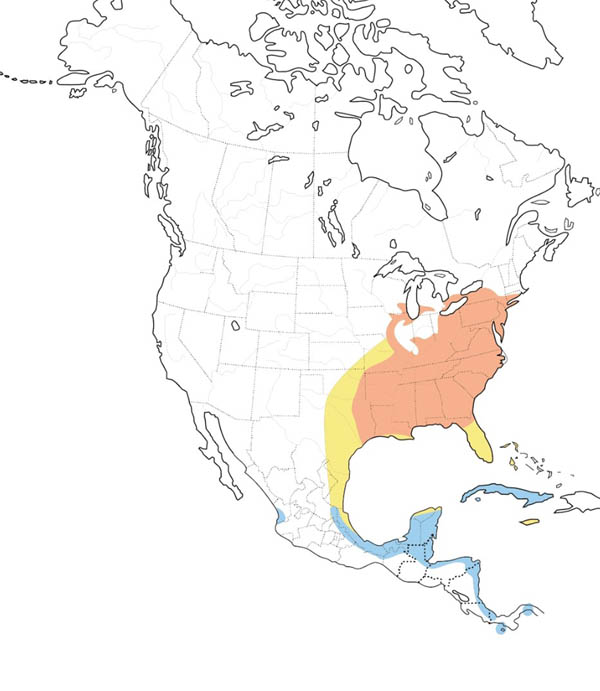
Sources:
- American Bird Conservancy. (2020a, June 10). Hooded Warbler. https://abcbirds.org/bird/hooded-warbler/
- Powdermill Nature Reserve, Carnegie Museum of Natural History
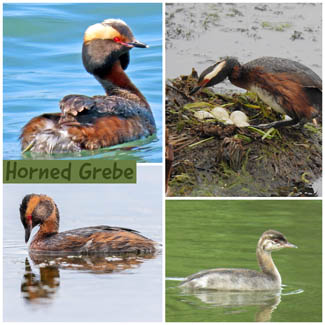
- Grid (counterclockwise):
- Male: Shilo McDonald / Macaulay Library at the Cornell Lab of Ornithology (ML242556371)
- Female: Stefan Hirsch / Macaulay Library at the Cornell Lab of Ornithology (ML172214121)
- Juvenile: David Scott / Macaulay Library at the Cornell Lab of Ornithology (ML256819831)
- Nest/Eggs: Chris Coxson / Macaulay Library at the Cornell Lab of Ornithology (ML196857781)
- Range map provided by Birds of the World
Click here to lean more about Horned Grebe
Horned Grebe
Podiceps auritus
This small diver is found mostly on northern marshes in summer and coastal bays in winter. Also widespread in Eurasia, there it is called the Slavonian Grebe. Like Eared Grebe, but much less gregarious, it seldom nests in colonies and seldom gathers in large flocks at other seasons. Like other grebes, it must patter across the water’s surface to become airborne; it may become trapped when waters freeze quickly overnight.
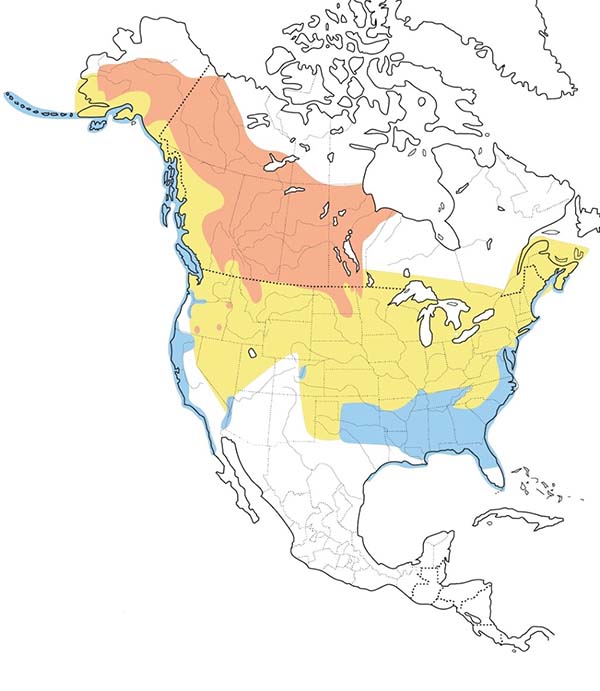
Sources:
- Horned Grebe. Audubon. (2021, October 20). Retrieved December 15, 2021, from https://www.audubon.org/field-guide/bird/horned-grebe

- Grid (counterclockwise):
- Male: Byron Stone / Macaulay Library at the Cornell Lab of Ornithology (ML224379661)
- Female: Jamie Simmons / Macaulay Library at the Cornell Lab of Ornithology (ML279231021)
- Juvenile: Brian Sullivan / Macaulay Library at the Cornell Lab of Ornithology (ML262848831)
- Nest/Eggs: Macaulay Library at the Cornell Lab of Ornithology (ML225115911)
- Range map provided by Birds of the World
Click here to lean more about Horned Lark
Horned Lark
Eremophila alpestris
Horned larks are widespread songbirds found across the northern hemisphere. They are mainly brown-gray above and pale below, with a striking black and yellow face pattern. Except for the central feathers, the tail is mostly black, contrasting with the paler body; this contrast is especially noticeable when the bird is in flight. In summer males have black "horns", which give these birds their American name. The namesake "horns" of the Horned Lark are visible only at close range. Male birds sport these little tufts of black feathers during the breeding season, at times raising or lowering them expressively.
The courtship flight of the male Horned Lark illustrates much of what we love about birds: beauty, song, and feats of athleticism humans can only dream of. Like Sprague's Pipit, the Horned Lark banks steeply and silently into the sky, ascending hundreds of feet above open fields. He fills the sky with a tinkling cascade of notes before plunging toward the ground in pursuit of the female's attention.
Horned Lark is the only native lark found in North America, although it is also found in northern areas of Europe, Asia, and Africa. Its scientific name, Eremophila alpestris, translates to "desert lover of the high mountains." The appellation refers to the bird's preferred breeding habitats in Eurasia: open grasslands and similar places above the tree line.
The courtship flight of the male Horned Lark illustrates much of what we love about birds: beauty, song, and feats of athleticism humans can only dream of. Like Sprague's Pipit, the Horned Lark banks steeply and silently into the sky, ascending hundreds of feet above open fields. He fills the sky with a tinkling cascade of notes before plunging toward the ground in pursuit of the female's attention.
Horned Lark is the only native lark found in North America, although it is also found in northern areas of Europe, Asia, and Africa. Its scientific name, Eremophila alpestris, translates to "desert lover of the high mountains." The appellation refers to the bird's preferred breeding habitats in Eurasia: open grasslands and similar places above the tree line.
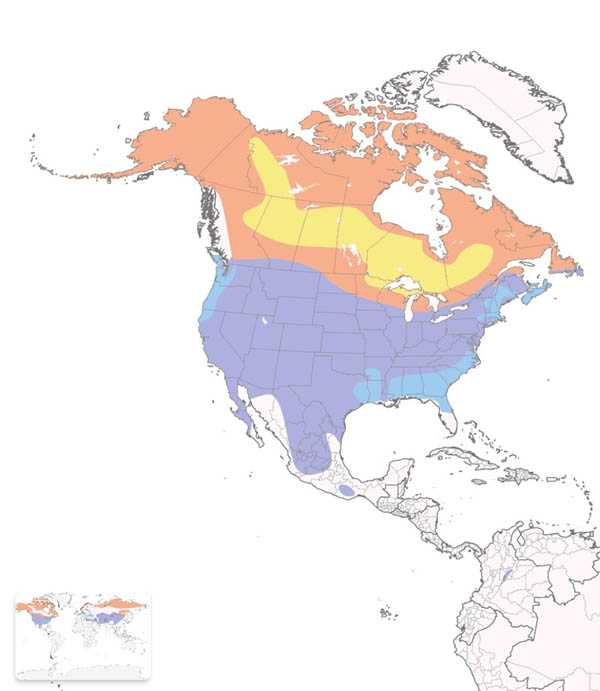
Sources:
- American Bird Conservancy. (2019b, October 29). Horned Lark. https://abcbirds.org/bird/horned-lark
- Horned lark. (2020). Retrieved May 03, 2021, from https://animalia.bio/horned-lark
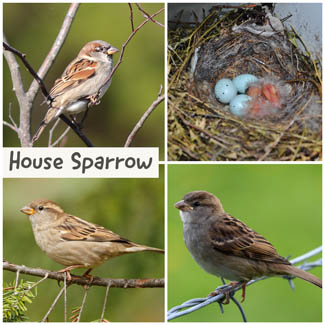
- Grid (counterclockwise):
- Male: Robert Mercer / Macaulay Library at the Cornell Lab of Ornithology (ML278498681)
- Female: Michael Brown / Macaulay Library at the Cornell Lab of Ornithology (ML281028391)
- Juvenile: A Emmerson / Macaulay Library at the Cornell Lab of Ornithology (ML268949671)
- Nest/Eggs: Anonymous eBirder / Macaulay Library at the Cornell Lab of Ornithology (ML79435391)
- Range map provided by Birds of the World
Click here to lean more about House Sparrow
House Sparrow
Passer domesticus
House Sparrows are an Old World Sparrow and are not in the same taxonomic group as western hemisphere sparrows. The males have a large yellow bill, black chin/throat badge, and bold white wing bar, whereas females are brown and nondescript except for a tannish stripe above the eye.
One of the most widespread and abundant songbirds in the world today, the House Sparrow has a simple success formula: it associates with humans. Native to Eurasia and northern Africa, it has succeeded in urban and farming areas all over the world -- including North America, where it was first released in New York in 1851. Tough, adaptable, aggressive, it survives on city sidewalks where few birds can make a living; in rural areas, it is an invasive species and often evicts native birds from their nests.
.
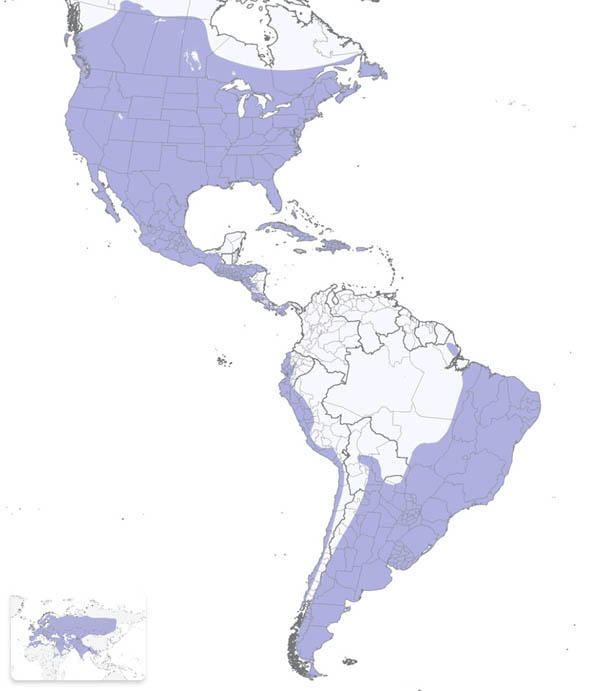
Sources:
- House Sparrow. (2019, December 9). Audubon.https://www.audubon.org/field-guide/bird/house-sparrow
- Powdermill Nature Reserve, Carnegie Museum of Natural History
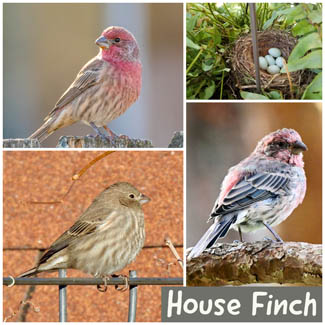
- Grid (counterclockwise):
- Male: Matt Saunders / Macaulay Library at the Cornell Lab of Ornithology (ML279413261)
- Female: Van Remsen / Macaulay Library at the Cornell Lab of Ornithology (ML280134811)
- Juvenile: Tom Shepard / Macaulay Library at the Cornell Lab of Ornithology (ML276178971)
- Nest/Eggs: Jennifer Shockley / Macaulay Library at the Cornell Lab of Ornithology (ML92424821)
- Range map provided by Birds of the World
Click here to lean more about House Finch
House Finch
Haemorhous mexicanus
Adaptable, colorful, and cheery-voiced, House Finches are common from coast to coast today, familiar visitors to backyard feeders. Native to the Southwest, they are recent arrivals in the East. New York pet shop owners, who had been selling the finches illegally, released their birds in 1940 to escape prosecution; the finches survived and began to colonize the New York suburbs. By 50 years later they had advanced halfway across the continent, meeting their western kin on the Great Plains.
Flocks of House Finches are common at bird feeders during the non-breeding season. Some flocks may stay together through the breeding season as well, and birds will use bird feeders year-round. They often forage on the ground, but also perch on weeds, shrubs, or trees. Both males and females may sing during the breeding season, and males sing year-round.
Most of the House Finch's diet is all vegetable matter--seeds, buds, berries, and nectar. They feed their young, regurgitated seeds. They eat a few small insects, especially aphids, but are primarily seed- and fruit-eaters at all times of the year.
Flocks of House Finches are common at bird feeders during the non-breeding season. Some flocks may stay together through the breeding season as well, and birds will use bird feeders year-round. They often forage on the ground, but also perch on weeds, shrubs, or trees. Both males and females may sing during the breeding season, and males sing year-round.
Most of the House Finch's diet is all vegetable matter--seeds, buds, berries, and nectar. They feed their young, regurgitated seeds. They eat a few small insects, especially aphids, but are primarily seed- and fruit-eaters at all times of the year.
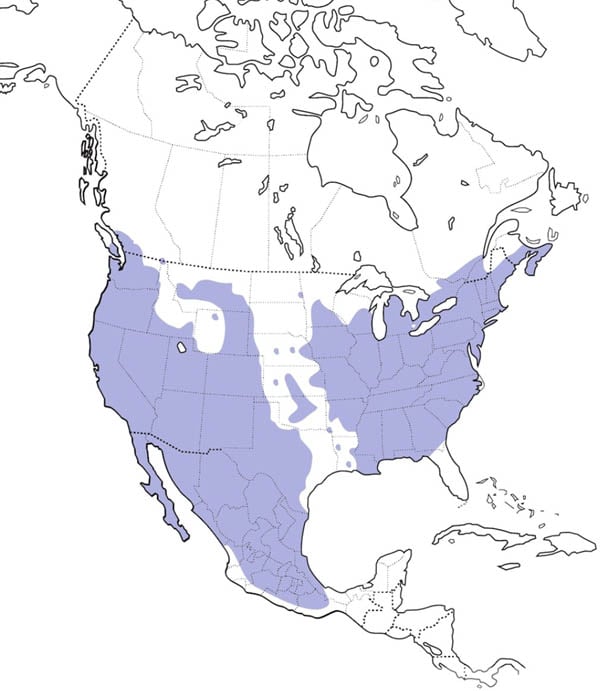
Sources:
- House Finch. (2019, December 9). Audubon. https://www.audubon.org/field-guide/bird/house-finch
- House Finch. (n.d.). Retrieved May 03, 2021, from http://birdweb.org/birdweb/bird/house_finch
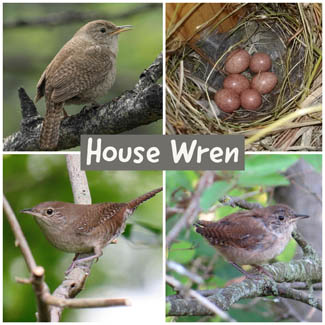
- Grid (counterclockwise):
- Male: Eric VanderWerf / Macaulay Library at the Cornell Lab of Ornithology (ML247163801)
- Female: Ken Hare / Macaulay Library at the Cornell Lab of Ornithology (ML267434831)
- Juvenile: Michael DeWispelaere / Macaulay Library at the Cornell Lab of Ornithology (ML261204591)
- Nest/Eggs: Joe Papp / Macaulay Library at the Cornell Lab of Ornithology (ML165187891)
- Range map provided by Birds of the World
Click here to lean more about House Wren
House Wren
Troglodytes aedon
A familiar backyard bird, the House Wren was named long ago for its tendency to nest around human homes or in birdhouses. Very active and inquisitive, bouncing about with its short tail held up in the air, pausing to sing a rich bubbling song, it adds a lively spark to gardens and city parks despite its lack of bright colors. Various forms of this wren are found from central Canada to southern South America.
The House Wren is a small, brown bird with few readily apparent field marks. It is slender and gray-brown, lighter in color overall, and with a longer tail than the Winter Wren. Its wings and tail are mottled, but its back and belly are clear.
The House Wren is a small, brown bird with few readily apparent field marks. It is slender and gray-brown, lighter in color overall, and with a longer tail than the Winter Wren. Its wings and tail are mottled, but its back and belly are clear.
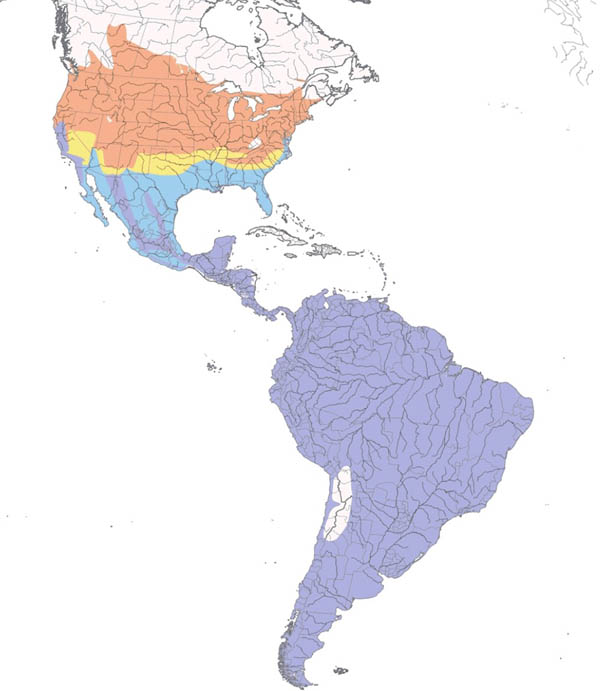
Sources:
- House Wren. (2019, December 10). Audubon. https://www.audubon.org/field-guide/bird/house-wren
- House Wren. (n.d.). Retrieved May 03, 2021, from http://www.birdweb.org/birdweb/bird/house_wren

- Grid (counterclockwise):
- Male: Sheila Bremer / Macaulay Library at the Cornell Lab of Ornithology (ML270209251)
- Female: Gary Mueller / Macaulay Library at the Cornell Lab of Ornithology (ML266563501)
- Juvenile: Eric D Gyllenhaal / Macaulay Library at the Cornell Lab of Ornithology (ML254860391)
- Nest/Eggs: Joshua Emm / Macaulay Library at the Cornell Lab of Ornithology (ML62598311)
- Range map provided by Birds of the World
Click here to lean more about Indigo Bunting
Indigo Bunting
Passerina cyanea
A male Indigo Bunting in breeding plumage is a symphony of shimmering blues, turquoises, and purples. But these beautiful colors are illusory: Like the iridescence of hummingbirds and the blue plumage of other species such as Eastern Bluebird, the male Indigo Bunting owes its glorious appearance to an optical trick — the diffraction of light through its feathers. In poor lighting, the bunting's glorious colors disappear, and it becomes a plain, dark-colored finch.
There are many blue-colored birds that breed in southwest Pennsylvania, but none draw the eye quite like Indigo Buntings. It is hard to look away when one of these rich, iridescent, deep blue birds perches at the tip of a shrub and shining in the sun, sings to let everyone know he's there. Indigo Buntings specialize in shrubby, transitional, or edge habitat and are common during the breeding season. They are seed eaters, so you might even see one visit a bird feeder!
But Indigo Buntings are more than a treat for the eyes — this species also helped reveal some important secrets about how birds migrate. Indigo Buntings played a central role in a series of orientation and navigation experiments conducted on migratory birds during the 1960s. Scientists placed caged buntings inside a planetarium, manipulated star patterns, and noted the directions the birds attempted to fly in response. The results proved that Indigo Buntings (and other nocturnal migrants) use the movement of the stars to navigate during migration.
There are many blue-colored birds that breed in southwest Pennsylvania, but none draw the eye quite like Indigo Buntings. It is hard to look away when one of these rich, iridescent, deep blue birds perches at the tip of a shrub and shining in the sun, sings to let everyone know he's there. Indigo Buntings specialize in shrubby, transitional, or edge habitat and are common during the breeding season. They are seed eaters, so you might even see one visit a bird feeder!
But Indigo Buntings are more than a treat for the eyes — this species also helped reveal some important secrets about how birds migrate. Indigo Buntings played a central role in a series of orientation and navigation experiments conducted on migratory birds during the 1960s. Scientists placed caged buntings inside a planetarium, manipulated star patterns, and noted the directions the birds attempted to fly in response. The results proved that Indigo Buntings (and other nocturnal migrants) use the movement of the stars to navigate during migration.
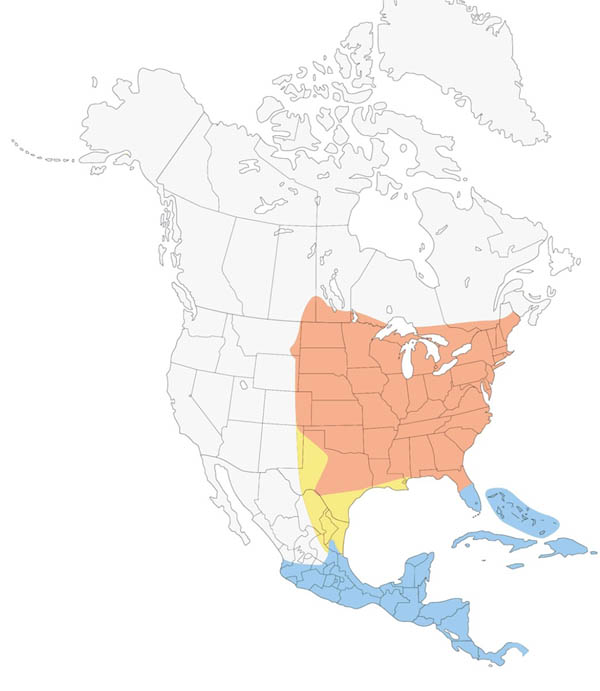
Sources:
- American Bird Conservancy. (2021, April 19). Indigo Bunting. https://abcbirds.org/bird/indigo-bunting/
- Powdermill Nature Reserve, Carnegie Museum of Natural History
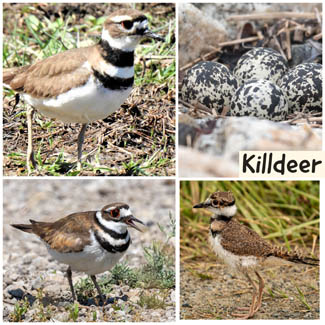
- Grid (counterclockwise):
- Male: Lucio 'Luc' Fazio / Macaulay Library at the Cornell Lab of Ornithology (ML326417201)
- Female: Iris Kilpatrick / Macaulay Library at the Cornell Lab of Ornithology (ML348989771)
- Juvenile: Nova Scotia Bird Records / Macaulay Library at the Cornell Lab of Ornithology (ML360633481)
- Nest/Eggs: David Turgeon / Macaulay Library at the Cornell Lab of Ornithology (ML352377421)
- Range map provided by Birds of the World
Click here to lean more about Killdeer
Killdeer
Charadrius vociferus
Widespread, common, and conspicuous, the Killdeer calls its name as it flies over farmland and other open country. Like other members of the plover family, this species is often found at the water's edge, but it also lives in pastures and fields far from water. At times, it nests on gravel roofs or lawns. Many a person has been fooled by the bird's 'broken-wing' act, in which it flutters along the ground in a show of injury, luring intruders away from its nest.
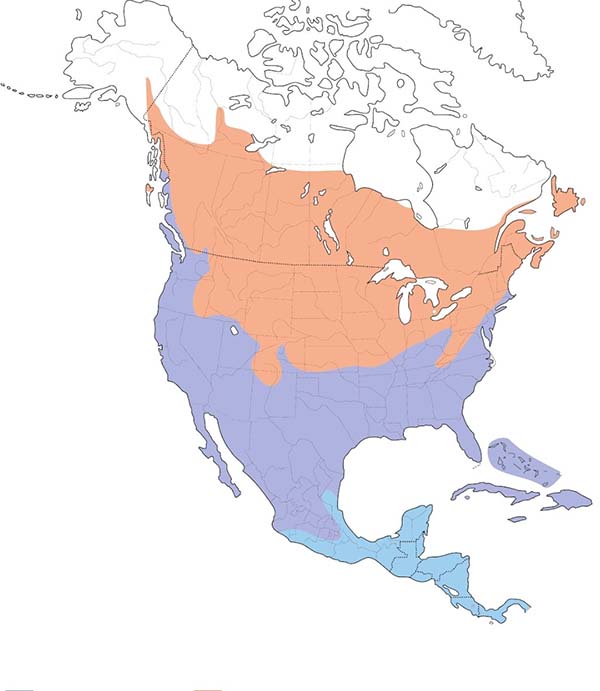
Sources:
- Killdeer. Audubon. (2021, October 23). Retrieved December 15, 2021, from https://www.audubon.org/field-guide/bird/killdeer
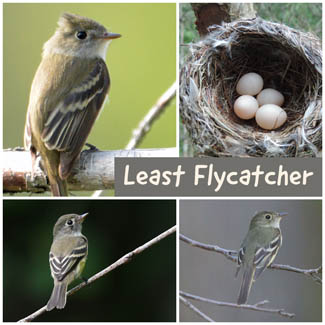
- Grid (counterclockwise):
- Male: Michael J Good / Macaulay Library at the Cornell Lab of Ornithology (ML242373021)
- Female: Delaney Kempf / Macaulay Library at the Cornell Lab of Ornithology (ML169399651)
- Juvenile: Deborah Kral / Macaulay Library at the Cornell Lab of Ornithology (ML258746391)
- Nest/Eggs: John McKay / Macaulay Library at the Cornell Lab of Ornithology (ML46021201)
- Range map provided by Birds of the World
Click here to lean more about Least Flycatcher
Least Flycatcher
Empidonax minimus
The eleven Empidonax flycatchers in North America are notorious for causing trouble for birders. All are small birds with wing-bars and eye-rings, and most are very hard to tell apart. The Least Flycatcher is the smallest and grayest of this group in the east, and it is often common near woodland edges, where it perches in the open and raps out its snappy song, chebeck! This bird breeds nearby at higher elevations.
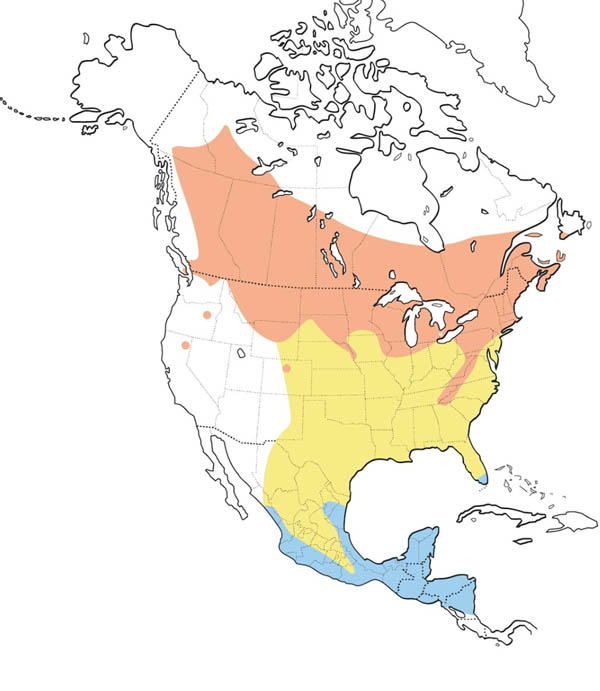
Sources:
- Least Flycatcher. (2019, December 23). Audubon. https://www.audubon.org/field-guide/bird/least-flycatcher
- Powdermill Nature Reserve, Carnegie Museum of Natural History
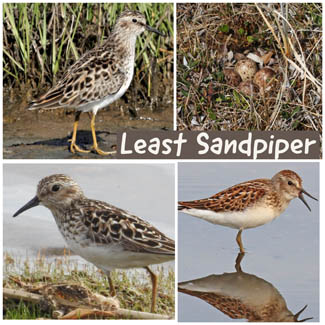
- Grid (counterclockwise):
- Male: Jim Stasz / Macaulay Library at the Cornell Lab of Ornithology (ML357781921)
- Female: Roy Lambert / Macaulay Library at the Cornell Lab of Ornithology (ML29149891)
- Juvenile: Corey Finger / Macaulay Library at the Cornell Lab of Ornithology (ML365549751)
- Nest/Eggs: Mike V.A. Burrell / Macaulay Library at the Cornell Lab of Ornithology (ML35221301)
- Range map provided by Birds of the World
Click here to lean more about Least Sandpiper
Least Sandpiper
Calidris minutilla
The smallest member of the sandpiper family, no bigger than a sparrow. This is the sandpiper most likely to be seen on small bodies of water inland. On sandy riverbanks, lakeshores, and edges of sewage treatment ponds, little flocks of Least Sandpipers fly up to circle the area and then settle again, giving thin, reedy cries as they go. On the outer coast, outnumbered by bigger shorebirds, they seek out sheltered places on the muddy edges of the marsh.
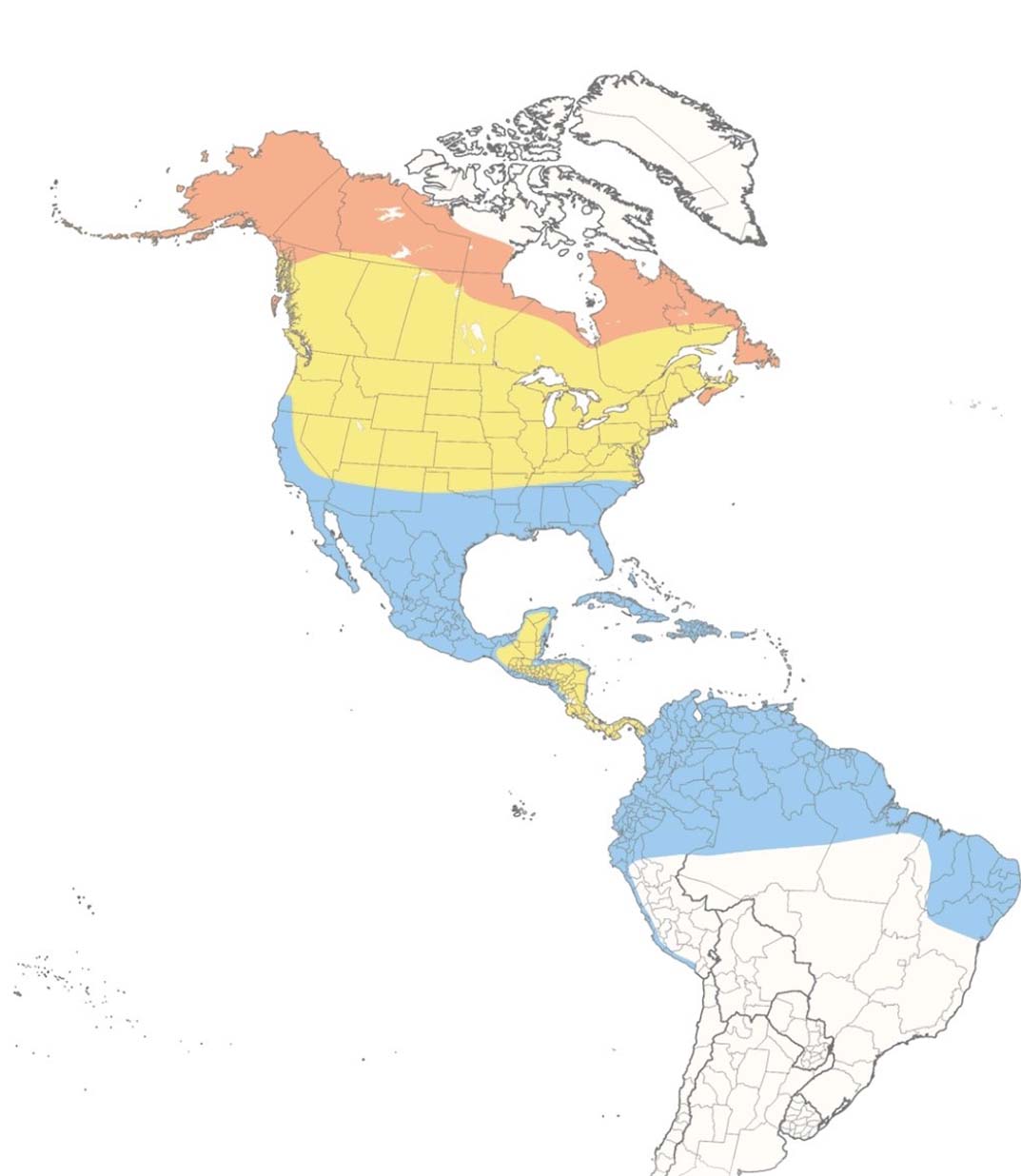
Sources:
- Least sandpiper. Audubon. (2021, October 20). Retrieved December 15, 2021, from https://www.audubon.org/field-guide/bird/least-sandpiper
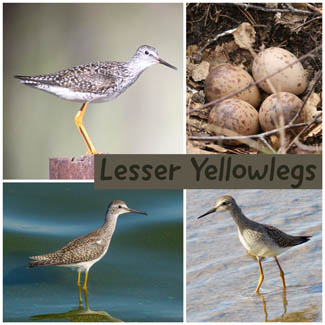
- Grid (counterclockwise):
- Male: Cameron Eckert / Macaulay Library at the Cornell Lab of Ornithology (ML100759001)
- Female: Mike Austin / Macaulay Library at the Cornell Lab of Ornithology (ML357807841)
- Juvenile: Petra Clayton / Macaulay Library at the Cornell Lab of Ornithology (ML358165131)
- Nest/Eggs: / Macaulay Library at the Cornell Lab of Ornithology
- Range map provided by Birds of the World
Click here to lean more about Lesser Yellowlegs
Lesser Yellowlegs
Tringa flavipes
At first glance, the two species of yellowlegs look identical except for size, as if they were put on earth only to confuse birdwatchers. With better acquaintance, they turn out to have different personalities. The Lesser is often at smaller ponds, often present in larger flocks, and often seems rather tame. Perhaps a more delicate bird (as it appears to be), it does not winter as far north as the Greater Yellowlegs.
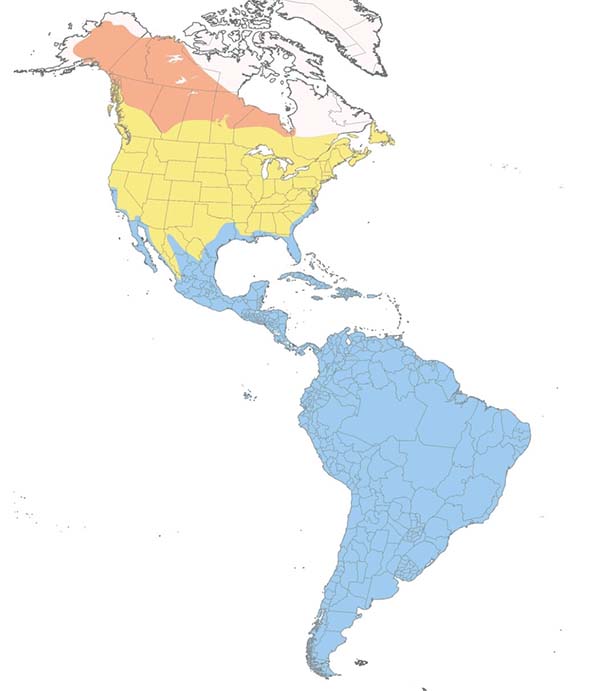
Sources:
- Lesser yellowlegs. Audubon. (2021, October 20). Retrieved December 15, 2021, from https://www.audubon.org/field-guide/bird/lesser-yellowlegs

- Grid (counterclockwise):
- Male: Will Johnson / Macaulay Library at the Cornell Lab of Ornithology (ML365598501)
- Female: James Wheat / Macaulay Library at the Cornell Lab of Ornithology (ML374179101)
- Juvenile: Lyall Bouchard / Macaulay Library at the Cornell Lab of Ornithology (ML363939671)
- Nest/Eggs: Glenn Koppel / Macaulay Library at the Cornell Lab of Ornithology (ML106818951)
- Range map provided by Birds of the World
Click here to lean more about Magnolia Warbler
Magnolia Warbler
Setophaga magnolia
Although it is small and very active, the Magnolia Warbler is not as difficult to observe as some warblers, because it often stays low in shrubbery and short trees. It favors second-growth habitats both summer (in the north woods) and winter (in the tropics), so it has not been hurt by habitat destruction as much as some migrants. Named by chance since pioneer ornithologist Alexander Wilson happened to spot his first one in a southern magnolia tree during migration.
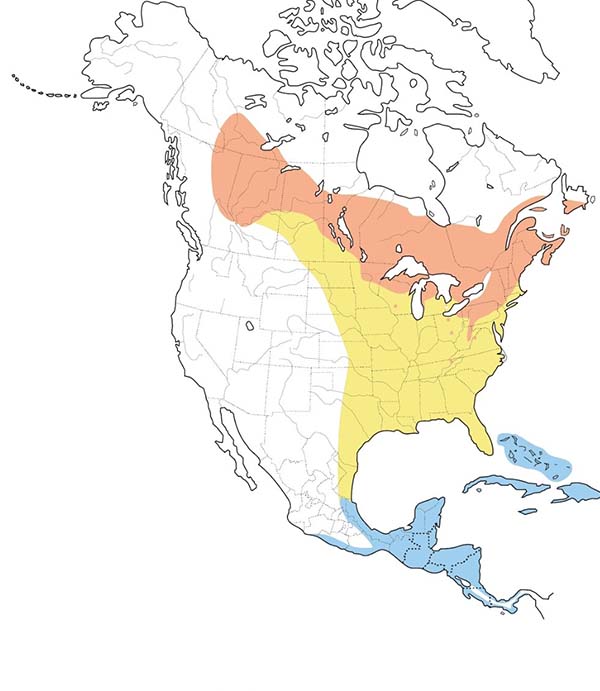
Sources:
- Magnolia warbler. Audubon. (2021, October 20). Retrieved December 15, 2021, from https://www.audubon.org/field-guide/bird/magnolia-warbler
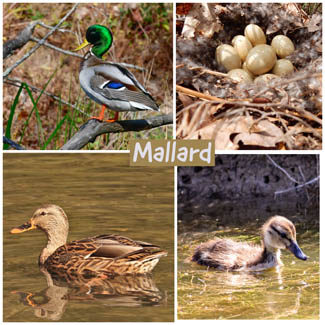
- Grid (counterclockwise):
- Male: Anonymous / Macaulay Library at the Cornell Lab of Ornithology (ML382471441)
- Female: Clayton Fitzgerald / Macaulay Library at the Cornell Lab of Ornithology (ML382043711)
- Juvenile: David Hird / Macaulay Library at the Cornell Lab of Ornithology (ML378948711)
- Nest/Eggs: Alain Gagné / Macaulay Library at the Cornell Lab of Ornithology (ML382096321)
- Range map provided by Birds of the World
Click here to lean more about Mallard
Mallard
Anas platyrhynchos
Abundant over most of the northern hemisphere, the Mallard is the most familiar wild duck to many people and the ancestor of most strains of domesticated ducks. In many places this species has managed to domesticate itself, relying on handouts in city parks. Although barnyard and feral ducks may be dumpy and ungainly creatures, the ancestral wild Mallard is a trim, elegant, wary, fast-flying bird.
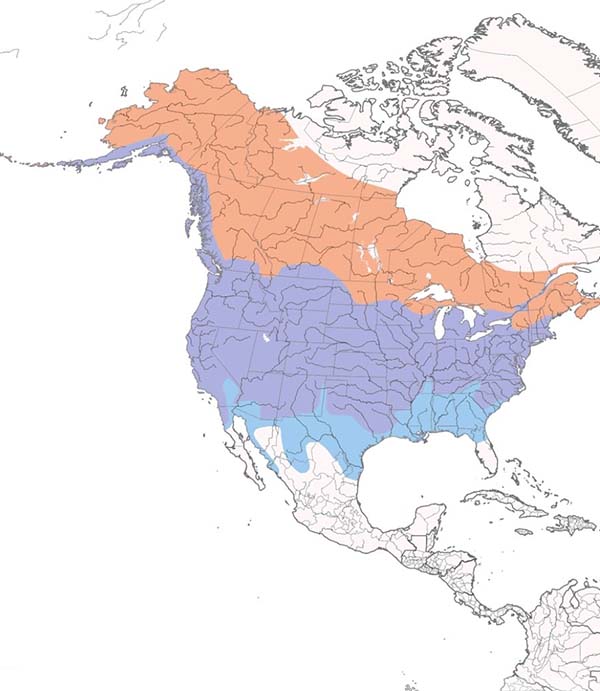
Sources:
- Mallard. Audubon. (2021, October 20). Retrieved December 15, 2021, from https://www.audubon.org/field-guide/bird/mallard
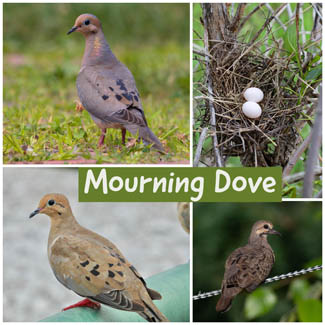
- Grid (counterclockwise):
- Male: Alex Mann / Macaulay Library at the Cornell Lab of Ornithology (ML375391631)
- Female: Van Remsen / Macaulay Library at the Cornell Lab of Ornithology (ML370515771)
- Juvenile: Zealon Wight-Maier / Macaulay Library at the Cornell Lab of Ornithology (ML367141841)
- Nest/Eggs: Kristof Zyskowski / Macaulay Library at the Cornell Lab of Ornithology (ML297445321)
- Range map provided by Birds of the World
Click here to lean more about Mourning Dove
Mourning Dove
Zenaida macroura
The mournful cooing of the Mourning Dove is one of our most familiar bird sounds. From southern Canada to central Mexico, this is one of our most common birds, often abundant in open country and along roadsides. European settlement of the continent, with its opening of the forest, probably helped this species to increase. It also helps itself, by breeding prolifically: in warm climates, Mourning Doves may raise as many as six broods per year, more than any other native bird. This species is common in southwestern Pennsylvania year-round.
Females have a bit less color: they have brown heads and only a hint of pink on the breast and neck, whereas males have a blue-gray head, more noticeable pinkish wash to the breast, and bigger iridescent pink patches on the sides of the neck. These pink patches shine in the right light, just like hummingbird gorgets!
Females have a bit less color: they have brown heads and only a hint of pink on the breast and neck, whereas males have a blue-gray head, more noticeable pinkish wash to the breast, and bigger iridescent pink patches on the sides of the neck. These pink patches shine in the right light, just like hummingbird gorgets!
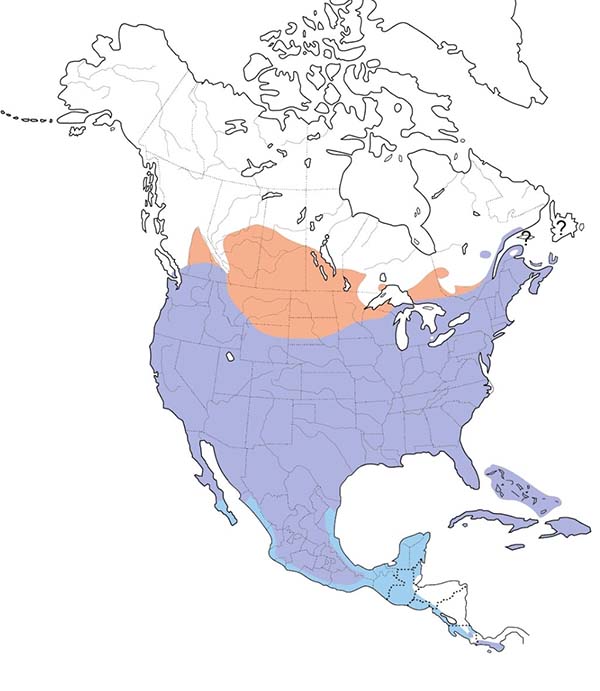
Sources:
- Mourning dove. Audubon. (2021, October 20). Retrieved December 15, 2021, from https://www.audubon.org/field-guide/bird/mourning-dove
- Powdermill Nature Reserve, Carnegie Museum of Natural History
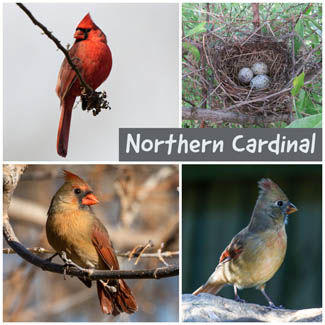
- Grid (counterclockwise):
- Male: Joel Marcinik / Macaulay Library at the Cornell Lab of Ornithology (ML280107121)
- Female: Suzanne Labbé / Macaulay Library at the Cornell Lab of Ornithology (ML278946981)
- Juvenile: Mary Barritt / Macaulay Library at the Cornell Lab of Ornithology (ML269780801)
- Nest/Eggs: Jon Little / Macaulay Library at the Cornell Lab of Ornithology (ML59432331)
- Range map provided by Birds of the World
Click here to lean more about Northern Cardinal
Northern Cardinal
Cardinalis cardinalis
Few birds are so familiar and well-loved as the Northern Cardinal. The male "Redbird" is unmistakable, with a distinctive crest and vivid red plumage. The female's plumage of brown with red accents is more subdued, but she sings just as beautifully as her mate. Abundant in the Southeast, it has been extending its range northward for decades, and it now brightens winter days with its color and its whistled song as far north as southeastern Canada. Feeders stocked with sunflower seeds may have aided its northward spread. West of the Great Plains, the Cardinal is mostly absent, but it is locally common in the desert Southwest.
The cardinal is a popular motif on many bird-themed decorations, holiday cards, and ornaments. It even features as a main character in a popular video game-turned-movie. The species' eye-catching plumage and wide distribution also helped land the Northern Cardinal the title of "most popular state bird," since the following seven states declare it the official bird (the most for any species): Illinois, Indiana, Kentucky, North Carolina, Ohio, Virginia, and West Virginia. It is also a popular sports mascot, from Missouri (the St. Louis professional baseball team) to Arizona (professional football team), and at countless colleges and high schools.
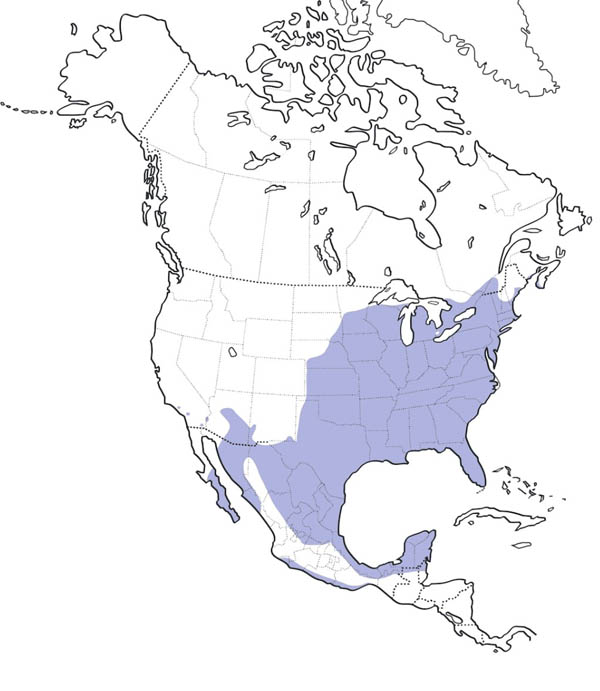
Sources:
- American Bird Conservancy. (2021b, April 9). Northern Cardinal. https://abcbirds.org/bird/northern-cardinal/
- Northern cardinal. (2020, March 24). Retrieved May 03, 2021, from https://www.audubon.org/field-guide/bird/northern-cardinal

- Grid (counterclockwise):
- Male: Cole Wolf / Macaulay Library at the Cornell Lab of Ornithology (ML279999481)
- Female: Karen Lebing / Macaulay Library at the Cornell Lab of Ornithology (ML278349881)
- Juvenile: Jim St Laurent / Macaulay Library at the Cornell Lab of Ornithology (ML262582941)
- Nest/Eggs: Terry Rich / Macaulay Library at the Cornell Lab of Ornithology (ML251898331)
- Range map provided by Birds of the World
Click here to lean more about Northern Flicker
Northern Flicker
Colaptes auratus
The Northern Flicker is a standout, even in an unusual family of birds. This brownish-gray woodpecker, larger than an American Robin, has a black-barred back and is spangled below with black polka-dots. Easily recognized as it springs into flight, the flicker flashes a large white rump patch and gold-colored wing linings. These birds wear their hearts on their undertail coverts (feathers under the tail)! Notable field marks for this bird are a bright flash of yellow on the underside of their wings and tail, a white rump, a black bib, and a red triangle on the nape. Only males sport the black malar (mustache).
The Northern Flicker is as noisy as it is flashy, so it is no surprise that over the years, it earned a host of folk names, including yellowhammer, harry-wicket, wick-up, and yarrup.
The tongues of most woodpeckers are adapted to spear and extract insects from wood, but the flicker's tongue is a bit different — in ways advantageous for lapping up large numbers of ants. While they are a part of the woodpecker family, they use their strong beaks to extract ants, beetles, and other insects from the ground rather than pecking out insects from under tree bark. All woodpeckers have an elongated tongue. The Northern Flicker has an extra-long tongue that can extend up to two inches past the tip of its beak. It is the perfect tool for probing into anthills.
During mating season, males put on a head-bobbing spectacle where opponents face each other, beaks pointed to the sky, and draw loops at each other.
The Northern Flicker is as noisy as it is flashy, so it is no surprise that over the years, it earned a host of folk names, including yellowhammer, harry-wicket, wick-up, and yarrup.
The tongues of most woodpeckers are adapted to spear and extract insects from wood, but the flicker's tongue is a bit different — in ways advantageous for lapping up large numbers of ants. While they are a part of the woodpecker family, they use their strong beaks to extract ants, beetles, and other insects from the ground rather than pecking out insects from under tree bark. All woodpeckers have an elongated tongue. The Northern Flicker has an extra-long tongue that can extend up to two inches past the tip of its beak. It is the perfect tool for probing into anthills.
During mating season, males put on a head-bobbing spectacle where opponents face each other, beaks pointed to the sky, and draw loops at each other.

Sources:
- American Bird Conservancy. (2020e, September 25). Northern Flicker. https://abcbirds.org/bird/northern-flicker/
- Powdermill Nature Reserve, Carnegie Museum of Natural History
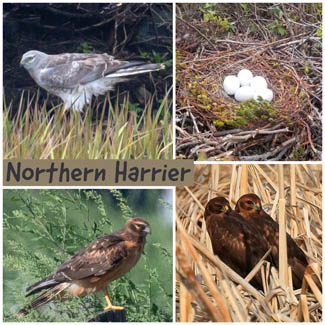
- Grid (counterclockwise):
- Male: Frank King / Macaulay Library at the Cornell Lab of Ornithology (ML341582631)
- Female: Barry Mars / Macaulay Library at the Cornell Lab of Ornithology (ML366432311)
- Juvenile: Dave Kreft / Macaulay Library at the Cornell Lab of Ornithology (ML362832201)
- Nest/Eggs: Lucas Berrigan / Macaulay Library at the Cornell Lab of Ornithology (ML304443441)
- Range map provided by Birds of the World
Click here to lean more about Northern Harrier
Northern Harrier
Circus hudsonius
Parts of Europe and Asia have several kinds of harriers, but North America has only one. Harriers are very distinctive hawks, long-winged and long-tailed, usually seen quartering low over the ground in open country. At close range, the face of our Northern Harrier looks rather like that of an owl; like an owl (and unlike most other hawks) it may rely on its keen hearing to help it locate prey as it courses low over the fields.
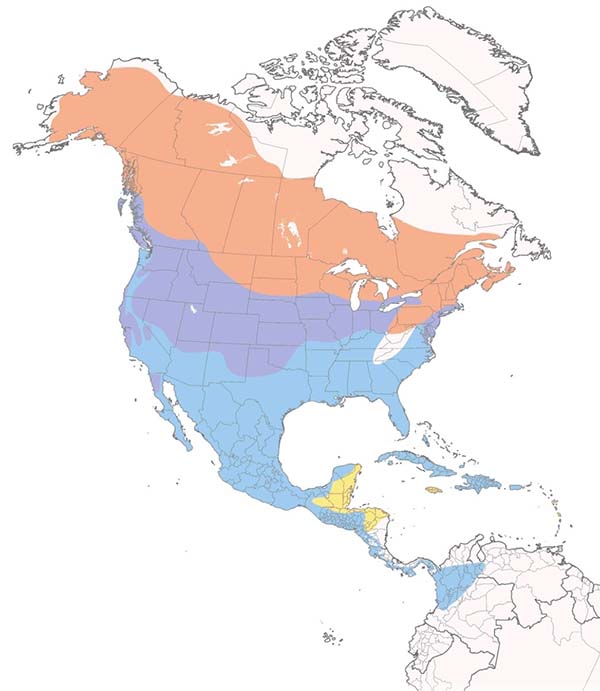
Sources:
- Northern harrier. Audubon. (2021, October 20). Retrieved December 15, 2021, from https://www.audubon.org/field-guide/bird/northern-harrier
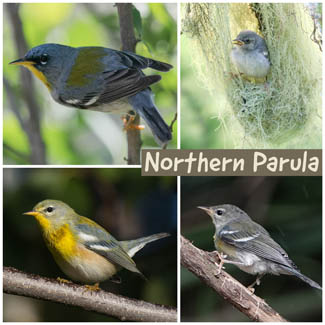
- Grid (counterclockwise):
- Male: Cynthia King / Macaulay Library at the Cornell Lab of Ornithology (ML374441551)
- Female: Lyall Bouchard / Macaulay Library at the Cornell Lab of Ornithology (ML363939411)
- Juvenile: Jane Mann / Macaulay Library at the Cornell Lab of Ornithology (ML333088551)
- Nest/Eggs: Aaron Marshall / Macaulay Library at the Cornell Lab of Ornithology (ML362184081)
- Range map provided by Birds of the World
Click here to lean more about Northern Parula
Northern Parula
Setophaga americana
This small warbler is often hard to see as it forages in the dense foliage of the treetops. However, it is easy to hear; the male seems to repeat his buzzy trickle-up song constantly from early spring through mid-summer at least. Northern Parulas hide their nests inside hanging Spanish moss in the South, or the similar Usnea lichens in the North, where they are impossible to spot except by the actions of the parent birds.
Northern Parulas are a species of wood warbler that, despite breeding across much of Pennsylvania, look a bit exotic. This small, less-than-10-gram songbird can be found in the summer months in mature forests singing their buzzy song, and during migration seasons flitting between branches as they search for insects to fuel their next migratory flight!
Northern Parulas are a species of wood warbler that, despite breeding across much of Pennsylvania, look a bit exotic. This small, less-than-10-gram songbird can be found in the summer months in mature forests singing their buzzy song, and during migration seasons flitting between branches as they search for insects to fuel their next migratory flight!
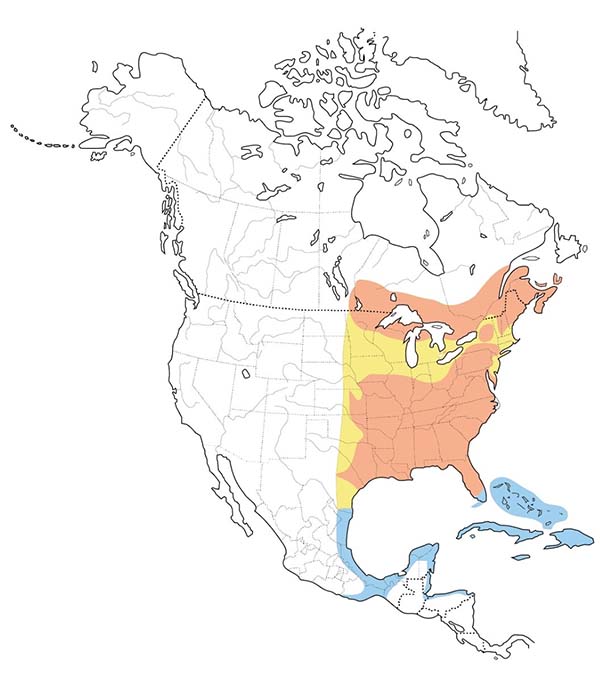
Sources:
- Northern parula. Audubon. (2021, October 20). Retrieved December 15, 2021, from https://www.audubon.org/field-guide/bird/northern-parula
- Powdermill Nature Reserve, Carnegie Museum of Natural History
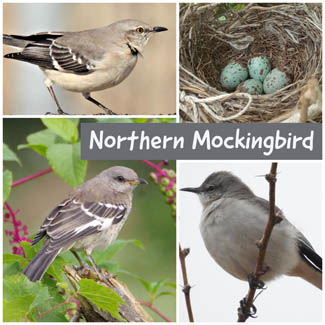
- Grid (counterclockwise):
- Male: Lucio 'Luc' Fazio / Macaulay Library at the Cornell Lab of Ornithology (ML224944771)
- Female: Roy Lambert / Macaulay Library at the Cornell Lab of Ornithology (ML133878461)
- Juvenile: Paul Heyde / Macaulay Library at the Cornell Lab of Ornithology (ML264011961)
- Nest/Eggs: Erik Johnson / Macaulay Library at the Cornell Lab of Ornithology (ML56435211)
- Range map provided by Birds of the World
Click here to lean more about Northern Mockingbird
Northern Mockingbird
Mimus polyglottos
The Northern Mockingbird is well-known for its powers of mimicry. Nicknamed the "American Nightingale," this remarkable species has been recorded as learning the songs and calls of hundreds of other birds, as well as musical instruments, car alarms, and many other sounds. Its scientific name, which means "many-tongued mimic," reflects this vocal prowess.
The Northern Mockingbird is the state bird of five states — Arkansas, Florida, Mississippi, Tennessee, and Texas — reflecting its original, mainly southeastern distribution plus its tendency to nest close to houses. It is featured in literature, most famously in To Kill a Mockingbird, Harper Lee's novel on race and the loss of innocence. Other southern writers such as Eudora Welty used the mockingbird as a motif in their works.
The Northern Mockingbird is the state bird of five states — Arkansas, Florida, Mississippi, Tennessee, and Texas — reflecting its original, mainly southeastern distribution plus its tendency to nest close to houses. It is featured in literature, most famously in To Kill a Mockingbird, Harper Lee's novel on race and the loss of innocence. Other southern writers such as Eudora Welty used the mockingbird as a motif in their works.
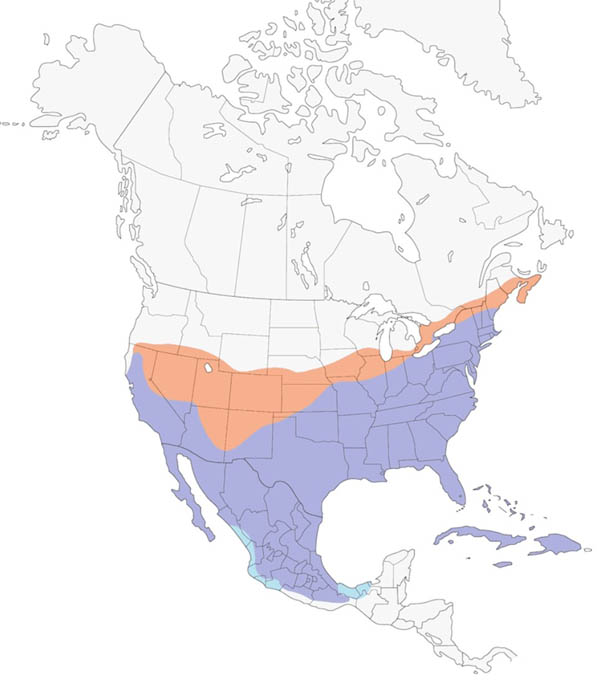
Sources:
- American Bird Conservancy. (2021a, January 15). Northern Mockingbird. https://abcbirds.org/bird/northern-mockingbird/
- Powdermill Nature Reserve, Carnegie Museum of Natural History
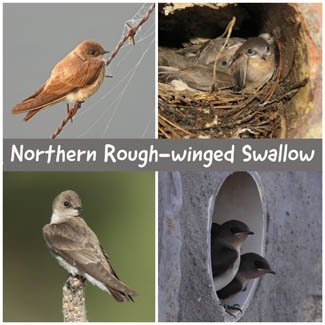
- Grid (counterclockwise):
- Male: James R. Hill, III / Macaulay Library at the Cornell Lab of Ornithology (ML166534681)
- Female: Robert Lewis / Macaulay Library at the Cornell Lab of Ornithology (ML261075991)
- Juvenile: Jules Teskie / Macaulay Library at the Cornell Lab of Ornithology (ML62618781)
- Nest/Eggs: Tom Johnson / Macaulay Library at the Cornell Lab of Ornithology (ML238710471)
- Range map provided by Birds of the World
Click here to lean more about Northern Rough-winged Swallow
Northern Rough-winged Swallow
Stelgidopteryx serripennis
Two kinds of brown-backed swallows nest in holes in dirt banks. The Rough-wing is the solitary one, not nesting in colonies. It is usually seen singly or in small groups, even during migration, in rapid low flight over rivers or fields. The name "Rough-winged" comes from small serrations on the outermost wing feathers. The function of these is unknown, but they may produce sounds during courtship flights.
The Northern Rough-winged Swallow is an aerial forager and feeds over water more than most swallows, sometimes plucking food from the water's surface. This swallow generally does not gather in large flocks like other swallows.
It breeds from southern Canada across the United States, and winters in southernmost Florida, and throughout Mexico and Central America. The Northern Rough-winged Swallow arrives in Tennessee in late March or early April, and the first individuals depart soon after the young fledge in mid-summer, with most leaving by late September.
Adults are uniformly plain brown above, with a white belly, and buffy throat and upper breast. They have square tails and white under-tail coverts. Juveniles are similar in appearance to adults but have reddish-brown wing-bars.
The Northern Rough-winged Swallow is an aerial forager and feeds over water more than most swallows, sometimes plucking food from the water's surface. This swallow generally does not gather in large flocks like other swallows.
It breeds from southern Canada across the United States, and winters in southernmost Florida, and throughout Mexico and Central America. The Northern Rough-winged Swallow arrives in Tennessee in late March or early April, and the first individuals depart soon after the young fledge in mid-summer, with most leaving by late September.
Adults are uniformly plain brown above, with a white belly, and buffy throat and upper breast. They have square tails and white under-tail coverts. Juveniles are similar in appearance to adults but have reddish-brown wing-bars.
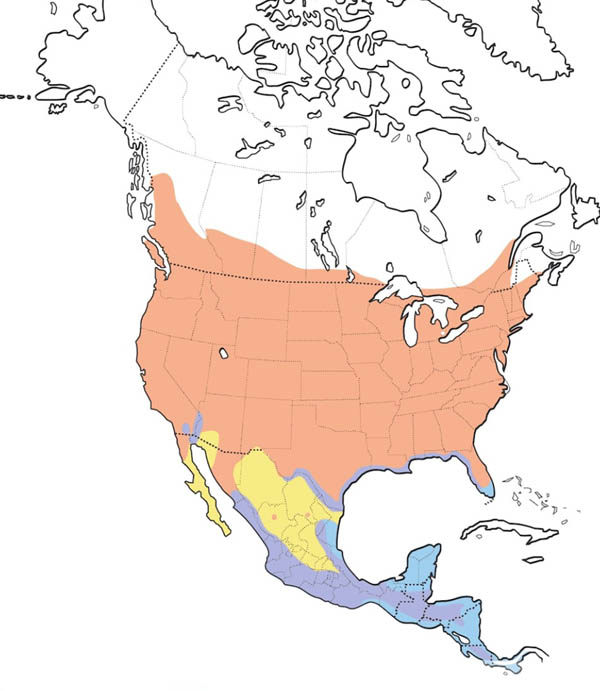
Sources:
- Northern Rough-winged Swallow. (2019, December 24). Audubon. https://www.audubon.org/field-guide/bird/northern-rough-winged-swallow
- Northern Rough-winged Swallow: State of TENNESSEE, Wildlife Resources Agency. (n.d.). Retrieved May 03, 2021, from https://www.tn.gov/twra/wildlife/birds/waterbirds/northern-rough-winged-swallow.html

- Grid (counterclockwise):
- Male: Logan Parker / Macaulay Library at the Cornell Lab of Ornithology (ML216618251)
- Female: Tyler Ficker / Macaulay Library at the Cornell Lab of Ornithology (ML107455591)
- Juvenile: Ken Simonite / Macaulay Library at the Cornell Lab of Ornithology (ML205823031)
- Nest/Eggs: Kristof Zyskowski / Macaulay Library at the Cornell Lab of Ornithology (ML183065791)
- Range map provided by Birds of the World
Click here to lean more about Northern Shrike
Northern Shrike
Lanius borealis
The Northern Shrike is the most abundant shrike seen in North America. It is known as the "butcher bird" because of its ferociousness when attacking its prey. It feeds on insects, amphibians, rodents, and small birds for most of the year. It nests in the far north on the tundra. It spends the summer in the far north, appearing in southern Canada and the lower 48 States only in winter. Solitary and wary, the shrike is likely to be seen perched at the top of a lone tree in an open field, watching for prey.
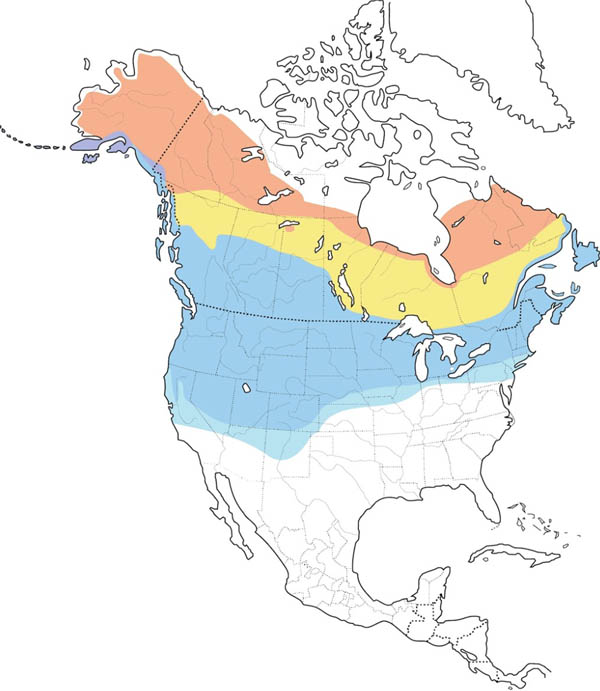
Sources:
- Northern Shrike. (2020, April 1). Audubon. https://www.audubon.org/field-guide/bird/northern-shrike
- Northern shrike (lanius borealis) - North American birds - birds of North America. (2020). Retrieved May 03, 2021, from https://www.birds-of-north-america.net/Northern_Shrike.html
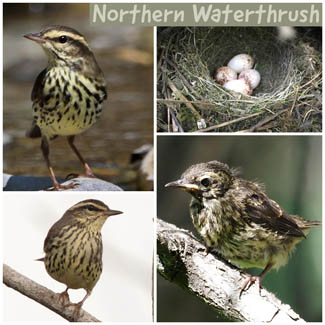
- Grid (counterclockwise):
- Male: Edgar Az / Macaulay Library at the Cornell Lab of Ornithology (ML381499091)
- Female: Jian Mei / Macaulay Library at the Cornell Lab of Ornithology (ML382407711)
- Juvenile: Donna Pomeroy / Macaulay Library at the Cornell Lab of Ornithology (ML351679651)
- Nest/Eggs: Arielle DeMerchant / Macaulay Library at the Cornell Lab of Ornithology (ML103217131)
- Range map provided by Birds of the World
Click here to lean more about Northern Waterthrush
Northern Waterthrush
Parkesia noveboracensis
The Northern Waterthrush is likely to be found around bogs and streams inside the forest. Often shy and hard to approach, it draws attention with its odd 'teetering' behavior -- bobbing the rear half of its body up and down constantly as it walks -- and with its loud metallic call note. It has a wide distribution in both summer (Alaska to New Jersey) and winter (Florida to South America).
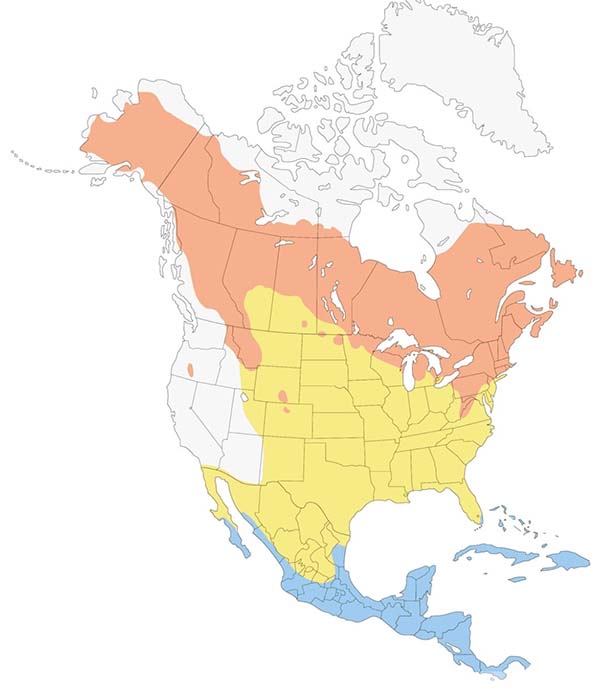
Sources:
- Northern waterthrush. Audubon. (2021, October 20). Retrieved December 15, 2021, from https://www.audubon.org/field-guide/bird/northern-waterthrush
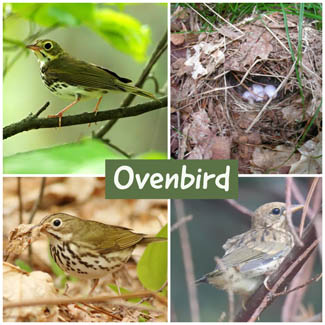
- Grid (counterclockwise):
- Male: Gary Mueller / Macaulay Library at the Cornell Lab of Ornithology (ML247030941)
- Female: Don Reimer / Macaulay Library at the Cornell Lab of Ornithology (ML100180751)
- Juvenile: Glenn Hodgkins / Macaulay Library at the Cornell Lab of Ornithology (ML247902071)
- Nest/Eggs: Kent McFarland / Macaulay Library at the Cornell Lab of Ornithology (ML52144881)
- Range map provided by Birds of the World
Click here to lean more about Ovenbird
Ovenbird
Seiurus aurocapilla
Passerines (songbirds) come in all shapes and sizes, and so do their feet! Ovenbirds are common breeders in the deciduous forests in this area. They are a species of warbler but look and behave somewhat like thrushes. They have long, strong legs and spend a lot of time hopping on the ground where they build their oven-shaped namesake nests. This inconspicuous, ground-nesting warbler is well known for its emphatic and distinctive song—a series of progressively louder phrases often described as "teacher, teacher, teacher."
Like the other habitat specialists, Ovenbirds require undisturbed expanses of forest for successful breeding and prefer uplands and areas of some moderate sloping. Although more flexible in habitat requirements on their wintering grounds, Ovenbirds and other neotropical migratory species benefit from habitat conservation in these regions as well.
Ovenbirds spend much of their time on the forest floor, where they forage through the leaf litter for insects, spiders, snails, worms, and even small lizards. Since they nest on the ground, habitat fragmentation makes them especially vulnerable to brood parasites such as Brown-headed Cowbirds, and nest predators such as raccoons, chipmunks, squirrels, and snakes.
Like the other habitat specialists, Ovenbirds require undisturbed expanses of forest for successful breeding and prefer uplands and areas of some moderate sloping. Although more flexible in habitat requirements on their wintering grounds, Ovenbirds and other neotropical migratory species benefit from habitat conservation in these regions as well.
Ovenbirds spend much of their time on the forest floor, where they forage through the leaf litter for insects, spiders, snails, worms, and even small lizards. Since they nest on the ground, habitat fragmentation makes them especially vulnerable to brood parasites such as Brown-headed Cowbirds, and nest predators such as raccoons, chipmunks, squirrels, and snakes.

Sources:
- American Bird Conservancy. (2020a, June 10). Ovenbird. a href="https://abcbirds.org/bird/ovenbird/<" target="_blank">https://abcbirds.org/bird/ovenbird/<
- Powdermill Nature Reserve, Carnegie Museum of Natural History

- Grid (counterclockwise):
- Male: Ian Kerr / Macaulay Library at the Cornell Lab of Ornithology (ML356438681)
- Female: Paul Peed / Macaulay Library at the Cornell Lab of Ornithology (ML382125301)
- Juvenile: Deirdre Robinson / Macaulay Library at the Cornell Lab of Ornithology (ML359619421)
- Nest/Eggs: Dave Bowman / Macaulay Library at the Cornell Lab of Ornithology (ML361360041)
- Range map provided by Birds of the World
Click here to lean more about Osprey
Osprey
Pandion haliaetus
A very distinctive fishhawk, formerly classified with other hawks but now placed in a separate family of its own. Along coastlines, lakes, and rivers almost worldwide, the Osprey is often seen flying over the water, hovering, and then plunging feet-first to catch fish in its talons. After a successful strike, the bird rises heavily from the water and flies away, carrying the fish head-forward with its feet. Bald Eagles sometimes chase Ospreys and force them to drop their catch. In many regions, landowners put up poles near the water to attract nesting Ospreys.
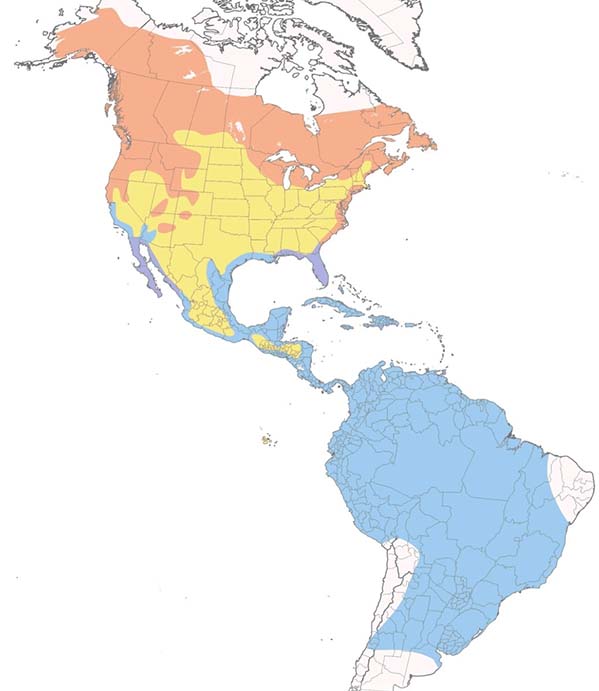
Sources:
- Osprey. Audubon. (2021, October 20). Retrieved December 15, 2021, from https://www.audubon.org/field-guide/bird/osprey

- Grid (counterclockwise):
- Male: Joe Donahue / Macaulay Library at the Cornell Lab of Ornithology (ML275299531)
- Female: Karen Avants / Macaulay Library at the Cornell Lab of Ornithology (ML268592101)
- Juvenile: Jay McGowan / Macaulay Library at the Cornell Lab of Ornithology (ML250971821)
- Nest/Eggs: Devin Johnstone / Macaulay Library at the Cornell Lab of Ornithology (ML103994731)
- Range map provided by Birds of the World
Click here to lean more about Palm Warbler
Palm Warbler
Setophaga palmarum
A bird of thickets and open areas, usually seen low or on the ground. Birds from the easternmost part of the range ("Yellow Palm Warblers") are rather colorful, but most others are quite drab; however, they can be recognized by the constant bobbing of their tails. These birds have dark legs and thin pointed bills, and adults display a rusty cap. Eastern birds have brownish olive upperparts, yellow underparts, and rusty streaks on their breasts and flanks. Many Palm Warblers spend the winter in the southeastern United States, especially in Florida, where they may be seen near palm groves but not up in the palms themselves.
Palm Warblers' breeding habitats are bog edges across Canada and the northeastern United States. Their nests are open cups, which are usually situated on, or near, the ground. Palm Warblers forage actively in conifers and on the ground, sometimes flying to catch insects. These birds mainly eat insects and berries.
Palm Warblers' breeding habitats are bog edges across Canada and the northeastern United States. Their nests are open cups, which are usually situated on, or near, the ground. Palm Warblers forage actively in conifers and on the ground, sometimes flying to catch insects. These birds mainly eat insects and berries.
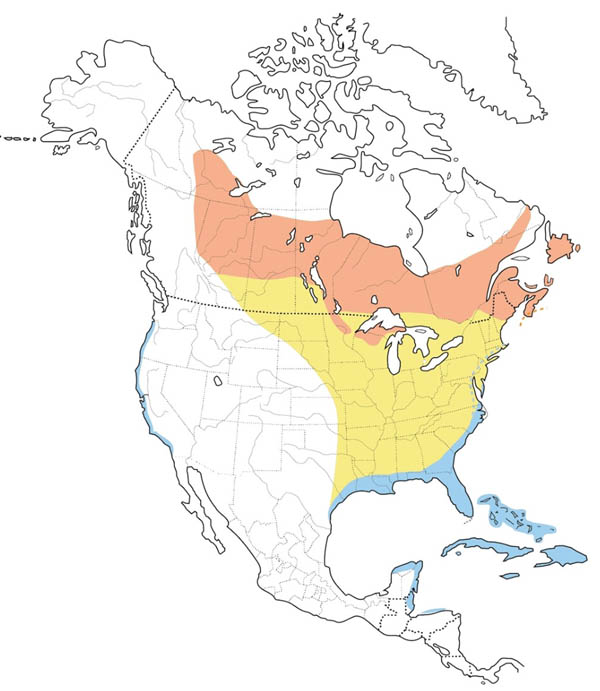
Sources:
- Palm Warbler. (2019, December 24). Audubon. https://www.audubon.org/field-guide/bird/palm-warbler
- Palm warblers. (2011). Retrieved May 03, 2021, from https://www.beautyofbirds.com/palmwarblers.html

- Grid (counterclockwise):
- Male: Dennis Mersky / Macaulay Library at the Cornell Lab of Ornithology (ML133102091)
- Female: Brian Kenney / Macaulay Library at the Cornell Lab of Ornithology (ML279999101)
- Juvenile: Sandy Podulka / Macaulay Library at the Cornell Lab of Ornithology (ML276952761)
- Nest/Eggs: Pierandrea Brichetti / Macaulay Library at the Cornell Lab of Ornithology (ML204522951)
- Range map provided by Birds of the World
Click here to lean more about Peregrine Falcon
Peregrine Falcon
Falco peregrinus
The Peregrine Falcon's species name, peregrinus, comes from the Latin word meaning "to wander," and true to its name, this formidable falcon wanders widely and is found on every continent except Antarctica. Although for most of the United States they are just passing through during migrations. The Peregrine Falcon has long, pointed wings, which give it a distinctive flight silhouette, even in poor lighting conditions.
Peregrine Falcons hunt from high in the air above land or water. Their best-known hunting technique is the "stoop," a steep dive from as high as 1,000 feet during which a Peregrine Falcon can reach a speed over 200 miles per hour, faster than any other animal.
The Peregrine is beautifully adapted for high-speed hunting, with long, tapered wings for maneuvering at high speeds and strong feet and talons, used to initially strike, then grasp its prey. The tremendous impact generated by a Peregrine's stoop may kill smaller prey immediately, while a larger quarry is knocked to the ground and dispatched there. Peregrines are not only the fastest bird, but the fastest animals on the planet reaching speeds of well over 200 mph when diving for prey. Some sources claim up to 240 mph!
Peregrine Falcons hunt from high in the air above land or water. Their best-known hunting technique is the "stoop," a steep dive from as high as 1,000 feet during which a Peregrine Falcon can reach a speed over 200 miles per hour, faster than any other animal.
The Peregrine is beautifully adapted for high-speed hunting, with long, tapered wings for maneuvering at high speeds and strong feet and talons, used to initially strike, then grasp its prey. The tremendous impact generated by a Peregrine's stoop may kill smaller prey immediately, while a larger quarry is knocked to the ground and dispatched there. Peregrines are not only the fastest bird, but the fastest animals on the planet reaching speeds of well over 200 mph when diving for prey. Some sources claim up to 240 mph!
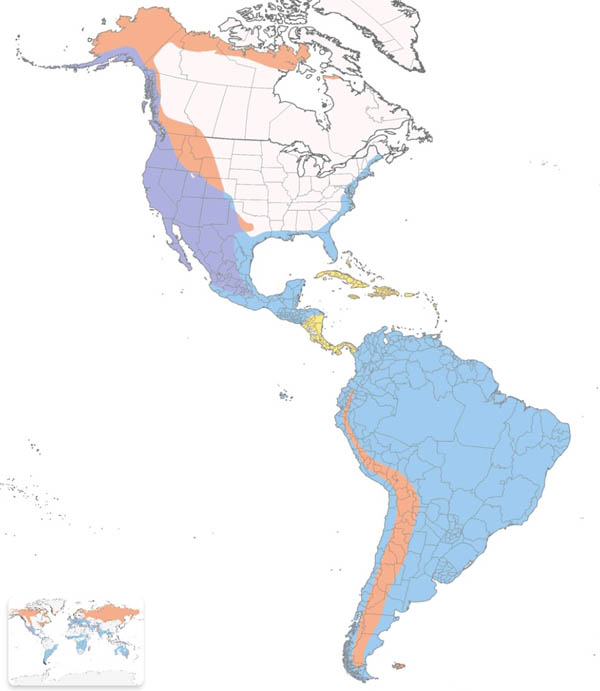
Sources:
- American Bird Conservancy. (2020n, July 20). Peregrine Falcon. https://abcbirds.org/bird/peregrine-falcon/
- Jesse. (2021, January 10). 14 interesting peregrine FALCON Facts. Retrieved May 03, 2021, from https://birdfeederhub.com/peregrine-falcon-facts/
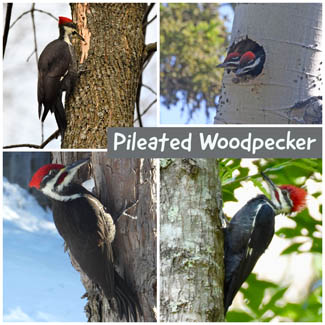
- Grid (counterclockwise):
- Male: Cole Wolf / Macaulay Library at the Cornell Lab of Ornithology (ML279312281)
- Female: Monique Maynard / Macaulay Library at the Cornell Lab of Ornithology (ML279704331)
- Juvenile: Karen Avants / Macaulay Library at the Cornell Lab of Ornithology (ML261488471)
- Nest/Eggs: Jim Sims / Macaulay Library at the Cornell Lab of Ornithology (ML244782491)
- Range map provided by Birds of the World
Click here to lean more about Pileated Woodpecker
Pileated Woodpecker
Dryocopus pileatus
A big, dashing bird with a flaming crest, the largest woodpecker in North America. Excavating deep into rotten wood to get at the nests of carpenter ants, the Pileated leaves characteristic rectangular holes in dead trees. This species became rare in eastern North America with the clearing of forests in centuries past but has gradually increased in numbers again since about the beginning of the 20th century. Where unmolested, it even lives in parks and woodlots around the edges of large cities. With flashing black-and-white wings and a bright red crest, when a crow-sized Pileated Woodpecker swoops by, even the most experienced birders stop in their tracks.
Why is the bird is named "pileated?" There is a simple reason behind that: It derives from the Latin pileatus, meaning "capped." Just one glance at this bird's bright crest explains the name.
The cartoon connection is a bit more involved. It turns out that the popular mid-20th century cartoon character Woody Woodpecker was inspired by a persistent Acorn Woodpecker that staged a cameo during animator Walter Lantz's honeymoon, calling and drumming at the couple's cabin. Lantz's wife Gracie suggested that Walter make a cartoon character of the bird — and so Woody was created.
Why is the bird is named "pileated?" There is a simple reason behind that: It derives from the Latin pileatus, meaning "capped." Just one glance at this bird's bright crest explains the name.
The cartoon connection is a bit more involved. It turns out that the popular mid-20th century cartoon character Woody Woodpecker was inspired by a persistent Acorn Woodpecker that staged a cameo during animator Walter Lantz's honeymoon, calling and drumming at the couple's cabin. Lantz's wife Gracie suggested that Walter make a cartoon character of the bird — and so Woody was created.
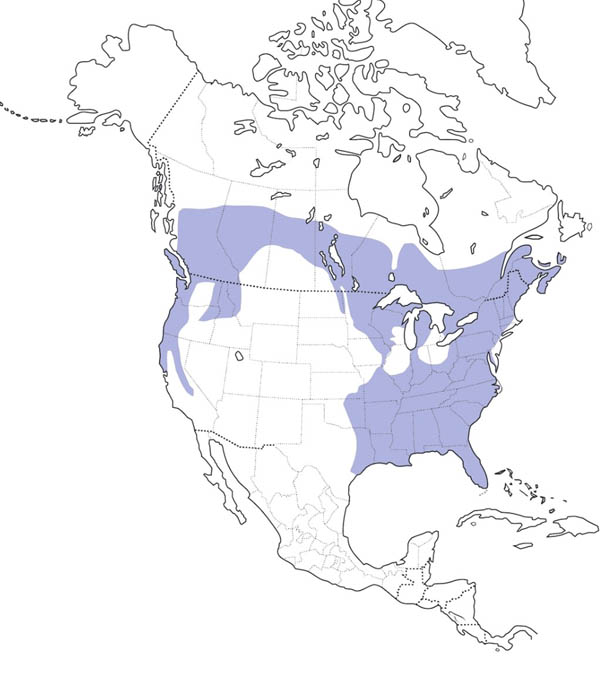
Sources:
- American Bird Conservancy. (2020, June 24). Pileated Woodpecker. https://abcbirds.org/bird/pileated-woodpecker/
- Pileated woodpecker. (2019, December 24). Retrieved May 03, 2021, from https://www.audubon.org/field-guide/bird/pileated-woodpecker

- Grid (counterclockwise):
- Male: Ken Schneider / Macaulay Library at the Cornell Lab of Ornithology (ML270140361)
- Female: Ken Schneider / Macaulay Library at the Cornell Lab of Ornithology (ML264509831)
- Juvenile: Roger Kroodsma / Macaulay Library at the Cornell Lab of Ornithology (ML252864191)
- Nest/Eggs: Donald Mackler / Macaulay Library at the Cornell Lab of Ornithology (ML248772831)
- Range map provided by Birds of the World
Click here to lean more about Prairie Warbler
Prairie Warbler
Setophaga discolor
Contrary to its name, the Prairie Warbler is a bird of scrubby fields, clear cuts, and open woods, where it can be located by its buzzy, ascending song, tail-pumping habit, and black-streaked yellow plumage. This species has a bold facial pattern that gives it a "spectacled" appearance. These birds have yellow underparts with dark streaks on the flanks, and olive upperparts with rusty streaks on the back; they have a yellow line above the eye, a dark line through it, and a yellow spot below it. These birds have black legs, long tails, pale wing bars, and thin pointed bills. Coloring is duller in females and immatures.
The male Prairie Warbler sings two types of song, which are superficially similar but differ in volume and speed. One song, sung to the female during courtship and nesting, helps maintain the birds' pair bond and is demonstrated in the featured multimedia, above. The second type is sung at the boundaries of the male's territory to deter rivals.
The in-aptly named Prairie Warbler is found in scrubby fields and forests throughout the eastern and south-central United States, not on the prairies. The Prairie Warbler's nests are open cups, which are usually placed in a low area of a tree or shrub. These birds are permanent residents in the southern parts of their range. Other birds migrate to northeastern Mexico and islands in the Caribbean. Prairie Warblers forage actively on tree branches and sometimes fly around to catch insects, which are the main food source of these birds.
The male Prairie Warbler sings two types of song, which are superficially similar but differ in volume and speed. One song, sung to the female during courtship and nesting, helps maintain the birds' pair bond and is demonstrated in the featured multimedia, above. The second type is sung at the boundaries of the male's territory to deter rivals.
The in-aptly named Prairie Warbler is found in scrubby fields and forests throughout the eastern and south-central United States, not on the prairies. The Prairie Warbler's nests are open cups, which are usually placed in a low area of a tree or shrub. These birds are permanent residents in the southern parts of their range. Other birds migrate to northeastern Mexico and islands in the Caribbean. Prairie Warblers forage actively on tree branches and sometimes fly around to catch insects, which are the main food source of these birds.

Sources:
- American Bird Conservancy. (2020, June 24). Prairie Warbler. https://abcbirds.org/bird/prairie-warbler/
- Prairie warbler. (2019). Retrieved May 03, 2021, from https://thewebsiteofeverything.com/animals/birds/Passeriformes/Parulidae/Dendroica-discolor
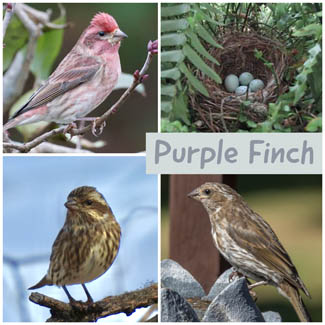
- Grid (counterclockwise):
- Male: Richard Mckay / Macaulay Library at the Cornell Lab of Ornithology (ML279433381)
- Female: Van Remsen / Macaulay Library at the Cornell Lab of Ornithology (ML279811531)
- Juvenile: Norma Maurice / Macaulay Library at the Cornell Lab of Ornithology (ML255450871)
- Nest/Eggs: reggie / Finches in the Ferns
- Range map provided by Birds of the World
Click here to lean more about Purple Finch
Purple Finch
Haemorhous purpureus
Its genus name, Haemorhous, is slightly less appetizing, as "haemo" is Greek for blood, but it accurately describes the reddish-purple shades of this songbird. Not truly purple, this bird exhibits more of an old-rose color. This species is common in the North and East, and along the Pacific seaboard, but it is very rare in much of the Rocky Mountain region. Purple Finches feed up in trees and on the ground in open woods. They readily come to bird feeders; but they have become less numerous as feeder visitors in the Northeast, where competition with introduced House Sparrows and then House Finches may have driven them back into the woods.
The male Purple Finch is purplish-red on its head, upper parts, and breast. Its underparts are light with blurry red streaks, and the rump shows another splash of raspberry red. The female Purple Finch has streaky brown-and-white plumage and a strong facial pattern, with none of the bright raspberry color of the male. This marked difference between the sexes' appearances, known as sexual dimorphism, is seen in many other bird species.
The male Purple Finch is purplish-red on its head, upper parts, and breast. Its underparts are light with blurry red streaks, and the rump shows another splash of raspberry red. The female Purple Finch has streaky brown-and-white plumage and a strong facial pattern, with none of the bright raspberry color of the male. This marked difference between the sexes' appearances, known as sexual dimorphism, is seen in many other bird species.

Sources:
- American Bird Conservancy. (2020, October 16). Purple Finch. https://abcbirds.org/bird/purple-finch/
- Purple finch. (2020, January 13). Retrieved May 03, 2021, from https://www.audubon.org/field-guide/bird/purple-finch
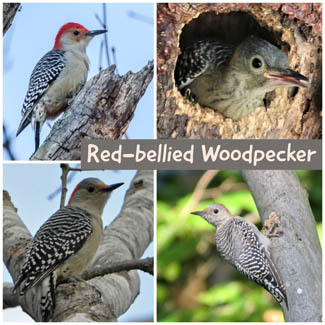
- Grid (counterclockwise):
- Male: Jean-Guy Papineau / Macaulay Library at the Cornell Lab of Ornithology (ML277367031)
- Female: Michael J Good / Macaulay Library at the Cornell Lab of Ornithology (ML277443081)
- Juvenile: Gerry Hawkins / Macaulay Library at the Cornell Lab of Ornithology (ML262477351)
- Nest/Eggs: Daniel Lebbin / Macaulay Library at the Cornell Lab of Ornithology (ML247658511)
- Range map provided by Birds of the World
Click here to lean more about Red-bellied Woodpecker
Red-bellied Woodpecker
Melanerpes carolinus
Oddly enough, the Red-bellied Woodpecker is named for its least distinctive feature, a light wash of red or pink on its belly that can only be seen if the bird is hanging upside-down. Much more noticeable is the bright red patch extending from the top of its head, in the male, and down the back of the neck, in both sexes. Since the Red-bellied Woodpecker has so much red on its head, people often think its name should be the Red-headed Woodpecker, but that name is already taken by a related, less common species that has an entirely red head. Once one sees both species, the difference between the two is obvious. The name "Red-capped" would be a more accurate description for the Red-bellied Woodpecker.
Woodpeckers have extremely long tongues that retract back behind the bird's head between the skull and skin. These long tongues help woodpeckers forage – they probe for insects in wood. However, have you ever seen a close-up look at the tip of a woodpecker's tongue? The Red-bellied Woodpecker has backward-facing barbs that help move prey items from wood and into the bird's mouth.
Woodpeckers have extremely long tongues that retract back behind the bird's head between the skull and skin. These long tongues help woodpeckers forage – they probe for insects in wood. However, have you ever seen a close-up look at the tip of a woodpecker's tongue? The Red-bellied Woodpecker has backward-facing barbs that help move prey items from wood and into the bird's mouth.
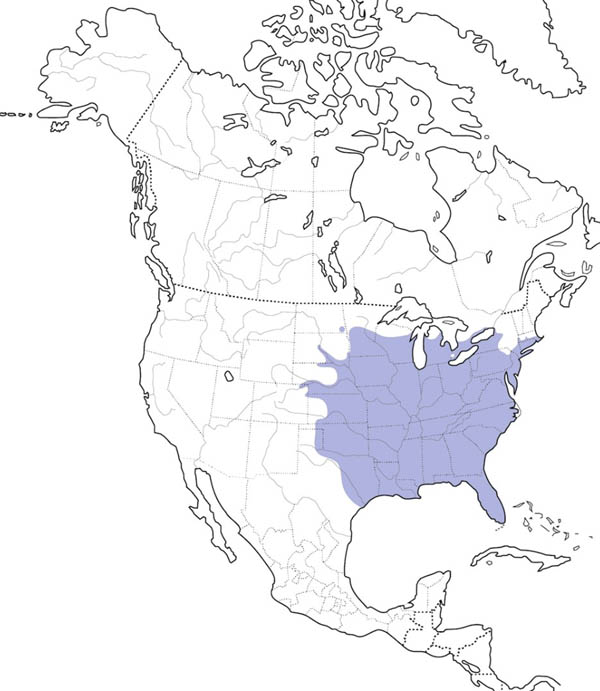
Sources:
- American Bird Conservancy. (2021, April 19). Red-bellied Woodpecker. https://abcbirds.org/bird/red-bellied-woodpecker/
- Powdermill Nature Reserve, Carnegie Museum of Natural History
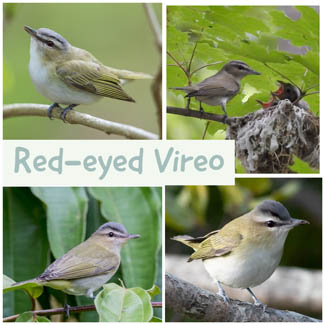
- Grid (counterclockwise):
- Male: Michael Stubblefield / Macaulay Library at the Cornell Lab of Ornithology (ML276687031)
- Female: fernando Burgalin Sequeria / Macaulay Library at the Cornell Lab of Ornithology (ML181150501)
- Juvenile: Doug Gochfeld / Macaulay Library at the Cornell Lab of Ornithology (ML263025941)
- Nest/Eggs: Cory Elowe / Macaulay Library at the Cornell Lab of Ornithology (ML246315741)
- Range map provided by Birds of the World
Click here to lean more about Red-eyed Vireo
Red-eyed Vireo
Vireo olivaceus
Did somebody say, "RED-eyed Vireo?" Yes, the hatch-year birds of this species have a dark brown eye which will turn to the adult red color over the first winter. Throughout the fall though, that brown eye makes the job of aging these birds MUCH simpler!
Red-eyed Vireos are one of the most numerous summer birds in eastern woods. It is not the most often seen, because it tends to stay out of sight in the leafy treetops, searching methodically among the foliage for insects. However, its song -- a series of short and musical, but monotonous phrases, as if it were endlessly asking and answering the same question -- can be heard constantly during the nesting season, even on hot summer afternoons.
Red-eyed Vireos are one of the most numerous summer birds in eastern woods. It is not the most often seen, because it tends to stay out of sight in the leafy treetops, searching methodically among the foliage for insects. However, its song -- a series of short and musical, but monotonous phrases, as if it were endlessly asking and answering the same question -- can be heard constantly during the nesting season, even on hot summer afternoons.
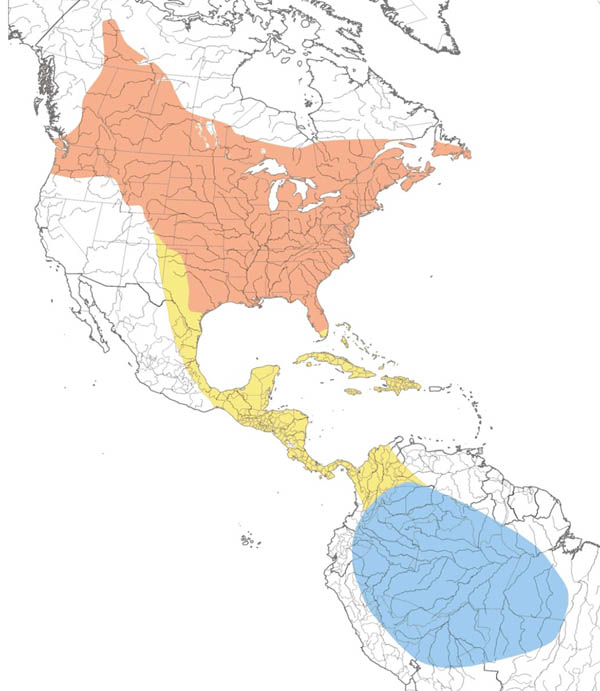
Sources:
- Powdermill Nature Reserve, Carnegie Museum of Natural History
- Red-eyed Vireo. (2020, January 13). Audubon. https://www.audubon.org/field-guide/bird/red-eyed-vireo
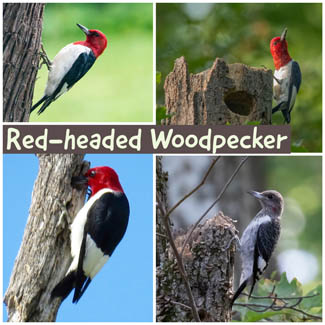
- Grid (counterclockwise):
- Male: Robert & Susan Codd / Macaulay Library at the Cornell Lab of Ornithology (ML353259281)
- Female: Ann Tanner / Macaulay Library at the Cornell Lab of Ornithology (ML30884131)
- Juvenile: Kathy Malone / Macaulay Library at the Cornell Lab of Ornithology (ML382020891)
- Nest/Eggs: Sandy Podulka / Macaulay Library at the Cornell Lab of Ornithology (ML356671481)
- Range map provided by Birds of the World
Click here to lean more about Red-headed Woodpecker
Red-headed Woodpecker
Melanerpes erythrocephalus
This striking and unmistakable bird was a favorite of early ornithologists such as Alexander Wilson and Audubon. Often conspicuous because of its strong pattern, harsh calls, and active behavior in semi-open country, it tends to occur in small colonies. Although it migrates only short distances, little groups of migrants may be noticeable in early fall and late spring. Once a very common bird in eastern North America, the Red-headed Woodpecker is now uncommon and local in many regions.
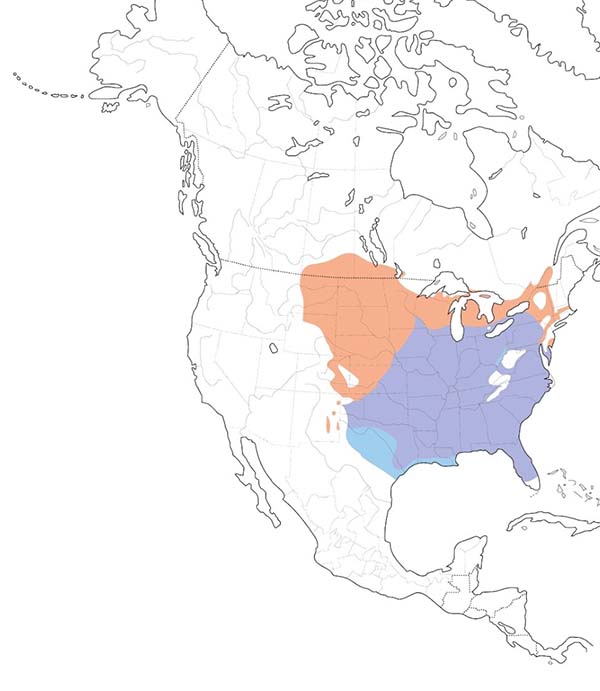
Sources:
- Red-headed woodpecker. Audubon. (2021, October 20). Retrieved December 15, 2021, from https://www.audubon.org/field-guide/bird/red-headed-woodpecker
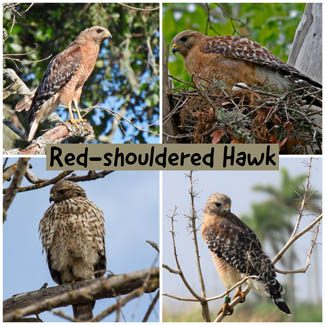
- Grid (counterclockwise):
- Male: Bill Schneider / Macaulay Library at the Cornell Lab of Ornithology (ML350687681)
- Female: Susan Young / Macaulay Library at the Cornell Lab of Ornithology (ML363932091)
- Juvenile: Craig Tumer / Macaulay Library at the Cornell Lab of Ornithology (ML377893071)
- Nest/Eggs: Kris Petersen / Macaulay Library at the Cornell Lab of Ornithology (ML130444371)
- Range map provided by Birds of the World
Click here to lean more about Red-shouldered Hawk
Red-shouldered Hawk
Buteo lineatus
A hawk of the woodlands, the Red-shouldered Hawk is often heard before it is seen. The clear whistled calls of this hawk are conspicuous, especially in spring; in the east, Blue Jays often give a near-perfect imitation of this call. Over much of eastern North America, the Red-shoulder has become uncommon, sticking closely to the remaining forests. Populations in Florida and California are often more visible, perhaps adapting better to open habitats.
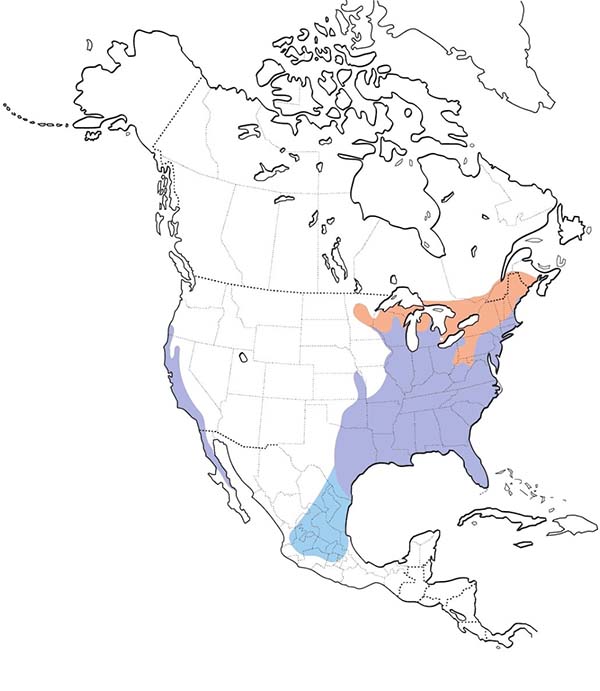
Sources:
- Red-shouldered hawk. Audubon. (2021, October 20). Retrieved December 15, 2021, from https://www.audubon.org/field-guide/bird/red-shouldered-hawk
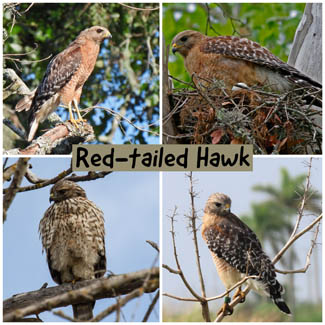
- Grid (counterclockwise):
- Male: Sylvain Bourdages Macaulay Library at the Cornell Lab of Ornithology (ML343075691)
- Female: Rosanne Petrich / Macaulay Library at the Cornell Lab of Ornithology (ML305872471)
- Juvenile: Paul Fenwick / Macaulay Library at the Cornell Lab of Ornithology (ML380186791)
- Nest/Eggs: Conan Guard / Macaulay Library at the Cornell Lab of Ornithology (ML204227881)
- Range map provided by Birds of the World
Click here to lean more about Red-tailed Hawk
Red-tailed Hawk
Buteo jamaicensis
This is the most widespread and familiar large hawk in North America, bulky and broad-winged, designed for effortless soaring. An inhabitant of open country, it is commonly seen perched on roadside poles or sailing over fields and woods. Although adults usually can be recognized by the trademark reddish-brown tail, the rest of their plumage can be quite variable, especially west of the Mississippi: Western Red-tails can range from blackish to rufous-brown to nearly white.
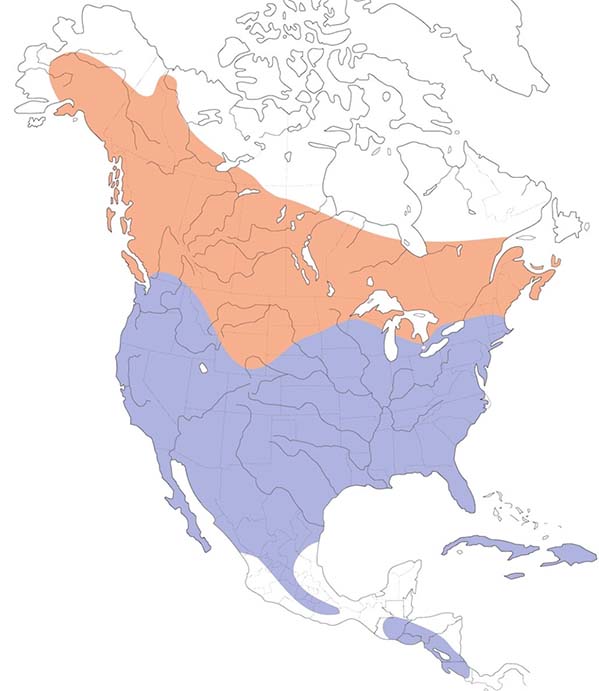
Sources:
- Red-Tailed Hawk. Audubon. (2021, October 20). Retrieved December 15, 2021, from https://www.audubon.org/field-guide/bird/red-tailed-hawk
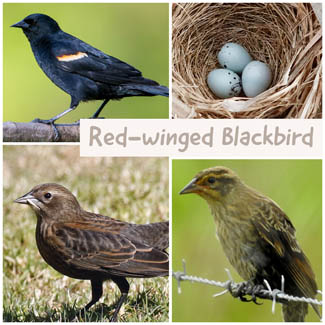
- Grid (counterclockwise):
- Male: Michael Stubblefield / Macaulay Library at the Cornell Lab of Ornithology (ML276981501)
- Female: Don Roberson / Macaulay Library at the Cornell Lab of Ornithology (ML277366911)
- Juvenile: Gillian Kirkwood / Macaulay Library at the Cornell Lab of Ornithology (ML267475451)
- Nest/Eggs: Deirdre Robinson / Macaulay Library at the Cornell Lab of Ornithology (ML237764931)
- Range map provided by Birds of the World
Click here to lean more about Red-winged Blackbird
Red-winged Blackbird
Agelaius phoeniceus
The liquid, burbling "conk-a-ree!" of a male Red-winged Blackbird in the territory is a sure sign of spring, or at least its pending arrival. This bird's common name derives from the sleek black males' distinctive shoulder patches, or epaulets, which flash red in flight and while the bird is singing on territory.
The Red-winged Blackbird belongs to the family Icteridae, which includes the Eastern Meadowlark, Rusty Blackbird, and Baltimore Oriole. Red-winged Blackbirds are sexually dimorphic, meaning males and females have very different appearances. They also play very different roles during the breeding season.
Breeding males stand sentry, ceaselessly singing and chasing intruders. Meanwhile, the streaky brown females — easy to mistake for large, pointy-billed sparrows — skulk in nearby vegetation, stealthily building nests, laying eggs and incubating, then doing much of the feeding of their young.
Young Red-winged Blackbird baby birds often have a "cute" appearance aided by fluffier, downier feathers and a "baby gape" (the fleshy corners of the beak where the moth opens wide). Young male and female Red-winged Blackbirds often look very much alike.
The Red-winged Blackbird belongs to the family Icteridae, which includes the Eastern Meadowlark, Rusty Blackbird, and Baltimore Oriole. Red-winged Blackbirds are sexually dimorphic, meaning males and females have very different appearances. They also play very different roles during the breeding season.
Breeding males stand sentry, ceaselessly singing and chasing intruders. Meanwhile, the streaky brown females — easy to mistake for large, pointy-billed sparrows — skulk in nearby vegetation, stealthily building nests, laying eggs and incubating, then doing much of the feeding of their young.
Young Red-winged Blackbird baby birds often have a "cute" appearance aided by fluffier, downier feathers and a "baby gape" (the fleshy corners of the beak where the moth opens wide). Young male and female Red-winged Blackbirds often look very much alike.
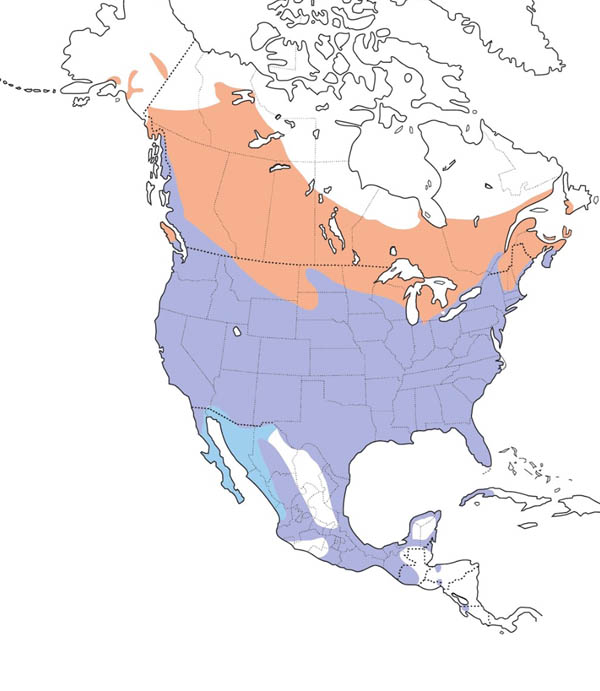
Sources:
- American Bird Conservancy. (2020a, January 16). Red-winged Blackbird. https://abcbirds.org/bird/red-winged-blackbird
- Powdermill Nature Reserve, Carnegie Museum of Natural History
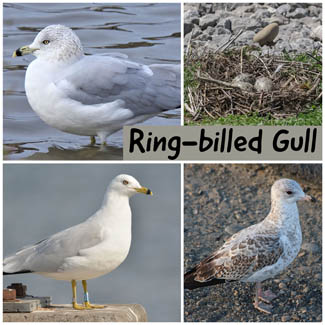
- Grid (counterclockwise):
- Male: Lucio 'Luc' Fazio / Macaulay Library at the Cornell Lab of Ornithology (ML276857401)
- Female: Jeanne Cimorelli / Macaulay Library at the Cornell Lab of Ornithology (ML311240801)
- Juvenile: Sean Cozart / Macaulay Library at the Cornell Lab of Ornithology (ML381751381)
- Nest/Eggs: Greg Bodker / Macaulay Library at the Cornell Lab of Ornithology (ML56726661)
- Range map provided by Birds of the World
Click here to lean more about Ring-billed Gull
Ring-billed Gull
Larus delawarensis
Often the most common gull in North America, especially inland, and numbers are probably still increasing. Sociable at all seasons; concentrations at nesting colonies or winter-feeding sites may run into the tens of thousands. The Ring-bill has adapted thoroughly to civilization. Flocks are often seen resting in parking lots, scavenging scraps around fast-food restaurants, or swarming over landfills.
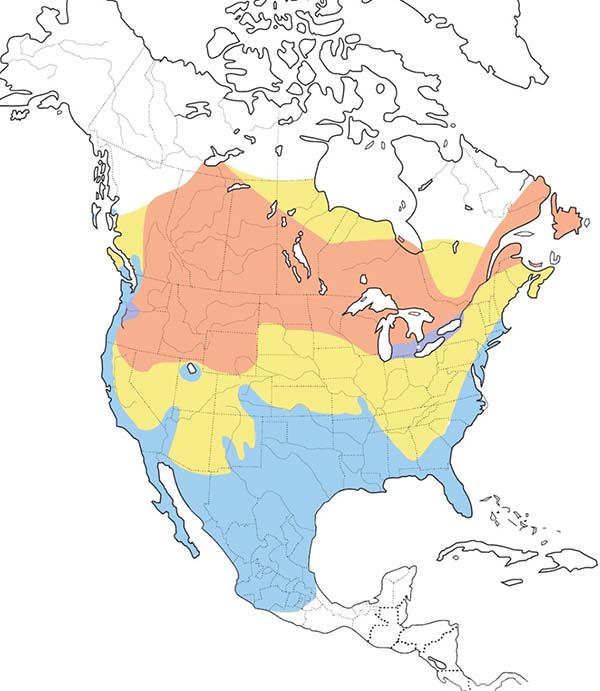
Sources:
- Ring-billed gull. Audubon. (2021, October 20). Retrieved December 15, 2021, from https://www.audubon.org/field-guide/bird/ring-billed-gull
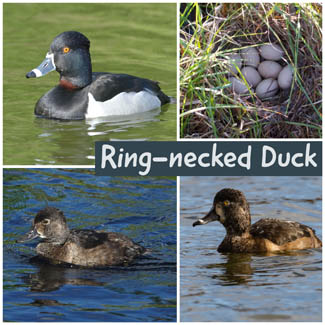
- Grid (counterclockwise):
- Male: James McKenzie / Macaulay Library at the Cornell Lab of Ornithology (ML370369701)
- Female: Frank King / Macaulay Library at the Cornell Lab of Ornithology (ML381598021)
- Juvenile: Barry Day / Macaulay Library at the Cornell Lab of Ornithology (ML260943661
- Nest/Eggs: / Macaulay Library at the Cornell Lab of Ornithology
- Range map provided by Birds of the World
Click here to lean more about Ring-necked Duck
Ring-necked Duck
Aythya collaris
Although it mixes freely with other diving ducks on large lakes in winter, the Ring-neck is also found on small, tree-lined ponds, and associates with dabbling ducks on shallow waters. A strong and fast flier, it can take flight by springing up directly from the water, without the laborious take-off run of most diving ducks. Despite the name, the ring on its neck is rarely visible.
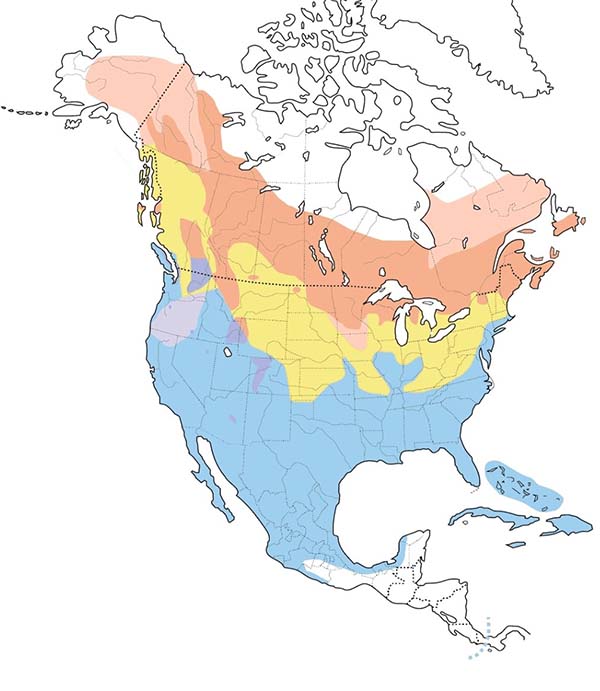
Sources:
- Ring-necked Duck. Audubon. (2021, October 20). Retrieved December 15, 2021, from https://www.audubon.org/field-guide/bird/ring-necked-duck
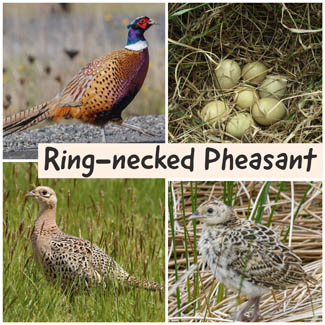
- Grid (counterclockwise):
- Male: Eric Ellingson / Macaulay Library at the Cornell Lab of Ornithology (ML377188411)
- Female: Jeffrey Offermann / Macaulay Library at the Cornell Lab of Ornithology (ML351359071)
- Juvenile: Jon Lowes / Macaulay Library at the Cornell Lab of Ornithology (ML350722301)
- Nest/Eggs: Tamas Zeke / Macaulay Library at the Cornell Lab of Ornithology (ML228521081)
- Range map provided by Birds of the World
Click here to lean more about Ring-necked Pheasant
Ring-necked Pheasant
Phasianus colchicus
Most kinds of pheasants are shy forest birds of Asia. The Ring-neck, better adapted to open country, has been introduced as a game bird to several parts of the world, including North America. Here it thrives in some areas, such as the northern prairies, where the iridescent colors and rich crowing calls of the males add much to the landscape. Winter flocks of these pheasants often are segregated -- small groups of males, larger flocks of females.
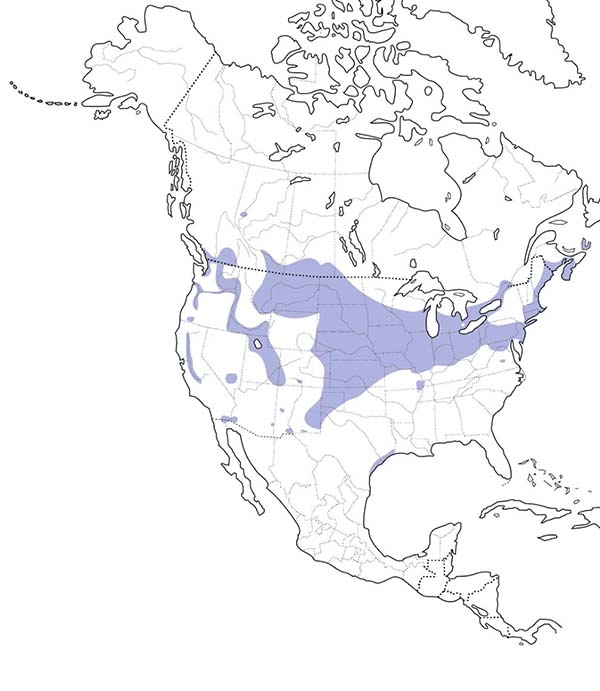
Sources:
- Ring-necked Pheasant. Audubon. (2021, October 23). Retrieved December 15, 2021, from https://www.audubon.org/field-guide/bird/ring-necked-pheasant

- Grid (counterclockwise):
- Male: Wich'yanan Limparungpatthanakij / Macaulay Library at the Cornell Lab of Ornithology (ML374962821)
- Female: Lisa Huffman / Macaulay Library at the Cornell Lab of Ornithology (ML352273721)
- Juvenile: Jennifer & Kevin / Macaulay Library at the Cornell Lab of Ornithology (ML314328321)
- Nest/Eggs: Deepak Gujar / Macaulay Library at the Cornell Lab of Ornithology (ML254393311)
- Range map provided by Birds of the World
Click here to lean more about Rock Pigeon
Rock Pigeon
Columba livia
Few birds have been associated with humans so closely as the Rock Pigeon, better known as the common city pigeon. It has been domesticated and taken around the world, raised for food, trained for homing, racing, and carrying messages, and used in research. Originally native from Europe to North Africa and India, it now lives in a wild or semi-wild condition in cities all over the world, including most of North America. In places it has reverted to wild habits, nesting on cliffs far from cities.
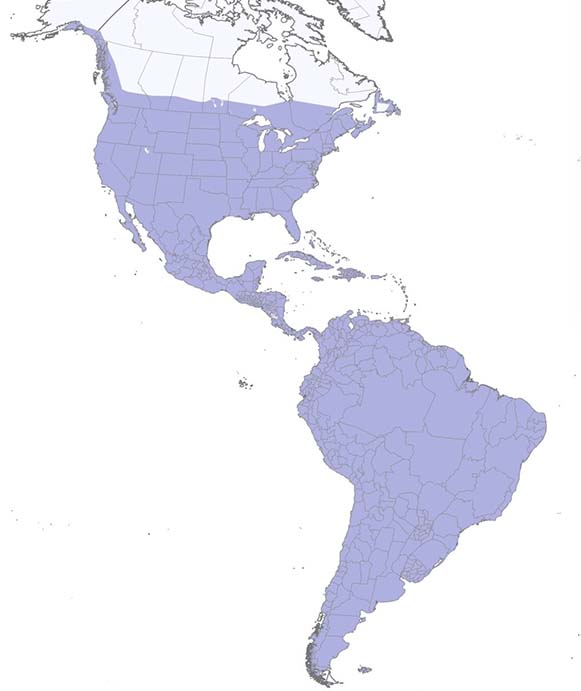
Sources:
- Rock Pigeon. Audubon. (2021, October 20). Retrieved December 15, 2021, from https://www.audubon.org/field-guide/bird/rock-pigeon
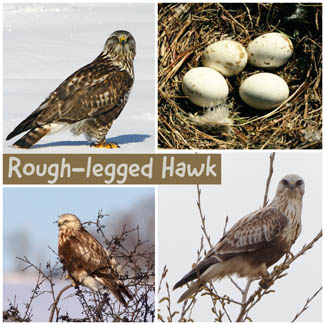
- Grid (counterclockwise):
- Male: Jerry Liguori / Macaulay Library at the Cornell Lab of Ornithology (ML244424851)
- Female: George Forsyth / Macaulay Library at the Cornell Lab of Ornithology (ML310166981)
- Juvenile: Steve Kelling / Macaulay Library at the Cornell Lab of Ornithology (ML329615581)
- Nest/Eggs: Burke Korol / Macaulay Library at the Cornell Lab of Ornithology (ML77298861)
- Range map provided by Birds of the World
Click here to lean more about Rough-legged Hawk
Rough-legged Hawk
Buteo lagopus
Of our soaring Buteo hawks, this is the only one tied to cold climates. It nests in the Arctic, mostly in tundra regions north of the boreal forest, in winter, only a few move farther south than the central United States. Its breeding success on the tundra is often dictated by the population cycles of lemmings, which may provide most of the food for the young. The name 'Rough-legged' refers to the feathering that extends down the legs to the base of the toes -- a helpful adaptation for staying warm in frigid weather.
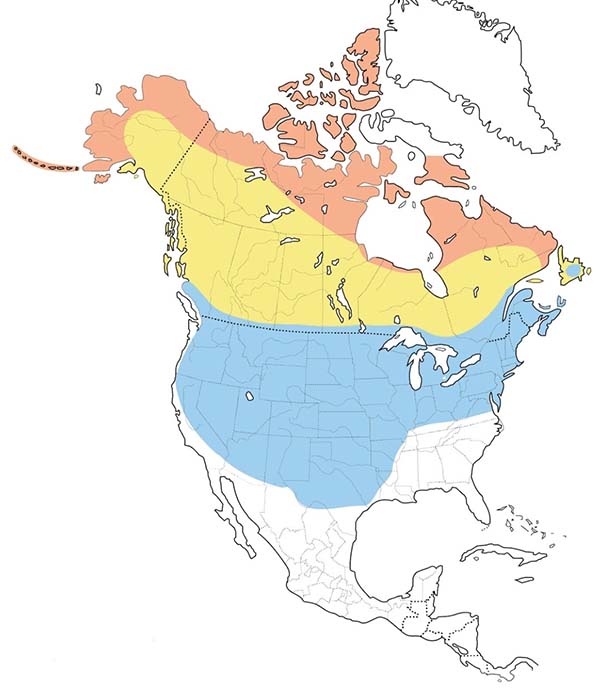
Sources:
- Rough-legged hawk. Audubon. (2021, October 20). Retrieved December 15, 2021, from https://www.audubon.org/field-guide/bird/rough-legged-hawk
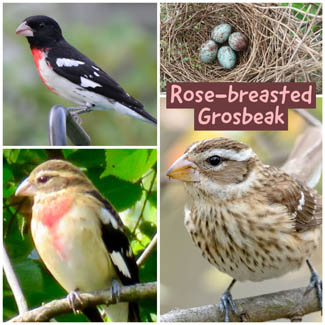
- Grid (counterclockwise):
- Male: Kristen Johnson / Macaulay Library at the Cornell Lab of Ornithology (ML248655101)
- Female: Shailesh Pinto / Macaulay Library at the Cornell Lab of Ornithology (ML273052671)
- Juvenile: Jean Spaans / Macaulay Library at the Cornell Lab of Ornithology (ML263787491)
- Nest/Eggs: Milwaukee County Parks Natural Areas Staff / Macaulay Library at the Cornell Lab of Ornithology (ML59389741)
- Range map provided by Birds of the World
Click here to lean more about Rose-breasted Grosbeak
Rose-breasted Grosbeak
Pheucticus ludovicianus
The Rose-breasted Grosbeak is strikingly beautiful. But it has a gruesome folk name: "cut-throat," owing to the scarlet swatch across its breast. The name "grosbeak" comes from the French term grosbec, meaning "large beak"—an obvious attribute of this bird, Black-headed Grosbeak, and others in their family.
This species has a sweet, robin-like song sometimes characterized as a "tipsy thrush." Its call note is a distinctive sharp "peek," like a sneaker squeaking on a gymnasium floor.
Unlike many other bird species, both male and female Rose-breasted Grosbeaks share incubation, brooding, and feeding duties at the nest. The breeding season usually takes place from mid-May through July. Both the male and the female participate in selecting and building the nest, which is on a tree branch, over vines, or any elevated woody vegetation. Nests are made from leaves, twigs, rootlets, or hair. Females lay clutches from 1 to 5 pale blue to green eggs with purplish to brownish red spotting.
This species has a sweet, robin-like song sometimes characterized as a "tipsy thrush." Its call note is a distinctive sharp "peek," like a sneaker squeaking on a gymnasium floor.
Unlike many other bird species, both male and female Rose-breasted Grosbeaks share incubation, brooding, and feeding duties at the nest. The breeding season usually takes place from mid-May through July. Both the male and the female participate in selecting and building the nest, which is on a tree branch, over vines, or any elevated woody vegetation. Nests are made from leaves, twigs, rootlets, or hair. Females lay clutches from 1 to 5 pale blue to green eggs with purplish to brownish red spotting.
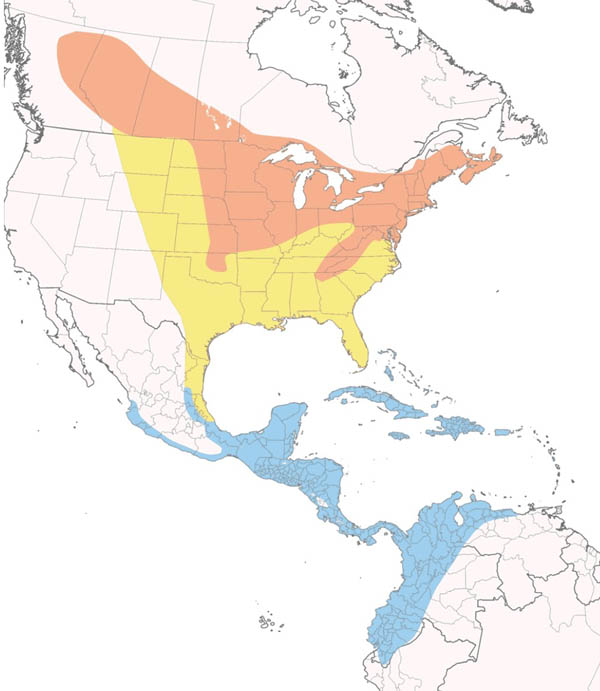
Sources:
- American Bird Conservancy. (2017, July 26). Rose-breasted Grosbeak. https://abcbirds.org/bird/rose-breasted-grosbeak/
- Rose-breasted Grosbeak. (2020). Retrieved May 03, 2021, from https://animalia.bio/rose-breasted-grosbeak
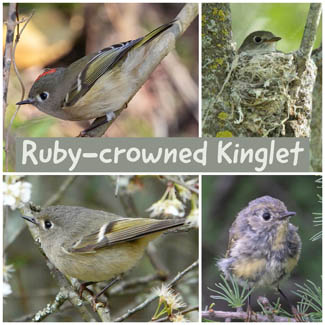
- Grid (counterclockwise):
- Male: Iris Kilpatrick / Macaulay Library at the Cornell Lab of Ornithology (ML380514081)
- Female: deborah grimes / Macaulay Library at the Cornell Lab of Ornithology (ML314202251)
- Juvenile: Frank King / Macaulay Library at the Cornell Lab of Ornithology (ML359776801)
- Nest/Eggs: / Macaulay Library at the Cornell Lab of Ornithology
- Range map provided by Birds of the World
Click here to lean more about Ruby-crowned Kinglet
Ruby-crowned Kinglet
Corthylio calendula
This tiny bird is often hard to see in summer when it lives high in tall conifers. In migration and winter, however, it often flits about low in woods and thickets, flicking its wings nervously as it approaches the observer. When it is truly excited (by a potential mate, rival, or predator), the male may erect his ruby-red crown feathers, hidden at other times. The song of the Ruby-crown is jumbled and loud, all out of proportion to the size of the bird. Kinglets are tough little birds - 6-gram insectivores that can survive (and thrive!) cold, snowy winters! Ruby-crowned Kinglets breed across Canada and down into the Rockies and spend the winter in the southern US and northern half of Mexico. They migrate a bit earlier than gnatcatchers and some may even be found locally in the winter. Male Ruby-crowned Kinglets have a bright red crown that is sometimes covered by their olives-gray head feathers, but females lack this splash of red.
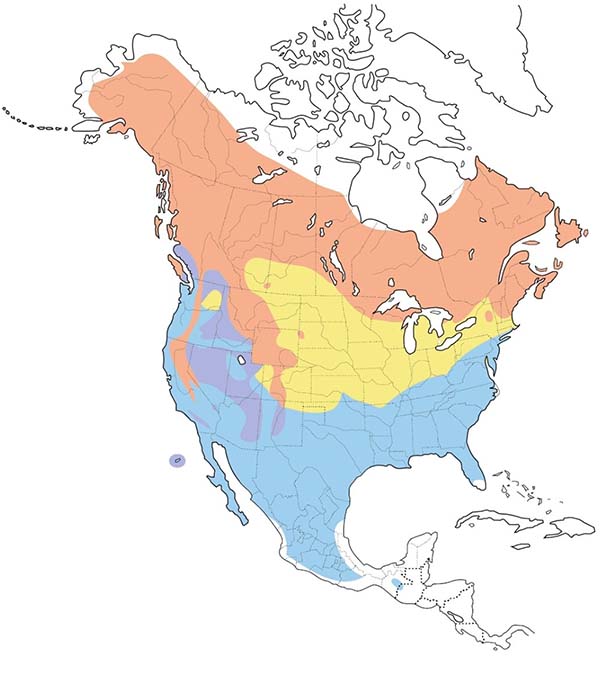
Sources:
- Powdermill Nature Reserve, Carnegie Museum of Natural History
- Ruby-Crowned Kinglet. Audubon. (2021, October 20). Retrieved December 15, 2021, from https://www.audubon.org/field-guide/bird/ruby-crowned-kinglet
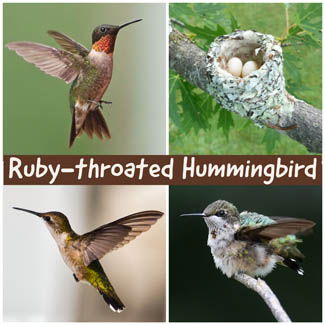
- Grid (counterclockwise):
- Male: Cody Matheson / Macaulay Library at the Cornell Lab of Ornithology (ML367556211)
- Female: Donald Fullmer / Macaulay Library at the Cornell Lab of Ornithology (ML371713911)
- Juvenile: Deborah Bifulco / Macaulay Library at the Cornell Lab of Ornithology (ML362177371)
- Nest/Eggs: Jim Lind / Macaulay Library at the Cornell Lab of Ornithology (ML129767491)
- Range map provided by Birds of the World
Click here to lean more about Ruby-throated Hummingbird
Ruby-throated Hummingbird
Archilochus colubris
Hundreds of kinds of hummingbirds nest in the American tropics, and more than a dozen in the western U.S., but east of the Great Plains there is only the Ruby-throat. There it is common in summer in open woods and gardens. Hovering in front of a flower to sip nectar, it beats its wings more than 50 times per second. Impressive migrants despite their small size, some Ruby-throats may travel from Canada to Costa Rica.
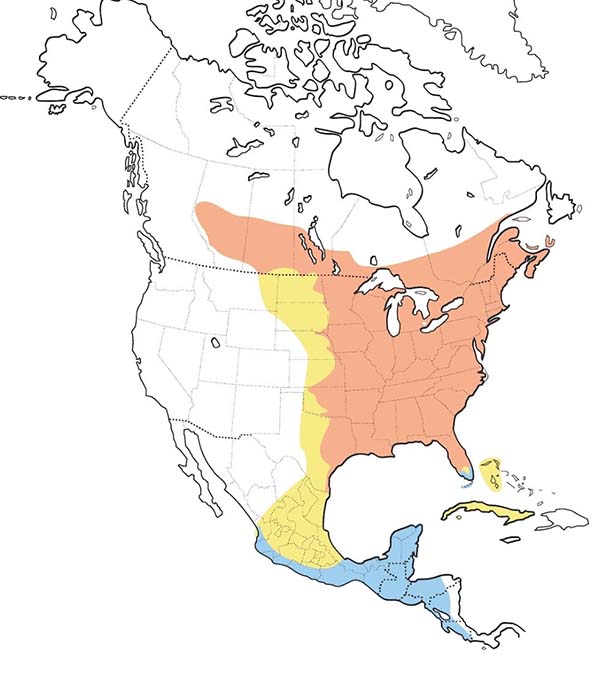
Sources:
- Ruby-throated Hummingbird. Audubon. (2021, October 20). Retrieved December 15, 2021, from https://www.audubon.org/field-guide/bird/ruby-throated-hummingbird

- Grid (counterclockwise):
- Male: Peter Hawrylyshyn / Macaulay Library at the Cornell Lab of Ornithology (ML356774791)
- Female: Alan Wells / Macaulay Library at the Cornell Lab of Ornithology (ML375382011)
- Juvenile: Kathy Stewart / Macaulay Library at the Cornell Lab of Ornithology (ML257529871)
- Nest/Eggs: / Macaulay Library at the Cornell Lab of Ornithology
- Range map provided by Birds of the World
Click here to lean more about Ruddy Duck
Ruddy Duck
Oxyura jamaicensis
An odd little diver, the main North American representative of the group of stiff-tailed ducks, with spiky tail feathers that are often cocked up in the air. Usually lethargic and seems reluctant to fly. On takeoff it must patter across the surface of the water to become airborne, then whirs along on rapidly beating wings. On land, it is almost helpless. Flocks of Ruddies wintering on lakes seldom mix freely with other ducks, although they may associate with American Coots.
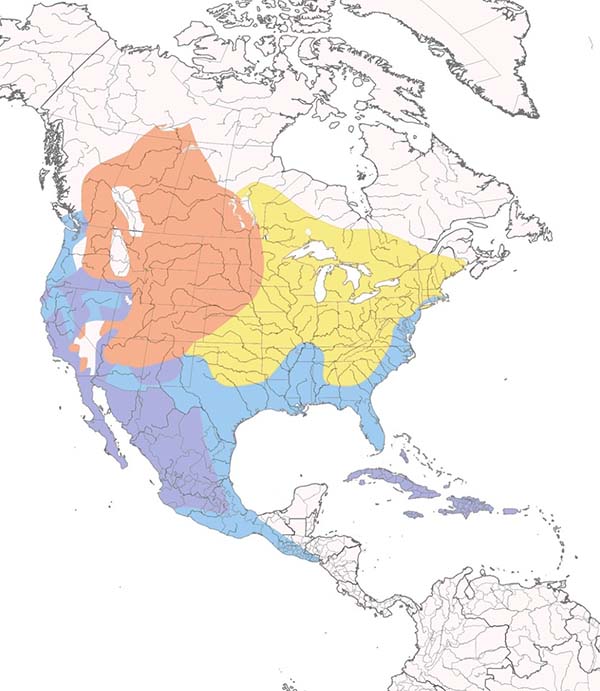
Sources:
- Ruddy Duck. Audubon. (2021, October 20). Retrieved December 15, 2021, from https://www.audubon.org/field-guide/bird/ruddy-duck
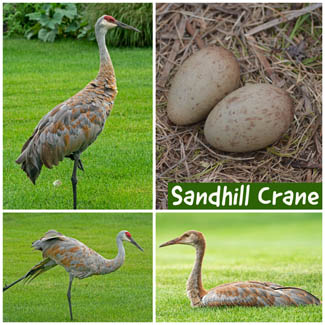
- Grid (counterclockwise):
- Male: Mike Losacco / Macaulay Library at the Cornell Lab of Ornithology (ML367419961)
- Female: Mike Losacco / Macaulay Library at the Cornell Lab of Ornithology (ML367419971)
- Juvenile: Mike Losacco / Macaulay Library at the Cornell Lab of Ornithology (ML356088311)
- Nest/Eggs: Cole Tiemann / Macaulay Library at the Cornell Lab of Ornithology (ML244536301)
- Range map provided by Birds of the World
Click here to lean more about Sandhill Crane
Sandhill Crane
Antigone canadensis
Found in several scattered areas of North America, Sandhill Cranes reach their peak abundance at migratory stopover points on the Great Plains. The early spring gathering of Sandhills on the Platte River in Nebraska is among the greatest wildlife spectacles on the continent, with over a quarter of a million birds present at one time. Although they are currently very common, their dependence on key stopover sites makes them vulnerable to loss of habitat in the future.
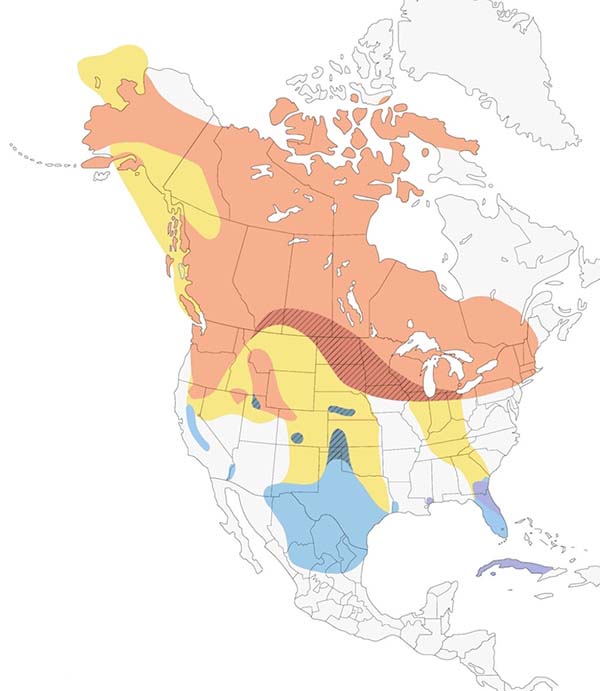
Sources:
- Sandhill Crane. Audubon. (2021, October 20). Retrieved December 15, 2021, from https://www.audubon.org/field-guide/bird/sandhill-crane
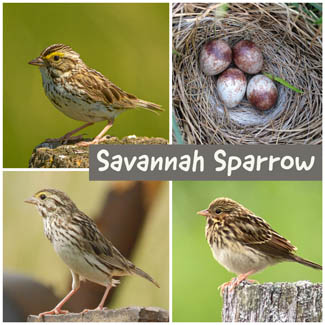
- Grid (counterclockwise):
- Male: bj worth / Macaulay Library at the Cornell Lab of Ornithology (ML249111501)
- Female: Becky Lutz / Macaulay Library at the Cornell Lab of Ornithology (ML246300771)
- Juvenile: Dominique Berteaux / Macaulay Library at the Cornell Lab of Ornithology (ML251507301)
- Nest/Eggs: Greg Lawrence / Macaulay Library at the Cornell Lab of Ornithology (ML45444801)
- Range map provided by Birds of the World
Click here to lean more about Savannah Sparrow
Savannah Sparrow
Passerculus sandwichensis
A small, streaky bird of open fields, the Savannah Sparrow often confuses birders because it is so variable. Some of its well-marked local forms, such as the pale "Ipswich" Sparrow of Atlantic beaches and the blackish "Belding's" Sparrow of western salt marshes, were once regarded as separate species. Unlike many grassland sparrows, Savannahs are not particularly shy; they often perch up on weeds or fence wires, and their small winter flocks usually can be observed with ease.
Savannah Sparrows have yellow lores and are heavily streaked and are uncommon in much of this area due to the limited amount of grassland habitat.
Fun fact: Did you know that the Savannah Sparrow gets its name, not for its affinity for grassland habitat but because Alexander Wilson collected the first individual in Savannah, Georgia?
Savannah Sparrows have yellow lores and are heavily streaked and are uncommon in much of this area due to the limited amount of grassland habitat.
Fun fact: Did you know that the Savannah Sparrow gets its name, not for its affinity for grassland habitat but because Alexander Wilson collected the first individual in Savannah, Georgia?
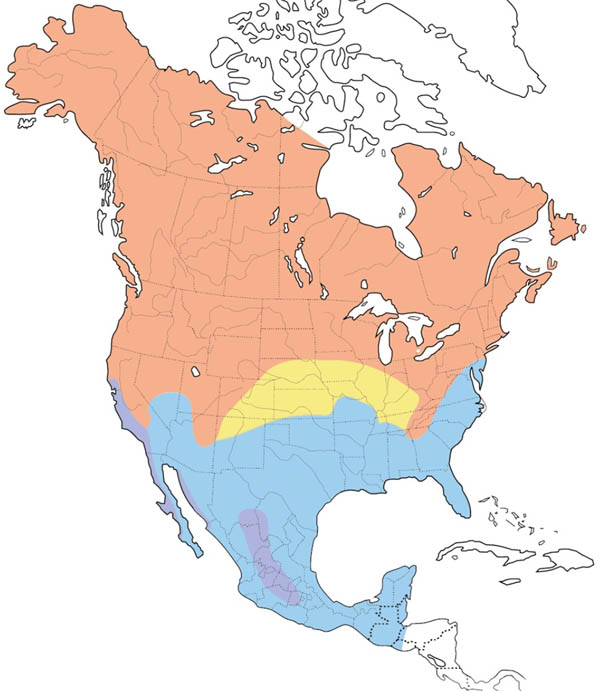
Sources:
- Powdermill Nature Reserve, Carnegie Museum of Natural History
- Savannah Sparrow. (2020, June 19). Audubon. https://www.audubon.org/field-guide/bird/savannah-sparrow
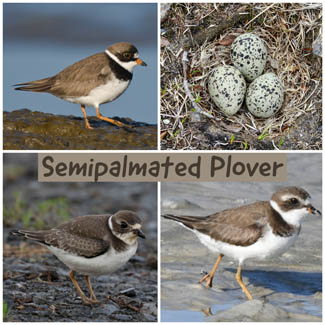
- Grid (counterclockwise):
- Male: Robert Lewis / Macaulay Library at the Cornell Lab of Ornithology (ML283418291)
- Female: barbara segal / Macaulay Library at the Cornell Lab of Ornithology (ML326649511)
- Juvenile: Jay McGowan / Macaulay Library at the Cornell Lab of Ornithology (ML382472821)
- Nest/Eggs: Michel Robert / Macaulay Library at the Cornell Lab of Ornithology (ML246503691)
- Range map provided by Birds of the World
Click here to lean more about Semipalmated Plover
Semipalmated Plover
Charadrius semipalmatus
The most common of the small plovers on migration through most areas. On its breeding grounds in the north, it avoids the tundra habitat chosen by most shorebirds, nesting instead on gravel bars along rivers or ponds. In such surroundings, its seemingly bold pattern helps to make the plover inconspicuous, by breaking up its outline against the varied background. The name 'semipalmated' refers to partial webbing between the bird's toes.
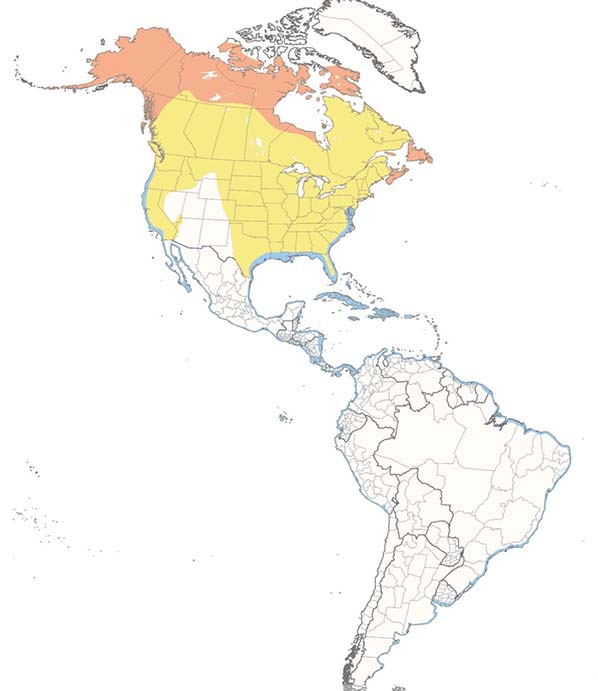
Sources:
- Semipalmated Plover,. Audubon. (2021, October 20). Retrieved December 15, 2021, from https://www.audubon.org/field-guide/bird/semipalmated-plover
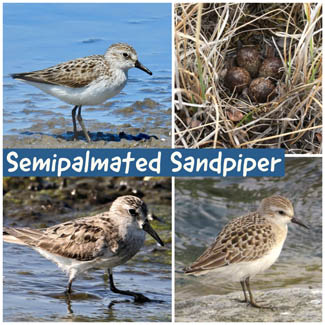
- Grid (counterclockwise):
- Male: Van Remsen / Macaulay Library at the Cornell Lab of Ornithology (ML330584341)
- Female: Jim Stasz / Macaulay Library at the Cornell Lab of Ornithology (ML118418981)
- Juvenile: Kaichi Huang / Macaulay Library at the Cornell Lab of Ornithology (ML366387991)
- Nest/Eggs: Adrian Burke / Macaulay Library at the Cornell Lab of Ornithology (ML349541051)
- Range map provided by Birds of the World
Click here to lean more about Semipalmated Sandpiper
Semipalmated Sandpiper
Calidris pusilla
Small and plain, this sandpiper is important in terms of sheer numbers. It often gathers by the thousands at stopover points during migration. Semipalmated Sandpipers winter mostly in South America, and studies have shown that they may make a non-stop flight of nearly 2000 miles from New England or eastern Canada to the South American coast. The name 'Semipalmated' refers to slight webbing between the toes, visible only at extremely close range.
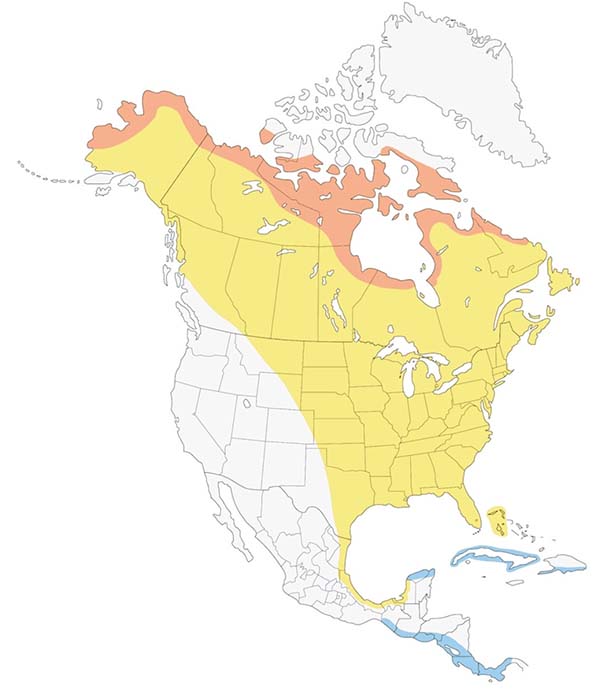
Sources:
- Semipalmated sandpiper. Audubon. (2021, October 20). Retrieved December 15, 2021, from https://www.audubon.org/field-guide/bird/semipalmated-sandpiper
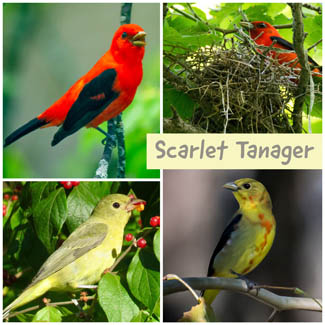
- Grid (counterclockwise):
- Male: Argustar Moore II / Macaulay Library at the Cornell Lab of Ornithology (ML271887771)
- Female: Gerry Hawkins / Macaulay Library at the Cornell Lab of Ornithology (ML267768251)
- Juvenile: Gabrielle Harrison / Macaulay Library at the Cornell Lab of Ornithology (ML271503461)
- Nest/Eggs: Lorri Howski / Macaulay Library at the Cornell Lab of Ornithology (ML30332961)
- Range map provided by Birds of the World
Click here to lean more about Scarlet Tanager
Scarlet Tanager
Piranga olivacea
Scarlet Tanagers are found in forests, usually high in trees. Sometimes they are hard to see, but their characteristic "chip-burr" note, along with a song that sounds a bit like a burry robin, help to locate these redder-than-red beauties! The Scarlet Tanager makes the journey between the eastern United States and lowland South American forests twice a year. During migration, the birds fly mostly at night, sometimes with other migratory birds such as the Cerulean Warbler and Wood Thrush.
Once on its wintering grounds, Scarlet Tanagers join mixed-species foraging flocks that may include flycatchers, woodcreepers, antbirds, and resident tanagers, and other songbirds. Like many other birds that migrate between North America and the tropics, the Scarlet Tanager's winter diet includes fruit in addition to insects, which are the mainstay of its summer fare.
Once on its wintering grounds, Scarlet Tanagers join mixed-species foraging flocks that may include flycatchers, woodcreepers, antbirds, and resident tanagers, and other songbirds. Like many other birds that migrate between North America and the tropics, the Scarlet Tanager's winter diet includes fruit in addition to insects, which are the mainstay of its summer fare.
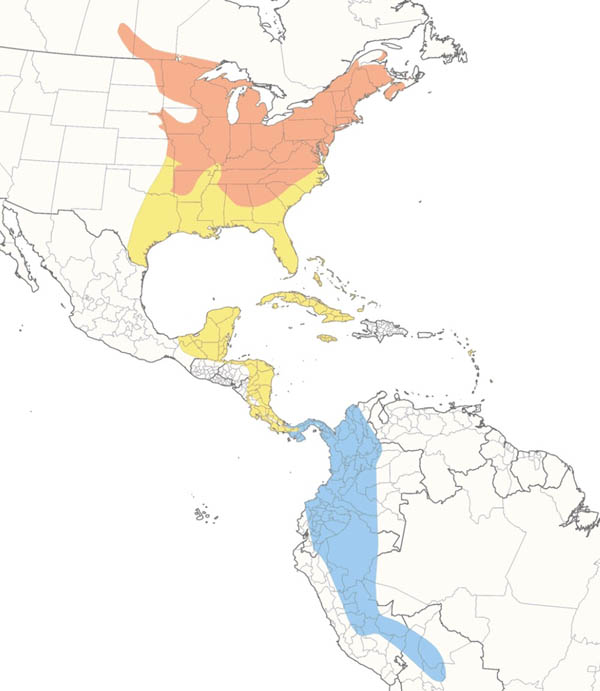
Sources:
- American Bird Conservancy. (2020e, September 4). Scarlet Tanager. https://abcbirds.org/bird/scarlet-tanager/
- Powdermill Nature Reserve, Carnegie Museum of Natural History
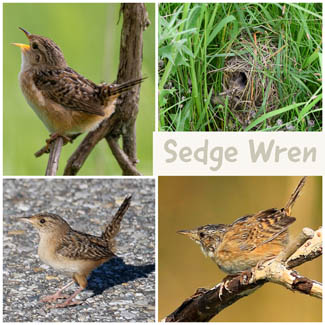
- Grid (counterclockwise):
- Male: Graham Deese / Macaulay Library at the Cornell Lab of Ornithology (ML241188711)
- Female: Russ Smiley / Macaulay Library at the Cornell Lab of Ornithology (ML106717421)
- Juvenile: Philip Odum / Macaulay Library at the Cornell Lab of Ornithology (ML264932291)
- Nest/Eggs: Ricardo Arredondo / Macaulay Library at the Cornell Lab of Ornithology (ML117848391)
- Range map provided by Birds of the World
Click here to lean more about Sedge Wren
Sedge Wren
Cistothorus platensis
Related to the Marsh Wren but different in some key habits, the Sedge Wren is a rather mysterious creature for many birders. It is often hard to see as it creeps about in damp sedge meadows of the east and Midwest, occasionally coming up to give its dry rattling song. As a summer resident, it is oddly erratic in many areas, showing up and breeding one summer and then vanishing again. Overall, its numbers seem to be gradually declining.
Sedge wrens breed in sedge (hence the name), wet meadows, and short grassy fields or marshes; a habitat which has largely been threatened by development and large-scale agriculture. In North America, sedge wrens primarily breed in the Midwest and southern Ontario-Saskatchewan and are rarely found in Pennsylvania. There are many unconnected populations of sedge wrens throughout the Americas.
Sedge wrens breed in sedge (hence the name), wet meadows, and short grassy fields or marshes; a habitat which has largely been threatened by development and large-scale agriculture. In North America, sedge wrens primarily breed in the Midwest and southern Ontario-Saskatchewan and are rarely found in Pennsylvania. There are many unconnected populations of sedge wrens throughout the Americas.

Sources:
- Powdermill Nature Reserve, Carnegie Museum of Natural History
- Sedge Wren. (2020, January 28). Audubon. https://www.audubon.org/field-guide/bird/sedge-wren
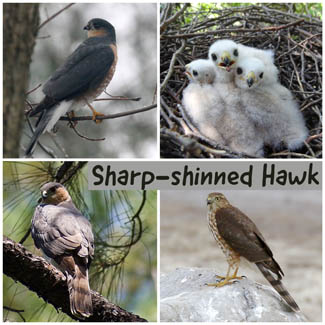
- Grid (counterclockwise):
- Male: Kevin McGowan / Macaulay Library at the Cornell Lab of Ornithology (ML298356331)
- Female: Roberto Jovel / Macaulay Library at the Cornell Lab of Ornithology (ML353417921)
- Juvenile: Jon Isacoff / Macaulay Library at the Cornell Lab of Ornithology (ML370561921)
- Nest/Eggs: Nicolas Bernier / Macaulay Library at the Cornell Lab of Ornithology (ML20913471)
- Range map provided by Birds of the World
Click here to lean more about Sharp-shinned Hawk
Sharp-shinned Hawk
Accipiter striatus
The smallest of our bird-hunting Accipiter hawks, this one is also the most migratory, breeding north to the tree line in Alaska and Canada and wintering south to Panama. It is during migration that the Sharp-shin is most likely to be seen in numbers, with dozens or even hundreds passing at some favored points on coastlines, lakeshores, and mountain ridges. At other seasons the hawks lurk in the woods, ambushing songbirds and generally staying out of sight.
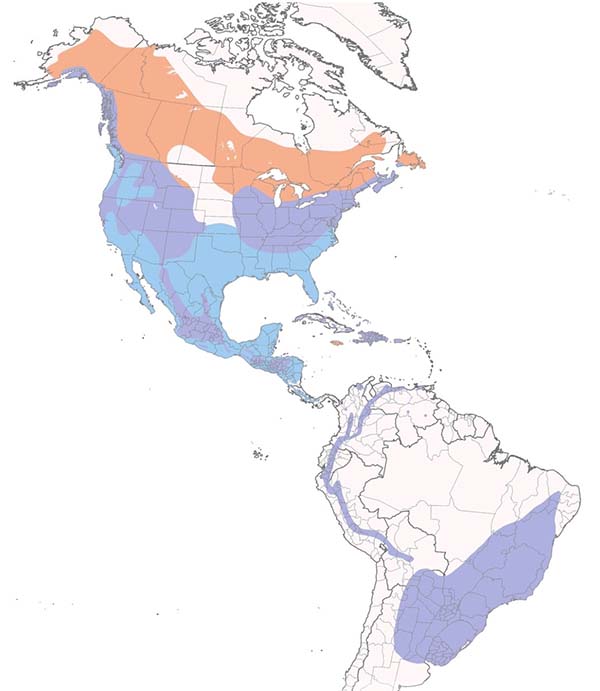
Sources:
- Sharp-Shinned Hawk. Audubon. (2021, October 20). Retrieved December 15, 2021, from https://www.audubon.org/field-guide/bird/sharp-shinned-hawk

- Grid (counterclockwise):
- Male: Maurizio Ravasini / Macaulay Library at the Cornell Lab of Ornithology (ML204341461)
- Female: John Gordinier / Macaulay Library at the Cornell Lab of Ornithology (ML88849571)
- Juvenile: James Kennerley / Macaulay Library at the Cornell Lab of Ornithology (ML168138781)
- Nest/Eggs: Stephen Bailey / Macaulay Library at the Cornell Lab of Ornithology (ML274762311)
- Range map provided by Birds of the World
Click here to lean more about Short-eared Owl
Short-eared Owl
Asio flammeus
Easier to see than most owls, the Short-ear lives in open terrains, such as prairies and marshes. It is often active during daylight, especially in the evening. When hunting it flies low over the fields, with buoyant, floppy wingbeats, looking rather like a giant moth. Aside from its North American range, it also nests in South America and Eurasia, and on many oceanic islands, including Hawaii. These tufts sometimes lend themselves to the owls’ names, like Great Horned Owl, Short-eared Owl, and Long-eared Owl. But these feather tufts are neither ears nor are they horns – they’re long feathers that serve as camouflage or as a communication tool (perhaps to signal to mate or to display in territorial disputes). These tufts aren’t even very close to owl ears, which are on the sides of the bird’s head and are asymmetrically situated. This asymmetry allows the owl to hear a sound at slightly different times which is an important characteristic that makes owls such effective nocturnal predators!

Sources:
- Powdermill Nature Reserve, Carnegie Museum of Natural History
- Short-eared owl. Audubon. (2021, October 20). Retrieved December 15, 2021, from https://www.audubon.org/field-guide/bird/short-eared-owl
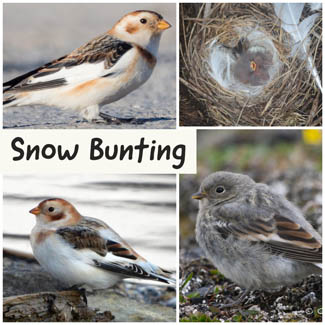
- Grid (counterclockwise):
- Male: Yeray Seminario / Macaulay Library at the Cornell Lab of Ornithology (ML248378561)
- Female: Thomas Kirby / Macaulay Library at the Cornell Lab of Ornithology (ML277376161)
- Juvenile: Christophe Gouraud / Macaulay Library at the Cornell Lab of Ornithology (ML205194151)
- Nest/Eggs: Cole Tiemann / Macaulay Library at the Cornell Lab of Ornithology (ML244546141)
- Range map provided by Birds of the World
Click here to lean more about Snow Bunting
Snow Bunting
Plectrophenax nivalis
The aptly named Snow Bunting is a bird of extremes. It may look like a feathered snowflake, but do not let its small size and immaculate white feathers fool you: The Snow Bunting is a tough survivor that breeds on the tundra in sub-zero temperatures. It is also the most northerly recorded passerine in the world.
One of the Snow Bunting's most obvious adaptations to its extreme environment is its color. Like the Snowy Owl, Arctic Hare, Arctic Fox, Polar Bear, and ptarmigans, its mostly white coloration serves as effective camouflage in its open, snow-covered habitat. Snow Buntings also have feathering on their ankles, an adaptation providing added warmth on the high Arctic tundra of North America, Europe, and Russia.
Even though Snow Bunting migrate southward to avoid the worst of the Arctic winter, they seldom stray far from cold temperatures. It is of little wonder one of this bird's nicknames is "snowflake!" Snow Buntings live in harsh conditions of the high Arctic, only coming couth during the winter. Males arrive on the breeding grounds weeks before the females to establish high-quality territories. The male Snow Bunting feeds his mate while she incubates the eggs, helping ensure that the eggs will hatch despite the cold arctic conditions.
One of the Snow Bunting's most obvious adaptations to its extreme environment is its color. Like the Snowy Owl, Arctic Hare, Arctic Fox, Polar Bear, and ptarmigans, its mostly white coloration serves as effective camouflage in its open, snow-covered habitat. Snow Buntings also have feathering on their ankles, an adaptation providing added warmth on the high Arctic tundra of North America, Europe, and Russia.
Even though Snow Bunting migrate southward to avoid the worst of the Arctic winter, they seldom stray far from cold temperatures. It is of little wonder one of this bird's nicknames is "snowflake!" Snow Buntings live in harsh conditions of the high Arctic, only coming couth during the winter. Males arrive on the breeding grounds weeks before the females to establish high-quality territories. The male Snow Bunting feeds his mate while she incubates the eggs, helping ensure that the eggs will hatch despite the cold arctic conditions.
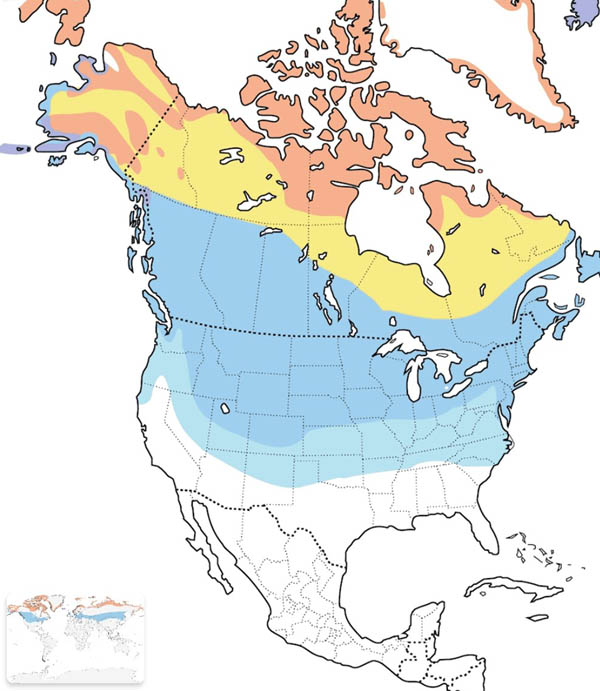
Sources:
- American Bird Conservancy. (2020n, December 28). Snow Bunting. https://abcbirds.org/bird/snow-bunting/
- Snow Bunting. (n.d.). Retrieved May 03, 2021, from https://www.birdzilla.com/birds/Snow-Bunting/description.html
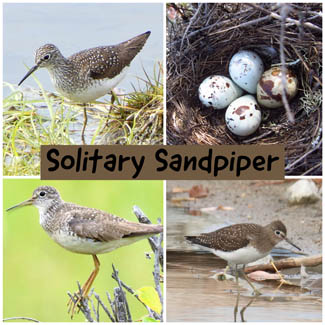
- Grid (counterclockwise):
- Male: Randall M / Macaulay Library at the Cornell Lab of Ornithology (ML157102021)
- Female: Roy Lambert / Macaulay Library at the Cornell Lab of Ornithology (ML104566271)
- Juvenile: Chris Charlesworth / Macaulay Library at the Cornell Lab of Ornithology (ML364527621)
- Nest/Eggs: Réjean Deschênes / Macaulay Library at the Cornell Lab of Ornithology
- Range map provided by Birds of the World
Click here to lean more about Solitary Sandpiper
Solitary Sandpiper
Tringa solitaria
Almost all sandpipers migrate in flocks and nest on the ground, but the Solitary Sandpiper breaks both rules. In migration, as its name implies, it is usually encountered alone, along the bank of some shady creek. If approached, it bobs nervously, then flies away with sharp whistled cries. In summer in the northern spruce bogs, rather than nesting on the wet ground, the Solitary Sandpiper lays its eggs in old songbird nests placed high in trees.
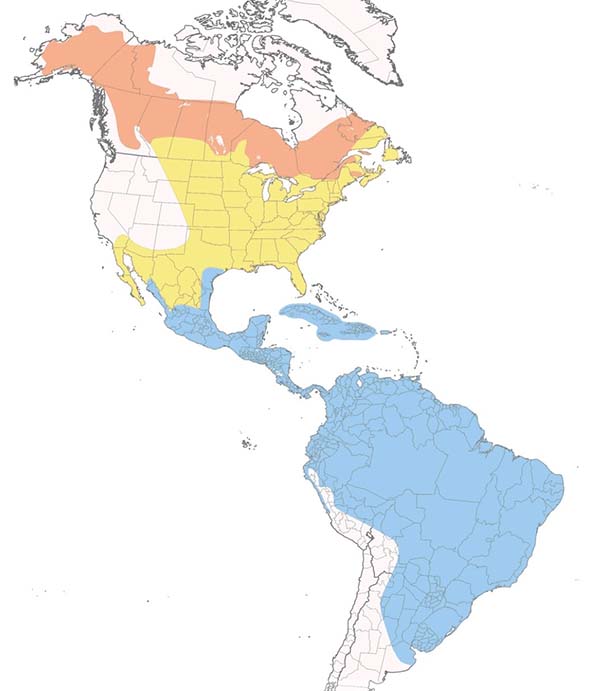
Sources:
- Solitary sandpiper. Audubon. (2021, October 20). Retrieved December 15, 2021, from https://www.audubon.org/field-guide/bird/solitary-sandpiper

- Grid (counterclockwise):
- Male: Michael Stubblefield / Macaulay Library at the Cornell Lab of Ornithology (ML278732651)
- Female: Bill Brown / Macaulay Library at the Cornell Lab of Ornithology (ML218187001)
- Juvenile: Yves Scholten / Macaulay Library at the Cornell Lab of Ornithology (ML271250791)
- Nest/Eggs: Corey Lange / Macaulay Library at the Cornell Lab of Ornithology (ML100657091)
- Range map provided by Birds of the World
Click here to lean more about Song Sparrow
Song Sparrow
Melospiza melodia
At first glance, the Song Sparrow is a typical "little brown job," a term sometimes bestowed by frustrated birders on species in the large, often look-alike sparrow family. The Song Sparrow is one of the most common and visible species. It has heavy streaking on the underparts and a distinct tie tack in the center of the breast.
The Song Sparrow lives up to its name, singing persistently throughout the year. Its song consists of three to four short notes followed by a varied trill, sometimes represented as "maids, maids, maids, put on your teakettle-ettle-ettle ettle." Its call is a loud, distinctive "chimp."
Most males sing six to 24 variations of this tune, sometimes as often as five to ten times per minute when establishing territories in the spring. Research shows that females, which sing much less frequently, are attracted to the variability and uniqueness of an individual male's song.
Young male Song Sparrows develop unique song patterns, which they learn by listening to and copying the songs of adult males nearby. Songs become more complex as the young bird matures, then attempts to establish a breeding territory the following spring. Ultimately, each male develops his own musical repertoire.
The Song Sparrow lives up to its name, singing persistently throughout the year. Its song consists of three to four short notes followed by a varied trill, sometimes represented as "maids, maids, maids, put on your teakettle-ettle-ettle ettle." Its call is a loud, distinctive "chimp."
Most males sing six to 24 variations of this tune, sometimes as often as five to ten times per minute when establishing territories in the spring. Research shows that females, which sing much less frequently, are attracted to the variability and uniqueness of an individual male's song.
Young male Song Sparrows develop unique song patterns, which they learn by listening to and copying the songs of adult males nearby. Songs become more complex as the young bird matures, then attempts to establish a breeding territory the following spring. Ultimately, each male develops his own musical repertoire.
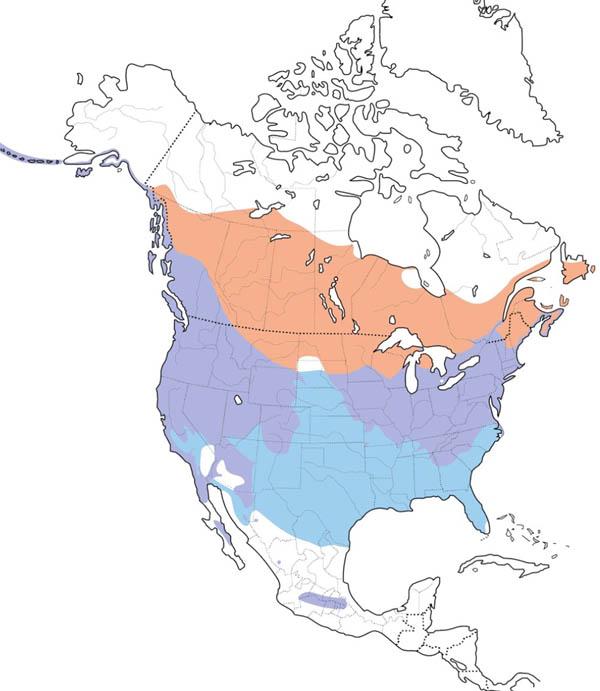
Sources:
- American Bird Conservancy. (2020a, January 16). Song Sparrow. https://abcbirds.org/bird/song-sparrow/
- Powdermill Nature Reserve, Carnegie Museum of Natural History

- Grid (counterclockwise):
- Male: Gary Mueller / Macaulay Library at the Cornell Lab of Ornithology (ML229828561)
- Female: Kathy Marche / Macaulay Library at the Cornell Lab of Ornithology (ML355671151)
- Juvenile: Chris Wilson / Macaulay Library at the Cornell Lab of Ornithology (ML371052231)
- Nest/Eggs: Shane Sater / Macaulay Library at the Cornell Lab of Ornithology (ML247293341)
- Range map provided by Birds of the World
Click here to lean more about Spotted Sandpiper
Spotted Sandpiper
Actitis macularius
Most sandpipers nest only in the far north, but the little 'Spotty' is common in summer over much of North America. As it walks on the shores of streams, ponds, and marshes, it bobs the rear half of its body up and down in an odd teetering motion. When startled, it skims away low over the water, with rapid bursts of shallow wingbeats and short, stiff-winged glides. Even where it is common, it is seldom seen in flocks.
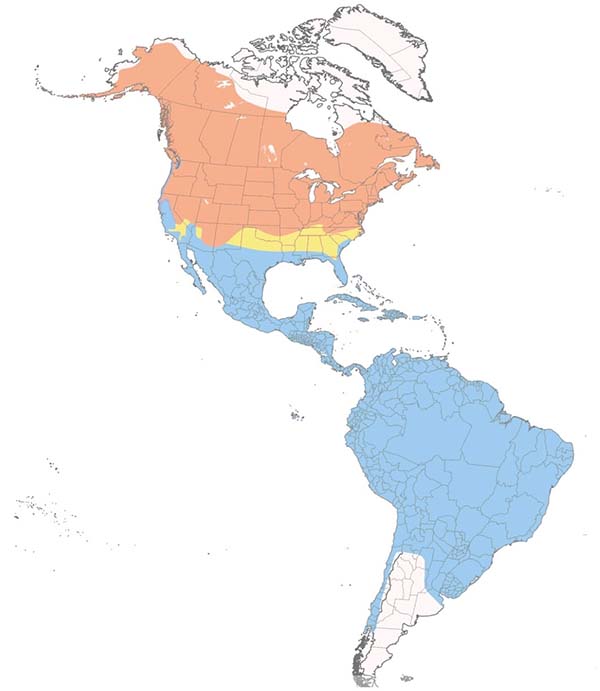
Sources:
- Spotted sandpiper. Audubon. (2021, October 20). Retrieved December 15, 2021, from https://www.audubon.org/field-guide/bird/spotted-sandpiper

- Grid (counterclockwise):
- Male: Jorge Córdova / Macaulay Library at the Cornell Lab of Ornithology (ML277517391)
- Female: Erin Nadeau / Macaulay Library at the Cornell Lab of Ornithology (ML164239761)
- Juvenile: Charles Thomas / Macaulay Library at the Cornell Lab of Ornithology (ML358041671)
- Nest/Eggs: Jim Lind / Macaulay Library at the Cornell Lab of Ornithology (ML36736491)
- Range map provided by Birds of the World
Click here to lean more about Swainson's Thrush
Swainson's Thrush
Catharus ustulatus
During the peak of migration, Swainson's Thrushes are often very common in woodlots and parks, lurking in the thickets, slipping into fruiting trees to pluck berries. Although they tend to stay out of sight, the patient birder eventually can see them well enough to discern the bold buffy eye-rings that give these birds their alert or startled look. Like the other brown thrushes, Swainson's migrate mostly at night, and their distinctive call notes can be heard from overhead on clear nights during spring and fall.
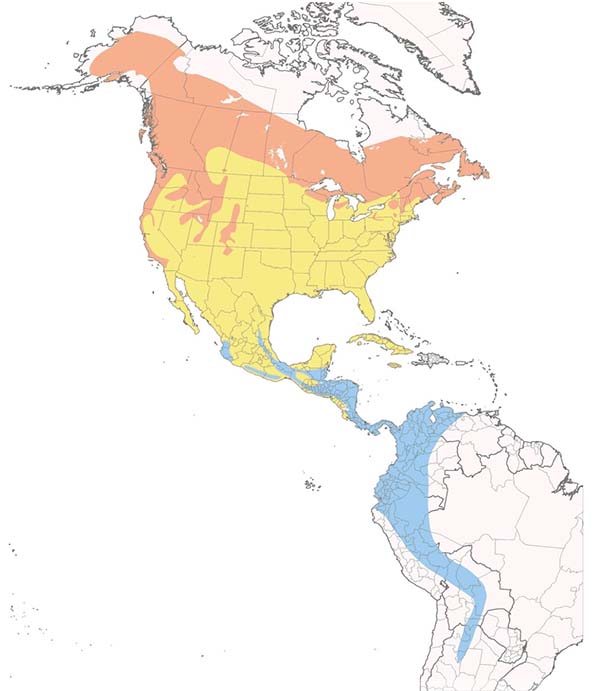
Sources:
- Swainson's Thrush. Audubon. (2021, October 20). Retrieved December 15, 2021, from https://www.audubon.org/field-guide/bird/swainsons-thrush
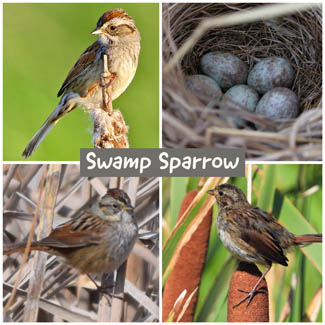
- Grid (counterclockwise):
- Male: Jack & Holly Bartholmai / Macaulay Library at the Cornell Lab of Ornithology (ML240468331)
- Female: Austin Broadwater / Macaulay Library at the Cornell Lab of Ornithology (ML51553571)
- Juvenile: Doug Emlin / Macaulay Library at the Cornell Lab of Ornithology (ML257330451)
- Nest/Eggs: Thomas Schultz / Macaulay Library at the Cornell Lab of Ornithology (ML43032941)
- Range map provided by Birds of the World
Click here to lean more about Swamp Sparrow
Swamp Sparrow
Melospiza georgiana
The Swamp Sparrow is often dismissed as a "little brown job." Swamps are unstreaked and have a warm reddish wash to the crown. A closer look reveals a bird richly colored in earthy tones of russet, brown, and cool gray, set off by a white throat and reddish cap. This shy bird is more often heard than seen; its song, a slow, sweet trill, has a liquid quality evocative of its marshy habitat.
Swamp Sparrows can be found throughout the eastern United States and boreal Canada, preferring marshes with tall vegetation and scattered shrubs. This bird is a short-distance migrant, only moving as far south as central Mexico, with much of the population wintering in the southeastern United States. Although it does not fly far, it faces the same threats as birds that travel long distances. Many migrating Swamp Sparrows are killed by collisions with communication towers, and like most migratory songbirds, they are preyed upon by outdoor cats.
Swamp Sparrows can be found throughout the eastern United States and boreal Canada, preferring marshes with tall vegetation and scattered shrubs. This bird is a short-distance migrant, only moving as far south as central Mexico, with much of the population wintering in the southeastern United States. Although it does not fly far, it faces the same threats as birds that travel long distances. Many migrating Swamp Sparrows are killed by collisions with communication towers, and like most migratory songbirds, they are preyed upon by outdoor cats.

Sources:
- American Bird Conservancy. (2020h, July 20). Swamp Sparrow. https://abcbirds.org/bird/swamp-sparrow/
- Powdermill Nature Reserve, Carnegie Museum of Natural History
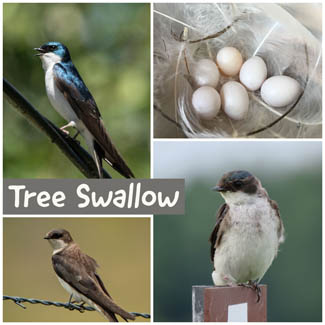
- Grid (counterclockwise):
- Male: Eric VanderWerf / Macaulay Library at the Cornell Lab of Ornithology (ML250827681)
- Female: bj worth / Macaulay Library at the Cornell Lab of Ornithology (ML244350371)
- Juvenile: Jonah Brian / Macaulay Library at the Cornell Lab of Ornithology (ML264082041)
- Nest/Eggs: Jennifer Wenzel / Macaulay Library at the Cornell Lab of Ornithology (ML29111141)
- Range map provided by Birds of the World
Click here to lean more about Tree Swallow
Tree Swallow
Tachycineta bicolor
The elegant, eye-catching Tree Swallow is a welcome sign of spring in much of North America. Although named for its habit of nesting in tree cavities, this medium-sized swallow is most often seen in open spaces such as wetlands or farm fields. This species is seen gracefully swooping and diving over ponds.
Male Tree Swallows have shining blue-green plumage on their backs and contrasting gleaming white underparts. Females are less colorful, their backs ranging from dull greenish-brown to almost as shining as the males'. Immatures are flat gray, brown above, with little or no iridescence.
Tree Swallows are secondary cavity nesters like Eastern Bluebirds and will even use bluebird nest boxes if they can. Tree swallows will take their prey and drinks of water while flying ("on the wing") and are the earliest swallow to return to the northern US.
Male Tree Swallows have shining blue-green plumage on their backs and contrasting gleaming white underparts. Females are less colorful, their backs ranging from dull greenish-brown to almost as shining as the males'. Immatures are flat gray, brown above, with little or no iridescence.
Tree Swallows are secondary cavity nesters like Eastern Bluebirds and will even use bluebird nest boxes if they can. Tree swallows will take their prey and drinks of water while flying ("on the wing") and are the earliest swallow to return to the northern US.
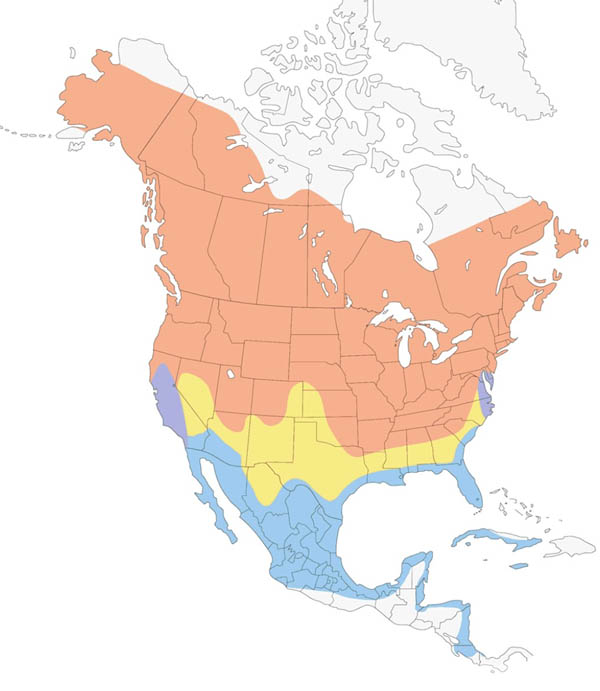
Sources:
- American Bird Conservancy. (2021a, March 5). Tree Swallow. https://abcbirds.org/bird/tree-swallow/
- Powdermill Nature Reserve, Carnegie Museum of Natural History
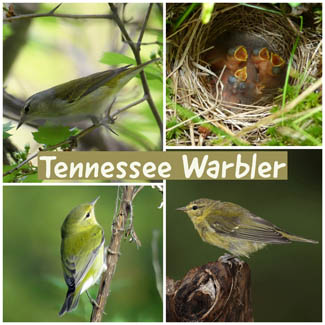
- Grid (counterclockwise):
- Male: Bobby Nadeau / Macaulay Library at the Cornell Lab of Ornithology (ML340840401)
- Female: Eric D Gyllenhaal / Macaulay Library at the Cornell Lab of Ornithology (ML258521921)
- Juvenile: Josée Rousseau / Macaulay Library at the Cornell Lab of Ornithology (ML171771381)
- Nest/Eggs: Jim Lind / Macaulay Library at the Cornell Lab of Ornithology (ML129766761)
- Range map provided by Birds of the World
Click here to lean more about Tennessee Warbler
Tennessee Warbler
Leiothlypis peregrina
This bird is found in Tennessee only briefly, during spring and fall migration; but there is no point in giving it a more descriptive name because the bird itself is nondescript. The male makes up for his plain appearance with a strident staccato song, surprisingly loud for the size of the bird. Nesting in northern forests, the Tennessee Warbler goes through population cycles: it often becomes very numerous during population explosions of the spruce budworm, a favored food.
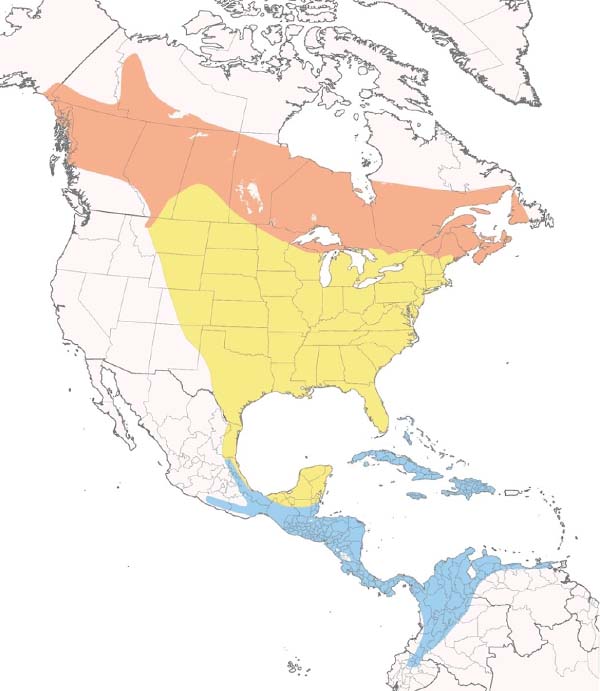
Sources:
- Tennessee warbler. Audubon. (2021, October 20). Retrieved December 15, 2021, from https://www.audubon.org/field-guide/bird/tennessee-warbler
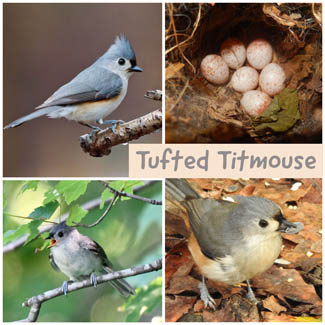
- Grid (counterclockwise):
- Male: Jack & Holly Bartholmai / Macaulay Library at the Cornell Lab of Ornithology (ML214835581)
- Female: Dave Milsom / Macaulay Library at the Cornell Lab of Ornithology (ML41502851)
- Juvenile: Adam Cunningham / Macaulay Library at the Cornell Lab of Ornithology (ML247759641)
- Nest/Eggs: Eric Cormier / Macaulay Library at the Cornell Lab of Ornithology (ML96607771)
- Range map provided by Birds of the World
Click here to lean more about Tufted Titmouse
Tufted Titmouse
Baeolophus bicolor
The active and agile Tufted Titmouse is easily recognized by its jaunty crest of gray feathers, big black eyes, and rust-colored flanks. This familiar bird feeder visitor often joins mixed foraging flocks with other common backyard birds.
Small birds with a big attitude, members of this species are not shy about accepting free food. A Tufted Titmouse is a frequent flyer at feeders. You may wonder, is that the SAME titmouse that you see raiding your feeders all morning? Probably not! The Tufted Titmice at your feeders might have been there yesterday, or maybe not. In any case, have fun watching them! Tufted Titmice have squared-off tongues. They are vocal birds, with the bonus of being nippers.
The Tufted Titmouse's name derives from the Old English words "tit" and "mase," basically meaning "small bird." The word "mase" eventually became obsolete and this part of the name morphed into the familiar word "mouse," a convenient switch because the quick-moving little gray bird probably reminded people of the small rodent. The Tufted Titmouse's genus name Baeolophus hails from two Greek words for "small" and "crest."
Small birds with a big attitude, members of this species are not shy about accepting free food. A Tufted Titmouse is a frequent flyer at feeders. You may wonder, is that the SAME titmouse that you see raiding your feeders all morning? Probably not! The Tufted Titmice at your feeders might have been there yesterday, or maybe not. In any case, have fun watching them! Tufted Titmice have squared-off tongues. They are vocal birds, with the bonus of being nippers.
The Tufted Titmouse's name derives from the Old English words "tit" and "mase," basically meaning "small bird." The word "mase" eventually became obsolete and this part of the name morphed into the familiar word "mouse," a convenient switch because the quick-moving little gray bird probably reminded people of the small rodent. The Tufted Titmouse's genus name Baeolophus hails from two Greek words for "small" and "crest."
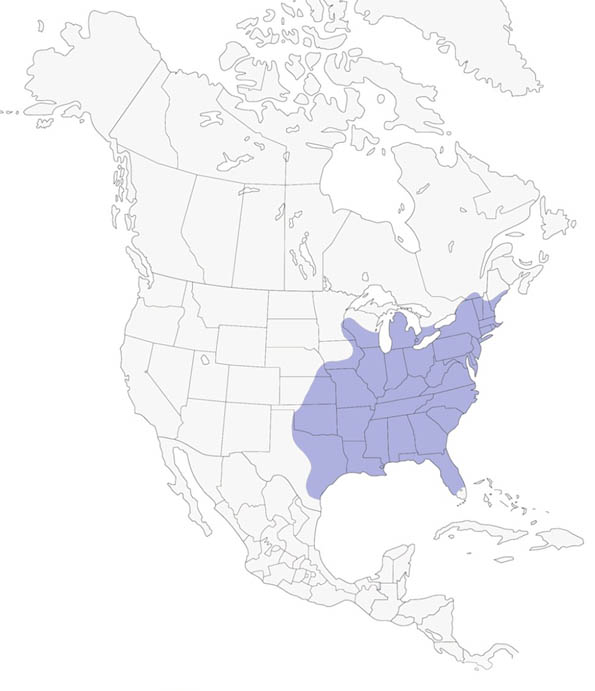
Sources:
- American Bird Conservancy. (2020a, September 3). Tufted Titmouse. https://abcbirds.org/bird/tufted-titmouse/
- Powdermill Nature Reserve, Carnegie Museum of Natural History
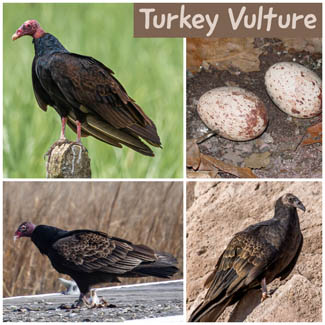
- Grid (counterclockwise):
- Male: Steve McInnis / Macaulay Library at the Cornell Lab of Ornithology (ML316692451)
- Female: David Monroy Rengifo / Macaulay Library at the Cornell Lab of Ornithology (ML380774421)
- Juvenile: Matthew Pendleton / Macaulay Library at the Cornell Lab of Ornithology (ML374121921)
- Nest/Eggs: Kristof Zyskowski / Macaulay Library at the Cornell Lab of Ornithology (ML260093381) Map: Range map provided by Birds of the World
- Range map provided by Birds of the World
Click here to lean more about Turkey Vulture
Turkey Vulture
Cathartes aura
A familiar sight in the sky over much of North America is the dark, long-winged form of the Turkey Vulture, soaring high over the landscape. Most birds are believed to have a very poor sense of smell, but the Turkey Vulture is an exception, apparently able to find carrion by odor.
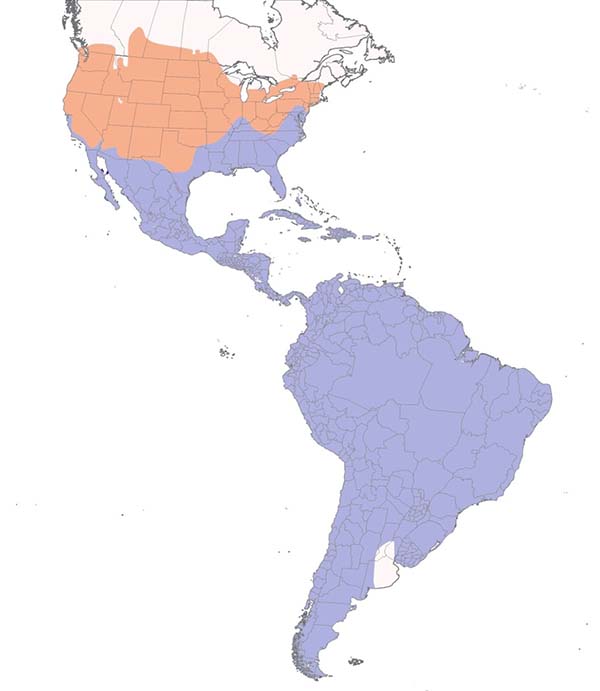
Sources:
- Turkey Vulture. Audubon. (2021, October 20). Retrieved December 15, 2021, from https://www.audubon.org/field-guide/bird/turkey-vulture
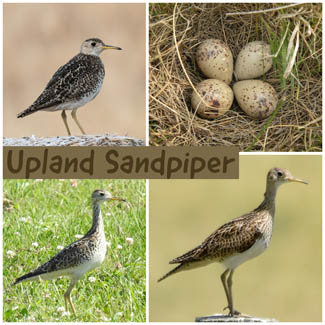
- Grid (counterclockwise):
- Male: Connor Bowhay / Macaulay Library at the Cornell Lab of Ornithology (ML378705381)
- Female: Barbara N. Charlton / Macaulay Library at the Cornell Lab of Ornithology (ML247798011)
- Juvenile: Steven Mlodinow / Macaulay Library at the Cornell Lab of Ornithology (ML105112181)
- Nest/Eggs: Alyssa DeRubeis / Macaulay Library at the Cornell Lab of Ornithology (ML232606721)
- Range map provided by Birds of the World
Click here to lean more about Upland Sandpiper
Upland Sandpiper
Bartramia longicauda
The ghostly, breathy whistle of the Upland Sandpiper is one of the characteristic sounds of spring on the northern Great Plains. The bird sings sometimes from the tops of fenceposts or poles, but often on the wing, flying high with shallow, fluttering wingbeats. When it lands, it may be hard to see in the tall grass of its typical habitat. Because of its short bill and round-headed shape, was once called 'Upland Plover,' but it is a true sandpiper and a close relative of the curlews.
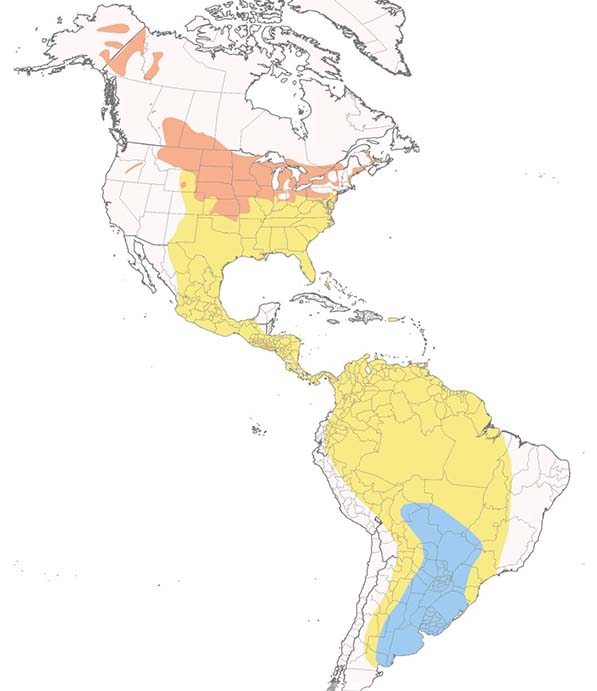
Sources:
- Upland sandpiper. Audubon. (2021, October 20). Retrieved December 15, 2021, from https://www.audubon.org/field-guide/bird/upland-sandpiper
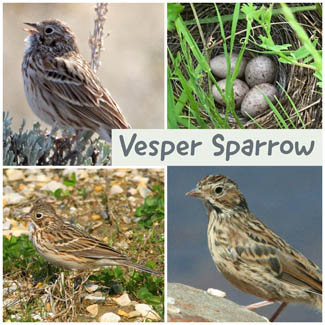
- Grid (counterclockwise):
- Male: Don Marsh / Macaulay Library at the Cornell Lab of Ornithology (ML224448711)
- Female: Ken Schneider / Macaulay Library at the Cornell Lab of Ornithology (ML61896561)
- Juvenile: Debby Parker / Macaulay Library at the Cornell Lab of Ornithology (ML139468891)
- Nest/Eggs: Joseph Blowers / Macaulay Library at the Cornell Lab of Ornithology (ML159408861)
- Range map provided by Birds of the World
Click here to lean more about Vesper Sparrow
Vesper Sparrow
Pooecetes gramineus
The Vesper Sparrow's sweet song, a combination of clear whistles and trills, can often be heard at twilight — roughly the same time as Catholic vespers services, which earned the bird its name. Some would call this species a "little brown job" briefly, but with a keen eye, it is not difficult to note a few distinguishing features: Vesper Sparrows have white outer tail feathers that are obvious when they fly away, a white eye-ring, and warm chestnut "shoulders" (this area is the wrist joint on a bird!).
Vesper Sparrows are adaptable; for example, they may nest on reclaimed mine sites or in newly burned areas. But their overall population is declining due to habitat loss on both breeding and wintering grounds. Modern farming practices, including pesticide use, hedgerow clearing, and early hay harvesting, have also been detrimental to this species.
Vesper Sparrows are declining in the East due to habitat loss and are listed in the Pennsylvania Wildlife Action Plan as a "Species of Greatest Conservation Need."
Vesper Sparrows are adaptable; for example, they may nest on reclaimed mine sites or in newly burned areas. But their overall population is declining due to habitat loss on both breeding and wintering grounds. Modern farming practices, including pesticide use, hedgerow clearing, and early hay harvesting, have also been detrimental to this species.
Vesper Sparrows are declining in the East due to habitat loss and are listed in the Pennsylvania Wildlife Action Plan as a "Species of Greatest Conservation Need."
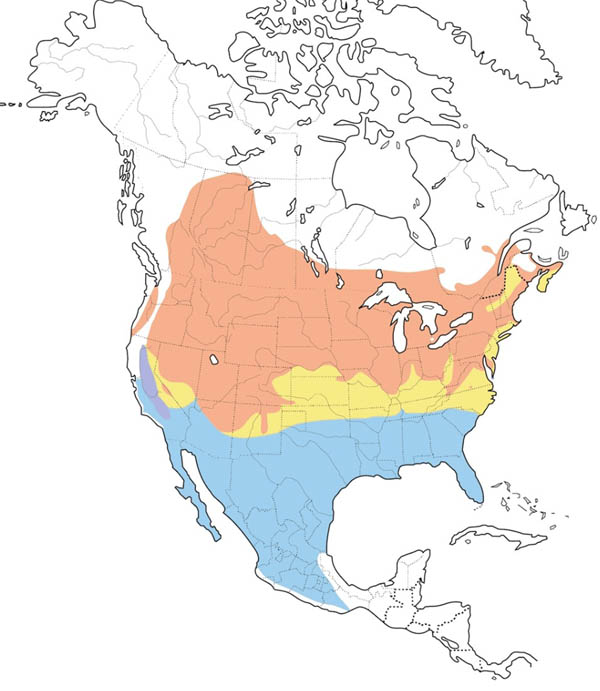
Sources:
- American Bird Conservancy. (2020d, June 25). Vesper Sparrow: Bird of the Week is an Evening Songster. https://abcbirds.org/bird/vesper-sparrow
- Powdermill Nature Reserve, Carnegie Museum of Natural History
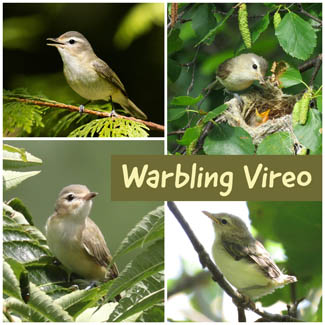
- Grid (counterclockwise):
- Male: mark daly / Macaulay Library at the Cornell Lab of Ornithology (ML247290411)
- Female: Wendy Howes / Macaulay Library at the Cornell Lab of Ornithology (ML109871871)
- Juvenile: Teresa Dolman / Macaulay Library at the Cornell Lab of Ornithology (ML253765801)
- Nest/Eggs: Timothy Forrester / Macaulay Library at the Cornell Lab of Ornithology (ML252576141)
- Range map provided by Birds of the World
Click here to lean more about Warbling Vireo
Warbling Vireo
Vireo gilvus
The confiding, acrobatic, White-breasted Nuthatch delights many a backyard birder with its head-down antics and nasal calls. Sometimes described as the "upside-down bird" or " wall walker," this agile little songbird is often seen in the company of other familiar species such as the Downy Woodpecker, Northern Cardinal, and Black-capped Chickadee. Nuthatches, particularly White-breasted, move up and down tree trunks and branches, often head down, as they search for food items in the crevices of bark.
The word "nuthatch" derives from "nut-hack," an old English word likely first ascribed to the related Eurasian Nuthatch. This evocative word describes an unusual method of feeding shared by all nuthatch species. These birds wedge their food — nuts, seeds, or insects — into bark crevices, then hammer or "hack" at the food with their strong bills to tear it apart. All nuthatches have chisel-shaped beaks, which they use to chisel pieces of bark in their search for insects and cached food items. While foraging, the White-breasted Nuthatch clambers up and down tree trunks head-first and sidles along large branches, probing gaps, and holes in bark for food items.
The word "nuthatch" derives from "nut-hack," an old English word likely first ascribed to the related Eurasian Nuthatch. This evocative word describes an unusual method of feeding shared by all nuthatch species. These birds wedge their food — nuts, seeds, or insects — into bark crevices, then hammer or "hack" at the food with their strong bills to tear it apart. All nuthatches have chisel-shaped beaks, which they use to chisel pieces of bark in their search for insects and cached food items. While foraging, the White-breasted Nuthatch clambers up and down tree trunks head-first and sidles along large branches, probing gaps, and holes in bark for food items.
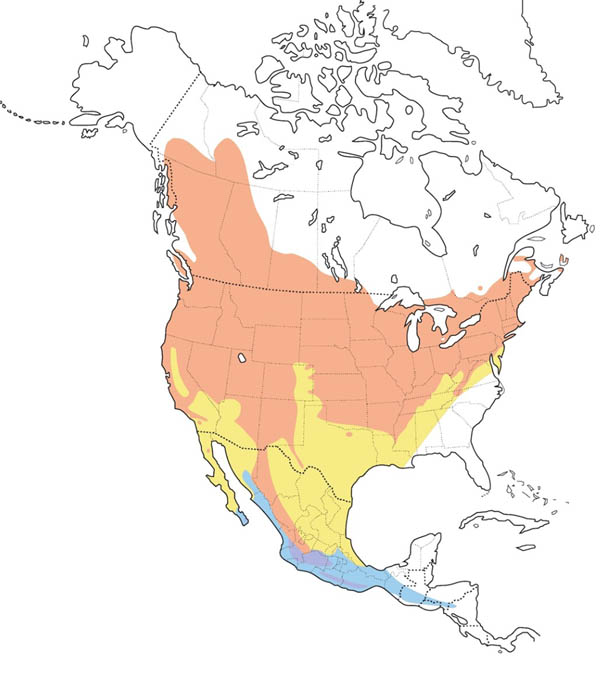
Sources:
- American Bird Conservancy. (2020b, June 24). White-breasted Nuthatch. https://abcbirds.org/bird/white-breasted-nuthatch/
- Powdermill Nature Reserve, Carnegie Museum of Natural History
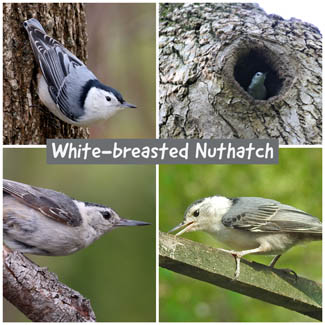
- Grid (counterclockwise):
- Male: Jay McGowan / Macaulay Library at the Cornell Lab of Ornithology (ML280081751)
- Female: Steve Tucker / Macaulay Library at the Cornell Lab of Ornithology (ML270614971)
- Juvenile: Jean Iron / Macaulay Library at the Cornell Lab of Ornithology (ML247329761)
- Nest/Eggs: Gabriel Foley / Macaulay Library at the Cornell Lab of Ornithology (ML231667061)
- Range map provided by Birds of the World
Click here to lean more about White-breasted Nuthatch
White-breasted Nuthatch
Sitta carolinensis
The confiding, acrobatic, White-breasted Nuthatch delights many a backyard birder with its head-down antics and nasal calls. Sometimes described as the "upside-down bird" or "wall walker," this agile little songbird is often seen in the company of other familiar species such as the Downy Woodpecker, Northern Cardinal, and Black-capped Chickadee. Nuthatches, particularly White-breasted, move up and down tree trunks and branches, often head down, as they search for food items in the crevices of bark.
The word "nuthatch" derives from "nut-hack," an old English word likely first ascribed to the related Eurasian Nuthatch. This evocative word describes an unusual method of feeding shared by all nuthatch species. These birds wedge their food — nuts, seeds, or insects — into bark crevices, then hammer or "hack" at the food with their strong bills to tear it apart. All nuthatches have chisel-shaped beaks, which they use to chisel pieces of bark in their search for insects and cached food items.
While foraging, the White-breasted Nuthatch clambers up and down tree trunks head-first and sidles along large branches, probing gaps and holes in bark for food items.
The word "nuthatch" derives from "nut-hack," an old English word likely first ascribed to the related Eurasian Nuthatch. This evocative word describes an unusual method of feeding shared by all nuthatch species. These birds wedge their food — nuts, seeds, or insects — into bark crevices, then hammer or "hack" at the food with their strong bills to tear it apart. All nuthatches have chisel-shaped beaks, which they use to chisel pieces of bark in their search for insects and cached food items.
While foraging, the White-breasted Nuthatch clambers up and down tree trunks head-first and sidles along large branches, probing gaps and holes in bark for food items.
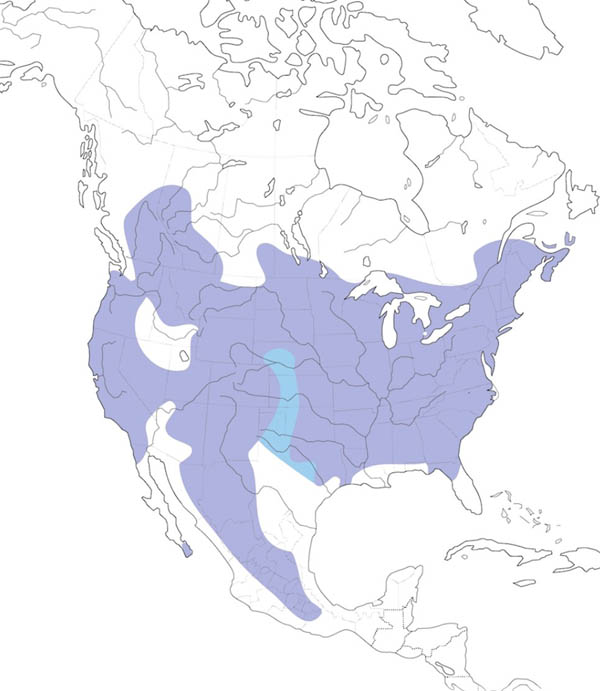
Sources:
- American Bird Conservancy. (2020b, June 24). White-breasted Nuthatch. https://abcbirds.org/bird/white-breasted-nuthatch/
- Powdermill Nature Reserve, Carnegie Museum of Natural History
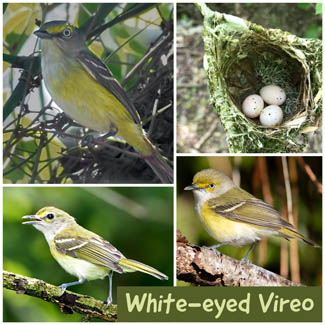
- Grid (counterclockwise):
- Male: Michael Stubblefield / Macaulay Library at the Cornell Lab of Ornithology (ML277102321)
- Female: Fran Meyerson / Macaulay Library at the Cornell Lab of Ornithology (ML228595261)
- Juvenile: Gary Mueller / Macaulay Library at the Cornell Lab of Ornithology (ML254318221)
- Nest/Eggs: Scott Snyder / Macaulay Library at the Cornell Lab of Ornithology (ML103882701)
- Range map provided by Birds of the World
Click here to lean more about White-eyed Vireo
White-eyed Vireo
Vireo griseus
The White-eyed Vireo is a busy bird of the thickets, most common in the southeast. Although the White-eyed Vireo usually stays in dense cover, it is not always hard to see; it will come up to examine and scold a birder who stands near the bushes and makes squeaking sounds. Even when it remains out of sight, its snappy song is distinctive. In Bermuda, where the bird is common, it is widely known as "chick-of-the-village," a good rendition of the song.
Bird banders become accustomed to "personality" traits of the species they band. For example, catbirds are vocal, warblers and thrushes are chill, and wrens are wiggly. White-eyed Vireos have sassy attitudes!
Bird banders become accustomed to "personality" traits of the species they band. For example, catbirds are vocal, warblers and thrushes are chill, and wrens are wiggly. White-eyed Vireos have sassy attitudes!

Sources:
- Powdermill Nature Reserve, Carnegie Museum of Natural History
- White-eyed Vireo. (2020, February 19). Audubon. https://www.audubon.org/field-guide/bird/white-eyed-vireo
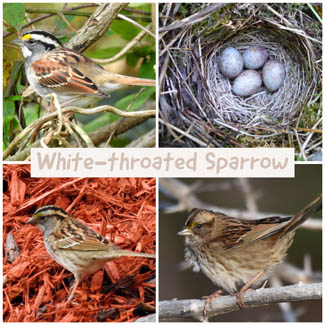
- Grid (counterclockwise):
- Male: bob butler / Macaulay Library at the Cornell Lab of Ornithology (ML278736581)
- Female: Don Hoppe / Macaulay Library at the Cornell Lab of Ornithology (ML231155991)
- Juvenile: Kathy Marche / Macaulay Library at the Cornell Lab of Ornithology (ML274957811)
- Nest/Eggs: Réjean Deschênes / Macaulay Library at the Cornell Lab of Ornithology (ML68030191)
- Range map provided by Birds of the World
Click here to lean more about White-throated Sparrow
White-throated Sparrow
Zonotrichia albicollis
The White-throated Sparrow breeds mostly across Canada, but it is a familiar winter bird across most of eastern and southern North America, as well as California. The bird's sweet whistled song, described as "Poor Sam Peabody Peabody Peabody" or "Oh, Sweet Canada Canada Canada," can be heard throughout the day.
The white-throated is one of our more common sparrow species. But it is also one of the most frequent victims of window collisions. (Bird-smart glass options are available to reduce this needless mortality.)
White-throated Sparrows show a limited spring, or pre-breeding, molt where they replace feathers primarily on the head. This species has two color morphs that are unrelated to age or sex: tan morphs have tannish throats and stripes above the eyes and white morphs are exceptionally striking with bold white markings that contrast with black head stripes and yellow lores.
The white-throated is one of our more common sparrow species. But it is also one of the most frequent victims of window collisions. (Bird-smart glass options are available to reduce this needless mortality.)
White-throated Sparrows show a limited spring, or pre-breeding, molt where they replace feathers primarily on the head. This species has two color morphs that are unrelated to age or sex: tan morphs have tannish throats and stripes above the eyes and white morphs are exceptionally striking with bold white markings that contrast with black head stripes and yellow lores.

Sources:
- American Bird Conservancy. (2019b, January 17). White-throated Sparrow. https://abcbirds.org/bird/white-throated-sparrow/
- Powdermill Nature Reserve, Carnegie Museum of Natural History
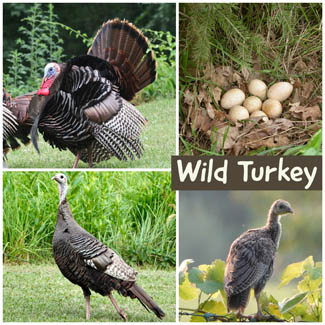
- Grid (counterclockwise):
- Male: Frank Mantlik / Macaulay Library at the Cornell Lab of Ornithology (ML348681851)
- Female: Tom Shepard / Macaulay Library at the Cornell Lab of Ornithology (ML369791731)
- Juvenile: André BERNARD / Macaulay Library at the Cornell Lab of Ornithology (ML360297051)
- Nest/Eggs: Kent McFarland / Macaulay Library at the Cornell Lab of Ornithology (ML52109001)
- Range map provided by Birds of the World
Click here to lean more about Wild Turkey
Wild Turkey
Meleagris gallopavo
Benjamin Franklin would have preferred to have the Wild Turkey, not the Bald Eagle, chosen as the national symbol of the United States. Although the barnyard variety is a rather stupid creature (leading to the insulting tone of the term 'turkey'), the original wild form is a wary and magnificent bird. Wild Turkeys usually get around by walking or running, but they can fly strongly, and they typically roost overnight in tall trees. Turkeys were formerly considered to belong to a separate family from other chicken-like birds; there are only two species, ours in North America and the Ocellated Turkey in Central America.
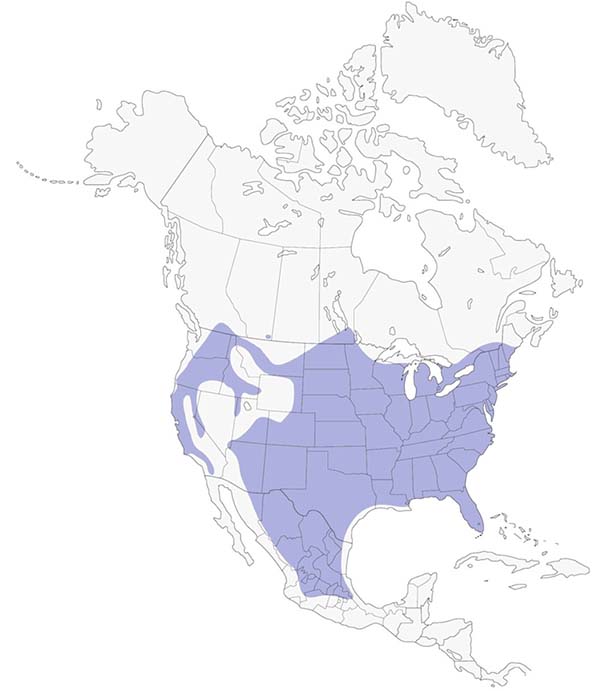
Sources:
- Wild Turkey. Audubon. (2021, October 20). Retrieved December 15, 2021, from https://www.audubon.org/field-guide/bird/wild-turkey
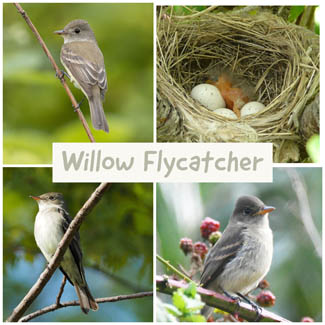
- Grid (counterclockwise):
- Male: mark daly / Macaulay Library at the Cornell Lab of Ornithology (ML247232211)
- Female: David Rooke / Macaulay Library at the Cornell Lab of Ornithology (ML29140251)
- Juvenile: Phil Pickering / Macaulay Library at the Cornell Lab of Ornithology (ML262981601)
- Nest/Eggs: Macaulay Library at the Cornell Lab of Ornithology (ML31195041)
- Range map provided by Birds of the World
Click here to lean more about Willow Flycatcher
Willow Flycatcher
Empidonax traillii
Until the 1970s, this bird and the Alder Flycatcher masqueraded as just one species under the name "Traill's Flycatcher." They are essentially identical in looks, but their voices are different. Either kind may be found in thickets of either willow or alder shrubs, but their ranges are largely separate: Alder Flycatchers spend the summer mostly in Alaska, across Canada, and in the northeast US, while Willow Flycatchers nest mostly south of the Canadian border.
There are several subtle things we look at to differentiate between species, and foot color is one of them. Two species, Acadian and Yellow-bellied Flycatchers have purple-grayish legs whereas Alder/Willow and Least have black legs. This is a cool detail that you might not see using binoculars!
There are several subtle things we look at to differentiate between species, and foot color is one of them. Two species, Acadian and Yellow-bellied Flycatchers have purple-grayish legs whereas Alder/Willow and Least have black legs. This is a cool detail that you might not see using binoculars!
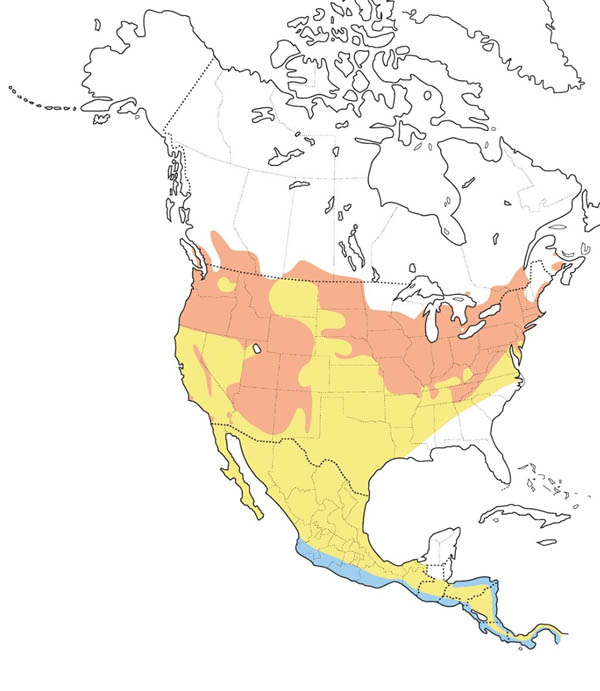
Sources:
- Willow Flycatcher. (2020, March 10). Audubon. https://www.audubon.org/field-guide/bird/willow-flycatcher
- Powdermill Nature Reserve, Carnegie Museum of Natural History
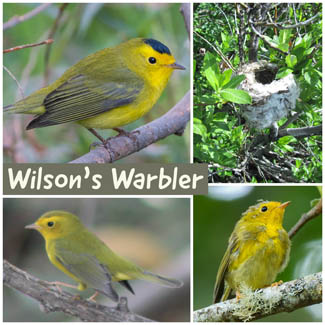
- Grid (counterclockwise):
- Male: Juan Miguel Artigas Azas / Macaulay Library at the Cornell Lab of Ornithology (ML275050691)
- Female: Sean Cozart / Macaulay Library at the Cornell Lab of Ornithology (ML264752791)
- Juvenile: Mike Melton / Macaulay Library at the Cornell Lab of Ornithology (ML245467521)
- Nest/Eggs: Tonette McEwan / Macaulay Library at the Cornell Lab of Ornithology (ML164515591)
- Range map provided by Birds of the World
Click here to lean more about Wilson's Warbler
Wilson's Warbler
Cardellina pusilla
The small, sprightly Wilson's Warbler is seemingly always in motion, flicking its wings and waggling its tail up and down and in circles. Aside from its ceaseless activity, this little warbler can also be told by its bright yellow underside and face, set off by an olive-green back and wings. In addition, the male Wilson's has a jet-black cap resembling a beret.
Its genus name Cardellina is an Italian diminutive of cardella, which means "goldfinch," referring to the warbler's eye-catching yellow color, which may fool some viewers into identifying it as an American Goldfinch. Its species name pusilla means tiny — at 4.5 inches long, it is one of the smallest North American warblers.
The female Wilson's Warbler is sometimes confused with the female Hooded Warbler. The females do look similar: both are yellow with greenish heads and backs, and a bold black eye. Interestingly, females of both Hooded Warblers and Wilson's Warblers can show a shadow of the black markings that define the males- Wilsons' can have a hint of a toupee!

Sources:
- American Bird Conservancy. (2020a, August 28). Wilson's Warbler. https://abcbirds.org/bird/wilsons-warbler/
- Powdermill Nature Reserve, Carnegie Museum of Natural History

- Grid (counterclockwise):
- Male: David Guertin / Macaulay Library at the Cornell Lab of Ornithology (ML341130541)
- Female: Bill Wood / Macaulay Library at the Cornell Lab of Ornithology (ML302593141)
- Juvenile: Wendy Hill / Macaulay Library at the Cornell Lab of Ornithology (ML348362281)
- Nest/Eggs: Steve Semanchuk / Macaulay Library at the Cornell Lab of Ornithology (ML41381041)
- Range map provided by Birds of the World
Click here to lean more about Winter Wren
Winter Wren
Troglodytes hiemalis
A secretive little bird of dense woods. It often creeps about among fallen logs and dense tangles, behaving more like a mouse than a bird, remaining out of sight but giving an occasional kimp-kimp callnote. Usually, Winter Wrens live close to the ground; but in spring in the northern woods, males ascend to high perches in the conifers to give voice to a beautiful song of long-running musical trills.
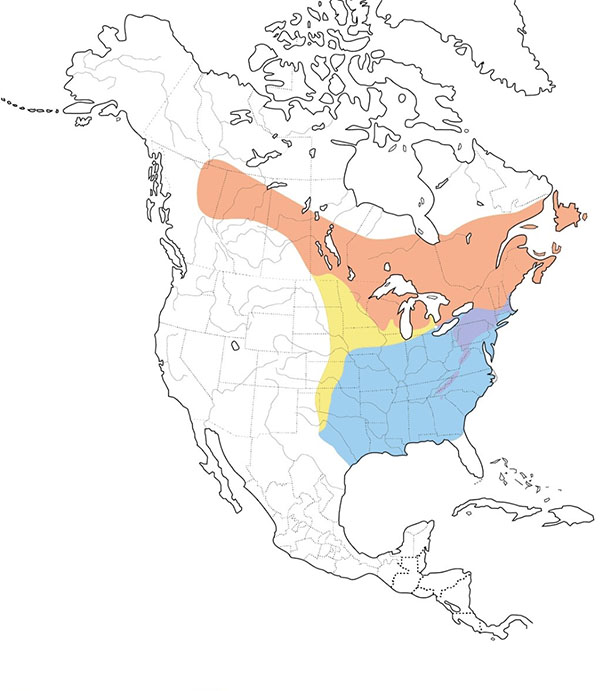
Sources:
- Winter wren. Audubon. (2021, October 20). Retrieved December 15, 2021, from https://www.audubon.org/field-guide/bird/winter-wren

- Grid (counterclockwise):
- Male: Anonymous / Macaulay Library at the Cornell Lab of Ornithology (ML382502821)
- Female: Phil Harvey / Macaulay Library at the Cornell Lab of Ornithology (ML381228761)
- Juvenile: Alayna Mellin / Macaulay Library at the Cornell Lab of Ornithology (ML367861231)
- Nest/Eggs: Jeri Langham / Macaulay Library at the Cornell Lab of Ornithology (ML145884121)
- Range map provided by Birds of the World
Click here to lean more about Wood Duck
Wood Duck
Aix sponsa
Beautiful and unique, this duck of woodland ponds and river swamps has no close relatives, except for the Mandarin Duck of eastern Asia. Abundant in eastern North America in Audubon's time, the Wood Duck population declined seriously during the late 19th century because of hunting and loss of nesting sites. Its recovery to healthy numbers was an early triumph of wildlife management.

Sources:
- Wood duck. Audubon. (2021, October 20). Retrieved December 15, 2021, from https://www.audubon.org/field-guide/bird/wood-duck
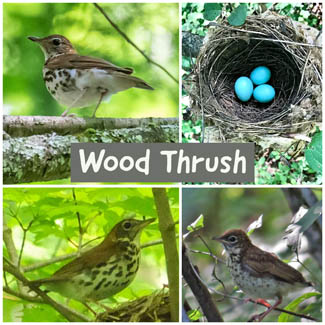
- Grid (counterclockwise):
- Male: Chris S. Wood / Macaulay Library at the Cornell Lab of Ornithology (ML242799471)
- Female: Karl Heide / Macaulay Library at the Cornell Lab of Ornithology (ML164162941)
- Juvenile: Kevin Topping / Macaulay Library at the Cornell Lab of Ornithology (ML250222391)
- Nest/Eggs: Jack & Holly Bartholmai / Macaulay Library at the Cornell Lab of Ornithology (ML250079181)
- Range map provided by Birds of the World
Click here to lean more about Wood Thrush
Wood Thrush
Hylocichla mustelina
The robust, long-legged Wood Thrush is closely related to the American Robin and thrushes of the genus Catharus, such as the Hermit Thrush and Swainson's Thrush. Its scientific name, Hylocichla mustelina, translates roughly as "weasel-colored woodland thrush," a reference to this bird's rich red-brown head, back, wings, and tail. A few of its more evocative folk names include Song Thrush, Swamp Angel, and Wood Robin. Wood Thrushes are large, relatively plump, and have dark black spots on their crisp white breasts. They have warm, reddish-brown heads that fade seamlessly along a gradient into gray, brown tails.
Once a familiar summer sound throughout eastern U.S. forests, the Wood Thrush's haunting, flute-like song is, sadly, heard in fewer places these days. How do Wood Thrushes create such beautiful songs? Like all songbirds, Wood Thrushes have a Y-shaped voice box called the syrinx. During his three-part song, a male sings pairs of notes simultaneously, which harmonize and blend to produce ringing, ethereal tones.
The Wood Thrush's complex song begins with several low, almost inaudible notes, followed by the rising, flute-like ee-oh-lay, finishing with a complex trill. Each bird can sing unique versions of each song part, and one male can easily sing over 50 distinct songs! Another commonly heard vocalization is a rapid pit-pit-pit call, given by both sexes. This series is heard year-round, including at dusk, as one of the last sounds these birds make before roosting.
Once a familiar summer sound throughout eastern U.S. forests, the Wood Thrush's haunting, flute-like song is, sadly, heard in fewer places these days. How do Wood Thrushes create such beautiful songs? Like all songbirds, Wood Thrushes have a Y-shaped voice box called the syrinx. During his three-part song, a male sings pairs of notes simultaneously, which harmonize and blend to produce ringing, ethereal tones.
The Wood Thrush's complex song begins with several low, almost inaudible notes, followed by the rising, flute-like ee-oh-lay, finishing with a complex trill. Each bird can sing unique versions of each song part, and one male can easily sing over 50 distinct songs! Another commonly heard vocalization is a rapid pit-pit-pit call, given by both sexes. This series is heard year-round, including at dusk, as one of the last sounds these birds make before roosting.

Sources:
- American Bird Conservancy. (2020c, June 24). Wood Thrush. https://abcbirds.org/bird/wood-thrush
- Powdermill Nature Reserve, Carnegie Museum of Natural History

- Grid (counterclockwise):
- Male: Francis Canto Jr / Macaulay Library at the Cornell Lab of Ornithology (ML272005251)
- Female: Pat Goltz / Macaulay Library at the Cornell Lab of Ornithology (ML269976601)
- Juvenile: Garrett Lau / Macaulay Library at the Cornell Lab of Ornithology (ML269116001)
- Nest/Eggs: John McKay / Macaulay Library at the Cornell Lab of Ornithology (ML60336741)
- Range map provided by Birds of the World
Click here to lean more about Yellow Warbler
Yellow Warbler
Setophaga petechia
The Yellow Warbler is the most widespread American wood-warbler. It nests from Alaska to northern South America (including the Galapágos Islands), and in parts of the Caribbean as well, and winters as far south as Peru. Tail tip to forehead, this is also the yellowest North American warbler. Cinnamon breast streaks embellish the male's gleaming plumage.
One of the Yellow Warbler's calls, a repeated seet, serves specifically as a Brown-headed Cowbird alert. When a female hears another bird make this call, she rushes back to her nest to prevent the cowbird, a notorious nest parasite, from laying eggs there. Other birds, including Red-winged Blackbirds, also seem to understand this warning; when they hear it, they also zip back to protect their own eggs.
It is one of the most common breeding warblers on the continent. This little splash of pure sunshine is easy to find in marshy areas or shrubby fields. The Yellow Warbler's song is a sweet-sounding series of whistled notes often characterized as "sweet, sweet, sweet, I'm so sweet," repeated as often as ten times in a minute.
One of the Yellow Warbler's calls, a repeated seet, serves specifically as a Brown-headed Cowbird alert. When a female hears another bird make this call, she rushes back to her nest to prevent the cowbird, a notorious nest parasite, from laying eggs there. Other birds, including Red-winged Blackbirds, also seem to understand this warning; when they hear it, they also zip back to protect their own eggs.
It is one of the most common breeding warblers on the continent. This little splash of pure sunshine is easy to find in marshy areas or shrubby fields. The Yellow Warbler's song is a sweet-sounding series of whistled notes often characterized as "sweet, sweet, sweet, I'm so sweet," repeated as often as ten times in a minute.
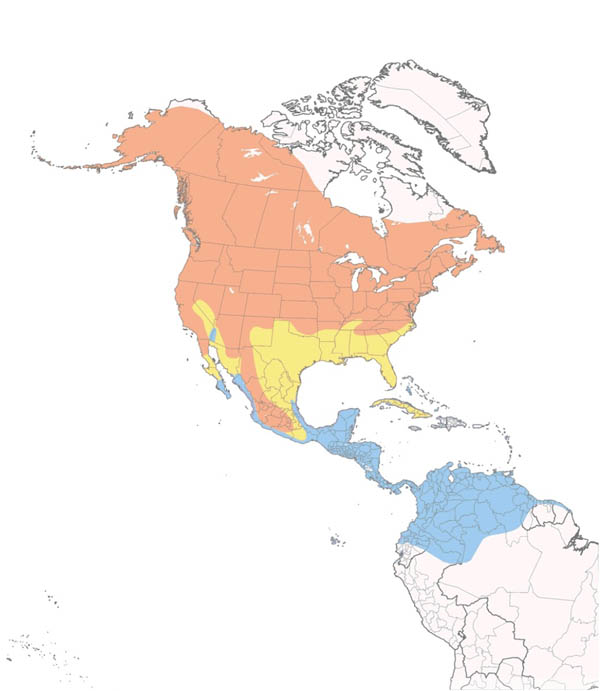
Sources:
- American Bird Conservancy. (2020d, June 24). Yellow Warbler. https://abcbirds.org/bird/yellow-warbler/
- Powdermill Nature Reserve, Carnegie Museum of Natural History

- Grid (counterclockwise):
- Male: Michael Stubblefield / Macaulay Library at the Cornell Lab of Ornithology (ML277101921)
- Female: Scott Dresser / Macaulay Library at the Cornell Lab of Ornithology (ML341483471)
- Juvenile: Stephen Davies / Macaulay Library at the Cornell Lab of Ornithology (ML352180751)
- Nest/Eggs: Carl Carbone / Macaulay Library at the Cornell Lab of Ornithology (ML246064431)
- Range map provided by Birds of the World
Click here to lean more about Yellow-billed Cuckoo
Yellow-billed Cuckoo
Coccyzus americanus
Sometimes common but usually hard to observe, the Yellow-billed Cuckoo inhabits dense leafy groves and thickets during the summer. Its stuttering, croaking calls, audible at a great distance, are often heard on hot, humid afternoons; people sometimes call this bird the 'rain crow,' imagining that it is calling for rain.
These birds are voracious consumers of noxious caterpillars like gypsy moth larvae, eastern tent caterpillar, and fall webworm. The caterpillars’ spines pierce cuckoos’ stomach lining and when it becomes excessive, the stomach lining is sloughed off and regurgitated! Cuckoos also eat cicadas.
These birds are voracious consumers of noxious caterpillars like gypsy moth larvae, eastern tent caterpillar, and fall webworm. The caterpillars’ spines pierce cuckoos’ stomach lining and when it becomes excessive, the stomach lining is sloughed off and regurgitated! Cuckoos also eat cicadas.
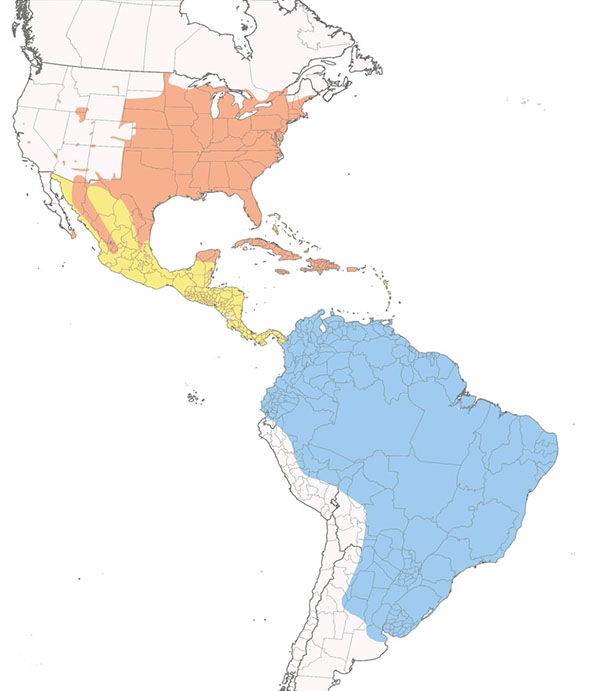
Sources:
- Powdermill Nature Reserve, Carnegie Museum of Natural History
- Yellow-billed cuckoo. Audubon. (2021, October 20). Retrieved December 15, 2021, from https://www.audubon.org/field-guide/bird/yellow-billed-cuckoo

- Grid (counterclockwise):
- Male: Tom Murray / Macaulay Library at the Cornell Lab of Ornithology (ML271945131)
- Female: Harrison Ponn / Macaulay Library at the Cornell Lab of Ornithology (ML275883921)
- Juvenile: Yves Scholten / Macaulay Library at the Cornell Lab of Ornithology (ML267449221)
- Nest/Eggs: Carol Villeneuve / Macaulay Library at the Cornell Lab of Ornithology (ML101801701)
- Range map provided by Birds of the World
Click here to lean more about Yellow-rumped Warbler
Yellow-rumped Warbler
Setophaga coronate
The Yellow-rumped Warbler is one of the most widespread and well-known warblers in North America. Birders affectionately refer to this species as "butter-butt," since its bright yellow rump is an eye-catching and diagnostic field mark throughout the year. Adults also have a yellow crown patch, most obvious in adult males. This bird's species name, coronata, means crowned.
Flashing its trademark yellow rump patch as it flies away, calling check for confirmation, this is one of our best-known warblers. While most of its relatives migrate to the tropics in fall, the Yellow-rump, able to live on berries, commonly remains as far north as New England and Seattle; it is the main winter warbler in North America.
North American populations of the Yellow-rumped Warbler are short- to medium-distance migrants, only moving as far south as the central United States, south to the Caribbean, and sparingly to central Panama. In fall, the Yellow-rumped usually migrates later than other warblers, appearing on wintering grounds around the same time as other winter residents. The Yellow-rumped Warbler's song is a slow, loose, sweet "tuwee-tuwee-tuwee-tuwee," usually rising or falling at the end. Calls include a rather metallic "check" or "chep."
Flashing its trademark yellow rump patch as it flies away, calling check for confirmation, this is one of our best-known warblers. While most of its relatives migrate to the tropics in fall, the Yellow-rump, able to live on berries, commonly remains as far north as New England and Seattle; it is the main winter warbler in North America.
North American populations of the Yellow-rumped Warbler are short- to medium-distance migrants, only moving as far south as the central United States, south to the Caribbean, and sparingly to central Panama. In fall, the Yellow-rumped usually migrates later than other warblers, appearing on wintering grounds around the same time as other winter residents. The Yellow-rumped Warbler's song is a slow, loose, sweet "tuwee-tuwee-tuwee-tuwee," usually rising or falling at the end. Calls include a rather metallic "check" or "chep."
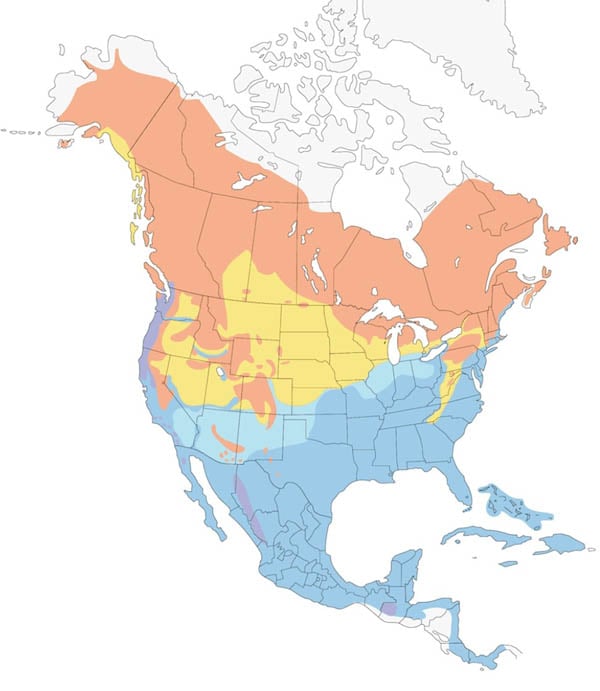
Sources:
- American Bird Conservancy. (2020, July 20). Yellow-rumped Warbler. https://abcbirds.org/bird/yellow-rumped-warbler/
- Yellow-rumped warbler. (2020, March 10). Retrieved May 03, 2021, from https://www.audubon.org/field-guide/bird/yellow-rumped-warbler
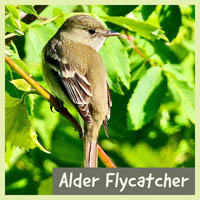

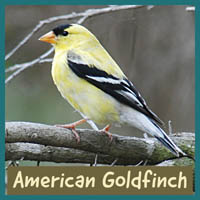
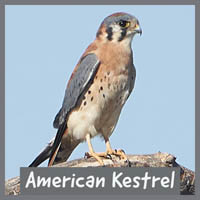
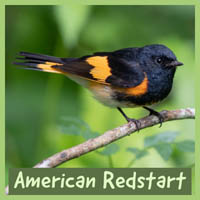
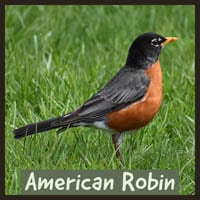

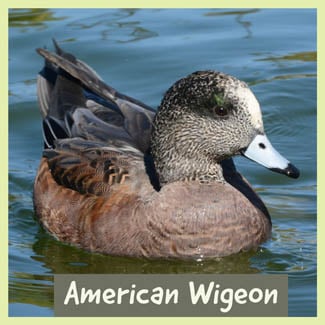
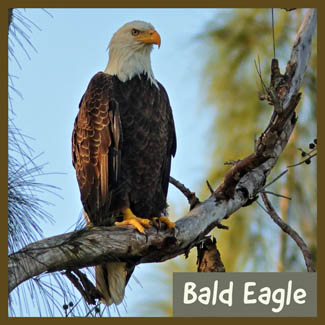
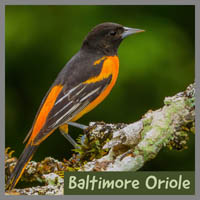
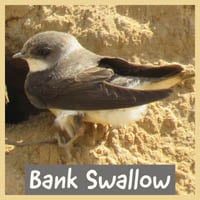
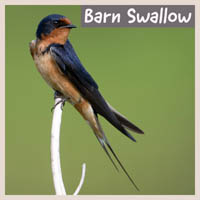

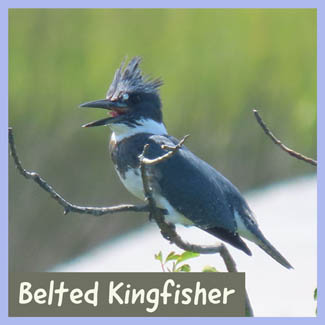
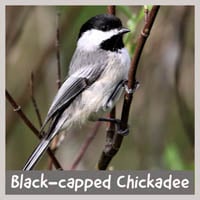
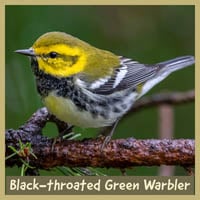

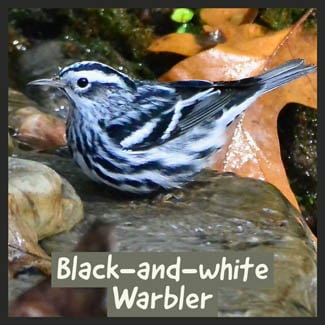
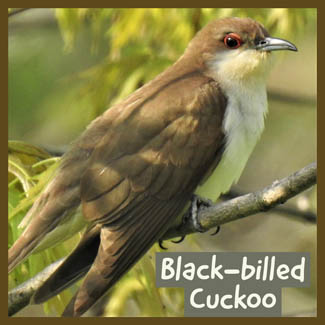
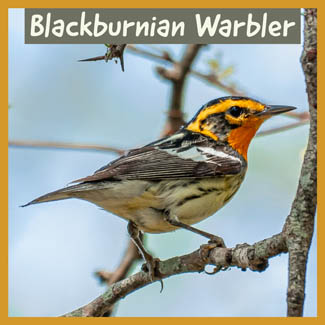
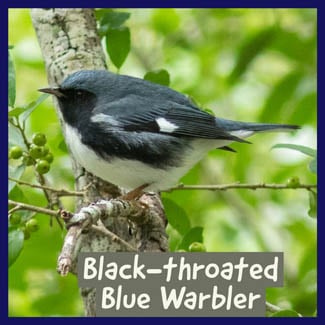
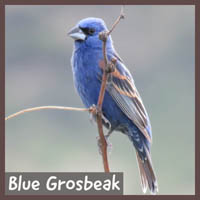

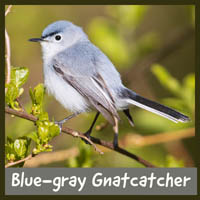
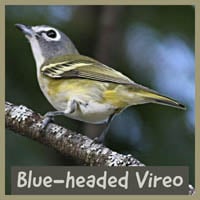
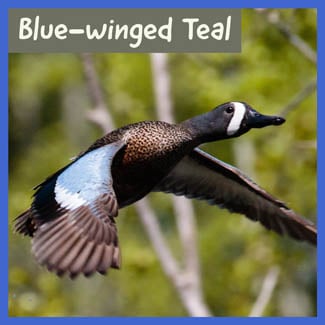
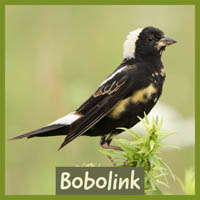
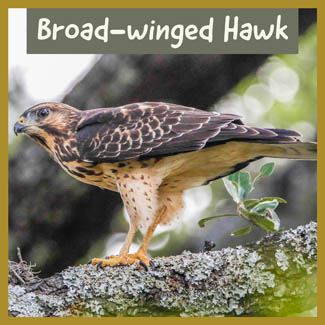
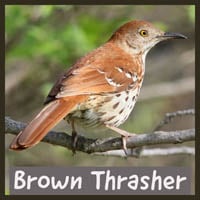
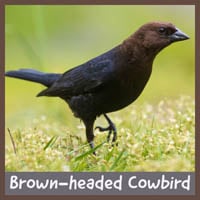
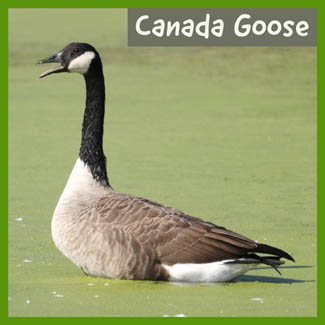
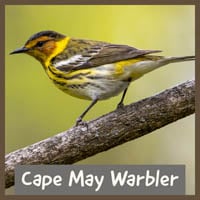
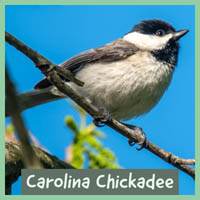
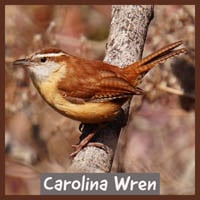
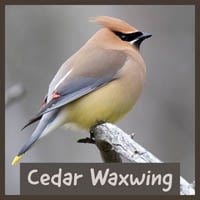
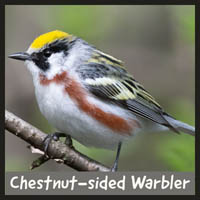
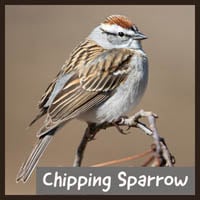
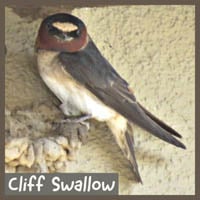
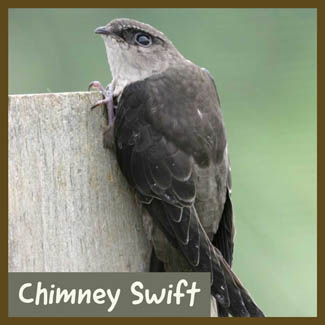
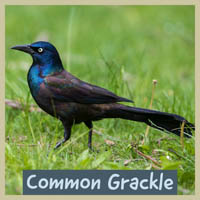
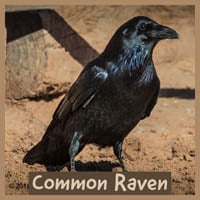
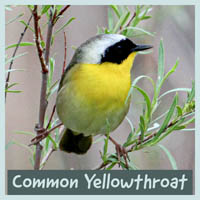
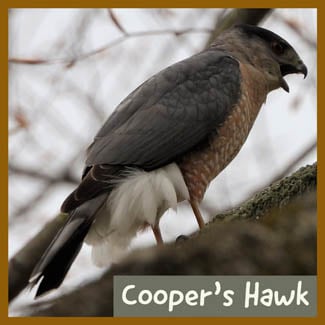
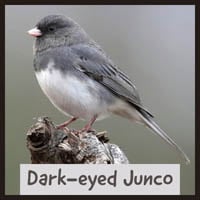
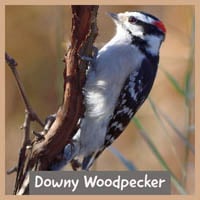
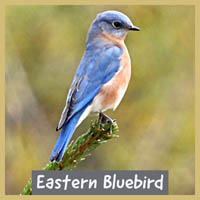
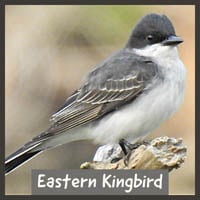
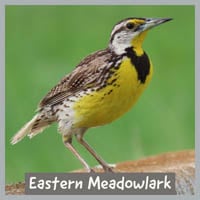
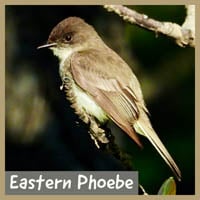
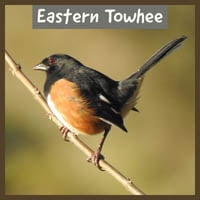
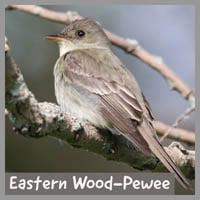
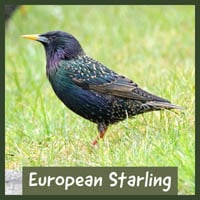
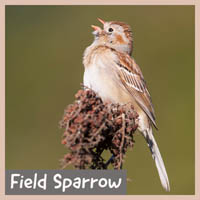
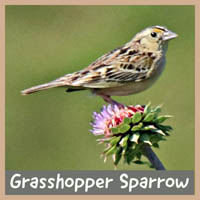
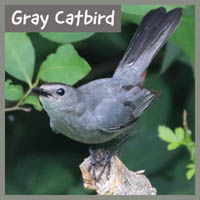

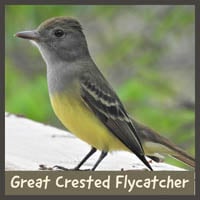
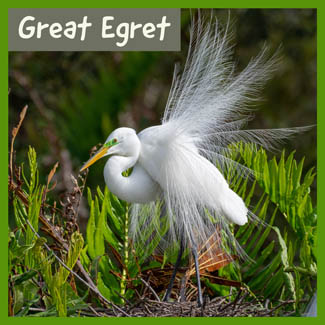
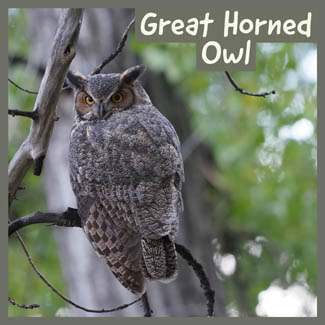
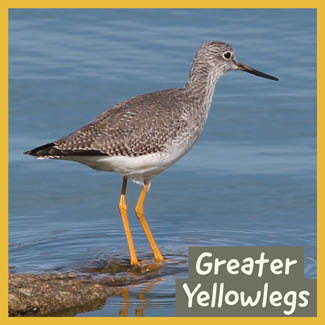

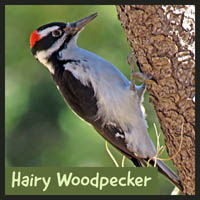
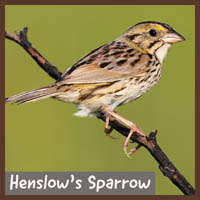

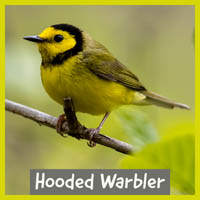
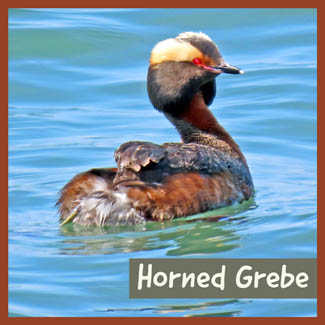
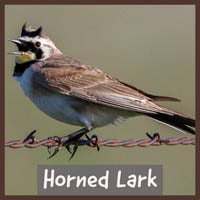

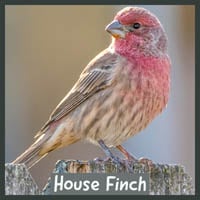
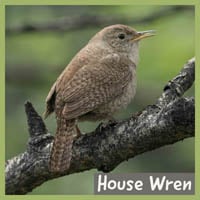

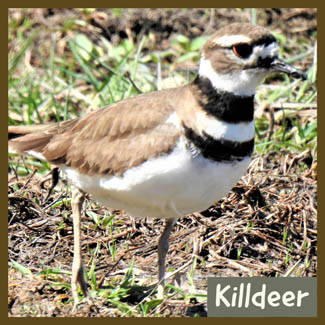
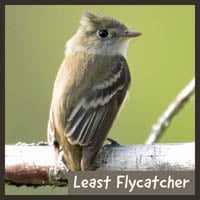

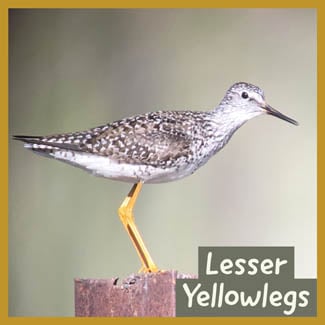
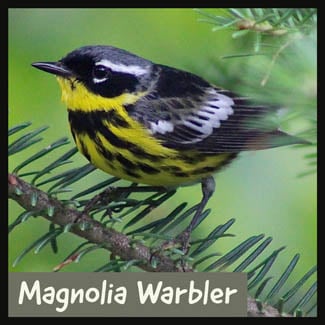

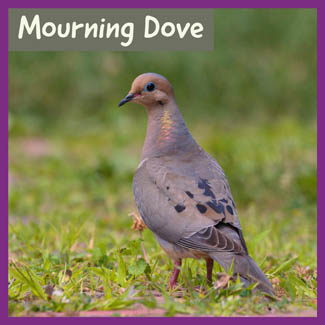

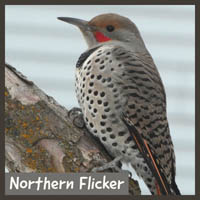

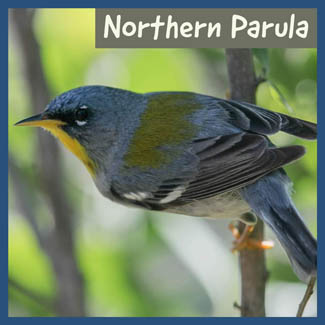
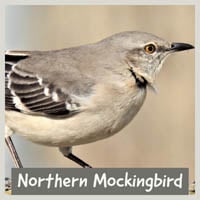
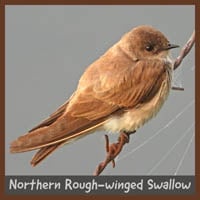
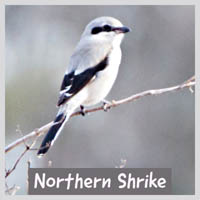
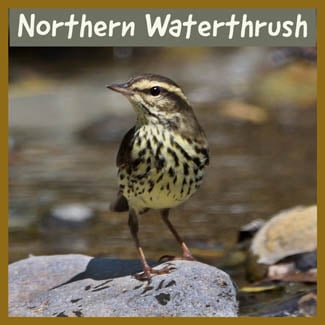
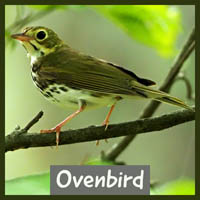

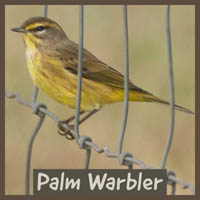
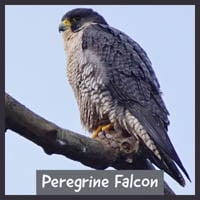
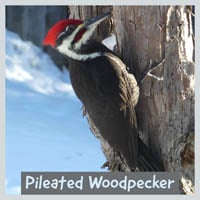
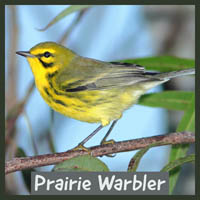

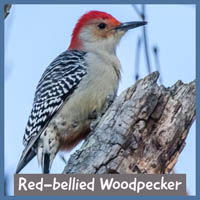
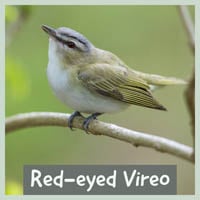
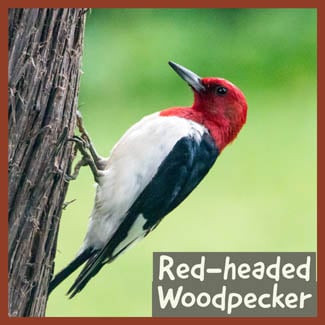
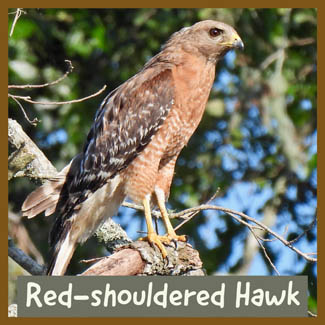

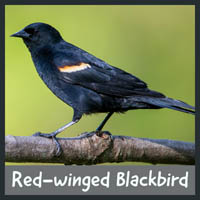
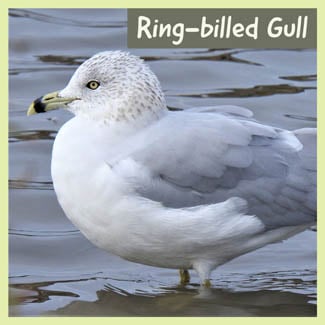
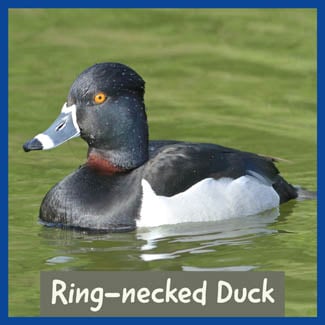
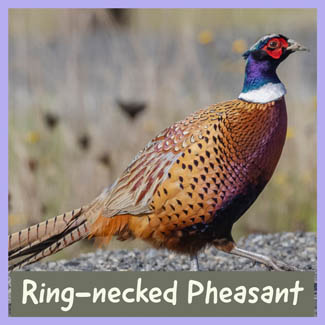
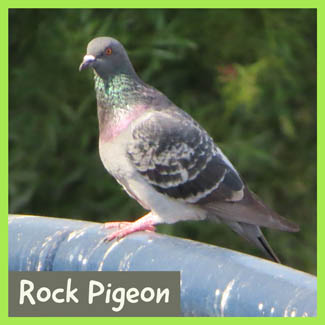
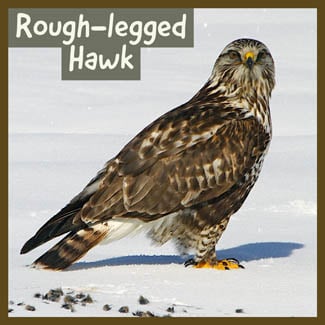
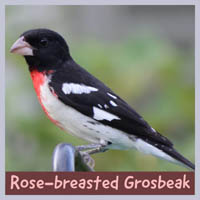
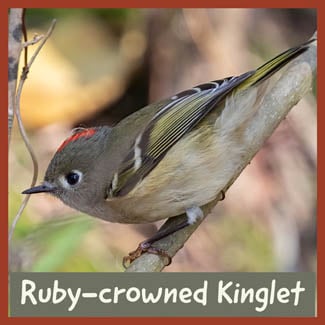
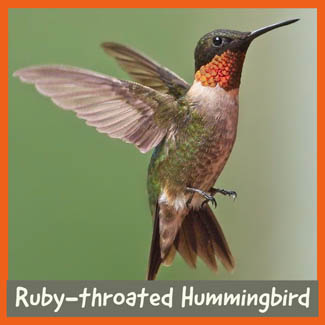

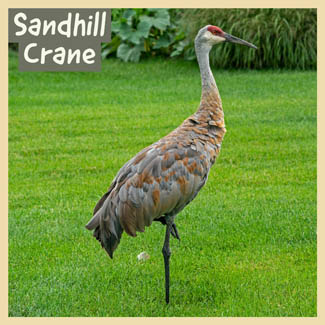
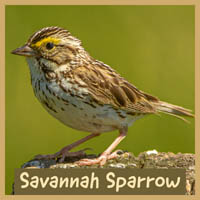
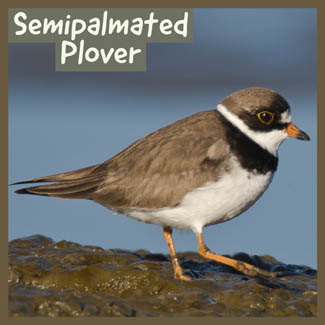
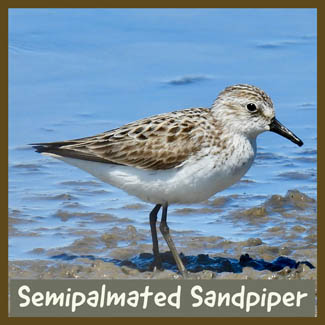
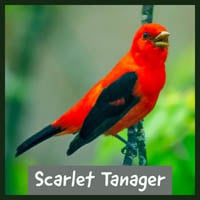
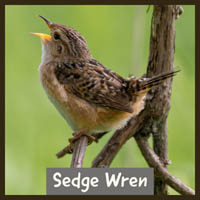
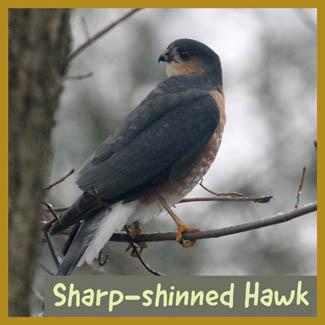
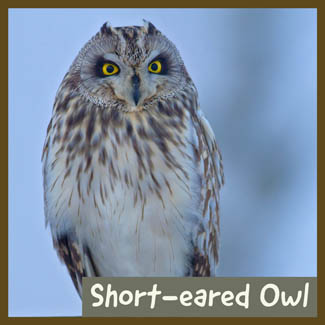
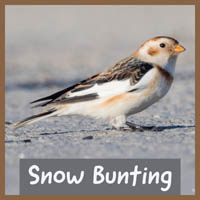

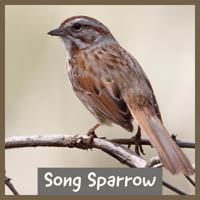
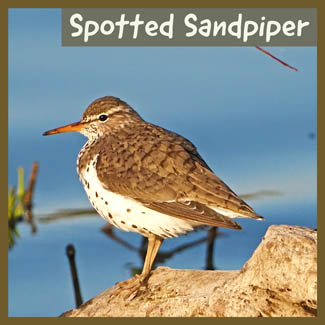
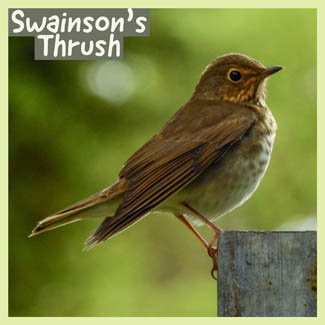
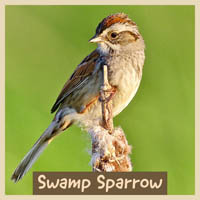
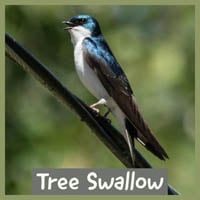
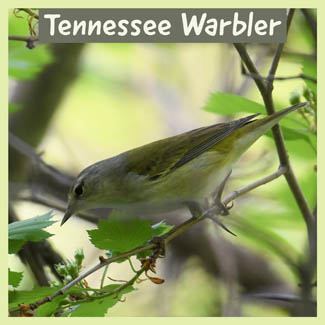
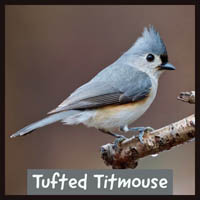
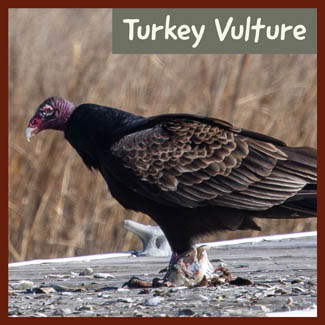
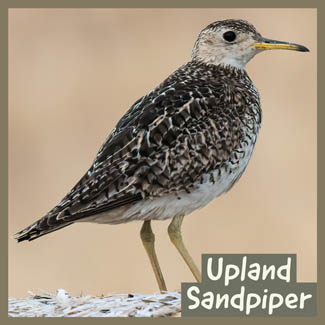
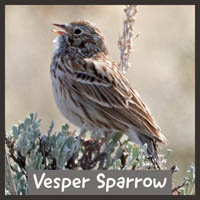
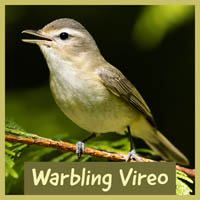
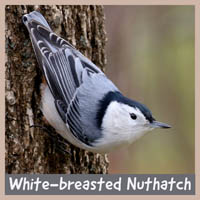
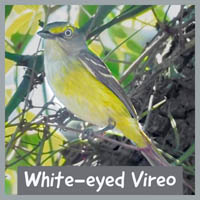
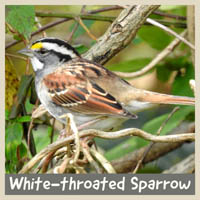
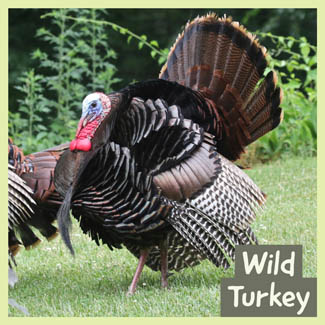
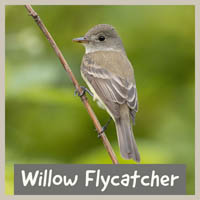
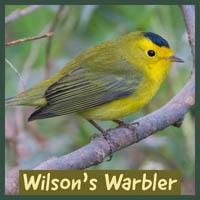
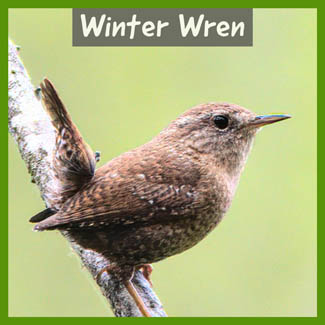

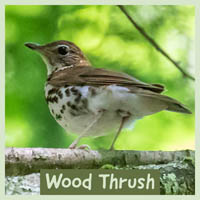
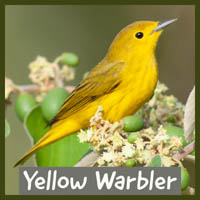
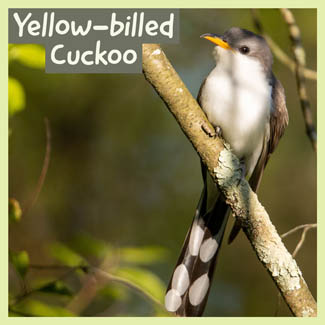
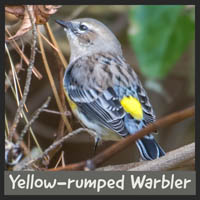
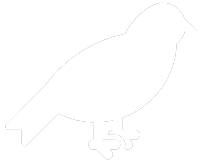 Click here to lean more about
Click here to lean more about 